['Air Programs']
['Air Emissions']
10/02/2025
...
Authority: 42 U.S.C. 7401—7671q.
Subpart A—Overview and Applicability
§1036.1 Applicability.
(a) Except as specified in §1036.5, the provisions of this part apply for engines that will be installed in heavy-duty vehicles (including glider vehicles). Heavy-duty engines produced before December 20, 2026 are subject to greenhouse gas emission standards and related provisions under this part as specified in §1036.108; these engines are subject to exhaust emission standards for NO X, HC, PM, and CO, and related provisions under 40 CFR part 86, subpart A and subpart N, instead of this part, except as follows:
(1) The provisions of §§1036.115, 1036.501(d), and 1036.601 apply.
(2) 40 CFR parts 85 and 86 may specify that certain provisions in this part apply.
(3) This part describes how several individual provisions are optional or mandatory before model year 2027. For example, §1036.150(a) describes how you may generate emission credits by meeting the standards of this part before model year 2027.
(b) The provisions of this part also apply for fuel conversions of all engines described in paragraph (a) of this section as described in 40 CFR 85.502.
(c) Gas turbine heavy-duty engines and other heavy-duty engines not meeting the definition of compression-ignition or spark-ignition are deemed to be compression-ignition engines for purposes of this part.
(d) For the purpose of applying the provisions of this part, engines include all emission-related components and any components or systems that should be identified in your application for certification, such as hybrid components for engines that are certified as hybrid engines or hybrid powertrains.
[88 FR 4487, Jan. 24, 2023]
§1036.2 Compliance responsibility.
The regulations in this part contain provisions that affect both engine manufacturers and others. However, the requirements of this part are generally addressed to the engine manufacturer(s). The term “you” generally means the engine manufacturer(s), especially for issues related to certification. Additional requirements and prohibitions apply to other persons as specified in subpart G of this part and 40 CFR part 1068.
[88 FR 4487, Jan. 24, 2023]
§1036.5 Excluded engines.
(a) The provisions of this part do not apply to engines used in medium-duty passenger vehicles or other heavy-duty vehicles that are subject to regulation under 40 CFR part 86, subpart S, except as specified in 40 CFR part 86, subpart S, and §1036.150(j). For example, this exclusion applies for engines used in vehicles certified to the standards of 40 CFR 86.1818 and 86.1819.
(b) An engine installed in a heavy-duty vehicle that is not used to propel the vehicle is not a heavy-duty engine. The provisions of this part therefore do not apply to these engines. Note that engines used to indirectly propel the vehicle (such as electrical generator engines that provide power to batteries for propulsion) are subject to this part. See 40 CFR part 1039, 1048, or 1054 for other requirements that apply for these auxiliary engines. See 40 CFR part 1037 for requirements that may apply for vehicles using these engines, such as the evaporative and refueling emission requirements of 40 CFR 1037.103.
(c) The provisions of this part do not apply to aircraft or aircraft engines. Standards apply separately to certain aircraft engines, as described in 40 CFR part 87.
(d) The provisions of this part do not apply to engines that are not internal combustion engines. For example, the provisions of this part generally do not apply to fuel cells. Note that gas turbine engines are internal combustion engines.
(e) The provisions of this part do not apply for model year 2013 and earlier heavy-duty engines unless they were:
(1) Voluntarily certified to this part.
(2) Installed in a glider vehicle subject to 40 CFR part 1037.
[88 FR 4487, Jan. 24, 2023]
§1036.10 Organization of this part.
This part is divided into the following subparts:
(a) Subpart A of this part defines the applicability of this part and gives an overview of regulatory requirements.
(b) Subpart B of this part describes the emission standards and other requirements that must be met to certify engines under this part. Note that §1036.150 describes certain interim requirements and compliance provisions that apply only for a limited time.
(c) Subpart C of this part describes how to apply for a certificate of conformity.
(d) Subpart D of this part addresses testing of production engines.
(e) Subpart E of this part describes provisions for testing in-use engines.
(f) Subpart F of this part describes how to test your engines (including references to other parts of the Code of Federal Regulations).
(g) Subpart G of this part describes requirements, prohibitions, and other provisions that apply to engine manufacturers, vehicle manufacturers, owners, operators, rebuilders, and all others.
(h) Subpart H of this part describes how you may generate and use emission credits to certify your engines.
(i) Subpart I of this part contains definitions and other reference information.
[88 FR 4487, Jan. 24, 2023]
§1036.15 Other applicable regulations.
(a) Parts 85 and 86 of this chapter describe additional provisions that apply to engines that are subject to this part. See §1036.601.
(b) Part 1037 of this chapter describes requirements for controlling evaporative and refueling emissions and greenhouse gas emissions from heavy-duty vehicles, whether or not they use engines certified under this part.
(c) Part 1065 of this chapter describes procedures and equipment specifications for testing engines to measure exhaust emissions. Subpart F of this part describes how to apply the provisions of part 1065 of this chapter to determine whether engines meet the exhaust emission standards in this part.
(d) The requirements and prohibitions of part 1068 of this chapter apply as specified in §1036.601 to everyone, including anyone who manufactures, imports, installs, owns, operates, or rebuilds any of the engines subject to this part, or vehicles containing these engines. See §1036.601 to determine how to apply the part 1068 regulations for heavy-duty engines. The issues addressed by these provisions include these seven areas:
(1) Prohibited acts and penalties for engine manufacturers, vehicle manufacturers, and others.
(2) Rebuilding and other aftermarket changes.
(3) Exclusions and exemptions for certain engines.
(4) Importing engines.
(5) Selective enforcement audits of your production.
(6) Recall.
(7) Procedures for hearings.
(e) Other parts of this chapter apply if referenced in this part.
[88 FR 4487, Jan. 24, 2023]
Subpart B - Emission Standards and Related Requirements
§1036.101 Overview of exhaust emission standards.
(a) You must show that engines meet the following exhaust emission standards:
(1) Criteria pollutant standards for NOX, HC, PM, and CO apply as described in §1036.104. These pollutants are sometimes described collectively as “criteria pollutants” because they are either criteria pollutants under the Clean Air Act or precursors to the criteria pollutants ozone and PM.
(2) This part contains standards and other regulations applicable to the emission of the air pollutant defined as the aggregate group of six greenhouse gases: carbon dioxide, nitrous oxide, methane, hydrofluorocarbons, perfluorocarbons, and sulfur hexafluoride. Greenhouse gas (GHG) standards for CO2, CH4, and N2O apply as described in §1036.108.
(b) You may optionally demonstrate compliance with the emission standards of this part by testing hybrid powertrains, rather than testing the engine alone. Except as specified, provisions of this part that reference engines apply equally to hybrid powertrains.
[88 FR 4487, Jan. 24, 2023; 89 FR 29738, Apr. 22, 2024]
§1036.104 Criteria pollutant emission standards—NO , HC, PM, and CO.
This section describes the applicable NO X, HC, CO, and PM standards for model years 2027 and later. These standards apply equally for all primary intended service classes unless otherwise noted.
(a) Emission standards. Exhaust emissions may not exceed the standards in this section, as follows:
(1) The following emission standards apply for Light HDE, Medium HDE, and Heavy HDE over the FTP, SET, and LLC duty cycles using the test procedures described in subpart F of this part:
| Duty cycle | NO X mg/hp·hr | HC mg/hp·hr | PM mg/hp·hr | CO g/hp·hr |
|---|---|---|---|---|
| SET and FTP | 35 | 60 | 5 | 6.0 |
| LLC | 50 | 140 | 5 | 6.0 |
(2) The following emission standards apply for Spark-ignition HDE over the FTP and SET duty cycles using the test procedures described in subpart F of this part:
| Duty cycle | NOX mg/hp·hr | HC mg/hp·hr | PM mg/hp·hr | CO g/hp·hr |
|---|---|---|---|---|
| SET | 35 | 60 | 5 | 14.4 |
| FTP | 35 | 60 | 5 | 6.0 |
(3) The following off-cycle emission standards apply for Light HDE, Medium HDE, and Heavy HDE using the procedures specified in §1036.530, as follows:
| Off-cycle Bin | NO X | Temperature adjustment a | HC mg/hp·hr | PM mg/hp·hr | CO g/hp·hr |
|---|---|---|---|---|---|
| Bin 1 | 10.0 g/hr | (25.0− T amb) · 0.25 | |||
| Bin 2 | 58 mg/hp·hr | (25.0− T amb) · 2.2 | 120 | 7.5 | 9 |
| a T amb is the mean ambient temperature over a shift-day, or equivalent. Adjust the off-cycle NO X standard for T amb below 25.0 °C by adding the calculated temperature adjustment to the specified NO X standard. Round the temperature adjustment to the same precision as the NO X standard for the appropriate bin. If you declare a NO X FEL for the engine family, do not apply the FEL scaling calculation from paragraph (c)(3) of this section to the calculated temperature adjustment. | |||||
(b) Clean Idle. You may optionally certify compression-ignition engines to the Clean Idle NO X emission standard using the Clean Idle test specified in §1036.525. The optional Clean Idle NO X emission standard is 30.0 g/h for model years 2024 through 2026, and 10.0 g/hr for model year 2027 and later. The standard applies separately to each mode of the Clean Idle test. If you certify an engine family to the Clean Idle standards, it is subject to all these voluntary standards as if they were mandatory.
(c) Averaging, banking, and trading. You may generate or use emission credits under the averaging, banking, and trading (ABT) program described in subpart H of this part for demonstrating compliance with NO X emission standards in paragraph (a) of this section. You must meet the PM, HC, and CO emission standards in §1036.104(a) without generating or using emission credits.
(1) To generate or use emission credits, you must specify a family emission limit for each engine family. Declare the family emission limit corresponding to full useful life for engine operation over the FTP duty cycle, FEL FTP , expressed to the same number of decimal places as the emission standard. Use FEL FTP to calculate emission credits in subpart H of this part.
(2) The following NO X FEL caps are the maximum value you may specify for FEL FTP :
(i) 65 mg/hp·hr for model years 2027 through 2030.
(ii) 50 mg/hp·hr for model year 2031 and later.
(3) Calculate the NO X family emission limit, FEL [cycle]NO, that applies for each duty-cycle or off-cycle standard using the following equation:

Where:
Std [cycle]NO, = the NO X emission standard that applies for the applicable cycle or for off-cycle testing under paragraph (a) of this section for engines not participating in the ABT program.
FEL FTPNO = the engine family's declared FEL for NO X over the FTP duty cycle from paragraph (c)(1) of this section.
Std FTPNO = the NO X emission standard that applies for the FTP duty cycle under paragraph (a) of this section for engines not participating in the ABT program.
Example for model year 2029 Medium HDE for the SET:
Std SETNO = 35 mg/hp·hr
FEL FTP = 121 mg/hp·hr
Std FTPNO = 35 mg/hp·hr

FEL SETNO = 121 mg/hp·hr
(4) The family emission limits you select under this paragraph (c) serve as the emission standards for compliance testing instead of the standards specified in this section.
(d) Fuel types. The exhaust emission standards in this section apply for engines using the fuel type on which the engines in the engine family are designed to operate. You must meet the numerical emission standards for HC in this section based on the following types of hydrocarbon emissions for engines powered by the following fuels:
(1) Alcohol-fueled engines: NMHCE emissions.
(2) Gaseous-fueled engines: NMNEHC emissions.
(3) Other engines: NMHC emissions.
(e) Useful life. The exhaust emission standards of this section apply for the useful life, expressed in vehicle miles, or hours of engine operation, or years in service, whichever comes first, as follows:
| Primary intended service class | Model year 2026 and earlier | Model year 2027 and later | ||||
|---|---|---|---|---|---|---|
| Miles | Years | Hours | Miles | Years | Hours | |
| Spark-ignition HDE | 110,000 | 10 | 200,000 | 15 | 10,000 | |
| Light HDE | 110,000 | 10 | 270,000 | 15 | 13,000 | |
| Medium HDE | 185,000 | 10 | 350,000 | 12 | 17,000 | |
| Heavy HDE | 435,000 | 10 | 22,000 | 650,000 | 11 | 32,000 |
(f) Applicability for testing. The emission standards in this subpart apply to all testing, including certification, selective enforcement audits, and in-use testing. For selective enforcement audits, we may require you to perform the appropriate duty-cycle testing as specified in §§1036.510, 1036.512, and 1036.514. We may direct you to do additional testing to show that your engines meet the off-cycle standards.
[88 FR 4487, Jan. 24, 2023; 89 FR 29738, Apr. 22, 2024]
§1036.108 Greenhouse gas emission standards—CO , CH , and N O.
This section contains standards and other regulations applicable to the emission of the air pollutant defined as the aggregate group of six greenhouse gases: carbon dioxide, nitrous oxide, methane, hydrofluorocarbons, perfluorocarbons, and sulfur hexafluoride. This section describes the applicable CO 2, N 2 O, and CH 4 standards for engines.
(a) Emission standards. Emission standards apply for engines and optionally powertrains measured using the test procedures specified in subpart F of this part as follows:
(1) CO2emission standards in this paragraph (a)(1) apply based on testing as specified in subpart F of this part. The applicable test cycle for measuring CO2emissions differs depending on the engine family's primary intended service class and the extent to which the engines will be (or were designed to be) used in tractors. For Medium HDE and Heavy HDE certified as tractor engines, measure CO2emissions using the SET steady-state duty cycle specified in §1036.510. This testing with the SET duty cycle is intended for engines designed to be used primarily in tractors and other line-haul applications. Note that the use of some SET-certified tractor engines in vocational applications does not affect your certification obligation under this paragraph (a)(1); see other provisions of this part and 40 CFR part 1037 for limits on using engines certified to only one cycle. For Medium HDE and Heavy HDE certified as both tractor and vocational engines, measure CO2emissions using the SET duty cycle specified in §1036.510 and the FTP transient duty cycle specified in §1036.512. Testing with both SET and FTP duty cycles is intended for engines that are designed for use in both tractor and vocational applications. For all other engines (including Spark-ignition HDE), measure CO2emissions using the FTP transient duty cycle specified in §1036.512.
(i) Spark-ignition standards.The CO2standard for all spark-ignition engines is 627 g/hp·hr for model years 2016 through 2020.This standard continues to apply in later model years for all spark-ignition engines that are not Heavy HDE. Spark-ignition engines that qualify as Heavy HDE under §1036.140(b)(2) for model years 2021 and later are subject to the compression-ignition engine standards for Heavy HDE-Vocational or Heavy HDE-Tractor, as applicable. You may certify spark-ignition engines to the compression-ignition standards for the appropriate model year under this paragraph (a). If you do this, those engines are treated as compression-ignition engines for all provisions of this part.
(ii) Compression-ignition standards.The following CO2standards apply for compression-ignition engines and model year 2021 and later spark-ignition engines that qualify as Heavy HDE:
| Phase | Model years | Light HDE | Medium HDE-vocational | Heavy HDE-vocational | Medium HDE-tractor | Heavy HDE-tractor |
|---|---|---|---|---|---|---|
| 1 | 2014-2016 | 600 | 600 | 567 | 502 | 475 |
| 2017-2020 | 576 | 576 | 555 | 487 | 460 | |
| 2 | 2021-2023 | 563 | 545 | 513 | 473 | 447 |
| 2024-2026 | 555 | 538 | 506 | 461 | 436 | |
| 2027 and later | 552 | 535 | 503 | 457 | 432 |
(2) The CH 4 emission standard is 0.10 g/hp·hr when measured over the applicable FTP transient duty cycle specified in §1036.512. This standard begins in model year 2014 for compression-ignition engines and in model year 2016 for spark-ignition engines. Note that this standard applies for all fuel types just like the other standards of this section.
(3) The N 2 O emission standard is 0.10 g/hp·hr when measured over the applicable FTP transient duty cycle specified in §1036.512. This standard begins in model year 2014 for compression-ignition engines and in model year 2016 for spark-ignition engines.
(b) Family Certification Levels. You must specify a CO 2 Family Certification Level (FCL) for each engine family expressed to the same number of decimal places as the emission standard. The FCL may not be less than the certified emission level for the engine family. The CO 2 family emission limit (FEL) for the engine family is equal to the FCL multiplied by 1.03.
(c) Averaging, banking, and trading. You may generate or use emission credits under the averaging, banking, and trading (ABT) program described in subpart H of this part for demonstrating compliance with CO 2 emission standards. Credits (positive and negative) are calculated from the difference between the FCL and the applicable emission standard. As described in §1036.705, you may use CO 2 credits to certify your engine families to FELs for N 2 O and/or CH 4, instead of the N 2 O/CH 4 standards of this section that otherwise apply. Except as specified in §§1036.150 and 1036.705, you may not generate or use credits for N 2 O or CH 4 emissions.
(d) Useful life. The exhaust emission standards of this section apply for the useful life, expressed as vehicle miles, or hours of engine operation, or years in service, whichever comes first, as follows:
| Primary intended service class | Miles | Years |
|---|---|---|
| Spark-ignition HDE a | 150,000 | 15 |
| Light HDE a | 150,000 | 15 |
| Medium HDE | 185,000 | 10 |
| Heavy HDE b | 435,000 | 10 |
| a Useful life for Spark-ignition HDE and Light HDE before model year 2021 is 110,000 miles or 10 years, whichever occurs first. | ||
| b Useful life for Heavy HDE is also expressed as 22,000 operating hours. For an individual engine, the useful life is no shorter than 10 years or 100,000 miles, whichever occurs first, regardless of operating hours. | ||
(e) Applicability for testing. The emission standards in this subpart apply as specified in this paragraph (e) to all duty-cycle testing (according to the applicable test cycles) of testable configurations, including certification, selective enforcement audits, and in-use testing. The CO 2 FCLs serve as the CO 2 emission standards for the engine family with respect to certification and confirmatory testing instead of the standards specified in paragraph (a)(1) of this section. The FELs serve as the emission standards for the engine family with respect to all other duty-cycle testing. See §§1036.235 and 1036.241 to determine which engine configurations within the engine family are subject to testing. Note that engine fuel maps and powertrain test results also serve as standards as described in §§1036.535, 1036.540, 1036.545, and 1036.630.
[88 FR 4487, Jan. 24, 2023; 89 FR 29738, Apr. 22, 2024]
§1036.110 Diagnostic controls.
Onboard diagnostic (OBD) systems must generally detect malfunctions in the emission control system, store trouble codes corresponding to detected malfunctions, and alert operators appropriately. Starting in model year 2027, new engines must have OBD systems as described in this section. You may optionally comply with any or all of the requirements of this section instead of 40 CFR 86.010-18 in earlier model years.
(a) The requirements of this section apply for engines certified under this part, except in the following circumstances:
(1) Heavy-duty engines intended to be installed in heavy-duty vehicles at or below 14,000 pounds GVWR must meet the OBD requirements in 40 CFR 86.1806-27. Note that 40 CFR 86.1806-27 allows for using later versions of specified OBD requirements from the California Air Resources Board, which includes meeting the 2019 heavy-duty OBD requirements adopted for California and updated emission thresholds as described in this section.
(2) Heavy-duty spark-ignition engines intended to be installed in heavy-duty vehicles above 14,000 pounds GVWR may instead meet the OBD requirements in 40 CFR 86.1806-27 if the same engines are also installed in vehicles certified under 40 CFR part 86, subpart S, where both sets of vehicles share similar emission controls.
(b) Engines must comply with the 2019 heavy-duty OBD requirements adopted for California as described in this paragraph (b). California's 2019 heavy-duty OBD requirements are part of 13 CCR 1968.2, 1968.5, 1971.1, and 1971.5 (incorporated by reference, see §1036.810). We may approve your request to certify an OBD system meeting alternative specifications if you submit information as needed to demonstrate that it meets the intent of this section. For example, we may approve your request for a system that meets a later version of California's OBD requirements if you demonstrate that it meets the intent of this section; the demonstration must include identification of any approved deficiencies and your plans to resolve such deficiencies. To demonstrate that your engine meets the intent of this section, the OBD system meeting alternative specifications must address all the provisions described in this paragraph (b) and in paragraph (c) of this section. The following clarifications and exceptions apply for engines certified under this part:
(1) We may approve a small manufacturer's request to delay complying with the requirements of this section for up to three model years if that manufacturer has not certified those engines or other comparable engines in California for those model years.
(2) For engines not certified in California, references to vehicles meeting certain California Air Resources Board emission standards are understood to refer to the corresponding EPA emission standards for a given family, where applicable. Use good engineering judgment to correlate the specified standards with the EPA standards that apply under this part. You must describe in your application for certification how you will perform testing to demonstrate compliance with OBD requirements to represent all your engine families over five or fewer model years.
(3) Engines must comply with OBD requirements throughout the useful life as specified in §1036.104(e).
(4) The purpose and applicability statements in 13 CCR 1971.1(a) and (b) do not apply.
(5) Emission thresholds apply as follows:
(i) Spark-ignition engines are subject to a NO X threshold of 0.35 g/hp·hr for catalyst monitoring and 0.30 g/hp·hr in all other cases. Spark-ignition engines are subject to a PM threshold of 0.015 g/hp·hr. Thresholds apply for operation on the FTP and SET duty cycles.
(ii) Compression-ignition engines are subject to a NO X threshold of 0.40 g/hp·hr and a PM threshold of 0.03 g/hp·hr for operation on the FTP and SET duty cycles.
(iii) All engines are subject to HC and CO thresholds as specified in 13 CCR 1968.2 and 1971.1, except that the “applicable standards” for determining these thresholds are 0.14 g/hp·hr for HC, 14.4 g/hp·hr for CO from spark-ignition engines, and 15.5 g/hp·hr for CO from compression-ignition engines.
(iv) Compression-ignition engines may be exempt from certain monitoring in 13 CCR 1968.2 and 1971.1 based on specified test-out criteria. To calculate these test-out criteria, the “applicable standards” are 0.20 g/hp·hr for NO X, 0.14 g/hp·hr for HC, 0.01 g/hp·hr for PM, 14.4 g/hp·hr for CO from spark-ignition engines, and 15.5 g/hp·hr for CO from compression-ignition engines.
(6) The provisions related to verification of in-use compliance in 13 CCR 1971.1(l)(4) do not apply. The provisions related to manufacturer self-testing in 13 CCR 1971.5(c) also do not apply.
(7) The deficiency provisions described in paragraph (d) of this section apply instead of 13 CCR 1971.1(k).
(8) Include the additional data-stream signals in 13 CCR 1971.1(h)(4.2.3)(E), (F), and (G) as freeze-frame conditions as required in 13 CCR 1971.1(h)(4.3).
(9) Design compression-ignition engines to make the following additional data-stream signals available on demand with a generic scan tool according to 13 CCR 1971.1(h)(4.2), if the engine is so equipped with the relevant components and OBD monitoring is required for those components (or modeling is required for some parameter related to those components):
(i) Engine and vehicle parameters. Status of parking brake, neutral switch, brake switch, and clutch switch, wastegate control solenoid output, wastegate position (commanded and actual), speed and output shaft torque consistent with §1036.115(d).
(ii) Diesel oxidation catalyst parameters. Include inlet and outlet pressure and temperature for the diesel oxidation catalyst.
(iii) Particulate filter parameters. Include filter soot load and ash load for all installed particulate filters.
(iv) EGR parameters. Include differential pressure for exhaust gas recirculation.
(v) SCR parameters. Include DEF quality-related signals, DEF coolant control valve position (commanded and actual), DEF tank temperature, DEF system pressure, DEF pump commanded percentage, DEF doser control status, DEF line heater control outputs, aftertreatment dosing quantity commanded and actual.
(vi) Derating parameters. Include any additional parameters used to apply inducements under §1036.111 or any other SCR-related or DPF-related engine derates under §1036.125.
(10) Design spark-ignition engines to make the following additional parameters available for reading with a generic scan tool, if applicable:
(i) Air-fuel enrichment parameters. Percent of time in enrichment, both for each trip (key-on to key-off) and as a cumulative lifetime value. Track values separately for enrichment based on throttle, engine protection, and catalyst protection. Include all time after engine warm-up when the engine is not operating at the air-fuel ratio designed for peak three-way catalyst efficiency. Peak efficiency typically involves closed-loop feedback control.
(ii) [Reserved]
(11) If you have an approved Executive order from the California Air Resources Board for a given engine family, we may rely on that Executive order to evaluate whether you meet federal OBD requirements for that same engine family or an equivalent engine family. Engine families are equivalent if they are identical in all aspects material to emission characteristics; for example, we would consider different inducement strategies and different warranties not to be material to emission characteristics relevant to these OBD testing requirements. EPA would count two equivalent engine families as one for the purposes of determining OBD demonstration testing requirements. Send us the following information:
(i) You must submit additional information as needed to demonstrate that you meet the requirements of this section that are not covered by the California Executive order.
(ii) Send us results from any testing you performed for certifying engine families (including equivalent engine families) with the California Air Resources Board, including the results of any testing performed under 13 CCR 1971.1(l) for verification of in-use compliance and 13 CCR 1971.5(c) for manufacturer self-testing within the deadlines set out in 13 CCR 1971.1 and 1971.5.
(iii) We may require that you send us additional information if we need it to evaluate whether you meet the requirements of this paragraph (b)(11). This may involve sending us copies of documents you send to the California Air Resources Board.
(12) You may ask us to approve conditions for which the diagnostic system may disregard trouble codes, as described in 13 CCR 1971.1(g)(5.3)-(5.6).
(13) References to the California ARB Executive Officer are deemed to be the EPA Administrator.
(c) Design the diagnostic system to display the following information in the cab:
(1) For inducements specified in §1036.111 and any other AECD that derates engine output related to SCR or DPF systems, indicate the fault code for the detected problem, a description of the fault code, and the current speed restriction. For inducement faults under §1036.111, identify whether the fault condition is for DEF level, DEF quality, or tampering; for other faults, identify whether the fault condition is related to SCR or DPF systems. If there are additional derate stages, also indicate the next speed restriction and the time remaining until starting the next restriction. If the derate involves something other than restricting vehicle speed, such as a torque derate, adjust the information to correctly identify any current and pending restrictions.
(2) Identify on demand the total number of diesel particulate filter regenerationevents that have taken place since installing the current particulate filter.
(3) Identify on demand the historical and current rate of DEF consumption, such as gallons of DEF consumed per mile or gallons of DEF consumed per gallon of diesel fuel consumed. Design the system to allow the operator to reset the current rate of DEF consumption.
(d) You may ask us to accept as compliant an engine that does not fully meet specific requirements under this section. The following provisions apply regarding OBD system deficiencies:
(1) We will not approve a deficiency for gasoline-fueled or diesel-fueled engines if it involves the complete lack of a major diagnostic monitor, such as monitors related to exhaust aftertreatment devices, oxygen sensors, air-fuel ratio sensors, NO X sensors, engine misfire, evaporative leaks, and diesel EGR (if applicable). We may approve such deficiencies for engines using other fuels if you demonstrate that the alternative fuel causes these monitors to be unreliable.
(2) We will approve a deficiency only if you show us that full compliance is infeasible or unreasonable considering any relevant factors, such as the technical feasibility of a given monitor, or the lead time and production cycles of vehicle designs and programmed computing upgrades.
(3) Our approval for a given deficiency applies only for a single model year, though you may continue to ask us to extend a deficiency approval in renewable one-year increments. We may approve an extension if you demonstrate an acceptable level of progress toward compliance and you show that the necessary hardware or software modifications would pose an unreasonable burden. We will approve a deficiency for more than three years only if you further demonstrate that you need the additional lead time to make substantial changes to engine hardware.
(4) We will not approve deficiencies retroactively.
[88 FR 4487, Jan. 24, 2023; 89 FR 29739, Apr. 22, 2024; 89 FR 28210, Apr. 18, 2024]
§1036.111 Inducements related to SCR.
Engines using SCR to control emissions depend on a constant supply of diesel exhaust fluid (DEF). This section describes how manufacturers must design their engines to derate power output to induce operators to take appropriate actions to ensure the SCR system is working properly. The requirements of this section apply equally for engines installed in heavy-duty vehicles at or below 14,000 lbs GVWR. The requirements of this section apply starting in model year 2027, though you may comply with the requirements of this section in earlier model years.
(a) General provisions. The following terms and general provisions apply under this section:
(1) As described in §1036.110, this section relies on terms and requirements specified for OBD systems by California ARB in 13 CCR 1968.2 and 1971.1 (incorporated by reference, see §1036.810).
(2) The provisions of this section apply differently based on an individual vehicle's speed history. A vehicle's speed category is based on the OBD system's recorded value for average speed for the preceding 30 hours of non-idle engine operation. The vehicle speed category applies at the point that the engine first detects an inducement triggering condition identified under paragraph (b) of this section and continues to apply until the inducement triggering condition is fully resolved as specified in paragraph (e) of this section. Non-idle engine operation includes all operating conditions except those that qualify as idle based on OBD system controls as specified in 13 CCR 1971.1(h)(5.4.10). Apply speed derates based on the following categories:
| Vehicle category a | Average speed (mi/hr) |
|---|---|
| a A vehicle is presumed to be a high-speed vehicle if it has not yet logged 30 hours of non-idle operation. | |
| Low-speed | speed <15. |
| Medium-speed | 15 ≤ speed <25. |
| High-speed | speed ≥25. |
(3) Where engines derate power output as specified in this section, the derate must decrease vehicle speed by 1 mi/hr for every five minutes of engine operation until reaching the specified derate speed. This paragraph (a)(3) applies at the onset of an inducement, at any transition to a different step of inducement, and for any derate that recurs under paragraph (e)(3) of this section.
(b) Inducement triggering conditions. Create derate strategies that monitor for and trigger an inducement based on the following conditions:
(1) DEF supply falling to 2.5 percent of DEF tank capacity or a level corresponding to three hours of engine operation, based on available information on DEF consumption rates.
(2) DEF quality failing to meet your concentration specifications.
(3) Any signal indicating that a catalyst is missing.
(4) Open circuit faults related to the following: DEF tank level sensor, DEF pump, DEF quality sensor, SCR wiring harness, NOX sensors, DEF dosing valve, DEF tank heater, DEF tank temperature sensor, and aftertreatment control module.
(c) [Reserved]
(d) Derate schedule. Engines must follow the derate schedule described in this paragraph (d) if the engine detects an inducement triggering condition identified in paragraph (b) of this section. The derate takes the form of a maximum drive speed for the vehicle. This maximum drive speed decreases over time based on hours of non-idle engine operation without regard to engine starting.
(1) Apply speed-limiting derates according to the following schedule:
| High-speed vehicles | Medium-speed vehicles | Low-speed vehicles | |||
|---|---|---|---|---|---|
| Hours of non-idle engine operation | Maximum speed (mi/hr) | Hours of non-idle engine operation | Maximum speed (mi/hr) | Hours of non-idle engine operation | Maximum speed (mi/hr) |
| a Hours start counting when the engine detects an inducement triggering condition specified in paragraph (b) of this section. For DEF supply, you may program the engine to reset the timer to three hours when the engine detects an empty DEF tank. | |||||
| 0 | 65 | 0 | 55 | 0 | 45 |
| 6 | 60 | 6 | 50 | 5 | 40 |
| 12 | 55 | 12 | 45 | 10 | 35 |
| 20 | 50 | 45 | 40 | 30 | 25 |
| 86 | 45 | 70 | 35 | ||
| 119 | 40 | 90 | 25 | ||
| 144 | 35 | ||||
| 164 | 25 | ||||
(2) You may design and produce engines that will be installed in motorcoaches with an alternative derate schedule that starts with a 65 mi/hr derate when an inducement triggering condition is first detected, steps down to 50 mi/hr after 80 hours, and concludes with a final derate speed of 25 mi/hr after 180 hours of non-idle operation.
(e) Deactivating derates. Program the engine to deactivate derates as follows:
(1) Evaluate whether the detected inducement triggering condition continues to apply. Deactivate derates if the engine confirms that the detected inducement triggering condition is resolved.
(2) Allow a generic scan tool to deactivate inducement triggering codes while the vehicle is not in motion.
(3) Treat any detected inducement triggering condition that recurs within 40 hours of engine operation as the same detected inducement triggering condition, which would restart the derate at the same point in the derate schedule that the system last deactivated the derate.
[88 FR 4487, Jan. 24, 2023; 89 FR 29739, Apr. 22, 2024]
§1036.115 Other requirements.
Engines that are required to meet the emission standards of this part must meet the following requirements, except as noted elsewhere in this part:
(a) Crankcase emissions. Engines may not discharge crankcase emissions into the ambient atmosphere throughout the useful life, other than those that are routed to the exhaust upstream of exhaust aftertreatment during all operation, except as follow:
(1) Engines equipped with turbochargers, pumps, blowers, or superchargers for air induction may discharge crankcase emissions to the ambient atmosphere if the emissions are added to the exhaust emissions (either physically or mathematically) during all emission testing.
(2) If you take advantage of this exception, you must manufacture the engines so that all crankcase emissions can be routed into the applicable sampling systems specified in 40 CFR part 1065. You must also account for deterioration in crankcase emissions when determining exhaust deterioration factors as described in §1036.240(c)(5).
(b) Fuel mapping. You must perform fuel mapping for your engine as described in §1036.505(b).
(c) Evaporative and refueling emissions. You must design and produce your engines to comply with evaporative and refueling emission standards as follows:
(1) For complete heavy-duty vehicles you produce, you must certify the vehicles to emission standards as specified in 40 CFR 1037.103.
(2) For incomplete heavy-duty vehicles, and for engines used in vehicles you do not produce, you do not need to certify your engines to evaporative and refueling emission standards or otherwise meet those standards. However, vehicle manufacturers certifying their vehicles with your engines may depend on you to produce your engines according to their specifications. Also, your engines must meet applicable exhaust emission standards in the installed configuration.
(d) Torque broadcasting. Electronically controlled engines must broadcast their speed and output shaft torque (in newton-meters). Engines may alternatively broadcast a surrogate value for determining torque. Engines must broadcast engine parameters such that they can be read with a remote device or broadcast them directly to their controller area networks.
(e) EPA access to broadcast information. If we request it, you must provide us any hardware, tools, and information we would need to readily read, interpret, and record all information broadcast by an engine's on-board computers and electronic control modules. If you broadcast a surrogate parameter for torque values, you must provide us what we need to convert these into torque units. We will not ask for hardware or tools if they are readily available commercially.
(f) Adjustable parameters. Engines that have adjustable parameters must meet all the requirements of this part for any adjustment in the practically adjustable range.
(1) We may require that you set adjustable parameters to any specification within the practically adjustable range during any testing, including certification testing, selective enforcement auditing, or in-use testing.
(2) General provisions apply for adjustable parameters as specified in 40 CFR 1068.50.
(3) DEF supply and DEF quality are adjustable parameters. The physically adjustable range includes any amount of DEF for which the engine's diagnostic system does not trigger inducement provisions under §1036.111.
(g) Prohibited controls. (1) General provisions. You may not design your engines with emission control devices, systems, or elements of design that cause or contribute to an unreasonable risk to public health, welfare, or safety while operating. For example, this would apply if the engine emits a noxious or toxic substance it would otherwise not emit that contributes to such an unreasonable risk.
(2) Vanadium sublimation in SCR catalysts. For engines equipped with vanadium-based SCR catalysts, you must design the engine and its emission controls to prevent vanadium sublimation and protect the catalyst from high temperatures. We will evaluate your engine design based on the following information that you must include in your application for certification:
(i) Identify the threshold temperature for vanadium sublimation for your specified SCR catalyst formulation as described in 40 CFR 1065.1113 through 1065.1121.
(ii) Describe how you designed your engine to prevent catalyst inlet temperatures from exceeding the temperature you identify in paragraph (g)(2)(i) of this section, including consideration of engine wear through the useful life. Also describe your design for catalyst protection in case catalyst temperatures exceed the specified temperature. In your description, include how you considered elevated catalyst temperature resulting from sustained high-load engine operation, catalyst exotherms, particulate filter regeneration, and component failure resulting in unburned fuel in the exhaust stream.
(h) Defeat devices. You may not equip your engines with a defeat device. A defeat device is an auxiliary emission control device (AECD) that reduces the effectiveness of emission controls under conditions that may reasonably be expected in normal operation and use. However, an AECD is not a defeat device if you identify it in your application for certification and any of the following is true:
(1) The conditions of concern were substantially included in the applicable procedure for duty-cycle testing as described in subpart F of this part.
(2) You show your design is necessary to prevent engine (or vehicle) damage or accidents. Preventing engine damage includes preventing damage to aftertreatment or other emission-related components.
(3) The reduced effectiveness applies only to starting the engine.
(4) The AECD applies only for engines that will be installed in emergency vehicles, and the need is justified in terms of preventing the engine from losing speed, torque, or power due abnormal conditions of the emission control system, or in terms of preventing such abnormal conditions from occurring, during operation related to emergency response. Examples of such abnormal conditions may include excessive exhaust backpressure from an overloaded particulate trap, and running out of diesel exhaust fluid for engines that rely on urea-based selective catalytic reduction. The emission standards do not apply when any AECDs approved under this paragraph (h)(4) are active.
(i) DEF tanks. Diesel exhaust fluid tanks must be sized to require refilling no more frequently than the vehicle operator will need to refill the fuel tank, even for worst-case assumptions related to fuel efficiency and refueling volumes.
(j) Special provisions for spark-ignition engines. The following provisions apply for spark-ignition engines that control air-fuel ratios at or near stoichiometry starting with model year 2027:
(1) Catalyst bed temperature during extended idle may not fall below 350 °C, or a lower temperature that we approve. Describe how you designed your engine to meet this requirement in your application for certification. You may ask us to approve alternative strategies to prevent emissions from increasing during idle.
(2) In addition to the information requirements of §1036.205(b), describe why you rely on any AECDs instead of other engine designs for thermal protection of catalyst or other emission-related components. Also describe the accuracy of any modeled or measured temperatures used to activate the AECD. We may ask you to submit a second-by-second comparison of any modeled and measured component temperatures as part of your application for certification.
[88 FR 4487, Jan. 24, 2023; 89 FR 29740, Apr. 22, 2024]
§1036.120 Emission-related warranty requirements.
(a) General requirements. You must warrant to the ultimate purchaser and each subsequent purchaser that the new engine, including all parts of its emission control system, meets two conditions:
(1) It is designed, built, and equipped so it conforms at the time of sale to the ultimate purchaser with the requirements of this part.
(2) It is free from defects in materials and workmanship that may keep it from meeting these requirements.
(b) Warranty period. Your emission-related warranty must be valid for at least as long as the minimum warranty periods listed in this paragraph (b) in vehicle miles, or hours of engine operation, or years in service, whichever comes first. You may offer an emission-related warranty more generous than we require. The emission-related warranty for the engine may not be shorter than any published warranty you offer without charge for the engine. Similarly, the emission-related warranty for any component may not be shorter than any published warranty you offer without charge for that component. If an extended warranty requires owners to pay for a portion of repairs, those terms apply in the same manner to the emission-related warranty. The warranty period begins when the vehicle is placed into service. The following minimum warranty periods apply:
| Primary intended service class | Model year 2026 and earlier | Model year 2027 and later | ||||
| Mileage | Years | Hours | Mileage | Years | Hours | |
| Spark-Ignition HDE | 50,000 | 5 | 160,000 | 10 | 8,000 | |
| Light HDE | 50,000 | 5 | 210,000 | 10 | 10,000 | |
| Medium HDE | 100,000 | 5 | 280,000 | 10 | 14,000 | |
| Heavy HDE | 100,000 | 5 | 450,000 | 10 | 22,000 | |
(c) Components covered. The emission-related warranty covers all components listed in 40 CFR part 1068, appendix A, and components from any other system you develop to control emissions. Note that this includes hybrid system components that you specify in a certified configuration. The emission-related warranty covers any components, regardless of the company that produced them, that are the original components or the same design as components from the certified configuration.
(d) Limited applicability. You may deny warranty claims under this section if the operator caused the problem through improper maintenance or use, subject to the provisions in §1036.125 and 40 CFR 1068.115.
(e) Owners manual. Describe in the owners manual the emission-related warranty provisions from this section that apply to the engine.
[88 FR 4487, Jan. 24, 2023; 89 FR 29740, Apr. 22, 2024]
§1036.125 Maintenance instructions and allowable maintenance.
Maintenance includes any inspection, adjustment, cleaning, repair, or replacement of components and is classified as either emission-related or not emission-related and each of these can be classified as either scheduled or unscheduled. Further, some emission-related maintenance is also classified as critical emission-related maintenance. Give the ultimate purchaser of each new engine written instructions for maintaining and using the engine. As described in paragraph (h) of this section, these instructions must identify how owners properly maintain and use engines to clarify responsibilities for regulatory requirements such as emission-related warranty and defect reporting.
(a) Critical emission-related maintenance. Critical emission-related maintenance includes any adjustment, cleaning, repair, or replacement of components listed in paragraph (a)(2) of this section. Critical emission-related maintenance may also include other maintenance that you determine is critical, including maintenance on other emission-related components as described in 40 CFR part 1068, appendix A, if we approve it in advance. You may perform scheduled critical emission-related maintenance during service accumulation on your emission-data engines at the intervals you specify.
(1) Maintenance demonstration. You must demonstrate that the maintenance is reasonably likely to be done at your recommended intervals on in-use engines. We will accept DEF replenishment as reasonably likely to occur if your engine meets the specifications in §1036.111. We will accept other scheduled maintenance as reasonably likely to occur if you satisfy any of the following conditions:
(i) You present data showing that, if a lack of maintenance increases emissions, it also unacceptably degrades the engine's performance.
(ii) You design and produce your engines with a system we approve that displays a visible signal to alert drivers that maintenance is due, either as a result of component failure or the appropriate degree of engine or vehicle operation. The signal must clearly display “maintenance needed”, “check engine”, or a similar message that we approve. The signal must be continuous while the engine is operating and not be easily eliminated without performing the specified maintenance. Your maintenance instructions must specify resetting the signal after completing the specified maintenance. We must approve the method for resetting the signal. You may not design the system to be less effective at the end of the useful life. If others install your engine in their vehicle, you may rely on installation instructions to ensure proper mounting and operation of the display. Disabling or improperly resetting the system for displaying these maintenance-related signals without performing the indicated maintenance violates the tampering prohibition in 42 U.S.C. 7522(a)(3).
(iii) You present survey data showing that at least 80 percent of engines in the field get the maintenance you specify at the recommended intervals.
(iv) You provide the maintenance free of charge and clearly say so in your maintenance instructions.
(v) You otherwise show us that the maintenance is reasonably likely to be done at the recommended intervals.
(2) Minimum scheduled maintenance intervals. You may not schedule critical emission-related maintenance more frequently than the minimum intervals specified or allowed in this paragraph (a), except as specified in paragraph (g) of this section. The minimum intervals specified for each component applies to actuators, sensors, tubing, valves, and wiring associated with that component, except as specified.
| Components | Spark-ignition HDE | Light HDE | Medium HDE | Heavy HDE |
|---|---|---|---|---|
| Spark plugs | 25,000 (750) | |||
| DEF filters | 100,000 (3,000) | 100,000 (3,000) | 100,000 (3,000) | |
| Crankcase ventilation valves and filters | 60,000 (1,800) | 60,000 (1,800) | 60,000 (1,800) | 60,000 (1,800) |
| Ignition wires and coils | 50,000 (1,500) | |||
| Oxygen sensors | 80,000 (2,400) | |||
| Air injection system components | 110,000 (3,300) | |||
| Sensors, actuators, and related control modules that are not integrated into other systems | 100,000 (3,000) | 100,000 (3,000) | 150,000 (4,500) | 150,000 (4,500) |
| Particulate filtration systems (other than filter substrates) | 100,000 (3,000) | 100,000 3,000) | 250,000 7,500) | 250,000 (7,500) |
| Catalyst systems (other than catalyst substrates), fuel injectors, electronic control modules, hybrid system components, turbochargers, and EGR system components (including filters and coolers) .. | 110,000 (3,300) | 110,000 (3,300) | 185,000 5,550) | 435,000 (13,050) |
| Catalyst substrates and particulate filter substrates | 200,000 (10,000) | 270,000 (13,000) | 350,000 (17,000) | 650,000 (32,000) |
| Component | Accumulated miles (hours) for components | |||
| Spark-ignition HDE | Light HDE | Medium HDE | Heavy HDE | |
| Spark plugs | 25,000 (750) | |||
| EGR-related filters and coolers, fuel injectors, and crankcase ventilation valves and filters | 50,000 (1,500) | 50,000 (1,500) | 50,000 (1,500) | 50,000 (1,500) |
| DEF filters | 50,000 (1,500) | 50,000 (1,500) | 50,000 (1,500) | |
| Ignition wires and coils | 50,000 (1,500) | |||
| Oxygen sensors | 80,000 (2,400) | |||
| Air injection system components | 100,000 (3,000) | |||
| Catalyst system components, EGR system components (other than filters or coolers), particulate filtration system components, and turbochargers | 100,000 (3,000) | 100,000 (3,000) | 100,000 (3,000), then 50,000 (4,500) | 100,000 (3,000), then 150,000 (4,500) |
(3) New technology. You may ask us to approve scheduled critical emission-related maintenance of components not identified in paragraph (a)(2) of this section that is a direct result of the implementation of new technology not used in model year 2020 or earlier engines, subject to the following provisions:
(i) Your request must include your recommended maintenance interval, including data to support the need for the maintenance, and a demonstration that the maintenance is likely to occur at the recommended interval using one of the conditions specified in paragraph (a)(1) of this section.
(ii) For any such new technology, we will publish a Federal Register notice based on information you submit and any other available information to announce that we have established new allowable minimum maintenance intervals. Any manufacturer objecting to our decision may ask for a hearing (see §1036.820).
(4) System components. The following provisions clarify which components are included in certain systems:
(i) Catalyst system refers to the aftertreatment assembly used for gaseous emission control and generally includes catalyst substrates, substrate housings, exhaust gas temperature sensors, gas concentration sensors, and related control modules. SCR-based catalyst systems also include DEF level sensors, DEF quality sensors, and DEF temperature sensors.
(ii) Particulate filtration system refers to the aftertreatment assembly used for exhaust PM filtration and generally includes filter substrates, substrate housings, pressure sensors, pressure lines and tubes, exhaust gas temperature sensors, fuel injectors for active regeneration, and related control modules.
(b) Recommended additional maintenance. You may recommend any amount of critical emission-related maintenance that is additional to what we approve in paragraph (a) of this section, as long as you state clearly that the recommended additional maintenance steps are not necessary to keep the emission-related warranty valid. If operators do the maintenance specified in paragraph (a) of this section, but not the recommended additional maintenance, this does not allow you to disqualify those engines from in-use testing or deny a warranty claim. Do not take these maintenance steps during service accumulation on your emission-data engines.
(c) Special maintenance. You may specify more frequent maintenance to address problems related to special situations, such as atypical engine operation. For example, you may specify more frequent maintenance if operators fuel the engine with an alternative fuel such as biodiesel. You must clearly state that this special maintenance is associated with the special situation you are addressing. We may disapprove your maintenance instructions if we determine that you have specified special maintenance steps to address engine operation that is not atypical, or that the maintenance is unlikely to occur in use. If we determine that certain maintenance items do not qualify as special maintenance under this paragraph (c), you may identify them as recommended additional maintenance under paragraph (b) of this section.
(d) Noncritical emission-related maintenance. You may specify any amount of emission-related inspection or other maintenance that is not approved critical emission-related maintenance under paragraph (a) of this section, subject to the provisions of this paragraph (d). Noncritical emission-related maintenance generally includes maintenance on the components we specify in 40 CFR part 1068, appendix A, that is not covered in paragraph (a) of this section. You must state in the owners manual that these steps are not necessary to keep the emission-related warranty valid. If operators fail to do this maintenance, this does not allow you to disqualify those engines from in-use testing or deny a warranty claim. Do not take these inspection or other maintenance steps during service accumulation on your emission-data engines.
(e) Maintenance that is not emission-related. You may schedule any amount of maintenance unrelated to emission controls that is needed for proper functioning of the engine. This might include adding engine oil; changing air, fuel, or oil filters; servicing engine-cooling systems; adjusting idle speed, governor, engine bolt torque, valve lash, injector lash, timing, or tension of air pump drive belts; and lubricating the heat control valve in the exhaust manifold. For maintenance that is not emission-related, you may perform the maintenance during service accumulation on your emission-data engines at the least frequent intervals that you recommend to the ultimate purchaser (but not the intervals recommended for special situations).
(f) [Reserved]
(g) Payment for scheduled maintenance. Owners are responsible for properly maintaining their engines, which generally includes paying for scheduled maintenance. However, you may commit to paying for scheduled maintenance as described in paragraph (a)(1)(iv) of this section to demonstrate that the maintenance will occur. You may also schedule maintenance not otherwise allowed by paragraph (a)(2) of this section if you pay for it. You must pay for scheduled maintenance on any component during the useful life if it meets all the following conditions:
(1) Each affected component was not in general use on similar engines before 1980.
(2) The primary function of each affected component is to reduce emissions.
(3) The cost of the maintenance is more than 2 percent of the price of the engine.
(4) Failure to perform the maintenance would not cause clear problems that would significantly degrade the engine's performance.
(h) Owners manual. Include the following maintenance-related information in the owners manual, consistent with the requirements of this section:
(1) Clearly describe the scheduled maintenance steps, consistent with the provisions of this section, using nontechnical language as much as possible. Include a list of components for which you will cover scheduled replacement costs.
(2) Identify all maintenance you consider necessary for the engine to be considered properly maintained for purposes of making valid warranty claims. Describe what documentation you consider appropriate for making these demonstrations. Note that you may identify failure to repair critical emission-related components as improper maintenance if the repairs are related to an observed defect. Your maintenance instructions under this section may not require components or service identified by brand, trade, or corporate name. Also, do not directly or indirectly require that the engine be serviced by your franchised dealers or any other service establishments with which you have a commercial relationship. However, you may disregard these limitations on your maintenance requirements if you do one of the following things:
(i) Provide a component or service without charge under the purchase agreement.
(ii) Get us to waive this prohibition in the public's interest by convincing us the engine will work properly only with the identified component or service.
(3) Describe how the owner can access the OBD system to troubleshoot problems and find emission-related diagnostic information and codes stored in onboard monitoring systems as described in §1036.110(b) and §1036.110(c). These instructions must at a minimum include identification of the OBD communication protocol used, location and type of OBD connector, brief description of what OBD is (including type of information stored, what a MIL is, and explanation that some MILs may self-extinguish), and a note that generic scan tools can provide engine maintenance information.
(4) Describe the elements of the emission control system and provide an overview of how they function.
(5) Include one or more diagrams of the engine and its emission-related components with the following information:
(i) The flow path for intake air and exhaust gas.
(ii) The flow path of evaporative and refueling emissions for spark-ignition engines, and DEF for compression-ignition engines, as applicable.
(iii) The flow path of engine coolant if it is part of the emission control system described in the application for certification.
(iv) The identity, location, and arrangement of relevant sensors, DEF heater and other DEF delivery components, and other critical emission-related components. Terminology to identify components must be consistent with codes you use for the OBD system.
(6) Include one or more exploded-view drawings that allow the owner to identify the following components: EGR valve, EGR actuator, EGR cooler, all emission sensors (such as NO X sensors and soot sensors), temperature and pressure sensors (such as sensors related to EGR, DPF, DOC, and SCR and DEF), quality sensors, DPF filter, DOC, SCR catalyst, fuel (DPF-related) and DEF dosing units and components (e.g., pumps, metering units, filters, nozzles, valves, injectors), aftertreatment-related control modules, any other DEF delivery-related components (such as delivery lines and freeze-protection components), and separately replaceable aftertreatment-related wiring harnesses. Terminology to identify components must be consistent with codes you use for the OBD system. Include part numbers for sensors and filters related to SCR and DPF systems for the current model year or any earlier model year.
(7) Include the following statement: “Technical service bulletins, emission-related recalls, and other information for your engine may be available at www.nhtsa.gov/recalls.”
(8) Include a troubleshooting guide to address the following warning signals related to SCR inducement:
(i) The inducement derate schedule (including indication that inducements will begin prior to the DEF tank being completely empty).
(ii) The meaning of any trouble lights that indicate specific problems (e.g., DEF level).
(iii) A description of the three types of SCR-related derates (DEF level, DEF quality and tampering) and that further information on the inducement cause (e.g., trouble codes) is available using the OBD system.
(9) Describe how to access OBD fault codes related to DPF-related derates.
(10) Identify a website for the service information required in 40 CFR 86.010-38(j).
[88 FR 4487, Jan. 24, 2023; 89 FR 29740, Apr. 22, 2024]
§1036.130 Installation instructions for vehicle manufacturers.
(a) If you sell an engine for someone else to install in a vehicle, give the engine installer instructions for installing it consistent with the requirements of this part. Include all information necessary to ensure that an engine will be installed in its certified configuration.
(b) Make sure these instructions have the following information:
(1) Include the heading: “Emission-related installation instructions”.
(2) State: “Failing to follow these instructions when installing a certified engine in a heavy-duty motor vehicle violates federal law, subject to fines or other penalties as described in the Clean Air Act.”
(3) Provide all instructions needed to properly install the exhaust system and any other components. Include any appropriate instructions for configuring the exhaust system in the vehicle to allow for collecting emission samples for in-use testing where that is practical.
(4) Describe any necessary steps for installing any diagnostic system required under §1036.110.
(5) Describe how your certification is limited for any type of application. For example, if you certify Heavy HDE to the CO 2standards using only transient FTP testing, you must make clear that the engine may not be installed in tractors.
(6) Describe any other instructions to make sure the installed engine will operate according to design specifications in your application for certification. This may include, for example, instructions for installing aftertreatment devices when installing the engines.
(7) Give the following instructions if you do not ship diesel exhaust fluid tanks with your engines:
(i) Specify that vehicle manufacturers must install diesel exhaust fluid tanks meeting the specifications of §1036.115(i).
(ii) Describe how vehicle manufacturers must install diesel exhaust fluid tanks with sensors as needed to meet the requirements of §§1036.110 and 1036.111.
(8) State: “If you install the engine in a way that makes the engine's emission control information label hard to read during normal engine maintenance, you must place a duplicate label on the vehicle, as described in 40 CFR 1068.105.”
(9) Describe how vehicle manufacturers need to apply stickers to qualifying vehicles as described in §1036.136 if you certify engines to the Clean Idle NO X standard of §1036.104(b).
(c) Give the vehicle manufacturer fuel map results as described in §1036.505(b).
(d) You do not need installation instructions for engines that you install in your own vehicles.
(e) Provide instructions in writing or in an equivalent format. For example, you may post instructions on a publicly available website for downloading or printing. If you do not provide the instructions in writing, explain in your application for certification how you will ensure that each installer is informed of the installation requirements.
[88 FR 4487, Jan. 24, 2023]
§1036.135 Labeling.
(a) Assign each engine a unique identification number and permanently affix, engrave, or stamp it on the engine in a legible way.
(b) At the time of manufacture, affix a permanent and legible label identifying each engine. The label must meet the requirements of 40 CFR 1068.45.
(c) The label must—
(1) Include the heading “EMISSION CONTROL INFORMATION”.
(2) Include your full corporate name and trademark. You may identify another company and use its trademark instead of yours if you comply with the branding provisions of 40 CFR 1068.45.
(3) Include EPA's standardized designation for the engine family.
(4) Identify the primary intended service class.
(5) State the engine's displacement (in liters); however, you may omit this from the label if all the engines in the engine family have the same per-cylinder displacement and total displacement.
(6) State the date of manufacture [DAY (optional), MONTH, and YEAR]; however, you may omit this from the label if you stamp, engrave, or otherwise permanently identify it elsewhere on the engine, in which case you must also describe in your application for certification where you will identify the date on the engine.
(7) State the NO X FEL to which the engines are certified if applicable. Identify the Clean Idle standard if you certify the engine to the NO X standard of §1036.104(b).
(8) State: “THIS ENGINE COMPLIES WITH U.S. EPA REGULATIONS FOR [MODEL YEAR] HEAVY-DUTY HIGHWAY ENGINES.”
(9) Identify any limitations on your certification. For example, if you certify Heavy HDE to the CO 2 standards using only steady-state testing, include the statement “TRACTORS ONLY”. Similarly, for engines with one or more approved AECDs for emergency vehicle applications under §1036.115(h)(4), the statement: “THIS ENGINE IS FOR INSTALLATION IN EMERGENCY VEHICLES ONLY”.
(d) You may add information to the emission control information label as follows:
(1) You may identify other emission standards that the engine meets or does not meet. You may add the information about the other emission standards to the statement we specify, or you may include it in a separate statement.
(2) You may add other information to ensure that the engine will be properly maintained and used.
(3) You may add appropriate features to prevent counterfeit labels. For example, you may include the engine's unique identification number on the label.
(e) You may ask us to approve modified labeling requirements in this part if you show that it is necessary or appropriate. We will approve your request if your alternate label is consistent with the requirements of this part. We may also specify modified labeling requirements to be consistent with the intent of 40 CFR part 1037.
(f) If you obscure the engine label while installing the engine in the vehicle such that the label cannot be read during normal maintenance, you must place a duplicate label on the vehicle. If others install your engine in their vehicles in a way that obscures the engine label, we require them to add a duplicate label on the vehicle (see 40 CFR 1068.105); in that case, give them the number of duplicate labels they request and keep the following records for at least five years:
(1) Written documentation of the request from the vehicle manufacturer.
(2) The number of duplicate labels you send for each engine family and the date you sent them.
[88 FR 4487, Jan. 24, 2023]
§1036.136 Clean Idle sticker.
(a) Design and produce stickers showing that your engines meet the federal Clean Idle standard if you certify engines to the Clean Idle NO X standard of §1036.104(b). The sticker must—
(1) Meet the requirements of 40 CFR 1068.45 for permanent labels. The preferred location for sticker placement is on the driver's side of the hood.
(2) Include one or both of your corporate name and trademark.
(3) Identify that the engine is qualified to meet the federal Clean Idle NO X standard.
(4) Include a serial number or other method to confirm that stickers have been properly applied to vehicles.
(b) The following provisions apply for placing Clean Idle stickers on vehicles with installed engines that have been certified to the NO X standard of §1036.104(b):
(1) If you install engines in vehicles you produce, you must apply a sticker to each vehicle certified to the Clean Idle standard.
(2) If you ship engines for others to install in vehicles, include in your purchasing documentation the manufacturer's request for a specific number of labels corresponding to the number of engines ordered. Supply the vehicle manufacturer with exactly one sticker for each shipped engine certified to the Clean Idle standard. Prepare your emission-related installation instructions to ensure that vehicle manufacturers meet all application requirements. Keep the following records for at least five years:
(i) Written documentation of the vehicle manufacturer's request for stickers.
(ii) Tracking information for stickers you send and the date you sent them.
(c) The provisions in 40 CFR 1068.101 apply for the Clean Idle sticker in the same way that those provisions apply for emission control information labels.
[88 FR 4487, Jan. 24, 2023]
§1036.140 Primary intended service class and engine cycle.
You must identify a single primary intended service class for each engine family that best describes vehicles for which you design and market the engine, as follows:
(a) Divide compression-ignition engines into primary intended service classes based on the following engine and vehicle characteristics:
(1) Light HDE includes engines that are not designed for rebuild and do not have cylinder liners. Vehicle body types in this group might include any heavy-duty vehicle built from a light-duty truck chassis, van trucks, multi-stop vans, and some straight trucks with a single rear axle. Typical applications would include personal transportation, light-load commercial delivery, passenger service, agriculture, and construction. The GVWR of these vehicles is normally at or below 19,500 pounds.
(2) Medium HDE includes engines that may be designed for rebuild and may have cylinder liners. Vehicle body types in this group would typically include school buses, straight trucks with single rear axles, city tractors, and a variety of special purpose vehicles such as small dump trucks, and refuse trucks. Typical applications would include commercial short haul and intra-city delivery and pickup. Engines in this group are normally used in vehicles whose GVWR ranges from 19,501 to 33,000 pounds.
(3) Heavy HDE includes engines that are designed for multiple rebuilds and have cylinder liners. Vehicles in this group are normally tractors, trucks, straight trucks with dual rear axles, and buses used in inter-city, long-haul applications. These vehicles normally exceed 33,000 pounds GVWR.
(b) Divide spark-ignition engines into primary intended service classes as follows:
(1) Spark-ignition engines that are best characterized by paragraph (a)(1) or (2) of this section are in a separate Spark-ignition HDE primary intended service class.
(2) Spark-ignition engines that are best characterized by paragraph (a)(3) of this section are included in the Heavy HDE primary intended service class along with compression-ignition engines. Gasoline-fueled engines are presumed not to be characterized by paragraph (a)(3) of this section; for example, vehicle manufacturers may install some number of gasoline-fueled engines in Class 8 trucks without causing the engine manufacturer to consider those to be Heavy HDE.
(c) References to “spark-ignition standards” in this part relate only to the spark-ignition engines identified in paragraph (b)(1) of this section. References to “compression-ignition standards” in this part relate to compression-ignition engines, to spark-ignition engines optionally certified to standards that apply to compression-ignition engines, and to all engines identified under paragraph (b)(2) of this section as Heavy HDE.
[88 FR 4487, Jan. 24, 2023]
§1036.150 Interim provisions.
The provisions in this section apply instead of other provisions in this part. This section describes when these interim provisions expire, if applicable.
(a) Transitional ABT credits for NO emissions. You may generate NO X credits from model year 2026 and earlier engines and use those as transitional credits for model year 2027 and later engines using any of the following methods:
(1) Discounted credits. Generate discounted credits by certifying any model year 2022 through 2026 engine family to meet all the requirements that apply under 40 CFR part 86, subpart A. Calculate discounted credits for certifying engines in model years 2027 through 2029 as described in §1036.705 relative to a NO X emission standard of 200 mg/hp·hr and multiply the result by 0.6. You may not use discounted credits for certifying model year 2030 and later engines.
(2) Partial credits. Generate partial credits by certifying any model year 2024 through 2026 compression-ignition engine family as described in this paragraph (a)(2). You may not use partial credits for certifying model year 2033 and later engines. Certify engines for partial credits to meet all the requirements that apply under 40 CFR part 86, subpart A, with the following adjustments:
(i) Calculate credits as described in §1036.705 relative to a NO X emission standard of 200 mg/hp·hr using the appropriate useful life mileage from 40 CFR 86.004-2. Your declared NO X family emission limit applies for the FTP and SET duty cycles.
(ii) Engines must meet a NOX standard when tested over the Low Load Cycle as described in §1036.514. Engines must also meet an off-cycle NO X standard as specified in §1036.104(a)(3). Calculate the NOX family emission limits for the Low Load Cycle and for off-cycle testing as described in §1036.104(c)(3) with StdFTPNOx set to 35 mg/hp·hr and Std[cycle]NOx set to the values specified in §1036.104(a)(1) or (3), respectively. No standard applies for HC, PM, and CO emissions for the Low Load Cycle or for off-cycle testing, but you must record measured values for those pollutants and include those measured values where you report NOX emission results.
(iii) For engines selected for in-use testing, we may specify that you perform testing as described in 40 CFR part 86, subpart T, or as described in subpart E of this part.
(iv) Add the statement “Partial credit” to the emission control information label.
(3) Full credits. Generate full credits by certifying any model year 2024 through 2026 engine family to meet all the requirements that apply under this part. Calculate credits as described in §1036.705 relative to a NO X emission standard of 200 mg/hp·hr. You may not use full credits for certifying model year 2033 and later engines.
(4) 2026 service class pull-ahead credits. Generate credits from diesel-fueled engines under this paragraph (a)(4) by certifying all your model year 2026 diesel-fueled Heavy HDE to meet all the requirements that apply under this part, with a NO X family emission limit for FTP testing at or below 50 mg/hp·hr. Calculate credits as described in §1036.705 relative to a NO X emission standard of 200 mg/hp·hr. You may use credits generated under this paragraph (a)(4) through model year 2034, but not for later model years. Credits generated by Heavy HDE may be used for certifying Medium HDE after applying a 10 percent discount (multiply credits by 0.9). Engine families using credits generated under this paragraph (a)(4) are subject to a NO X FEL cap of 50 mg/hp·hr for FTP testing.
(b) Model year 2014 N O standards. In model year 2014 and earlier, manufacturers may show compliance with the N 2 O standards using an engineering analysis. This allowance also applies for later families certified using carryover CO 2 data from model 2014 consistent with §1036.235(d).
(c) Engine cycle classification. Through model year 2020, engines meeting the definition of spark-ignition, but regulated as compression-ignition engines under §1036.140, must be certified to the requirements applicable to compression-ignition engines under this part. Such engines are deemed to be compression-ignition engines for purposes of this part. Similarly, through model year 2020, engines meeting the definition of compression-ignition, but regulated as Otto-cycle under 40 CFR part 86 must be certified to the requirements applicable to spark-ignition engines under this part. Such engines are deemed to be spark-ignition engines for purposes of this part. See §1036.140 for provisions that apply for model year 2021 and later.
(d) Small manufacturers. The greenhouse gas standards of this part apply on a delayed schedule for manufacturers meeting the small business criteria specified in 13 CFR 121.201. Apply the small business criteria for NAICS code 336310 for engine manufacturers with respect to gasoline-fueled engines and 333618 for engine manufacturers with respect to other engines; the employee limits apply to the total number employees together for affiliated companies. Qualifying small manufacturers are not subject to the greenhouse gas emission standards in §1036.108 for engines with a date of manufacture on or after November 14, 2011, but before January 1, 2022. In addition, qualifying small manufacturers producing engines that run on any fuel other than gasoline, E85, or diesel fuel may delay complying with every later greenhouse gas standard under this part by one model year; however, small manufacturers may generate emission credits only by certifying all their engine families within a given averaging set to standards that apply for the current model year. Note that engines not yet subject to standards must nevertheless supply fuel maps to vehicle manufacturers as described in paragraph (n) of this section. Note also that engines produced by small manufacturers are subject to criteria pollutant standards. (
(e) Alternate phase-in standards for greenhouse gas emissions. Where a manufacturer certifies all of its model year 2013 compression-ignition engines within a given primary intended service class to the applicable alternate standards of this paragraph (e), its compression-ignition engines within that primary intended service class are subject to the standards of this paragraph (e) for model years 2013 through 2016. This means that once a manufacturer chooses to certify a primary intended service class to the standards of this paragraph (e), it is not allowed to opt out of these standards.
| Vehicle type | Model years | Light HDE | Medium HDE | Heavy HDE |
|---|---|---|---|---|
| Tractors | 2013-2015 2016 and later a | NA NA | 512 g/hp·hr 487 g/hp·hr | 485 g/hp·hr. 460 g/hp·hr. |
| Vocational | 2013-2015 2016 through 2020 a | 618 g/hp·hr 576 g/hp·hr | 618 g/hp·hr 576 g/hp·hr | 577 g/hp·hr. 555 g/hp·hr. |
| a Note: these alternate standards for 2016 and later are the same as the otherwise applicable standards for 2017 through 2020. | ||||
(f) Testing exemption for hydrogen engines. Tailpipe CO2 emissions from engines fueled with neat hydrogen are deemed to be 3 g/hp·hr and tailpipe CH4, HC, and CO emissions are deemed to comply with the applicable standard. Fuel mapping and testing for CO2, CH4, HC, or CO is optional under this part for these engines.
(g) Default deterioration factors for greenhouse gas standards. You may use default deterioration factors (DFs) without performing your own durability emission tests or engineering analysis as follows:
(1) You may use a default additive DF of 0.0 g/hp·hr for CO 2 emissions from engines that do not use advanced or off-cycle technologies. If we determine it to be consistent with good engineering judgment, we may allow you to use a default additive DF of 0.0 g/hp·hr for CO 2 emissions from your engines with advanced or off-cycle technologies.
(2) You may use a default additive DF of 0.010 g/hp·hr for N 2 O emissions from any engine through model year 2021, and 0.020 g/hp·hr for later model years.
(3) You may use a default additive DF of 0.020 g/hp·hr for CH 4 emissions from any engine.
(h) Advanced-technology credits. If you generate CO 2 credits from model year 2020 and earlier engines certified for advanced technology, you may multiply these credits by 1.5.
(i) CO credits for low N O emissions . If you certify your model year 2014, 2015, or 2016 engines to an N 2 O FEL less than 0.04 g/hp·hr (provided you measure N 2 O emissions from your emission-data engines), you may generate additional CO 2 credits under this paragraph (i). Calculate the additional CO 2 credits from the following equation instead of the equation in §1036.705:

(j) Alternate standards under 40 CFR part 86. This paragraph (j) describes alternate emission standards that apply for model year 2023 and earlier loose engines certified under 40 CFR 86.1819-14(k)(8). The standards of §1036.108 do not apply for these engines. The standards in this paragraph (j) apply for emissions measured with the engine installed in a complete vehicle consistent with the provisions of 40 CFR 86.1819-14(k)(8)(vi). The only requirements of this part that apply to these engines are those in this paragraph (j) and §§1036.115 through 1036.135, 1036.535, and 1036.540.
(k) Limited production volume allowance under ABT. ou may produce a limited number of Heavy HDE that continue to meet the standards that applied under 40 CFR 86.007-11 in model years 2027 through 2029. The maximum number of engines you may produce under this limited production allowance is 5 percent of the annual average of your actual production volume of Heavy HDE in model years 2023-2025 for calculating emission credits under §1036.705. Engine certification under this paragraph (k) is subject to the following conditions and requirements:
(1) Engines must meet all the standards and other requirements that apply under 40 CFR part 86 for model year 2026. Engine must be certified in separate engine families that qualify for carryover certification as described in §1036.235(d).
(2) The NO X FEL must be at or below 200 mg/hp·hr. Calculate negative credits as described in §1036.705 by comparing the NO X FEL to the FTP emission standard specified in §1036.104(a)(1), with a value for useful life of 650,000 miles. Meet the credit reporting and recordkeeping requirements in §§1036.730 and 1036.735.
(3) Label the engine as described in 40 CFR 86.095-35, but include the following alternate compliance statement: “THIS ENGINE CONFORMS TO U.S. EPA REGULATIONS FOR MODEL YEAR 2026 ENGINES UNDER 40 CFR 1036.150(k).”
(l) Credit adjustment for spark-ignition engines and light heavy-duty compression-ignition engines. For greenhouse gas emission credits generated from model year 2020 and earlier spark-ignition and light heavy-duty engines, multiply any banked CO 2 credits that you carry forward to demonstrate compliance with model year 2021 and later standards by 1.36.
(m) Infrequent regeneration. For model year 2020 and earlier, you may invalidate any test interval with respect to CO 2 measurements if an infrequent regeneration event occurs during the test interval. Note that §1036.580 specifies how to apply infrequent regeneration adjustment factors for later model years.
(n) Supplying fuel maps. Engine manufacturers not yet subject to standards under §1036.108 in model year 2021 must supply vehicle manufacturers with fuel maps (or powertrain test results) as described in §1036.130 for those engines.
(o) Engines used in glider vehicles. For purposes of recertifying a used engine for installation in a glider vehicle, we may allow you to include in an existing certified engine family those engines you modify (or otherwise demonstrate) to be identical to engines already covered by the certificate. We would base such an approval on our review of any appropriate documentation. These engines must have emission control information labels that accurately describe their status.
(p) Transition to Phase 2 CO standards. If you certify all your model year 2020 engines within an averaging set to the model year 2021 FTP and SET standards and requirements, you may apply the provisions of this paragraph (p) for enhanced generation and use of emission credits. These provisions apply separately for Medium HDE and Heavy HDE.
(1) Greenhouse gas emission credits you generate with model year 2018 through 2024 engines may be used through model year 2030, instead of being limited to a five-year credit life as specified in §1036.740(d).
(2) You may certify your model year 2024 through 2026 engines to the following alternative standards:
| Model years | Medium heavy-duty- vocational | Heavy heavy-duty- vocational | Medium heavy-duty- tractor | Heavy heavy-duty- tractor |
|---|---|---|---|---|
| 2024-2026 | 542 | 510 | 467 | 442 |
(q) Confirmatory and in-use testing of fuel maps defined in §1036.505(b). For model years 2021 and later, where the results from Eq. 1036.235-1 for a confirmatory or in-use test are at or below 2.0%, we will not replace the manufacturer's fuel maps.
(r) Fuel maps for the transition to updated GEM. (1) You may use fuel maps from model year 2023 and earlier engines for certifying model year 2024 and later engines using carryover provisions in §1036.235(d).
(2) Compliance testing will be based on the GEM version you used to generate fuel maps for certification. For example, if you perform a selective enforcement audit with respect to fuel maps, use the same GEM version that you used to generate fuel maps for certification. Similarly, we will use the same GEM version that you used to generate fuel maps for certification if we perform confirmatory testing with one of your engine families.
(s) Greenhouse gas compliance testing. Select duty cycles and measure emissions to demonstrate compliance with greenhouse gas emission standards before model year 2027 as follows:
(1) For model years 2016 through 2020, measure emissions using the FTP duty cycle specified in §1036.512 and the SET duty cycle specified in 40 CFR 86.1362, as applicable.
(2) The following provisions apply for model years 2021 through 2026:
(i) Determine criteria pollutant emissions during any testing used to demonstrate compliance with greenhouse gas emission standards; however, the duty-cycle standards of §1036.104 apply for measured criteria pollutant emissions only as described in subpart F of this part.
(ii) You may demonstrate compliance with SET-based greenhouse gas emission standards in §1036.108(a)(1) using the SET duty cycle specified in 40 CFR 86.1362 if you collect emissions with continuous sampling. Integrate the test results by mode to establish separate emission rates for each mode (including the transition following each mode, as applicable). Apply the CO 2 weighting factors specified in 40 CFR 86.1362 to calculate a composite emission result.
(t) Model year 2027 compliance date. The following provisions describe when this part 1036 starts to apply for model year 2027 engines:
(1) Split model year. Model year 2027 engines you produce before December 20, 2026 are subject to the criteria standards and related provisions in 40 CFR part 86, subpart A, as described in §1036.1(a). Model year 2027 engines you produce on or after December 20, 2026 are subject to all the provisions of this part.
(2) Optional early compliance. You may optionally certify model year 2027 engines you produce before December 20, 2026 to all the provisions of this part.
(3) Certification. If you certify any model year 2027 engines to 40 CFR part 86, subpart A, under paragraph (t)(1) of this section, certify the engine family by dividing the model year into two partial model years. The first portion of the model year starts when it would normally start and ends when you no longer produce engines meeting standards under 40 CFR part 86, subpart A, on or before December 20, 2026. The second portion of the model year starts when you begin producing engines meeting standards under this part 1036, and ends on the day your model year would normally end. The following additional provisions apply for model year 2027 if you split the model year as described in this paragraph (t):
(i) You may generate emission credits only with engines that are certified under this part 1036.
(ii) In your production report under §1036.250(a), identify production volumes separately for the two parts of the model year.
(iii) OBD testing demonstrations apply singularly for the full model year.
(u) Crankcase emissions. The provisions of 40 CFR 86.007-11(c) for crankcase emissions continue to apply through model year 2026.
(v) OBD communication protocol. We may approve the alternative communication protocol specified in SAE J1979-2 (incorporated by reference, see §1036.810) if the protocol is approved by the California Air Resources Board. The alternative protocol would apply instead of SAE J1939 and SAE J1979 as specified in 40 CFR 86.010-18(k)(1). Engines designed to comply with SAE J1979-2 must meet the freeze-frame requirements in §1036.110(b)(8) and in 13 CCR 1971.1(h)(4.3.2) (incorporated by reference, see §1036.810). This paragraph (v) also applies for model year 2026 and earlier engines.
(w) Greenhouse gas warranty. For model year 2027 and later engines, you may ask us to approve the model year 2026 warranty periods specified in §1036.120 for components or systems needed to comply with greenhouse gas emission standards if those components or systems do not play a role in complying with criteria pollutant standards.
(x) Powertrain testing for criteria pollutants. You may apply the powertrain testing provisions of §1036.101(b) for demonstrating compliance with criteria pollutant emission standards in 40 CFR part 86 before model year 2027.
(y) NO compliance allowance for in-use testing. A NO X compliance allowance of 15 mg/hp·hr applies for any in-use testing of Medium HDE and Heavy HDE as described in subpart E of this part. Add the compliance allowance to the NO X standard that applies for each duty cycle and for off-cycle testing, with both field testing and laboratory testing. The NO X compliance allowance does not apply for the bin 1 off-cycle standard. As an example, for manufacturer-run field-testing of a Heavy HDE, add the 15 mg/hp·hr compliance allowance and the 5 mg/hp·hr accuracy margin from §1036.420 to the 58 mg/hp·hr·bin 2 off-cycle standard to calculate a 78 mg/hp·hr NO X standard.
(z) Alternate family pass criteria for in-use testing. The following family pass criteria apply for manufacturer-run in-use testing instead of the pass criteria described in §1036.425 for model years 2027 and 2028:
(1) Start by measuring emissions from five engines using the procedures described in subpart E of this part and §1036.530. If four or five engines comply fully with the off-cycle bin standards, the engine family passes and you may stop testing.
(2) If exactly two of the engines tested under paragraph (z)(1) of this section do not comply fully with the off-cycle bin standards, test five more engines. If these additional engines all comply fully with the off-cycle bin standards, the engine family passes and you may stop testing.
(3) If three or more engines tested under paragraphs (z)(1) and (2) of this section do not comply fully with the off-cycle bin standards, test a total of at least 10 but not more than 15 engines. Calculate the arithmetic mean of the bin emissions from all the engine tests as specified in §1036.530(g) for each pollutant. If the mean values are at or below the off-cycle bin standards, the engine family passes. If the mean value for any pollutant is above an off-cycle bin standard, the engine family fails.
(aa) Correcting credit calculations. If you notify us by October 1, 2024, that errors mistakenly decreased your balance of GHG emission credits for 2020 or any earlier model years, you may correct the errors and recalculate the balance of emission credits after applying a 10 percent discount to the credit correction.
[88 FR 4487, Jan. 24, 2023; 89 FR 29740, Apr. 22, 2024]
Subpart C—Certifying Engine Families
§1036.201 General requirements for obtaining a certificate of conformity.
(a) You must send us a separate application for a certificate of conformity for each engine family. A certificate of conformity is valid from the indicated effective date until December 31 of the model year for which it is issued.
(b) The application must contain all the information required by this part and must not include false or incomplete statements or information (see §1036.255).
(c) We may ask you to include less information than we specify in this subpart, as long as you maintain all the information required by §1036.250.
(d) You must use good engineering judgment for all decisions related to your application (see 40 CFR 1068.5).
(e) An authorized representative of your company must approve and sign the application.
(f) See §1036.255 for provisions describing how we will process your application.
(g) We may require you to deliver your test engines to a facility we designate for our testing (see §1036.235(c)). Alternatively, you may choose to deliver another engine that is identical in all material respects to the test engine, or another engine that we determine can appropriately serve as an emission-data engine for the engine family.
(h) For engines that become new after being placed into service, such as rebuilt engines installed in new vehicles, we may specify alternate certification provisions consistent with the intent of this part. See 40 CFR 1068.120(h) and the definition of “new motor vehicle engine” in §1036.801.
[88 FR 4487, Jan. 24, 2023]
§1036.205 Requirements for an application for certification.
This section specifies the information that must be in your application, unless we ask you to include less information under §1036.201(c). We may require you to provide additional information to evaluate your application.
(a) Identify the engine family's primary intended service class and describe how that conforms to the specifications in §1036.140. Also, describe the engine family's specifications and other basic parameters of the engine's design and emission controls with respect to compliance with the requirements of this part. List the fuel type on which your engines are designed to operate (for example, gasoline, diesel fuel, or natural gas). For engines that can operate on multiple fuels, identify whether they are dual-fuel or flexible-fuel engines; also identify the range of mixtures for operation on blended fuels, if applicable. List each engine configuration in the engine family. List the rated power for each engine configuration.
(b) Explain how the emission control system operates. Describe in detail all system components for controlling greenhouse gas and criteria pollutant emissions, including all auxiliary emission control devices (AECDs) and all fuel-system components you will install on any production or test engine. Identify the part number of each component you describe. For this paragraph (b), treat as separate AECDs any devices that modulate or activate differently from each other. Include all the following:
(1) Give a general overview of the engine, the emission control strategies, and all AECDs.
(2) Describe each AECD's general purpose and function.
(3) Identify the parameters that each AECD senses (including measuring, estimating, calculating, or empirically deriving the values). Include engine-based parameters and state whether you simulate them during testing with the applicable procedures.
(4) Describe the purpose for sensing each parameter.
(5) Identify the location of each sensor the AECD uses.
(6) Identify the threshold values for the sensed parameters that activate the AECD.
(7) Describe the parameters that the AECD modulates (controls) in response to any sensed parameters, including the range of modulation for each parameter, the relationship between the sensed parameters and the controlled parameters and how the modulation achieves the AECD's stated purpose. Use graphs and tables, as necessary.
(8) Describe each AECD's specific calibration details. This may be in the form of data tables, graphical representations, or some other description.
(9) Describe the hierarchy among the AECDs when multiple AECDs sense or modulate the same parameter. Describe whether the strategies interact in a comparative or additive manner and identify which AECD takes precedence in responding, if applicable.
(10) Explain the extent to which the AECD is included in the applicable test procedures specified in subpart F of this part.
(11) Do the following additional things for AECDs designed to protect engines or vehicles:
(i) Identify any engine and vehicle design limits that make protection necessary and describe any damage that would occur without the AECD.
(ii) Describe how each sensed parameter relates to the protected components' design limits or those operating conditions that cause the need for protection.
(iii) Describe the relationship between the design limits/parameters being protected and the parameters sensed or calculated as surrogates for those design limits/parameters, if applicable.
(iv) Describe how the modulation by the AECD prevents engines and vehicles from exceeding design limits.
(v) Explain why it is necessary to estimate any parameters instead of measuring them directly and describe how the AECD calculates the estimated value, if applicable.
(vi) Describe how you calibrate the AECD modulation to activate only during conditions related to the stated need to protect components and only as needed to sufficiently protect those components in a way that minimizes the emission impact.
(c) Explain in detail how the engine diagnostic system works, describing especially the engine conditions (with the corresponding diagnostic trouble codes) that cause the malfunction indicator to go on. You may ask us to approve conditions under which the diagnostic system disregards trouble codes as described in §1036.110.
(d) Describe the engines you selected for testing and the reasons for selecting them.
(e) Describe any test equipment and procedures that you used, including any special or alternate test procedures you used (see §1036.501).
(f) Describe how you operated the emission-data engine before testing, including the duty cycle and the number of engine operating hours used to stabilize emission levels. Explain why you selected the method of service accumulation. Describe any scheduled maintenance you did.
(g) List the specifications of the test fuel to show that it falls within the required ranges we specify in 40 CFR part 1065.
(h) Identify the engine family's useful life.
(i) Include the warranty statement and maintenance instructions you will give to the ultimate purchaser of each new engine (see §§1036.120 and 1036.125).
(j) Include the emission-related installation instructions you will provide if someone else installs your engines in their vehicles (see §1036.130).
(k) Describe your emission control information label (see §1036.135). We may require you to include a copy of the label.
(l) Identify the duty-cycle emission standards from §§1036.104(a) and (b) and 1036.108(a) that apply for the engine family. Also identify FELs and FCLs as follows:
(1) Identify the NO X FEL over the FTP for the engine family.
(2) Identify the CO 2 FCLs for the engine family; also identify any FELs that apply for CH 4 and N 2 O. The actual U.S.-directed production volume of configurations that have CO 2 emission rates at or below the FCL and CH 4 and N 2 O emission rates at or below the applicable standards or FELs must be at least one percent of your actual (not projected) U.S.-directed production volume for the engine family. Identify configurations within the family that have emission rates at or below the FCL and meet the one percent requirement. For example, if your U.S.-directed production volume for the engine family is 10,583 and the U.S.-directed production volume for the tested rating is 75 engines, then you can comply with this provision by setting your FCL so that one more rating with a U.S.-directed production volume of at least 31 engines meets the FCL. Where applicable, also identify other testable configurations required under §1036.230(f)(2)(ii).
(m) Identify the engine family's deterioration factors and describe how you developed them (see §§1036.240 and 1036.241). Present any test data you used for this. For engines designed to discharge crankcase emissions to the ambient atmosphere, use the deterioration factors for crankcase emission to determine deteriorated crankcase emission levels of NO X , HC, PM, and CO as specified in §1036.240(e).
(n) State that you operated your emission-data engines as described in the application (including the test procedures, test parameters, and test fuels) to show you meet the requirements of this part.
(o) Present emission data from all valid tests on an emission-data engine to show that you meet emission standards. Note that §1036.235 allows you to submit an application in certain cases without new emission data. Present emission data as follows:
(1) For hydrocarbons (such as NMHC or NMHCE), NO X, PM, and CO, as applicable, show your engines meet the applicable exhaust emission standards we specify in §1036.104. Show emission figures for duty-cycle exhaust emission standards before and after applying adjustment factors for regeneration and deterioration factors for each engine.
(2) For CO 2, CH 4, and N 2 O, show that your engines meet the applicable emission standards we specify in §1036.108. Show emission figures before and after applying deterioration factors for each engine. In addition to the composite results, show individual measurements for cold-start testing and hot-start testing over the transient test cycle. For each of these tests, also include the corresponding exhaust emission data for criteria emissions.
(3) If we specify more than one grade of any fuel type (for example, a summer grade and winter grade of gasoline), you need to submit test data only for one grade, unless the regulations of this part specify otherwise for your engine.
(p) State that all the engines in the engine family comply with the off-cycle emission standards we specify in §1036.104 for all normal operation and use when tested as specified in §1036.530. Describe any relevant testing, engineering analysis, or other information in sufficient detail to support your statement. We may direct you to include emission measurements representing typical engine in-use operation at a range of ambient conditions. For example, we may specify certain transient and steady-state engine operation that is typical for the types of vehicles that use your engines. See §1036.210.
(q) We may ask you to send information to confirm that the emission data you submitted were from valid tests meeting the requirements of this part and 40 CFR part 1065. You must indicate whether there are test results from invalid tests or from any other tests of the emission-data engine, whether or not they were conducted according to the test procedures of subpart F of this part. We may require you to report these additional test results.
(r) Describe all adjustable operating parameters (see §1036.115(f)), including production tolerances. For any operating parameters that do not qualify as adjustable parameters, include a description supporting your conclusion (see 40 CFR 1068.50(c)). Include the following in your description of each adjustable parameter:
(1) For practically adjustable operating parameters, include the nominal or recommended setting, the intended practically adjustable range, and the limits or stops used to establish adjustable ranges. State that the limits, stops, or other means of inhibiting adjustment are effective in preventing adjustment of parameters on in-use engines to settings outside your intended practically adjustable ranges and provide information to support this statement.
(2) For programmable operating parameters, state that you have restricted access to electronic controls to prevent parameter adjustment on in-use engines that would allow operation outside the practically adjustable range. Describe how your engines are designed to prevent unauthorized adjustments.
(s) Provide the information to read, record, and interpret all the information broadcast by an engine's onboard computers and ECMs as described in §1036.115(d). State that, upon request, you will give us any hardware, software, or tools we would need to do this.
(t) State whether your certification is limited for certain engines. For example, you might certify engines only for use in tractors, in emergency vehicles, or in vehicles with hybrid powertrains. If this is the case, describe how you will prevent use of these engines in vehicles for which they are not certified.
(u) Unconditionally certify that all the engines in the engine family comply with the requirements of this part, other referenced parts of the CFR, and the Clean Air Act. Note that §1036.235 specifies which engines to test to show that engines in the entire family comply with the requirements of this part.
(v) Include good-faith estimates of U.S.-directed production volumes. Include a justification for the estimated production volumes if they are substantially different than actual production volumes in earlier years for similar models.
(w) Include the information required by other subparts of this part. For example, include the information required by §1036.725 if you participate in the ABT program.
(x) Include other applicable information, such as information specified in this part or 40 CFR part 1068 related to requests for exemptions.
(y) Name an agent for service located in the United States. Service on this agent constitutes service on you or any of your officers or employees for any action by EPA or otherwise by the United States related to the requirements of this part.
(z) For imported engines, identify the following:
(1) Describe your normal practice for importing engines. For example, this may include identifying the names and addresses of anyone you have authorized to import your engines. Engines imported by nonauthorized agents are not covered by your certificate.
(2) The location of a test facility in the United States where you can test your engines if we select them for testing under a selective enforcement audit, as specified in 40 CFR part 1068, subpart E.
(aa) Include information needed to certify vehicles to greenhouse gas standards under 40 CFR part 1037 as described in §1036.505.
[88 FR 4487, Jan. 24, 2023; 89 FR 29741, Apr. 22, 2024]
§1036.210 Preliminary approval before certification.
If you send us information before you finish the application, we may review it and make any appropriate determinations, especially for questions related to engine family definitions, auxiliary emission control devices, adjustable parameters, deterioration factors, testing for service accumulation, and maintenance. Decisions made under this section are considered to be preliminary approval, subject to final review and approval. We will generally not reverse a decision where we have given you preliminary approval, unless we find new information supporting a different decision. If you request preliminary approval related to the upcoming model year or the model year after that, we will make best-efforts to make the appropriate determinations as soon as practicable. We will generally not provide preliminary approval related to a future model year more than two years ahead of time.
[88 FR 4487, Jan. 24, 2023]
§1036.225 Amending applications for certification.
Before we issue you a certificate of conformity, you may amend your application to include new or modified engine configurations, subject to the provisions of this section. After we have issued your certificate of conformity, you may send us an amended application any time before the end of the model year requesting that we include new or modified engine configurations within the scope of the certificate, subject to the provisions of this section. You must also amend your application if any changes occur with respect to any information that is included or should be included in your application.
(a) You must amend your application before you take any of the following actions:
(1) Add an engine configuration to an engine family. In this case, the engine configuration added must be consistent with other engine configurations in the engine family with respect to the design aspects listed in §1036.230.
(2) Change an engine configuration already included in an engine family in a way that may affect emissions, or change any of the components you described in your application for certification. This includes production and design changes that may affect emissions any time during the engine's lifetime.
(3) Modify an FEL or FCL for an engine family as described in paragraph (f) of this section.
(b) To amend your application for certification, send the relevant information to the Designated Compliance Officer.
(1) Describe in detail the addition or change in the engine model or configuration you intend to make.
(2) Include engineering evaluations or data showing that the amended engine family complies with all applicable requirements. You may do this by showing that the original emission-data engine is still appropriate for showing that the amended family complies with all applicable requirements.
(3) If the original emission-data engine for the engine family is not appropriate to show compliance for the new or modified engine configuration, include new test data showing that the new or modified engine configuration meets the requirements of this part.
(4) Include any other information needed to make your application correct and complete.
(c) We may ask for more test data or engineering evaluations. You must give us these within 30 days after we request them.
(d) For engine families already covered by a certificate of conformity, we will determine whether the existing certificate of conformity covers your newly added or modified engine. You may ask for a hearing if we deny your request (see §1036.820).
(e) The amended application applies starting with the date you submit the amended application, as follows:
(1) For engine families already covered by a certificate of conformity, you may start producing a new or modified engine configuration any time after you send us your amended application and before we make a decision under paragraph (d) of this section. However, if we determine that the affected engines do not meet applicable requirements in this part, we will notify you to cease production of the engines and may require you to recall the engines at no expense to the owner. Choosing to produce engines under this paragraph (e) is deemed to be consent to recall all engines that we determine do not meet applicable emission standards or other requirements in this part and to remedy the nonconformity at no expense to the owner. If you do not provide information required under paragraph (c) of this section within 30 days after we request it, you must stop producing the new or modified engines.
(2) [Reserved]
(f) You may ask us to approve a change to your FEL in certain cases after the start of production, but before the end of the model year. If you change an FEL for CO 2, your FCL for CO 2 is automatically set to your new FEL divided by 1.03. The changed FEL may not apply to engines you have already introduced into U.S. commerce, except as described in this paragraph (f). You may ask us to approve a change to your FEL in the following cases:
(1) You may ask to raise your FEL for your engine family at any time. In your request, you must show that you will still be able to meet the emission standards as specified in subparts B and H of this part. Use the appropriate FELs/FCLs with corresponding production volumes to calculate emission credits for the model year, as described in subpart H of this part.
(2) You may ask to lower the FEL for your engine family only if you have test data from production engines showing that emissions are below the proposed lower FEL (or below the proposed FCL for CO 2). The lower FEL/FCL applies only to engines you produce after we approve the new FEL/FCL. Use the appropriate FEL/FCL with corresponding production volumes to calculate emission credits for the model year, as described in subpart H of this part.
(g) You may produce engines or modify in-use engines as described in your amended application for certification and consider those engines to be in a certified configuration. Modifying a new or in-use engine to be in a certified configuration does not violate the tampering prohibition of 40 CFR 1068.101(b)(1), as long as this does not involve changing to a certified configuration with a higher family emission limit.
[88 FR 4487, Jan. 24, 2023]
§1036.230 Selecting engine families.
(a) For purposes of certification to the standards of this part, divide your product line into families of engines that are expected to have similar characteristics for criteria emissions throughout the useful life as described in this section. Your engine family is limited to a single model year.
(b) Group engines in the same engine family if they are the same in all the following design aspects:
(1) The combustion cycle and fuel. See paragraph (g) of this section for special provisions that apply for dual-fuel and flexible-fuel engines.
(2) The cooling system (water-cooled vs. air-cooled).
(3) Method of air aspiration, including the location of intake and exhaust valves or ports and the method of intake-air cooling, if applicable.
(4) The arrangement and composition of catalytic converters and other aftertreatment devices.
(5) Cylinder arrangement (such as in-line vs. vee configurations) and bore center-to-center dimensions.
(6) Method of control for engine operation other than governing (i.e., mechanical or electronic).
(7) The numerical level of the applicable criteria emission standards. For example, an engine family may not include engines certified to different family emission limits for criteria emission standards, though you may change family emission limits without recertifying as specified in §1036.225(f).
(c) You may subdivide a group of engines that is identical under paragraph (b) of this section into different engine families if you show the expected criteria emission characteristics are different during the useful life.
(d) In unusual circumstances, you may group engines that are not identical with respect to the design aspects listed in paragraph (b) of this section in the same engine family if you show that their criteria emission characteristics during the useful life will be similar.
(e) Engine configurations certified as hybrid powertrains may not be included in an engine family with engines that have nonhybrid powertrains. Note that this does not prevent you from including engines in a nonhybrid family if they are used in hybrid vehicles, as long as you certify them based on engine testing.
(f) You must certify your engines to the greenhouse gas standards of §1036.108 using the same engine families you use for criteria pollutants. The following additional provisions apply with respect to demonstrating compliance with the standards in §1036.108:
(1) You may subdivide an engine family into subfamilies that have a different FCL for CO 2 emissions. These subfamilies do not apply for demonstrating compliance with criteria standards in §1036.104.
(2) If you certify engines in the family for use as both vocational and tractor engines, you must split your family into two separate subfamilies.
(i) Calculate emission credits relative to the vocational engine standard for the number of engines sold into vocational applications and relative to the tractor engine standard for the number of engines sold into non-vocational tractor applications. You may assign the numbers and configurations of engines within the respective subfamilies at any time before submitting the report required by §1036.730. If the family participates in averaging, banking, or trading, you must identify the type of vehicle in which each engine is installed; we may alternatively allow you to use statistical methods to determine this for a fraction of your engines. Keep records to document this determination.
(ii) If you restrict use of the test configuration for your split family only to tractors, or only to vocational vehicles, you must identify a second testable configuration for the other type of vehicle (or an unrestricted configuration). Identify this configuration in your application for certification. The FCL for the engine family applies for this configuration as well as the primary test configuration.
(3) If you certify both engine fuel maps and powertrain fuel maps for an engine family, you may split the engine family into two separate subfamilies. Indicate this in your application for certification, and identify whether one or both of these sets of fuel maps applies for each group of engines. If you do not split your family, all engines within the family must conform to the engine fuel maps, including any engines for with the powertrain maps also apply.
(4) If you certify in separate engine families engines that could have been certified in vocational and tractor engine subfamilies in the same engine family, count the two families as one family for purposes of determining your obligations with respect to the OBD requirements and in-use testing requirements. Indicate in the applications for certification that the two engine families are covered by this paragraph (f)(4).
(5) Except as described in this paragraph (f), engine configurations within an engine family must use equivalent greenhouse gas emission controls. Unless we approve it, you may not produce nontested configurations without the same emission control hardware included on the tested configuration. We will only approve it if you demonstrate that the exclusion of the hardware does not increase greenhouse gas emissions.
(g) You may certify dual-fuel or flexible-fuel engines in a single engine family. You may include dedicated-fuel versions of this same engine model in the same engine family, as long as they are identical to the engine configuration with respect to that fuel type for the dual-fuel or flexible-fuel version of the engine. For example, if you produce an engine that can alternately run on gasoline and natural gas, you can include the gasoline-only and natural gas-only versions of the engine in the same engine family as the dual-fuel engine if engine operation on each fuel type is identical with or without installation of components for operating on the other fuel.
[88 FR 4487, Jan. 24, 2023; 89 FR 29741, Apr. 22, 2024]
§1036.235 Testing requirements for certification.
This section describes the emission testing you must perform to show compliance with the emission standards in §§1036.104 and 1036.108.
(a) Select and configure one or two emission-data engines from each engine family as follows:
(1) You may use one engine for criteria pollutant testing and a different engine for greenhouse gas emission testing, or you may use the same engine for all testing.
(2) For criteria pollutant emission testing, select the engine configuration with the highest volume of fuel injected per cylinder per combustion cycle at the point of maximum torque—unless good engineering judgment indicates that a different engine configuration is more likely to exceed (or have emissions nearer to) an applicable emission standard or FEL. If two or more engines have the same fueling rate at maximum torque, select the one with the highest fueling rate at rated speed. In making this selection, consider all factors expected to affect emission-control performance and compliance with the standards, including emission levels of all exhaust constituents, especially NO X and PM. To the extent we allow it for establishing deterioration factors, select for testing those engine components or subsystems whose deterioration best represents the deterioration of in-use engines.
(3) For greenhouse gas emission testing, the standards of this part apply only with respect to emissions measured from the tested configuration and other configurations identified in §1036.205(l)(2). Note that configurations identified in §1036.205(l)(2) are considered to be “tested configurations” whether or not you test them for certification. However, you must apply the same (or equivalent) emission controls to all other engine configurations in the engine family. In other contexts, the tested configuration is sometimes referred to as the “parent configuration”, although the terms are not synonymous.
(b) Test your emission-data engines using the procedures and equipment specified in subpart F of this part. In the case of dual-fuel and flexible-fuel engines, measure emissions when operating with each type of fuel for which you intend to certify the engine.
(1) For criteria pollutant emission testing, measure NO X, PM, CO, and NMHC emissions using each duty cycle specified in §1036.104.
(2) For greenhouse gas emission testing, measure CO 2, CH 4, and N 2 O emissions; the following provisions apply regarding test cycles for demonstrating compliance with tractor and vocational standards:
(i) If you are certifying the engine for use in tractors, you must measure CO 2 emissions using the SET duty cycle specified in §1036.510, taking into account the interim provisions in §1036.150(s), and measure CH 4 and N 2 O emissions using the FTP transient cycle.
(ii) If you are certifying the engine for use in vocational applications, you must measure CO 2, CH 4, and N 2 O emissions using the appropriate FTP transient duty cycle, including cold-start and hot-start testing as specified in §1036.512.
(iii) You may certify your engine family for both tractor and vocational use by submitting CO 2 emission data and specifying FCLs for both SET and FTP transient duty cycles.
(iv) Some of your engines certified for use in tractors may also be used in vocational vehicles, and some of your engines certified for use in vocational may be used in tractors. However, you may not knowingly circumvent the intent of this part (to reduce in-use emissions of CO 2) by certifying engines designed for tractors or vocational vehicles (and rarely used in the other application) to the wrong cycle. For example, we would generally not allow you to certify all your engines to the SET duty cycle without certifying any to the FTP transient cycle.
(c) We may perform confirmatory testing by measuring emissions from any of your emission-data engines. If your certification includes powertrain testing as specified in §1036.630, this paragraph (c) also applies for the powertrain test results.
(1) We may decide to do the testing at your plant or any other facility. If we do this, you must deliver the engine to a test facility we designate. The engine you provide must include appropriate manifolds, aftertreatment devices, ECMs, and other emission-related components not normally attached directly to the engine block. If we do the testing at your plant, you must schedule it as soon as possible and make available the instruments, personnel, and equipment we need.
(2) If we measure emissions on your engine, the results of that testing become the official emission results for the engine as specified in this paragraph (c). Unless we later invalidate these data, we may decide not to consider your data in determining if your engine family meets applicable requirements in this part.
(3) Before we test one of your engines, we may set its adjustable parameters to any point within the practically adjustable ranges (see §1036.115(f)).
(4) Before we test one of your engines, we may calibrate it within normal production tolerances for anything we do not consider an adjustable parameter. For example, we may calibrate it within normal production tolerances for an engine parameter that is subject to production variability because it is adjustable during production, but is not considered an adjustable parameter because it is permanently sealed. For parameters that relate to a level of performance that is itself subject to a specified range (such as maximum power output), we will generally perform any calibration under this paragraph (c)(4) in a way that keeps performance within the specified range.
(5) For greenhouse gas emission testing, we may use our emission test results for steady-state, idle, cycle-average and powertrain fuel maps defined in §1036.505(b) as the official emission results. We will not replace individual points from your fuel map.
(i) We will determine fuel masses, m fuel[cycle], and mean idle fuel mass flow rates, m fuelidle, if applicable, using both direct and indirect measurement. We will determine the result for each test point based on carbon balance error verification as described in §1036.535(g)(3)(i) and (ii).
(ii) We will perform this comparison using the weighted results from GEM, using vehicles that are appropriate for the engine under test. For example, we may select vehicles that the engine went into for the previous model year.
(iii) If you supply cycle-average engine fuel maps for the highway cruise cycles instead of generating a steady-state fuel map for these cycles, we may perform a confirmatory test of your engine fuel maps for the highway cruise cycles by either of the following methods:
(A) Directly measuring the highway cruise cycle-average fuel maps.
(B) Measuring a steady-state fuel map as described in this paragraph (c)(5) and using it in GEM to create our own cycle-average engine fuel maps for the highway cruise cycles.
(iv) We will replace fuel maps as a result of confirmatory testing as follows:
(A) Weight individual duty cycle results using the vehicle categories determined in paragraph (c)(5)(i) of this section and respective weighting factors in 40 CFR 1037.510(c) to determine a composite CO 2 emission value for each vehicle configuration; then repeat the process for all the unique vehicle configurations used to generate the manufacturer's fuel maps.
(B) The average percent difference between fuel maps is calculated using the following equation:

Where:
i = an indexing variable that represents one individual weighted duty cycle result for a vehicle configuration.
N = total number of vehicle configurations.
e CO2compEPA = unrounded composite mass of CO 2 emissions in g/ton-mile for vehicle configuration i for the EPA test.
e CO2compManu = unrounded composite mass of CO 2 emissions in g/ton-mile for vehicle configuration i for the manufacturer-declared map.
(C) Where the unrounded average percent difference between our composite weighted fuel map and the manufacturer's is at or below 0%, we will not replace the manufacturer's maps, and we will consider an individual engine to have passed the fuel map.
(6) We may perform confirmatory testing with an engine dynamometer to simulate normal engine operation to determine whether your emission-data engine meets off-cycle emission standards. The accuracy margins described in §1036.420(a) do not apply for such laboratory testing.
(d) You may ask to use carryover emission data from a previous model year instead of doing new tests, but only if all the following are true:
(1) The engine family from the previous model year differs from the current engine family only with respect to model year, items identified in §1036.225(a), or other characteristics unrelated to emissions. We may waive this criterion for differences we determine not to be relevant.
(2) The emission-data engine from the previous model year remains the appropriate emission-data engine under paragraph (a) of this section.
(3) The data show that the emission-data engine would meet all the requirements that apply to the engine family covered by the application for certification.
(e) We may require you to test a second engine of the same configuration in addition to the engines tested under paragraph (a) of this section.
(f) If you use an alternate test procedure under 40 CFR 1065.10 and later testing shows that such testing does not produce results that are equivalent to the procedures specified in subpart F of this part, we may reject data you generated using the alternate procedure.
(g) We may evaluate or test your engines to determine whether they have a defeat device before or after we issue a certificate of conformity. We may test or require testing on any vehicle or engine at a designated location, using driving cycles and conditions that may reasonably be expected in normal operation and use to investigate a potential defeat device. If we designate an engine's AECD as a possible defeat device, you must demonstrate to us that that the AECD does not reduce emission control effectiveness when the engine operates under conditions that may reasonably be expected in normal operation and use, unless one of the specific exceptions described in §1036.115(h) applies.
[88 FR 4487, Jan. 24, 2023]
§1036.240 Demonstrating compliance with criteria pollutant emission standards.
(a) For purposes of certification, your engine family is considered in compliance with the duty-cycle emission standards in §1036.104(a)(1) and (2) if all emission-data engines representing that family have test results showing official emission results and deteriorated emission levels at or below these standards (including all corrections and adjustments). This also applies for all test points for emission-data engines within the family used to establish deterioration factors. Note that your FELs are considered to be the applicable emission standards with which you must comply if you participate in the ABT program in subpart H of this part. Use good engineering judgment to demonstrate compliance with off-cycle standards throughout the useful life.
(b) Your engine family is deemed not to comply if any emission-data engine representing that family has test results showing an official emission result or a deteriorated emission level for any pollutant that is above an applicable emission standard (including all corrections and adjustments). Similarly, your engine family is deemed not to comply if any emission-data engine representing that family has test results showing any emission level above the applicable off-cycle emission standard for any pollutant. This also applies for all test points for emission-data engines within the family used to establish deterioration factors.
(c) To compare emission levels from the emission-data engine with the applicable duty-cycle emission standards, apply deterioration factors to the measured emission levels for each pollutant. Section 1036.245 specifies how to test engines and engine components to develop deterioration factors that represent the deterioration expected in emissions over your engines' useful life. Section 1036.246 describes how to confirm or modify deterioration factors based on in-use verification testing. Your deterioration factors must take into account any available data from other in-use testing with similar engines. Small manufacturers may use assigned deterioration factors that we establish. Apply deterioration factors as follows:
(1) Additive deterioration factor for exhaust emissions. Except as specified in paragraph (c)(2) of this section, use an additive deterioration factor for exhaust emissions. An additive deterioration factor is the difference between exhaust emissions at the end of the useful life and exhaust emissions at the low-hour test point. In these cases, adjust the official emission results for each tested engine at the selected test point by adding the factor to the measured emissions. If the factor is less than zero, use zero. Additive deterioration factors must be specified to one more decimal place than the applicable standard.
(2) Multiplicative deterioration factor for exhaust emissions. Use a multiplicative deterioration factor if good engineering judgment calls for the deterioration factor for a pollutant to be the ratio of exhaust emissions at the end of the useful life to exhaust emissions at the low-hour test point. For example, if you use aftertreatment technology that controls emissions of a pollutant proportionally to engine-out emissions, it is often appropriate to use a multiplicative deterioration factor. Adjust the official emission results for each tested engine at the selected test point by multiplying the measured emissions by the deterioration factor. If the factor is less than one, use one. A multiplicative deterioration factor may not be appropriate in cases where testing variability is significantly greater than engine-to-engine variability. Multiplicative deterioration factors must be specified to one more significant figure than the applicable standard.
(3) Sawtooth and other nonlinear deterioration patterns. The deterioration factors described in paragraphs (c)(1) and (2) of this section assume that the highest useful life emissions occur either at the end of useful life or at the low-hour test point. The provisions of this paragraph (c)(3) apply where good engineering judgment indicates that the highest useful life emissions will occur between these two points. For example, emissions may increase with service accumulation until a certain maintenance step is performed, then return to the low-hour emission levels and begin increasing again. Such a pattern may occur with battery-based hybrid powertrains. Base deterioration factors for engines with such emission patterns on the difference between (or ratio of) the point at which the highest emissions occur and the low-hour test point. Note that this paragraph (c)(3) applies for maintenance-related deterioration only where we allow such critical emission-related maintenance.
(4) Dual-fuel and flexible-fuel engines. In the case of dual-fuel and flexible-fuel engines, apply deterioration factors separately for each fuel type. You may accumulate service hours on a single emission-data engine using the type of fuel or the fuel mixture expected to have the highest combustion and exhaust temperatures; you may ask us to approve a different fuel mixture if you demonstrate that a different criterion is more appropriate.
(5) Deterioration factor for crankcase emissions. If engines route crankcase emissions into the ambient atmosphere or into the exhaust downstream of exhaust aftertreatment, you must account for any increase in crankcase emissions throughout the useful life using good engineering judgment. Use separate deterioration factors for crankcase emissions of each pollutant (either multiplicative or additive).
(d) Determine the official emission result for each pollutant to at least one more decimal place than the applicable standard. Apply the deterioration factor to the official emission result, as described in paragraph (c) of this section, then round the adjusted figure to the same number of decimal places as the emission standard. Compare the rounded emission levels to the emission standard for each emission-data engine.
(e) You do not need deterioration factors to demonstrate compliance with off-cycle standards. However, for engines designed to discharge crankcase emissions to the ambient atmosphere, you must determine deteriorated emission levels to represent crankcase emissions at the end of useful life for purposes of demonstrating compliance with off-cycle emission standards. Determine an official brake-specific crankcase emission result for each pollutant based on operation over the FTP duty cycle. Also determine an official crankcase emission result for NO X in g/hr from the idle portion of any of the duty cycles specified in subpart F of this part. Apply crankcase deterioration factors to all these official crankcase emission results as described in paragraph (c) of this section, then round the adjusted figures to the same number of decimal places as the off-cycle emission standards in §1036.104(a)(3).
[88 FR 4487, Jan. 24, 2023; 89 FR 29741, Apr. 22, 2024]
§1036.241 Demonstrating compliance with greenhouse gas emission standards.
(a) For purposes of certification, your engine family is considered in compliance with the emission standards in §1036.108 if all emission-data engines representing the tested configuration of that engine family have test results showing official emission results and deteriorated emission levels at or below the standards. Note that your FCLs are considered to be the applicable emission standards with which you must comply for certification.
(b) Your engine family is deemed not to comply if any emission-data engine representing the tested configuration of that engine family has test results showing an official emission result or a deteriorated emission level for any pollutant that is above an applicable emission standard (generally the FCL). Note that you may increase your FCL if any certification test results exceed your initial FCL.
(c) Apply deterioration factors to the measured emission levels for each pollutant to show compliance with the applicable emission standards. Your deterioration factors must take into account any available data from in-use testing with similar engines. Apply deterioration factors as follows:
(1) Additive deterioration factor for greenhouse gas emissions. Except as specified in paragraphs (c)(2) and (3) of this section, use an additive deterioration factor for exhaust emissions. An additive deterioration factor is the difference between the highest exhaust emissions (typically at the end of the useful life) and exhaust emissions at the low-hour test point. In these cases, adjust the official emission results for each tested engine at the selected test point by adding the factor to the measured emissions. If the factor is less than zero, use zero. Additive deterioration factors must be specified to one more decimal place than the applicable standard.
(2) Multiplicative deterioration factor for greenhouse gas emissions. Use a multiplicative deterioration factor for a pollutant if good engineering judgment calls for the deterioration factor for that pollutant to be the ratio of the highest exhaust emissions (typically at the end of the useful life) to exhaust emissions at the low-hour test point. Adjust the official emission results for each tested engine at the selected test point by multiplying the measured emissions by the deterioration factor. If the factor is less than one, use one. A multiplicative deterioration factor may not be appropriate in cases where testing variability is significantly greater than engine-to-engine variability. Multiplicative deterioration factors must be specified to one more significant figure than the applicable standard.
(3) Sawtooth and other nonlinear deterioration patterns. The deterioration factors described in paragraphs (c)(1) and (2) of this section assume that the highest useful life emissions occur either at the end of useful life or at the low-hour test point. The provisions of this paragraph (c)(3) apply where good engineering judgment indicates that the highest useful life emissions will occur between these two points. For example, emissions may increase with service accumulation until a certain maintenance step is performed, then return to the low-hour emission levels and begin increasing again. Such a pattern may occur with battery-based hybrid powertrains. Base deterioration factors for engines with such emission patterns on the difference between (or ratio of) the point at which the highest emissions occur and the low-hour test point. Note that this paragraph (c)(3) applies for maintenance-related deterioration only where we allow such critical emission-related maintenance.
(4) Dual-fuel and flexible-fuel engines. In the case of dual-fuel and flexible-fuel engines, apply deterioration factors separately for each fuel type by measuring emissions with each fuel type at each test point. You may accumulate service hours on a single emission-data engine using the type of fuel or the fuel mixture expected to have the highest combustion and exhaust temperatures; you may ask us to approve a different fuel mixture if you demonstrate that a different criterion is more appropriate.
(d) Calculate emission data using measurements to at least one more decimal place than the applicable standard. Apply the deterioration factor to the official emission result, as described in paragraph (c) of this section, then round the adjusted figure to the same number of decimal places as the emission standard. Compare the rounded emission levels to the emission standard for each emission-data engine.
(e) If you identify more than one configuration in §1036.205(l)(2), we may test (or require you to test) any of the identified configurations. We may also require you to provide an engineering analysis that demonstrates that untested configurations listed in §1036.205(l)(2) comply with their FCL.
[88 FR 4487, Jan. 24, 2023; 89 FR 29741, Apr. 22, 2024]
§1036.245 Deterioration factors for exhaust emission standards.
This section describes how to determine deterioration factors, either with pre-existing test data or with new emission measurements. Apply these deterioration factors to determine whether your engines will meet the duty-cycle emission standards throughout the useful life as described in §1036.240. The provisions of this section and the verification provisions of §1036.246 apply for all engine families starting in model year 2027; you may optionally use these provisions to determine and verify deterioration factors for earlier model years.
(a) You may ask us to approve deterioration factors for an engine family based on an engineering analysis of emission measurements from similar highway or nonroad engines if you have already given us these data for certifying the other engines in the same or earlier model years. Use good engineering judgment to decide whether the two engines are similar. We will approve your request if you show us that the emission measurements from other engines reasonably represent in-use deterioration for the engine family for which you have not yet determined deterioration factors.
(b) [Reserved]
(c) If you are unable to determine deterioration factors for an engine family under paragraph (a) of this section, select engines, subsystems, or components for testing. Determine deterioration factors based on service accumulation and related testing to represent the deterioration expected from in-use engines over the useful life, including crankcase emissions. You may perform maintenance on emission-data engines as described in §1036.125 and 40 CFR part 1065, subpart E. Use good engineering judgment for all aspects of the effort to establish deterioration factors under this paragraph (c). Send us your test plan for our preliminary approval under §1036.210. You may apply deterioration factors based on testing under this paragraph (c) to multiple engine families, consistent with the provisions in paragraph (a) of this section. Determine deterioration factors based on a combination of minimum required engine dynamometer aging hours and accelerated bench-aged aftertreatment as follows:
(1) Select an emission-data engine and aftertreatment devices and systems that can be assembled into a certified configuration to represent the engine family. Stabilize the engine and aftertreatment devices and systems, together or separately, to prepare for emission measurements. Perform low-hour emission measurement once the engine has operated with aftertreatment long enough to stabilize the emission control. Measure emissions of all regulated pollutants while the engine operates over all applicable duty cycles on an engine dynamometer as described in subpart F of this part.
(2) Perform additional service accumulation as described in paragraph (c)(3) of this section on an engine dynamometer meeting at least the following minimum specifications:
| Primary intended service class | Minimum engine dynamometer hours |
|---|---|
| Spark-ignition HDE | 300 |
| Light HDE | 1,250 |
| Medium HDE | 1,500 |
| Heavy HDE | 1,500 |
(3) Perform service accumulation in the laboratory by operating the engine or hybrid powertrain repeatedly over one of the following test sequences, or a different test sequence that we approve in advance:
(i) Use duty-cycle sequence 1 for operating any engine on an engine dynamometer, as follows:
(A) Operate at idle for 2 hours.
(B) Operate for 105 ± 1 hours over a repeat sequence of one FTP followed by one RMC.
(C) Operate over one LLC.
(D) Operate at idle for 2 hours.
(E) Shut down the engine for cooldown to ambient temperature.
(ii) Duty-cycle sequence 2 is based on operating over the LLC and the vehicle-based duty cycles from 40 CFR part 1037. Select the vehicle subcategory and vehicle configuration from §1036.540 or §1036.545 with the highest reference cycle work for each vehicle-based duty cycle. Operate the engine as follows for duty-cycle sequence 2:
(A) Operate at idle for 2 hours.
(B) Operate for 105 ± 1 hours over a repeat sequence of one Heavy-duty Transient Test Cycle, then one 55 mi/hr highway cruise cycle, and then one 65 mi/hr highway cruise cycle.
(C) Operate over one LLC.
(D) Operate at idle for 2 hours.
(E) Shut down the engine for cooldown to ambient temperature.
(4) Perform all the emission measurements described in paragraph (c)(1) of this section when the engine has reached the minimum service accumulation specified in paragraph (c)(2) of this section, and again after you finish service accumulation in the laboratory if your service accumulation exceeds the values specified in paragraph (c)(2) of this section.
(5) Determine the deterioration factor based on a combination of actual and simulated service accumulation represented by a number of hours of engine operation calculated using the following equation:

Where:
UL = useful life mileage from §1036.104(e).
k = 1.15 for Heavy HDE and 1.0 for all other primary intended service classes.
v agingcycle = average speed of aging cycle in paragraph (c)(3) of this section. Use 40.26 mi/hr for duty-cycle sequence 1 and 44.48 mi/hr for duty-cycle sequence 2.
Example for Heavy HDE for Duty-Cycle Sequence 1:
UL = 650,000 miles
k = 1.15
v agingcycle = 40.26 mi/hr

ttotal = 18,567 hr
(6) Perform accelerated bench aging of aftertreatment devices to represent normal engine operation over the useful life using the service accumulation hours determined in paragraph (c)(5) of this section. Design your bench aging to represent 10,000 hours of in-use engine operation for every 1,000 hours of accelerated bench aging. Use the accelerated bench-aging procedure in 40 CFR 1065.1131 through 1065.1145 or get our advance approval to use a different procedure that adequately that accounts for thermal and chemical degradation. For example, this might involve testing consistent with the analogous procedures that apply for light-duty vehicles under 40 CFR part 86, subpart S.
(7) After bench-aging aftertreatment devices, install or reinstall those aftertreatment devices and systems on an emission-data engine (or an equivalent engine) that has been stabilized without aftertreatment. Ensure that the aftertreatment is installed such that the engine is in a certified configuration to represent the engine family.
(8) Operate the engine with the bench-aged aftertreatment devices to stabilize emission controls for at least 100 hours on an engine dynamometer.
(9) Once stabilization is complete, repeat the low-hour emission measurements.
(10) Calculate deterioration factors by comparing exhaust emissions with the bench-aged aftertreatment and exhaust emissions at the low-hour test point. Create a linear curve fit if testing includes intermediate test points. Calculate deterioration factors based on measured values, without extrapolation.
(d) If you determine deterioration factors as described in paragraph (c) of this section, you may apply those deterioration factors in later years for engine families that qualify for carryover certification as described in §1036.235(d). You may also apply those deterioration factors for additional engine families as described in paragraph (a) of this section.
(e) Include the following information in your application for certification:
(1) If you use test data from a different engine family, explain why this is appropriate and include all the emission measurements on which you base the deterioration factors. If the deterioration factors for the new engine family are not identical to the deterioration factors for the different engine family, describe your engineering analysis to justify the revised values and state that all your data, analyses, evaluations, and other information are available for our review upon request.
(2) If you determined deterioration factors under paragraph (c) of this section, include the following information in the first year that you use those deterioration factors:
(i) Describe your accelerated bench aging or other procedures to represent full-life service accumulation for the engine's emission controls.
(ii) Describe how you prepared the test engine before and after installing aftertreatment systems to determine deterioration factors.
(iii) Identify the power rating of the emission-data engine used to determine deterioration factors.
[88 FR 4487, Jan. 24, 2023; 89 FR 29742, Apr. 22, 2024]
§1036.246 Verifying deterioration factors.
We may require you to test in-use engines as described in this section to verify that the deterioration factors you determined under §1036.245 are appropriate.
(a) Select and prepare in-use engines representing the engine family we identify for verification testing under this section as follows:
(1) You may recruit candidate engines any time before testing. This may involve creating a pool of candidate engines and vehicles in coordination with vehicle manufacturers and vehicle purchasers to ensure availability and to confirm a history of proper maintenance. You may meet the testing requirements of this section by repeating tests on a given engine as it ages, or you may test different engines over the course of verification testing; however, you may not choose whether to repeat tests on a given engine at a later stage based on its measured emission levels. We generally require that you describe your plan for selecting engines in advance and justify any departures from that plan.
(2) Selected vehicles must come from independent sources, unless we approve your request to select vehicles that you own or manage. In your request, you must describe how you will ensure that the vehicle operator will drive in a way that represents normal in-use operation for the engine family.
(3) Select vehicles with installed engines from the same engine family and with the same power rating as the emission-data engine used to determine the deterioration factors. However, if the test engine does not have the specified power rating, you may ask for our approval to either test in the as-received condition or modify engines in selected vehicles by reflashing the ECM or replacing parts to change the engines to be in a different certified configuration for proper testing.
(4) Selected engines must meet the screening criteria described in §1036.410(b)(2) through (4). Selected engines must also have their original aftertreatment components and be in a certified configuration. You may ask us to approve replacing a critical emission-related component with an equivalent part that has undergone a comparable degree of aging.
(5) We may direct you to preferentially select certain types of vehicles, vehicles from certain model years. or vehicles within some range of service accumulation. We will not direct you to select vehicles that are 10 or more years old, or vehicles with an odometer reading exceeding 85 percent of the engine's useful life. We will specify a time frame for completing required testing.
(b) Perform verification testing with one of the following procedures, or with an alternative procedure that you demonstrate to be equally effective:
(1) Engine dynamometer testing. Measure emissions from engines equipped with in-use aftertreatment systems on an engine dynamometer as follows:
(i) Test the aftertreatment system from at least two engines using the procedures specified in subpart F of this part and 40 CFR part 1065. Install the aftertreatment system from the selected in-use vehicle, including all associated wiring, sensors, and related hardware and software, on one of the following partially complete engines:
(A) The in-use engine from the same vehicle.
(B) The emission-data engine used to determine the deterioration factors.
(C) A different emission-data engine from the same engine family that has been stablized as described in 40 CFR 1065.405(c).
(ii) Perform testing on all certification duty cycles with brake-specific emission standards (g/hp·hr) to determine whether the engine meets all the duty-cycle emission standards, including any compliance allowance, for criteria pollutants. Apply infrequent regeneration adjustment factors as included in your application for certification or develop new factors if we request it.
(iii) Evaluate verification testing for each pollutant independently. You pass the verification test if at least 70 percent of tested engines meet standards for each pollutant over all duty cycles. You fail the verification test if fewer than 70 percent of engines meet standards for a given pollutant over all duty cycles.
(2) PEMS testing. Measure emissions using PEMS with in-use engines that remain installed in selected vehicles as follows:
(i) Test at least five engines using the procedures specified in §1036.555 and 40 CFR part 1065, subpart J.
(ii) Measure emissions of NO X, HC, and CO as the test vehicle's normal operator drives over a regular shift-day to determine whether the engine meets all the off-cycle emission standards that applied for the engine's original certification. Apply infrequent regeneration adjustment factors as included in your application for certification. For Spark-ignition HDE, calculate off-cycle emission standards for purposes of this subpart by multiplying the FTP duty-cycle standards in §1036.104(a) by 1.5 and rounding to the same number of decimal places.
(iii) Evaluate verification testing for each pollutant independently. You pass the verification test if at least 70 percent of tested engines meet the off-cycle standards including any compliance allowance and accuracy margin, for each pollutant. You fail the verification test if fewer than 70 percent of tested engines do not meet standards for a given pollutant.
(iv) You may reverse a fail determination under paragraph (b)(2)(iii) of this section by restarting and successfully completing the verification test for that year using the procedures specified in paragraph (b)(1) of this section. If you do this, you must use the verification testing procedures specified in paragraph (b)(1) of this section for all remaining verification testing for the engine family.
(c) You may stop testing under the verification test program and concede a fail result before you meet all the testing requirements of this section.
(d) Prepare a report to describe your verification testing each year. Include at least the following information:
(1) Identify whether you tested using the procedures specified in paragraph (b)(1) or (2) of this section.
(2) Describe how the test results support a pass or fail decision for the verification test. For in-field measurements, include continuous 1 Hz data collected over the shift-day and binned emission values determined under §1036.530.
(3) If your testing included invalid test results, describe the reasons for invalidating the data. Give us the invalid test results if we ask for them.
(4) Describe the types of vehicles selected for testing. If you determined that any selected vehicles with enough mileage accumulation were not suitable for testing, describe why you chose not to test them.
(5) For each tested engine, identify the vehicle's VIN, the engine's serial number, the engine's power rating, and the odometer reading and the engine's lifetime operating hours at the start of testing (or engine removal).
(6) State that the tested engines have been properly maintained and used and describe any noteworthy aspects of each vehicle's maintenance history. Describe the steps you took to prepare the engines for testing.
(7) For testing with engines that remain installed in vehicles, identify the date and location of testing. Also describe the ambient conditions and the driving route over the course of the shift-day.
(e) Send electronic reports to the Designated Compliance Officer using an approved information format. If you want to use a different format, send us a written request with justification.
(1) You may send us reports as you complete testing for an engine instead of waiting until you complete testing for all engines.
(2) We may ask you to send us less information in your reports than we specify in this section.
(3) We may require you to send us more information to evaluate whether your engine family meets the requirements of this part.
(4) Once you send us information under this section, you need not send that information again in later reports.
(5) We will review your test report to evaluate the results of the verification testing at each stage. We will notify you if we disagree with your conclusions, if we need additional information, or if you need to revise your testing plan for future testing.
[88 FR 4487, Jan. 24, 2023]
§1036.250 Reporting and recordkeeping for certification.
(a) By September 30 following the end of the model year, send the Designated Compliance Officer a report including the total U.S.-directed production volume of engines you produced in each engine family during the model year (based on information available at the time of the report). Report the production by serial number and engine configuration. You may combine this report with reports required under subpart H of this part. We may waive the reporting requirements of this paragraph (a) for small manufacturers.
(b) Organize and maintain the following records:
(1) A copy of all applications and any summary information you send us.
(2) Any of the information we specify in §1036.205 that you were not required to include in your application.
(3) A detailed history of each emission-data engine. For each engine, describe all of the following:
(i) The emission-data engine's construction, including its origin and buildup, steps you took to ensure that it represents production engines, any components you built specially for it, and all the components you include in your application for certification.
(ii) How you accumulated engine operating hours (service accumulation), including the dates and the number of hours accumulated.
(iii) All maintenance, including modifications, parts changes, and other service, and the dates and reasons for the maintenance.
(iv) All your emission tests, including documentation on routine and standard tests, as specified in part 40 CFR part 1065, and the date and purpose of each test.
(v) All tests to diagnose engine or emission control performance, giving the date and time of each and the reasons for the test.
(vi) Any other significant events.
(4) Production figures for each engine family divided by assembly plant.
(5) Engine identification numbers for all the engines you produce under each certificate of conformity.
(c) Keep routine data from emission tests required by this part (such as test cell temperatures and relative humidity readings) for one year after we issue the associated certificate of conformity. Keep all other information specified in this section for eight years after we issue your certificate.
(d) Store these records in any format and on any media, as long as you can promptly send us organized, written records in English if we ask for them. You must keep these records readily available. We may review them at any time.
[88 FR 4487, Jan. 24, 2023; 89 FR 29742, Apr. 22, 2024]
§1036.255 EPA oversight on certificates of conformity.
(a) If we determine an application is complete and shows that the engine family meets all the requirements of this part and the Act, we will issue a certificate of conformity for the engine family for that model year. We may make the approval subject to additional conditions.
(b) We may deny an application for certification if we determine that an engine family fails to comply with emission standards or other requirements of this part or the Clean Air Act. We will base our decision on all available information. If we deny an application, we will explain why in writing.
(c) In addition, we may deny your application or suspend or revoke a certificate of conformity if you do any of the following:
(1) Refuse to comply with any testing or reporting requirements in this part.
(2) Submit false or incomplete information. This includes doing anything after submitting an application that causes submitted information to be false or incomplete.
(3) Cause any test data to become inaccurate.
(4) Deny us from completing authorized activities (see 40 CFR 1068.20). This includes a failure to provide reasonable assistance.
(5) Produce engines for importation into the United States at a location where local law prohibits us from carrying out authorized activities.
(6) Fail to supply requested information or amend an application to include all engines being produced.
(7) Take any action that otherwise circumvents the intent of the Act or this part.
(d) We may void a certificate of conformity if you fail to keep records, send reports, or give us information as required under this part or the Act. Note that these are also violations of 40 CFR 1068.101(a)(2).
(e) We may void a certificate of conformity if we find that you intentionally submitted false or incomplete information. This includes doing anything after submitting an application that causes submitted information to be false or incomplete after submission.
(f) If we deny an application or suspend, revoke, or void a certificate, you may ask for a hearing (see §1036.820).
[88 FR 4487, Jan. 24, 2023]
Subpart D—Testing Production Engines and Hybrid Powertrains
§1036.301 Measurements related to GEM inputs in a selective enforcement audit.
(a) Selective enforcement audits apply for engines as specified in 40 CFR part 1068, subpart E. This section describes how this applies uniquely in certain circumstances.
(b) Selective enforcement audit provisions apply with respect to your fuel maps as follows:
(1) A selective enforcement audit for an engine with respect to fuel maps would consist of performing measurements with production engines to determine fuel-consumption rates as declared for GEM simulations, and running GEM for the vehicle configurations specified in paragraph (b)(2) of this section based on those measured values. The engine is considered passing for a given configuration if the new modeled emission result for each applicable duty cycle is at or below the modeled emission result corresponding to the declared GEM inputs. The engine is considered failing if we determine that its fuel map result is above the modeled emission result corresponding to the result using the manufacturer-declared fuel maps, as specified in §1036.235(c)(5).
(2) If the audit includes fuel-map testing in conjunction with engine testing relative to exhaust emission standards, the fuel-map simulations for the whole set of vehicles and duty cycles counts as a single test result for purposes of evaluating whether the engine family meets the pass-fail criteria under 40 CFR 1068.420.
(c) If your certification includes powertrain testing as specified in §1036.630, these selective enforcement audit provisions apply with respect to powertrain test results as specified in §1036.545 and 40 CFR part 1037, subpart D. We may allow manufacturers to instead perform the engine-based testing to simulate the powertrain test as specified in 40 CFR 1037.551.
(d) We may suspend or revoke certificates for any appropriate configurations within one or more engine families based on the outcome of a selective enforcement audit.
[88 FR 4487, Jan. 24, 2023; 89 FR 29742, Apr. 22, 2024]
Subpart E—In-Use Testing
§1036.401 Testing requirements for in-use engines.
(a) We may perform in-use testing of any engine family subject to the standards of this part, consistent with the Clean Air Act and the provisions of §1036.235.
(b) This subpart describes a manufacturer-run field-testing program that applies for engines subject to compression-ignition standards under §1036.104. Note that the testing requirements of 40 CFR part 86, subpart T, continue to apply for engines subject to exhaust emission standards under 40 CFR part 86.
(c) In-use test procedures for engines subject to spark-ignition standards apply as described in §1036.530. We won't require routine manufacturer-run field testing for Spark-ignition HDE, but the procedures of this subpart describe how to use field-testing procedures to measure emissions from engines installed in vehicles. Use good engineering judgment to apply the measurement procedures for fuels other than gasoline.
(d) We may void your certificate of conformity for an engine family if you do not meet your obligations under this subpart. We may also void individual tests and require you to retest those vehicles or take other appropriate measures in instances where you have not performed the testing in accordance with the requirements described in this subpart.
[88 FR 4487, Jan. 24, 2023]
§1036.405 Overview of the manufacturer-run field-testing program.
(a) You must test in-use engines from the families we select. We may select the following number of engine families for testing, except as specified in paragraph (b) of this section:
(1) We may select up to 25 percent of your engine families in any calendar year, calculated by dividing the number of engine families you certified in the model year corresponding to the calendar year by four and rounding to the nearest whole number. We will consider only engine families with annual U.S.-directed production volumes above 1,500 units in calculating the number of engine families subject to testing each calendar year under the annual 25 percent engine family limit. If you have only three or fewer families that each exceed an annual U.S.-directed production volume of 1,500 units, we may select one engine family per calendar year for testing.
(2) Over any four-year period, we will not select more than the average number of engine families that you have certified over that four-year period (the model year when the selection is made and the preceding three model years), based on rounding the average value to the nearest whole number.
(3) We will not select engine families for testing under this subpart from a given model year if your total U.S.-directed production volume was less than 100 engines.
(b) If there is clear evidence of a nonconformity with regard to an engine family, we may select that engine family without counting it as a selected engine family under paragraph (a) of this section. For example, there may be clear evidence of a nonconformity if you certify an engine family using carryover data after reaching a fail decision under this subpart in an earlier model year without modifying the engine to remedy the problem.
(c) We may select any individual engine family for testing, regardless of its production volume except as described in paragraph (a)(3) of this section, as long as we do not select more than the number of engine families described in paragraph (a) of this section. We may select an engine family from model year 2027 or any later model year.
(d) You must complete all the required testing and reporting under this subpart (for all ten test engines, if applicable), within 18 months after we direct you to test a particular engine family. We will typically select engine families for testing and notify you in writing by June 30 of the applicable calendar year. If you request it, we may allow additional time to send us this information.
(e) If you make a good-faith effort to access enough test vehicles to complete the testing requirements under this subpart for an engine family, but are unable to do so, you must ask us either to modify the testing requirements for the selected engine family or to select a different engine family.
(f) We may select an engine family for repeat testing in a later calendar year. Such a selection for repeat testing would count as an additional engine family for that year under paragraph (a) of this section.
[88 FR 4487, Jan. 24, 2023; 89 FR 29742, Apr. 22, 2024]
§1036.410 Selecting and screening vehicles and engines for testing.
(a) Send us your proposed plan forrecruiting, screening, and selecting vehicles. Identify the types of vehicles, location, and any other relevant criteria. We will approve your plan if it supports the objective of measuring emissions to represent a broad range of operating characteristics.
(b) Select vehicles and engines for testing that meet the following criteria:
(1) The vehicles come from at least two independent sources.
(2) Powertrain, drivetrain, emission controls, and other key vehicle and engine systems have been properly maintained and used. See §1036.125.
(3) The engines have not been tampered with, rebuilt, or undergone major repair that could be expected to affect emissions.
(4) The engines have not been misfueled. Do not consider engines misfueled if they have used fuel meeting the specifications of §1036.415(c).
(5) The vehicles are likely to operate for at least three hours of non-idle operation over a complete shift-day, as described in §1036.415(f).
(6) The vehicles have not exceeded the applicable useful life, in miles, hours, or years; you may otherwise not exclude engines from testing based on their age or mileage.
(7) The vehicle has appropriate space for safe and proper mounting of the portable emission measurement system (PEMS) equipment.
(c) You must notify us before disqualifying any vehicle based on illuminated MIL or stored OBD trouble codes as described in §1036.415(b)(2), or for any other reasons not specified in paragraph (b) of this section. For example, notify us if you disqualify any vehicle because the engine does not represent the engine family or the vehicle's usage is atypical for the particular application. You do not need to notify us in advance if the owner declines to participate in the test program.
[88 FR 4487, Jan. 24, 2023]
§1036.415 Preparing and testing engines.
(a) You must limit maintenance to what is in the owners manual for engines with that amount of service and age. For anything we consider an adjustable parameter (see §1036.115(f)), you may adjust that parameter only if it is outside its adjustable range. You must then set the adjustable parameter to your recommended setting or the mid-point of its adjustable range, unless we approve your request to do otherwise. You must get our approval before adjusting anything not considered an adjustable parameter. You must keep records of all maintenance and adjustments, as required by §1036.435. You must send us these records, as described in §1036.430(a)(2)(ix), unless we instruct you not to send them.
(b) You may treat a vehicle with an illuminated MIL or stored trouble code as follows:
(1) If a candidate vehicle has an illuminated MIL or stored trouble code, either test the vehicle as received or repair the vehicle before testing. Once testing is initiated on the vehicle, you accept that the vehicle has been properly maintained and used.
(2) If a MIL illuminates or a trouble code appears on a test vehicle during a field test, stop the test and repair the vehicle. Determine test results as specified in §1036.530 using one of the following options:
(i) Restart the testing and use only the portion of the full test results without the MIL illuminated or trouble code set.
(ii) Initiate a new test and use only the post-repair test results.
(3) If you determine that repairs are needed but they cannot be completed in a timely manner, you may disqualify the vehicle and replace it with another vehicle.
(c) Use appropriate fuels for testing, as follows:
(1) You may use any diesel fuel that meets the specifications for S15 in ASTM D975 (incorporated by reference, see §1036.810). You may use any commercially available biodiesel fuel blend that meets the specifications for ASTM D975 or ASTM D7467 (incorporated by reference, see §1036.810) that is either expressly allowed or not otherwise indicated as an unacceptable fuel in the vehicle's owner or operator manual or in the engine manufacturer's published fuel recommendations. You may use any gasoline fuel that meets the specifications in ASTM D4814 (incorporated by reference, see §1036.810). For other fuel types, you may use any commercially available fuel.
(2) You may drain test vehicles' fuel tanks and refill them with diesel fuel conforming to the specifications in paragraph (c)(1) of this section.
(3) Any fuel that is added to a test vehicle's fuel tanks must be purchased at a local retail establishment near the site of vehicle recruitment or screening, or along the test route. Alternatively, the fuel may be drawn from a central fueling source, as long as the fuel represents commercially available fuel in the area of testing.
(4) No post-refinery fuel additives are allowed, except that specific fuel additives may be used during field testing if you can document that the test vehicle has a history of normally using the fuel treatments and they are not prohibited in the owners manual or in your published fuel-additive recommendations.
(5) You may take fuel samples from test vehicles to ensure that appropriate fuels were used during field testing. If a vehicle fails the vehicle-pass criteria and you can show that an inappropriate fuel was used during the failed test, that particular test may be voided. You may drain vehicles' fuel tanks and refill them with diesel fuel conforming to the specifications described in paragraph (c)(1) of this section. You must report any fuel tests that are the basis of voiding a test in your report under §1036.430.
(d) You must test the selected engines using the test procedure described in §1036.530 while they remain installed in the vehicle. Testing consists of characterizing emission rates for moving average 300 second windows while driving, with those windows divided into bins representing different types of engine operation over a shift-day. Measure emissions as follows:
(1) Perform all testing with PEMS and field-testing procedures referenced in 40 CFR part 1065, subpart J. Measure emissions of NO X, CO, and CO 2. We may require you to also measure emissions of HC and PM. You may determine HC emissions by any method specified in 40 CFR 1065.660(b).
(2) If the engine's crankcase discharges emissions into the ambient atmosphere, as allowed by §1036.115(a), you must either route all crankcase emissions into the exhaust for a combined measurement or add the crankcase emission values specified in §1036.240(e) to represent emission levels at full useful life instead of measuring crankcase emissions in the field.
(e) Operate the test vehicle under conditions reasonably expected during normal operation. For the purposes of this subpart, normal operation generally includes the vehicle's normal routes and loads (including auxiliary loads such as air conditioning in the cab), normal ambient conditions, and the normal driver.
(f) Once an engine is set up for testing, test the engine for one shift-day, except as allowed in §1036.420(d). To complete a shift-day's worth of testing, start sampling at the beginning of a shift and continue sampling for the whole shift, subject to the calibration requirements of the PEMS. A shift-day is the period of a normal workday for an individual employee. Evaluate the emission data as described in §1036.420 and include the data in the reporting and record keeping requirements specified in §§1036.430 and 1036.435.
(g) For stop-start and automatic engine shutdown systems meeting the specifications of 40 CFR 1037.660, override idle-reduction features if they are adjustable under 40 CFR 1037.520(j)(4). If those systems are tamper-resistant under 40 CFR 1037.520(j)(4), set the 1-Hz emission rate to zero for all regulated pollutants when the idle-reduction feature is active. Do not exclude these data points under §1036.530(c)(3)(ii).
[88 FR 4487, Jan. 24, 2023; 89 FR 29742, Apr. 22, 2024]
§1036.420 Pass criteria for individual engines.
Perform the following steps to determine whether an engine meets the binned emission standards in §1036.104(a)(3):
(a) Determine the emission standard for each regulated pollutant for each bin by adding the following accuracy margins for PEMS to the off-cycle standards in §1036.104(a)(3):
| NOX | HC | PM | |
|---|---|---|---|
| Bin 1 | 0.4 g/hr | ||
| Bin 2 | 5 mg/hp·hr | 10 mg/hp·hr | 6 mg/hp·hr |
(b) Calculate the mass emission rate for each pollutant as specified in §1036.530.
(c) For engines subject to compression-ignition standards, determine the number of windows in each bin. A bin is valid under this section only if it has at least 2,400 windows for bin 1 and 10,000 windows for bin 2.
(d) Continue testing additional shift-days as necessary to achieve the minimum window requirements for each bin. You may idle the engine at the end of the shift day to increase the number of windows in bin 1. If the vehicle has tamper-resistant idle-reduction technology that prevents idling, populate bin 1 with additional windows by setting the 1-Hz emission rate for all regulated pollutants to zero as described in §1036.415(g) to achieve exactly 2,400 bin 1 windows.
(e) An engine passes if the result for each bin is at or below the standard determined in paragraph (a) of this section. An engine fails if the result for any bin for any pollutant is above the standard determined in paragraph (a) of this section.
[88 FR 4487, Jan. 24, 2023; 89 FR 29742, Apr. 22, 2024]
§1036.425 Pass criteria for engine families.
For testing with PEMS under §1036.415(d)(1), determine the number of engines you must test from each selected engine family and the family pass criteria as follows:
(a) Start by measuring emissions from five engines using the procedures described in this subpart E and §1036.530. If all five engines comply fully with the off-cycle bin standards, the engine family passes, and you may stop testing.
(b) If only one of the engines tested under paragraph (a) of this section does not comply fully with the off-cycle bin standards, test one more engine. If this additional engine complies fully with the off-cycle bin standards, the engine family passes, and you may stop testing.
(c) If two or more engines tested under paragraphs (a) and (b) of this section do not comply fully with the off-cycle bin standards, test additional engines until you have tested a total of ten engines. Calculate the arithmetic mean of the bin emissions from the ten engine tests as specified in §1036.530(g) for each pollutant. If the mean values are at or below the off-cycle bin standards, the engine family passes. If the mean value for any pollutant is above an off-cycle bin standard, the engine family fails.
(d) You may accept a fail result for the engine family and discontinue testing at any point in the sequence of testing the specified number of engines.
[88 FR 4487, Jan. 24, 2023]
§1036.430 Reporting requirements.
(a) Report content. Prepare test reports as follows:
(1) Include the following for each engine family:
(i) Describe how you recruited vehicles. Describe how you used any criteria or thresholds to narrow your search or to screen individual vehicles.
(ii) Include a summary of the vehicles you have disqualified and the reasons you disqualified them, whether you base the disqualification on the criteria in §1036.410(b), owner nonparticipation, or anything else. If you disqualified a vehicle due to misfueling, include the results of any fuel sample tests. If you reject a vehicle due to tampering, describe how you determined that tampering occurred.
(iii) Identify how many engines you have tested from the applicable engine family and how many engines still need to be tested. Identify how many tested engines have passed or failed under §1036.420.
(iv) After the final test, report the results and state the outcome of testing for the engine family based on the criteria in §1036.425.
(v) Describe any incomplete or invalid tests that were conducted under this subpart.
(2) Include the following information for the test vehicle:
(i) The EPA engine-family designation, and the engine's model number, total displacement, and power rating.
(ii) The date EPA selected the engine family for testing.
(iii) The vehicle's make and model and the year it was built.
(iv) The vehicle identification number and engine serial number.
(v) The vehicle's type or application (such as delivery, line haul, or dump truck). Also, identify the type of trailer, if applicable.
(vi) The vehicle's maintenance and use history.
(vii) The known status history of the vehicle's OBD system and any actions taken to address OBD trouble codes or MIL illumination over the vehicle's lifetime.
(viii) Any OBD codes or MIL illumination that occur after you accept the vehicle for field testing under this subpart.
(ix) Any steps you take to maintain, adjust, modify, or repair the vehicle or its engine to prepare for or continue testing, including actions to address OBD trouble codes or MIL illumination. Include any steps you took to drain and refill the vehicle's fuel tank(s) to correct misfueling, and the results of any fuel test conducted to identify misfueling.
(3) Include the following data and measurements for each test vehicle:
(i) The date and time of testing, and the test number.
(ii) Number of shift-days of testing (see §1036.415(f)).
(iii) Route and location of testing. You may base this description on the output from a global-positioning system (GPS).
(iv) The steps you took to ensure that vehicle operation during testing was consistent with normal operation and use, as described in §1036.415(e).
(v) Fuel test results, if fuel was tested under §1036.410 or §1036.415.
(vi) The vehicle's mileage at the start of testing. Include the engine's total lifetime hours of operation, if available.
(vii) The number of windows in each bin (see §1036.420(c)).
(viii) The bin emission value per vehicle for each pollutant. Describe the method you used to determine HC as specified in 40 CFR 1065.660(b).
(ix) Recorded 1 Hz test data for at least the following parameters, noting that gaps in the 1 Hz data file over the shift-day are only allowed during analyzer zero and span verifications and during engine shutdown when the engine is keyed off:
(A) Ambient temperature.
(B) Ambient pressure.
(C) Ambient humidity.
(D) Altitude.
(E) Emissions of HC, CO, CO 2, and NO X. Report results for PM if it was measured in a manner that provides 1 Hz test data.
(F) Differential backpressure of any PEMS attachments to vehicle exhaust.
(G) Exhaust flow.
(H) Exhaust aftertreatment temperatures.
(I) Engine speed.
(J) Engine brake torque.
(K) Engine coolant temperature
(L) Intake manifold temperature.
(M) Intake manifold pressure.
(N) Throttle position.
(O) Any parameter sensed or controlled, available over the Controller Area Network (CAN) network, to modulate the emission control system or fuel-injection timing.
(4) Include the following summary information after you complete testing with each engine:
(i) State whether the engine meets the off-cycle standards for each bin for each pollutant as described in §1036.420(e).
(ii) Describe if any testing or evaluations were conducted to determine why a vehicle failed the off-cycle emission standards described in §1036.420.
(iii) Describe the purpose of any diagnostic procedures you conduct.
(iv) Describe any instances in which the OBD system illuminated the MIL or set trouble codes. Also describe any actions taken to address the trouble codes or MIL.
(v) Describe any instances of misfueling, the approved actions taken to address the problem, and the results of any associated fuel sample testing.
(vi) Describe the number and length of any data gaps in the 1 Hz data file, the reason for the gap(s), and the parameters affected.
(b) Submission. Send electronic reports to the Designated Compliance Officer using an approved information format. If you want to use a different format, send us a written request with justification.
(1) You may send us reports as you complete testing for an engine instead of waiting until you complete testing for all engines.
(2) We may ask you to send us less information in your reports than we specify in this section.
(3) We may require you to send us more information to evaluate whether your engine family meets the requirements of this part.
(4) Once you send us information under this section, you need not send that information again in later reports.
(c) Additional notifications. Notify the Designated Compliance Officer describing progress toward completing the required testing and reporting under this subpart, as follows:
(1) Notify us once you complete testing for an engine.
(2) Notify us if your review of the test data for an engine family indicates that two of the first five tested engines have failed to comply with the vehicle-pass criteria in §1036.420(e).
(3) Notify us if your review of the test data for an engine family indicates that the engine family does not comply with the family-pass criteria in §1036.425(c).
(4) Describe any voluntary vehicle/engine emission evaluation testing you intend to conduct with PEMS on the same engine families that are being tested under this subpart, from the time that engine family was selected for field testing under §1036.405 until the final results of all testing for that engine family are reported to us under this section.
[88 FR 4487, Jan. 24, 2023]
§1036.435 Recordkeeping requirements.
Keep the following paper or electronic records of your field testing for five years after you complete all the testing required for an engine family:
(a) Keep a copy of the reports described in §1036.430.
(b) Keep any additional records, including forms you create, related to any of the following:
(1) The recruitment, screening, and selection process described in §1036.410, including the vehicle owner's name, address, phone number, and email address.
(2) Pre-test maintenance and adjustments to the engine performed under §1036.415.
(3) Test results for all void, incomplete, and voluntary testing described in §1036.430.
(4) Evaluations to determine why an engine failed any of the bin standards described in §1036.420.
(c) Keep a copy of the relevant calibration results required by 40 CFR part 1065.
[88 FR 4487, Jan. 24, 2023]
§1036.440 Warranty obligations related to in-use testing.
Testing under this subpart that finds an engine exceeding emission standards under this subpart is not by itself sufficient to show a breach of warranty under 42 U.S.C. 7541(a)(1). A breach of warranty would also require that engines fail to meet one or both of the conditions specified in §1036.120(a).
[88 FR 4487, Jan. 24, 2023]
Subpart F—Test Procedures
§1036.501 General testing provisions.
(a) Use the equipment and procedures specified in this subpart and 40 CFR part 1065 to determine whether engines meet the emission standards in §§1036.104 and 1036.108.
(b) Use the fuels specified in 40 CFR part 1065 to perform valid tests, as follows:
(1) For service accumulation, use the test fuel or any commercially available fuel that is representative of the fuel that in-use engines will use.
(2) For diesel-fueled engines, use the ultra-low-sulfur diesel fuel specified in 40 CFR part 1065.703 and 40 CFR 1065.710(b)(3) for emission testing.
(3) For gasoline-fueled engines, use the appropriate E10 fuel specified in 40 CFR part 1065.
(c) For engines that use aftertreatment technology with infrequent regeneration events, apply infrequent regeneration adjustment factors for each duty cycle as described in §1036.580.
(d) If your engine is intended for installation in a vehicle equipped with stop-start technology meeting the specifications of 40 CFR 1037.660 to qualify as tamper-resistant under 40 CFR 1037.520(j)(4), you may shut the engine down during idle portions of the duty cycle to represent in-use operation. We recommend installing a production engine starter motor and letting the engine's ECM manipulate the starter motor to control the engine stop and start events. Use good engineering judgment to address the effects of dynamometer inertia on restarting the engine by, for example, using a larger starter motor or declutching the engine from the dynamometer during restart.
(e) You may disable any AECDs that have been approved solely for emergency equipment applications under §1036.115(h)(4). Note that the emission standards do not apply when any of these AECDs are active.
(f) You may use special or alternate procedures to the extent we allow them under 40 CFR 1065.10.
(g) This subpart is addressed to you as a manufacturer, but it applies equally to anyone who does testing for you, and to us when we perform testing to determine if your engines meet emission standards.
(h) For testing engines that use regenerative braking through the crankshaft only to power an electric heater for aftertreatment devices, you may use the nonhybrid engine testing procedures in §§1036.510, 1036.512, and 1036.514 and you may also or instead use the fuel mapping procedure in §1036.505(b)(1) or (2). You may use this allowance only if the recovered energy is less than 10 percent of the total positive work for each applicable test interval. Otherwise, use powertrain testing procedures specified for hybrid powertrains to measure emissions and create fuel maps. For engines that power an electric heater with a battery, you must meet the requirements related to charge-sustaining operation as described in 40 CFR 1066.501(a)(3).
[88 FR 4487, Jan. 24, 2023; 89 FR 29742, Apr. 22, 2024]
§1036.505 Engine data and information to support vehicle certification.
You must give vehicle manufacturers information as follows so they can certify their vehicles to greenhouse gas emission standards under 40 CFR part 1037:
(a) Identify engine make, model, fuel type, combustion type, engine family name, calibration identification, and engine displacement. Also identify whether the engines meet CO 2 standards for tractors, vocational vehicles, or both. When certifying vehicles with GEM, for any fuel type not identified in table 1 to paragraph (b)(4) of §1036.550, identify the fuel type as diesel fuel for engines subject to compression-ignition standards, and as gasoline for engines subject to spark-ignition standards.
(b) This paragraph (b) describes four different methods to generate engine fuel maps. For engines without hybrid components and for mild hybrid engines where you do not include hybrid components in the test, generate fuel maps using either paragraph (b)(1) or (2) of this section. For other hybrid engines, generate fuel maps using paragraph (b)(3) of this section. For hybrid powertrains and nonhybrid powertrains and for vehicles where the transmission is not automatic, automated manual, manual, or dual-clutch, generate fuel maps using paragraph (b)(4) of this section.
(1) Determine steady-state engine fuel maps as described in §1036.535(b). Determine fuel consumption at idle as described in §1036.535(c). Determine cycle-average engine fuel maps as described in §1036.540, excluding cycle-average fuel maps for highway cruise cycles.
(2) Determine steady-state fuel maps as described in either §1036.535(b) or (d). Determine fuel consumption at idle as described in §1036.535(c). Determine cycle-average engine fuel maps as described in §1036.540, including cycle-average engine fuel maps for highway cruise cycles. We may do confirmatory testing by creating cycle-average fuel maps from steady-state fuel maps created in paragraph (b)(1) of this section for highway cruise cycles. In §1036.540 we define the vehicle configurations for testing; we may add more vehicle configurations to better represent your engine's operation for the range of vehicles in which your engines will be installed (see 40 CFR 1065.10(c)(1)).
(3) Determine fuel consumption at idle as described in §1036.535(c) and (d) and determine cycle-average engine fuel maps as described in §1036.545, including cycle-average engine fuel maps for highway cruise cycles. Set up the test to apply accessory load for all operation by primary intended service class as described in the following table:
| Primary intended service class | Power representing accessory load (kW) |
|---|---|
| Light HDV | 1.5 |
| Medium HDV | 2.5 |
| Heavy HDV | 3.5 |
(4) Generate powertrain fuel maps as described in §1036.545 instead of fuel mapping under §1036.535 or §1036.540. Note that the option in §1036.545(b)(2) is allowed only for hybrid engine testing. Disable stop-start systems and automatic engine shutdown systems when conducting powertrain fuel map testing using §1036.545.
(c) Provide the following information if you generate engine fuel maps using either paragraph (b)(1), (2), or (3) of this section:
(1) Full-load torque curve for installed engines and the full-load torque curve of the engine (parent engine) with the highest fueling rate that shares the same engine hardware, including the turbocharger, as described in 40 CFR 1065.510. You may use 40 CFR 1065.510(b)(5)(i) for Spark-ignition HDE. Measure the torque curve for hybrid engines that have an RESS as described in 40 CFR 1065.510(g)(2) with the hybrid system active. Test hybrid engines with no RESS as described in 40 CFR 1065.510(b)(5)(ii).
(2) Motoring torque curve as described in 40 CFR 1065.510(c)(2) and (5) for nonhybrid and hybrid engines, respectively. For engines with a low-speed governor, remove data points where the low-speed governor is active. If you don't know when the low-speed governor is active, we recommend removing all points below 40 r/min above the warm low-idle speed.
(3) Declared engine idle speed. For vehicles with manual transmissions, this is the engine speed with the transmission in neutral. For all other vehicles, this is the engine's idle speed when the transmission is in drive.
(4) The engine idle speed during the transient cycle-average fuel map.
(5) The engine idle torque during the transient cycle-average fuel map.
(d) If you generate powertrain fuel maps using paragraph (b)(4) of this section, determine the system continuous rated power according to §1036.520.
[88 FR 4487, Jan. 24, 2023; 89 FR 29743, Apr. 22, 2024]
§1036.510 Supplemental Emission Test.
(a) Measure emissions using the steady-state SET duty cycle as described in this section. Note that the SET duty cycle is operated as a ramped-modal cycle rather than discrete steady-state test points.
(b) Procedures apply differently for testing certain kinds of engines and powertrains as follows:
(1) For testing nonhybrid engines, the SET duty cycle is based on normalized speed and torque values relative to certain maximum values. Denormalize speed as described in 40 CFR 1065.512. Denormalize torque as described in 40 CFR 1065.610(d). Note that idle points are to be run at conditions simulating neutral or park on the transmission.
(2) Test hybrid powertrains as described in §1036.545, except as specified in this paragraph (b)(2). Do not compensate the duty cycle for the distance driven as described in §1036.545(g)(4). For hybrid engines, select the transmission from §1036.540(c)(2), substituting “engine” for “vehicle” and “highway cruise cycle” for “SET”. Disregard duty cycles in §1036.545(j). For cycles that begin with idle, leave the transmission in neutral or park for the full initial idle segment. Place the transmission into drive no earlier than 5 seconds before the first nonzero vehicle speed setpoint. For SET testing only, place the transmission into park or neutral when the cycle reaches the final idle segment. Use the following vehicle parameters instead of those in §1036.545 to define the vehicle model in §1036.545(a)(3):
(i) Determine the vehicle test mass, M, as follows:

Where:
P contrated = the continuous rated power of the hybrid system determined in sect; 1036.520.
Example:
P contrated = 350.1 kW
M = 15.1·350.1 1.31
M = 32499 kg
(ii) Determine the vehicle frontal area, A front, as follows:
(A) For M ≤ 18050 kg:

Example:
M = 16499 kg
Afront = − 1.69·10 −8 ·16499 2 +6.33·10 −4 ·16499+1.67
Afront = 7.51 m 2
(B) For M > 18050 kg, Afront = 7.59 m 2
(iii) Determine the vehicle drag area, CdA, as follows:

Where:
g = gravitational constant = 9.80665 m/s 2 .
ρ = air density at reference conditions. Use ρ = 1.1845 kg/m 3.
Example:

CdA = 3.08 m 2
(iv) Determine the coefficient of rolling resistance, C rr, as follows:

Example:

C rr = 5.7 N/kN = 0.0057 N/N
(v) Determine the vehicle curb mass, M curb , as follows:

Example:
Mcurb = −0.000007376537·32499 2 + 0.6038432·32499
M curb = 11833 kg
(vi) Determine the linear equivalent mass of rotational moment of inertias, M rotating , as follows:

Example:
M rotating = 0.07·11833
M rotating = 828.3 kg
(vii) Select a combination of drive axle ratio, ka, and a tire radius, r, that represents the worst-case combination of top gear ratio, drive axle ratio, and tire size for CO2 expected for vehicles in which the hybrid engine or hybrid powertrain will be installed. This is typically the highest axle ratio and smallest tire radius. Disregard configurations or settings corresponding to a maximum vehicle speed below 60 mi/hr in selecting a drive axle ratio and tire radius, unless you can demonstrate that in-use vehicles will not exceed that speed. You may request preliminary approval for selected drive axle ratio and tire radius consistent with the provisions of §1036.210. If the hybrid engine or hybrid powertrain is used exclusively in vehicles not capable of reaching 60 mi/hr, you may request that we approve an alternate test cycle and cycle-validation criteria as described in 40 CFR 1066.425(b)(5). Note that hybrid engines rely on a specified transmission that is different for each duty cycle; the transmission's top gear ratio therefore depends on the duty cycle, which will in turn change the selection of the drive axle ratio and tire size. For example, §1036.520 prescribes a different top gear ratio than this paragraph (b)(2).
(viii) If you are certifying a hybrid engine, use a default transmission efficiency of 0.95 and create the vehicle model along with its default transmission shift strategy as described in §1036.545(a)(3)(ii). Use the transmission parameters defined in §1036.540(c)(2) to determine transmission type and gear ratio. For Light HDV and Medium HDV, use the Light HDV and Medium HDV parameters for FTP, LLC, and SET duty cycles. For Tractors and Heavy HDVs, use the Tractor and Heavy HDV transient cycle parameters for the FTP and LLC duty cycles and the Tractor and Heavy HDV highway cruise cycle parameters for the SET duty cycle.
(ix) If you are certifying a hybrid engine, use a default transmission efficiency of 0.95 and create the vehicle model along with its default transmission shift strategy as described in 40 CFR 1037.550(a)(3)(ii). Use the transmission parameters defined in Table 1 of §1036.540 to determine transmission type and gear ratio. For Light HDV and Medium HDV, use the Light HDV and Medium HDV parameters for FTP, LLC, and SET duty cycles. For Tractors and Heavy HDVs, use the Tractor and Heavy HDV transient cycle parameters for the FTP and LLC duty cycles and the Tractor and Heavy HDV highway cruise cycle parameters for the SET duty cycle.
(c) Measure emissions using the SET duty cycle shown in Table 1 of this section to determine whether engines meet the steady-state compression-ignition standards specified in subpart B of this part. Table 1 of this section specifies test settings, as follows:
(1) The duty cycle for testing nonhybrid engines involves a schedule of normalized engine speed and torque values. Note that nonhybrid powertrains are generally tested as engines, so this section does not describe separate procedures for that configuration.
(2) The duty cycle for testing hybrid powertrains involves a schedule of vehicle speeds and road grade as follows:
(i) Determine road grade at each point based on the continuous rated power of the hybrid powertrain, Pcontrated, in kW determined in §1036.520, the vehicle speed (A, B, or C) in mi/hr for a given SET mode, vref[speed], and the specified road-grade coefficients using the following equation:

Example for SET mode 3a in Table 1 of this section:
P contrated = 345.2 kW
v refB = 59.3 mi/hr
Road grade = 8.296 · 10 − 9 · 345.2 3 + (− 4.752 · 10 − 7) · 345.2 2 · 59.3 + 1.291 · 10 − 5 · 345.2 2 + 2.88 · 10 − 4 · 59.3 2 + 4.524 · 10 − 4 · 345.2 · 59.3 + (− 1.802 · 10 − 2) · 345.2 + (− 1.83 · 10 −1) · 59.3 + 8.81
Road grade = 0.53%
(ii) Use the vehicle C speed determined in §1036.520. Determine vehicle A and B speeds as follows:
(A) Determine vehicle A speed using the following equation:

Example:
v refC = 68.42 mi/hr

v refA = 50.2 mi/hr
(B) Determine vehicle B speed using the following equation:

Example:

v refB = 59.3 mi/hr
(3) Table 1 follows:

(d) Determine criteria pollutant emissions for plug-in hybrid powertrains as follows:
(1) Carry out a charge-sustaining test as described in paragraph (b)(2) of this section.
(2) Carry out a charge-depleting test as described in paragraph (b)(2) of this section, except as follows:
(i) Fully charge the RESS after preconditioning.
(ii) Operate the engine or powertrain continuously over repeated SET duty cycles until you reach the end-of-test criterion defined in 40 CFR 1066.501(a)(3).
(iii) Calculate emission results for each SET duty cycle. Figure 1 to paragraph (d)(4) of this section provides an example of a charge-depleting test sequence where there are two test intervals that contain engine operation.
(3) Report the highest emission result for each criteria pollutant from all tests in paragraphs (d)(1) and (2) of this section, even if those individual results come from different test intervals.
(4) The following figure illustrates an example of an SET charge-depleting test sequence:
Figure 1 to Paragraph (d)(4) of §1036.510—SET Charge-Depleting Criteria Pollutant Test Sequence.
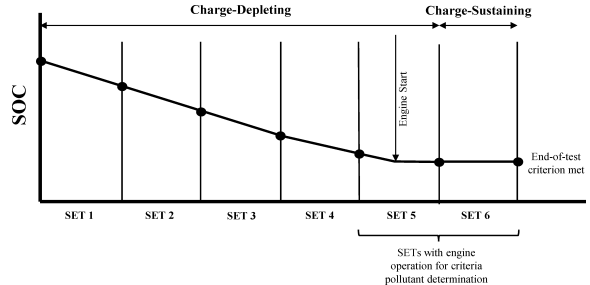
(e) Determine greenhouse gas pollutant emissions for plug-in hybrid powertrains using the emissions results for all the SET test intervals for both charge-depleting and charge-sustaining operation from paragraph (d)(2) of this section. Calculate the utility factor-weighted composite mass of emissions from the charge-depleting and charge-sustaining test results, eUF[emission]comp, using the following equation:

Eq. 1036.510-10
Where:
i = an indexing variable that represents one test interval.
N = total number of charge-depleting test intervals.
e[emission][int]CDi = total mass of emissions in the charge-depleting portion of the test for each test interval, i, starting from i = 1, including the test interval(s) from the transition phase.
UFDCDi = utility factor fraction at distance DCDi from Eq. 1036.510-11, as determined by interpolating the approved utility factor curve for each test interval, i, starting from i = 1. Let UFDCD0 = 0.
j = an indexing variable that represents one test interval.
M = total number of charge-sustaining test intervals.
e[emission][int]CS = total mass of emissions in the charge-sustaining portion of the test for each test interval, j, starting from j = 1.
UFRCD = utility factor fraction at the full charge-depleting distance, RCD, as determined by interpolating the approved utility factor curve. RCD is the cumulative distance driven over N charge-depleting test intervals.

Eq. 1036.510-11
Where:
k = an indexing variable that represents one recorded velocity value.
Q = total number of measurements over the test interval.
v = vehicle velocity at each time step, k, starting from k = 1. For tests completed under this section, v is the vehicle velocity from the vehicle model in §1036.545. Note that this should include charge-depleting test intervals that start when the engine is not yet operating.
Δ t = 1/ frecord
frecord = the record rate.
Example using the charge-depletion test in figure 1 to paragraph (d)(4) of this section for the SET for CO2emission determination:
Q = 24000
1 = 0 mi/hr
2 = 0.8 mi/hr
3 = 1.1 mi/hr
frecord = 10 Hz
Δ t = 1/10 Hz = 0.1 s

DCD1 = 30.1 mi
DCD2 = 30.0 mi
DCD3 = 30.1 mi
DCD4 = 30.2 mi
DCD5 = 30.1 mi
N = 5
UFDCD1 = 0.11
UFDCD2 = 0.23
UFDCD3 = 0.34
UFDCD4 = 0.45
UFDCD5 = 0.53
eCO2SETCD1 = 0 g/hp·hr
eCO2SETCD2 = 0 g/hp·hr
eCO2SETCD3 = 0 g/hp·hr
eCO2SETCD4 = 0 g/hp·hr
eCO2SETCD5 = 174.4 g/hp·hr
M = 1
eCO2SETCS = 428.1 g/hp·hr
UFRCD = 0.53

(f) Calculate and evaluate cycle-validation criteria as specified in 40 CFR 1065.514 for nonhybrid engines and §1036.545 for hybrid powertrains.
(g) Calculate the total emission mass of each constituent, m, over the test interval as described in 40 CFR 1065.650. Calculate the total work, W, over the test interval as described in 40 CFR 1065.650(d). For hybrid powertrains, calculate W using system power, Psys as described in §1036.520(f).
[88 FR 4487, Jan. 24, 2023; 89 FR 29743, Apr. 22, 2024]
§1036.512 Federal Test Procedure.
(a) Measure emissions using the transient Federal Test Procedure (FTP) as described in this section to determine whether engines meet the emission standards in subpart B of this part. Operate the engine or hybrid powertrain over one of the following transient duty cycles:
(1) For engines subject to spark-ignition standards, use the transient test interval described in paragraph (b) of appendix B to this part.
(2) For engines subject to compression-ignition standards, use the transient test interval described in paragraph (c) of appendix B to this part.
(b) Procedures apply differently for testing certain kinds of engines and powertrains as follows:
(1) The transient test intervals for nonhybrid engine testing are based on normalized speed and torque values. Denormalize speed as described in 40 CFR 1065.512. Denormalize torque as described in 40 CFR 1065.610(d).
(2) Test hybrid powertrains as described in §1036.510(b)(2), with the following exceptions:
(i) Replace Pcontrated with Prated, which is the peak rated power determined in §1036.520.
(ii) Keep the transmission in drive for all idle segments after the initial idle segment.
(iii) For hybrid engines, you may request to change the engine-commanded torque at idle to better represent curb idle transmission torque (CITT).
(iv) For plug-in hybrid powertrains, test over the FTP in both charge-sustaining and charge-depleting operation for both criteria and greenhouse gas pollutant determination.
(c) Except as specified in paragraph (d) of this section for plug-in hybrid powertrains, the FTP duty cycle consists of an initial run through the test interval from a cold start as described in 40 CFR part 1065, subpart F, followed by a (20 ±1) minute hot soak with no engine operation, and then a final hot start run through the same transient test interval. Engine starting is part of both the cold-start and hot-start test intervals. Calculate the total emission mass of each constituent, m, over each test interval as described in 40 CFR 1065.650. Calculate the total work, W, over the test interval as described in 40 CFR 1065.650(d). For hybrid powertrains, calculate W using system power, Psys as described in §1036.520(f). Determine Psys using §1036.520(f). For powertrains with automatic transmissions, account for and include the work produced by the engine from the CITT load. Calculate the official transient emission result from the cold-start and hot-start test intervals using the following equation:

Eq. 1036.512-1
(d) Determine criteria pollutant emissions for plug-in hybrid powertrains as follows:
(1) Carry out a charge-sustaining test as described in paragraph (b)(2) of this section.
(2) Carry out a charge-depleting test as described in paragraph (b)(2) of this section, except as follows:
(i) Fully charge the battery after preconditioning.
(ii) Operate the engine or powertrain over one FTP duty cycle followed by alternating repeats of a 20-minute soak and a hot start test interval until you reach the end-of-test criteria defined in 40 CFR 1066.501(a)(3).
(iii) Calculate emission results for each successive pair of test intervals. Calculate the emission result by treating the first of the two test intervals as a cold-start test. Figure 1 to paragraph (d)(4) of this section provides an example of a charge-depleting test sequence where there are three test intervals with engine operation for two overlapping FTP duty cycles.
(3) Report the highest emission result for each criteria pollutant from all tests in paragraphs (d)(1) and (2) of this section, even if those individual results come from different test intervals.
(4) The following figure illustrates an example of an FTP charge-depleting test sequence:
Figure 1 to Paragraph (d)(4) of §1036.512—FTP Charge-Depleting Criteria Pollutant Test Sequence
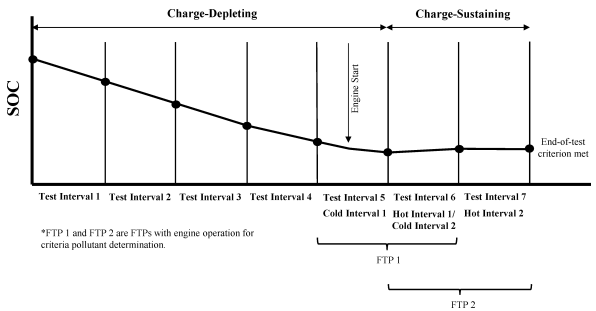
(e) Determine greenhouse gas pollutant emissions for plug-in hybrid engines and powertrains using the emissions results for all the transient duty cycle test intervals described in either paragraph (b) or (c) of appendix B to this part for both charge-depleting and charge-sustaining operation from paragraph (d)(2) of this section. Calculate the utility factor weighted composite mass of emissions from the charge-depleting and charge-sustaining test results, eUF[emission]comp, as described in §1036.510(e), replacing occurances of “SET” with “transient test interval”. Note this results in composite FTP GHG emission results for plug-in hybrid engines and powertrains without the use of the cold-start and hot-start test interval weighting factors in Eq. 1036.512-1.
(f) Calculate and evaluate cycle-validation criteria as specified in 40 CFR 1065.514 for nonhybrid engines and §1036.545 for hybrid powertrains.
[88 FR 4487, Jan. 24, 2023; 89 FR 29745, Apr. 22, 2024]
§1036.514 Low Load Cycle.
Measure emissions using the transient Low Load Cycle (LLC) as described in this section to determine whether engines meet the LLC emission standards in §1036.104. The LLC duty cycle is described in paragraph (d) of appendix B to this part. Procedures apply differently for testing certain kinds of engines and powertrains as follows:
(a) Test nonhybrid engines using the following procedures:
(1) Use the normalized speed and torque values for engine testing in the LLC duty cycle. Denormalize speed and torque values as described in 40 CFR 1065.512 and 1065.610 with the following additional requirements for testing at idle:
(i) Apply the accessory load at idle in paragraph (c) of this section using declared idle power as described in 40 CFR 1065.510(f)(6). Declared idle torque must be zero.
(ii) Apply CITT in addition to accessory load as described in this paragraph (a)(1)(ii). Set reference speed and torque values as described in 40 CFR 1065.610(d)(3)(vi) for all idle segments that are 200 s or shorter to represent the transmission operating in drive. For longer idle segments, set the reference speed and torque values to the warm-idle-in-drive values for the first three seconds and the last three seconds of the idle segment. For the points in between, set the reference speed and torque values to the warm-idle-in-neutral values to represent the transmission being manually shifted from drive to neutral shortly after the extended idle starts and back to drive shortly before it ends.
(2) Calculate and evaluate cycle-validation criteria as described in 40 CFR 1065.514, except as specified in paragraph (e) of this section.
(b) Test hybrid powertrains as described in §1036.510(b)(2), with the following exceptions:
(1) Replace Pcontrated with Prated, which is the peak rated power determined in §1036.520.
(2) Keep the transmission in drive for all idle segments 200 seconds or less. For idle segments more than 200 seconds, leave the transmission in drive for the first 3 seconds of the idle segment, then immediately place the transmission in park or neutral, and shift the transmission into drive again 3 seconds before the end of the idle segment. The end of the idle segment occurs at the first nonzero vehicle speed setpoint.
(3) For hybrid engines, you may request to change the GEM-generated engine reference torque at idle to better represent curb idle transmission torque (CITT).
(4) Adjust procedures in this section as described in §1036.510(d) and (e) for plug-in hybrid powertrains to determine criteria pollutant and greenhouse gas emissions, replacing “SET” with “LLC”. Note that the LLC is therefore the preconditioning duty cycle for plug-in hybrid powertrains.
(5) Calculate and evaluate cycle-validation criteria as specified in §1036.545.
(c) Include vehicle accessory loading as follows:
(1) Apply a vehicle accessory load for each idle point in the cycle using the power values in the following table:
| Primary intended service class | Power representing accessory load (kW) |
|---|---|
| Light HDE | 1.5 |
| Medium HDE | 2.5 |
| Heavy HDE | 3.5 |
(2) For nonhybrid engine testing, apply vehicle accessory loads in addition to any applicable CITT.
(3) Additional provisions related to vehicle accessory load apply for engines with stop-start technology and hybrid powertrains where the accessory load is applied to the engine shaft. Account for the loss of mechanical work due to the lack of any idle accessory load during engine-off conditions by determining the total loss of mechanical work from idle accessory load during all engine-off intervals over the entire test interval and distributing that work over the engine-on portion of the entire test interval based on a calculated average power. You may determine the engine-off time by running practice cycles or through engineering analysis.
(d) Except as specified in paragraph (b)(4) of this section for plug-in hybrid powertrains, the test sequence consists of preconditioning the engine by running one or two FTPs with each FTP followed by (20 ± 1) minutes with no engine operation and a hot start run through the LLC. You may start any preconditioning FTP with a hot engine. Perform testing as described in 40 CFR 1065.530 for a test interval that includes engine starting. Calculate the total emission mass of each constituent, m, over the test interval as described in 40 CFR 1065.650. For nonhybrid engines, calculate the total work, W, over the test interval as described in 40 CFR 1065.650(d). For hybrid powertrains, calculate total positive work over the test interval using system power, Psys. Determine Psys using §1036.520(f). For powertrains with automatic transmissions, account for and include the work produced by the engine from the CITT load.
(e) For testing spark-ignition gaseous-fueled engines with fuel delivery at a single point in the intake manifold, you may apply the alternative cycle-validation criteria for the LLC in the following table:
| Parameter | Speed | Torque | Power |
| Slope, a1 | 0.800 ≤ a1 ≤ 1.030 | 0.800 ≤ a1 ≤ 1.030. | |
|
Absolute value of intercept, |
a0
|
Standard error of the estimate, SEE | ≤15% of maximum mapped power. | ||
| Coefficient of determination, r2 | ≥0.650 | ≥0.650. | |
| a Cycle-validation criteria apply as specified in 40 CFR 1065.514 unless otherwise specified. | |||
[88 FR 4487, Jan. 24, 2023; 89 FR 29746, Apr. 22, 2024]
§1036.520 Determining power and vehicle speed values for powertrain testing.
This section describes how to determine the system peak power and continuous rated power of hybrid and nonhybrid powertrain systems and the vehicle speed for carrying out duty-cycle testing under this part and §1036.545.
(a) You must map or re-map an engine before a test if any of the following apply:
(1) If you have not performed an initial engine map.
(2) If the atmospheric pressure near the engine's air inlet is not within ±5 kPa of the atmospheric pressure recorded at the time of the last engine map.
(3) If the engine or emission-control system has undergone changes that might affect maximum torque performance. This includes changing the configuration of auxiliary work inputs and outputs.
(4) If you capture an incomplete map on your first attempt or you do not complete a map within the specified time tolerance. You may repeat mapping as often as necessary to capture a complete map within the specified time.
(b) Set up the powertrain test according to §1036.545, with the following exceptions:
(1) Use vehicle parameters, other than power, as specified in §1036.510(b)(2). Use the applicable automatic transmission as specified in §1036.540(c)(2).
(2) Select a manufacturer-declared value for Pcontrated to represent system peak power.
(c) Verify the following before the start of each test interval:
(1) The state-of-charge of the rechargeable energy storage system (RESS) must be at or above 90% of the operating range between the minimum and maximum RESS energy levels specified by the manufacturer.
(2) The conditions of all hybrid system components must be within their normal operating range as declared by the manufacturer, including ensuring that no features are actively limiting power or vehicle speed.
(d) Carry out the test as described in this paragraph (d). Warm up the powertrain by operating it. We recommend operating the powertrain at any vehicle speed and road grade that achieves approximately 75% of its expected maximum power. Continue the warm-up until the engine coolant, block, lubricating oil, or head absolute temperature is within ±2% of its mean value for at least 2 min or until the engine thermostat controls engine temperature. Within 90 seconds after concluding the warm-up, operate the powertrain over a continuous trace meeting the following specifications:
(1) Bring the vehicle speed to 0 mi/hr and let the powertrain idle at 0 mi/hr for 50 seconds.
(2) Set maximum driver demand for a full load acceleration at 6.0% road grade with an initial vehicle speed of 0 mi/hr, continuing for 268 seconds. You may increase initial vehicle speed up to 5 mi/hr to minimize clutch slip.
(3) Linearly ramp the grade from 6.0% down to 0.0% over 300 seconds. Stop the test after the acceleration is less than 0.02 m/s 2.
(e) Record the powertrain system angular speed and torque values measured at the dynamometer at 100 Hz and use these in conjunction with the vehicle model to calculate vehicle system power, Psys,vehicle. Note that Psys, is the corresponding value for system power at a location that represents the transmission input shaft on a conventional powertrain.
(f) Calculate the system power, Psys, for each data point as follows:
(1) For testing with the speed and torque measurements at the transmission input shaft, Psys is equal to the calculated vehicle system power, Psys,vehicle, determined in paragraphs (d) and (e) of this section.
(2) For testing with the speed and torque measurements at the axle input shaft or the wheel hubs, determine Psys for each data point using the following equation:

Where:
Psys,vehicle = the calculated vehicle system power for each 100-Hz data point.
εtrans = the default transmission efficiency = 0.95.
εaxle = the default axle efficiency. Set this value to 1 for speed and torque measurement at the axle input shaft or to 0.955 at the wheel hubs.
Example:
Psys,vehicle = 317.6 kW
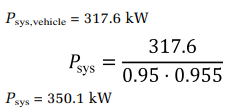
Psys = 350.1 kW
(g) For each 200-ms (5-Hz) time step, t, determine the coefficient of variation (COV) of as follows:
(1) Calculate the standard deviation, σ (t) of the 20 100-Hz data points in each 5-Hz measurement interval using the following equation:
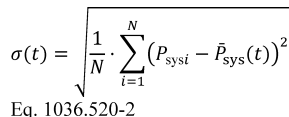
Where:
N = the number of data points in each 5-Hz measurement interval = 20.
Psysi = the 100-Hz values of P sys within each 5-Hz measurement interval.
Psys(t) = the mean power from each 5-Hz measurement interval.
(2) Calculate the 5-Hz values for COV (t) for each time step, t, as follows:

(h) Determine rated power, Prated, as the maximum measured power from the data collected in paragraph (d)(2) of this section where the COV determined in paragraph (g) of this section is less than 2%.
(i) Determine continuous rated power, Pcontrated, as follows:
(1) For nonhybrid powertrains, Pcontrated equals Prated.
(2) For hybrid powertrains, Pcontrated is the maximum measured power from the data collected in paragraph (d)(3) of this section where the COV determined in paragraph (g) of this section is less than 2%.
(j) Determine vehicle C speed, vrefC, as follows:
(1) If the maximum Psys ( t ) in the highest gear during the maneuver in paragraph (d)(3) of this section is greater than 0.98· Pcontrated, vrefC is the average of the minimum and maximum vehicle speeds where Psys ( t ) is equal to 0.98· Pcontrated during the maneuver in paragraph (d)(3) where the transmission is in the highest gear, using linear interpolation, as appropriate. If Psys ( t ) at the lowest vehicle speed where the transmission is in the highest gear is greater than 0.98· Pcontrated, use the lowest vehicle speed where the transmission is in the highest gear as the minimum vehicle speed input for calculating vrefC.
(2) Otherwise, vrefC is the maximum vehicle speed during the maneuver in paragraph (d)(3) of this section where the transmission is in the highest gear.
(3) You may use a declared vrefC instead of measured vrefC if the declared vrefC is within (97.5 to 102.5)% of the corresponding measured value.
(4) Manufacturers may request approval to use an alternative vehicle C speed in place of the measured vehicle C speed determined in this paragraph (j) for series hybrid applications. Approval will be contingent upon justification that the measured vehicle C speed is not representative of the expected real-world cruise speed.
(k) If Pcontrated as determined in paragraph (i) of this section is within ±3% of the manufacturer-declared value for Pcontrated, use the manufacturer-declared value. Otherwise, repeat the procedure in paragraphs (b) through (j) of this section and use Pcontrated from paragraph (i) instead of the manufacturer-declared value.
[88 FR 4487, Jan. 24, 2023; 89 FR 29747, Apr. 22, 2024]
§1036.525 Clean Idle test.
Measure emissions using the procedures described in this section to determine whether engines and hybrid powertrains meet the clean idle emission standards in §1036.104(b). For plug-in hybrid powertrains, perform the test with the hybrid function disabled.
(a) The clean idle test consists of two separate test intervals as follows:
(1) Mode 1 consists of engine operation with a speed setpoint at your recommended warm idle speed. Set the dynamometer torque demand corresponding to vehicle power requirements at your recommended warm idle speed that represent in-use operation.
(2) Mode 2 consists of engine operation with a speed setpoint at 1100 r/min. Set the dynamometer torque demand to account for the sum of the following power loads:
(i) Determine power requirements for idling at 1100 r/min.
(ii) Apply a power demand of 2 kW to account for appliances and accessories the vehicle operator may use during rest periods.
(3) Determine torque demand for testing under this paragraph (a) based on an accessory load that includes the engine cooling fan, alternator, coolant pump, air compressor, engine oil and fuel pumps, and any other engine accessory that operates at the specific test condition. Also include the accessory load from the air conditioning compressor operating at full capacity for Mode 2. Do not include any other load for air conditioning or other cab or vehicle accessories except as specified.
(b) Perform the Clean Idle test as follows:
(1) Warm up the engine by operating it over the FTP or SET duty cycle, or by operating it at any speed above peak-torque speed and at (65 to 85) % of maximum mapped power. The warm-up is complete when the engine thermostat controls engine temperature or when the engine coolant's temperature is within 2% of its mean value for at least 2 minutes.
(2) Start operating the engine in Mode 1 as soon as practical after the engine warm-up is complete.
(3) Start sampling emissions 10 minutes after reaching the speed and torque setpoints and continue emission sampling and engine operation at those setpoints. Stop emission sampling after 1200 seconds to complete the test interval.
(4) Linearly ramp the speed and torque setpoints over 5 seconds to start operating the engine in Mode 2. Sample emissions during Mode 2 as described in paragraph (b)(3) of this section.
(c) Verify that the test speed stays within ±50 r/min of the speed setpoint throughout the test. The torque tolerance is ±2 percent of the maximum mapped torque at the test speed. Verify that measured torque meets the torque tolerance relative to the torque setpoint throughout the test.
(d) Calculate the mean mass emission rate of NO X , m , over each test interval by calculating the total emission mass m NOx and dividing by the total time.
[88 FR 4487, Jan. 24, 2023; 89 FR 29748, Apr. 22, 2024]
§1036.530 Test procedures for off-cycle testing.
(a) General. This section describes the measurement and calculation procedures to perform field testing and determine whether tested engines and engine families meet emission standards under subpart E of this part. Calculate mass emission rates as specified in 40 CFR part 1065, subpart G. Use good engineering judgment to adapt these procedures for simulating vehicle operation in the laboratory.
(b) Vehicle preparation and measurement procedures. (1) Set up the vehicle for testing with a portable emissions measurement system (PEMS) as specified in 40 CFR part 1065, subpart J.
(2) Begin emission sampling and data collection as described in 40 CFR 1065.935(c)(3) before starting the engine at the beginning of the shift-day. Start the engine only after confirming that engine coolant temperature is at or below 40 °C.
(3) Measure emissions over one or more shift-days as specified in subpart E of this part.
(4) For engines subject to compression-ignition standards, record 1 Hz measurements of ambient temperature near the vehicle.
(c) Test Intervals. Determine the test intervals as follows:
(1) Spark-ignition. Create a single test interval that covers the entire shift-day for engines subject to spark-ignition standards. The test interval starts with the first pair of consecutive data points with no exclusions as described in paragraph (c)(3) of this section after the start of the shift-day and ends with the last pair of consecutive data points with no exclusions before the end of the shift day.
(2) Compression-ignition. Create a series of 300 second test intervals for engines subject to compression-ignition standards (moving-average windows) as follows:
(i) Begin and end each test interval with a pair of consecutive data points with no exclusions as described in paragraph (c)(3) of this section. Select the last data point of each test interval such that the test interval includes 300 seconds of data with no exclusions, as described in paragraph (d) of this section. The test interval may be a fraction of a second more or less than 300 seconds to account for the precision of the time stamp in recording 1 Hz data. A test interval may include up to 599 seconds of data with continuous exclusions; invalidate any test interval that includes at least 600 seconds of continuous sampling with excluded data.
(ii) The first 300 second test interval starts with the first pair of consecutive data points with no exclusions. Determine the start of each subsequent 300 second test interval by finding the first pair of consecutive data points with no exclusions after the initial data point of the previous test interval.
(iii) The last 300 second test interval ends with the last pair of consecutive data points with no exclusions before the end of the shift day.
(3) Excluded data. Exclude data from test intervals for any period meeting one or more of the following conditions:
(i) An analyzer or flow meter is performing zero and span drift checks or zero and span calibrations, including any time needed for the analyzer to stabilize afterward, consistent with good engineering judgment.
(ii) The engine is off, except as specified in §1036.415(g).
(iii) The engine is performing an infrequent regeneration. Do not exclude data related to any other AECDs, except as specified in paragraph (c)(3)(vi) of this section.
(iv) The recorded ambient air temperature is below 5 °C or above the temperature calculated using the following equation.

Where:
h = recorded elevation of the vehicle in feet above sea level (h is negative for elevations below sea level).
Example:
h = 2679 ft
Tmax = −0.0014·2679 + 37.78
Tmax = 34.0 °C
(v) The vehicle is operating at an elevation more than 5,500 feet above sea level.
(vi) An engine has one or more active AECDs for emergency vehicles under §1036.115(h)(4).
(vii) A single data point does not meet any of the conditions specified in paragraphs (c)(3)(i) through (vi) of this section, but it is preceded and followed by data points that both meet one or more of the specified exclusion conditions.
(d) Assembling test intervals. A test interval may include multiple subintervals separated by periods with one or more exclusions under paragraph (c)(3) of this section.
(1) Treat these test subintervals as continuous for calculating duration of the test interval for engines subject to compression-ignition standards.
(2) Calculate emission mass during each test subinterval and sum those subinterval emission masses to determine the emission mass over the test interval. Calculate emisson mass as described in 40 CFR 1065.650(c)(2)(i), with the following exceptions and clarifications:
(i) Correct NO X emissions for humidity as specified in 40 CFR 1065.670. Calculate corrections relative to ambient air humidity as measured by PEMS.
(ii) Disregard the provision in 40 CFR 1065.650(g) for setting negative emission mass to zero for test intervals and subintervals.
(iii) Calculation of emission mass in 40 CFR 1065.650 assumes a constant time interval, Δ t. If it is not appropriate to assume Δ t is constant for testing under this section, use good engineering judgment to record time at each data point and adjust the mass calculation from Eq. 1065.650-4 by treating Δ t as a variable.
(e) Normalized CO2emission mass over a 300 second test interval. For engines subject to compression-ignition standards, determine the normalized CO 2 emission mass over each 300 second test interval, mCO2,norm,testinterval , to the nearest 0.01% using the following equation:

Where:
mCO2,testinterval = total CO 2 emission mass over the test interval.
eCO2FTPFCL = the engine's FCL for CO 2 over the FTP duty cycle. If the engine family includes no FTP testing, use the engine's FCL for CO 2 over the SET duty cycle.
Pmax = the highest value of rated power for all the configurations included in the engine family.
ttestinterval = duration of the test interval. Note that the nominal value is 300 seconds.
Example:
mCO2,testinterval = 3948 g
eCO2FTPFCL = 428.2 g/hp·hr Pmax = 406.5 hp
ttestinterval = 300.01 s = 0.08 hr

mCO2,norm,testinterval = 0.2722 = 27.22%
(f) Binning 300 second test intervals. For engines subject to compression-ignition standards, identify the appropriate bin for each of the 300 second test intervals based on its normalized CO 2 emission mass, mCO2,norm,testinterval, as follows:
| Bin | Normalized CO 2 emission mass over the 300 second test interval |
|---|---|
| Bin 1 | mCO2,norm,testinterval ≤ 6.00%. |
| Bin 2 | mCO2,norm,testinterval > 6.00%. |
(g) Off-cycle emissions quantities. Determine the off-cycle emissions quantities as follows:
(1) Spark-ignition. For engines subject to spark-ignition standards, the off-cycle emission quantity, e[emission],offcycle, is the value for CO2 -specific emission mass for a given pollutant over the test interval representing the shift-day converted to a brake-specific value, as calculated for each measured pollutant using the following equation:

Eq. 1036.530-3
Where:
m[emission] = total emission mass for a given pollutant over the test interval as determined in paragraph (d)(2) of this section.
mCO2 = total CO2 emission mass over the test interval as determined in paragraph (d)(2) of this section.
eCO2FTPFCL = the engine's FCL for CO 2 over the FTP duty cycle.
Example:

(2) Compression-ignition. For engines subject to compression-ignition standards, determine the off-cycle emission quantity for each bin. When calculating mean bin emissions from ten engines to apply the pass criteria for engine families in §1036.425(c), set any negative off-cycle emissions quantity to zero before calculating mean bin emissions.
(i) Off-cycle emissions quantity for bin 1. The off-cycle emission quantity for bin 1, m NOx,offcycle,bin1 , is the mean NO X mass emission rate from all test intervals associated with bin 1 as calculated using the following equation:

Where:
i = an indexing variable that represents one 300 second test interval.
N = total number of 300 second test intervals in bin 1.
mNOtestinterval,i = total NO X emission mass over the test interval i in bin 1 as determined in paragraph (d)(2) of this section.
ttestinterval,i = total time of test interval i in bin 1 as determined in paragraph (d)(1) of this section. Note that the nominal value is 300 seconds.
Example:
N = 10114
mNO , testinterval,1 = 0.021 g
mNO , testinterval,2 = 0.025 g
mNO , testinterval,3 = 0.031 g
ttestinterval,1 = 299.99 s
ttestinterval,2 = 299.98 s
ttestinterval,3 = 300.04 s

m NOoffcycle,bin1, = 0.000285 g/s = 1.026 g/hr
(ii) Off-cycle emissions quantity for bin 2. The off-cycle emission quantity for bin 2, e[emission],offcycle,bin2, is the value for CO2 -specific emission mass for a given pollutant of all the 300 second test intervals in bin 2 combined and converted to a brake-specific value, as calculated for each measured pollutant using the following equation:

Eq. 1036.530-5
Where:
i = an indexing variable that represents one 300 second test interval.
N = total number of 300 second test intervals in bin 2.
m[emission],testinterval,i = total emission mass for a given pollutant over the test interval i in bin 2 as determined in paragraph (d)(2) of this section.
mCO2,testinterval,i = total CO2 emission mass over the test interval i in bin 2 as determined in paragraph (d)(2) of this section.
eCO2,FTP,FCL = the engine's FCL for CO2 over the FTP duty cycle.
Example:
N = 15439
mNOx1 = 0.546 g
mNOx2 = 0.549 g
mNOx3 = 0.556 g
mCO2,1 = 10950.2 g
mCO2,2 = 10961.3 g
mCO2,3 = 10965.3 g
eCO2,FTP,FCL = 428.1 g/hp·hr

(h) Shift-day ambient temperature. For engines subject to compression-ignition standards, determine the mean shift-day ambient temperature, T amb , considering only temperature readings corresponding to data with no exclusions under paragraph (c)(3) of this section.
(i) Graphical illustration. Figure 1 of this section illustrates a test interval with interruptions of one or more data points excluded under paragraph (c)(3) of this section. The x-axis is time and the y-axis is the mass emission rate at each data point, m (t) The data points coincident with any exclusion are illustrated with open circles. The shaded area corresponding to each group of closed circles represents the total emission mass over that test subinterval. Note that negative values of m (t) are retained and not set to zero in the numerical integration calculation. The first group of data points without any exclusions is referred to as the first test subinterval and so on.
Figure 1 to Paragraph (i) of §1036.530—Illustration of Integration of Mass of Emissions Over a Test Interval With Exclude Data Points
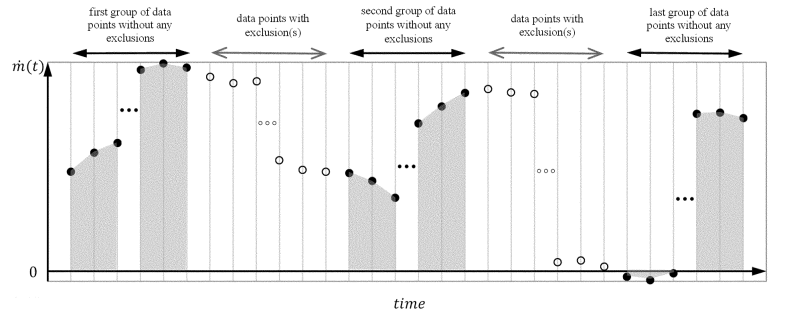
(j) Fuel other than carbon-containing. The following procedures apply for testing engines using at least one fuel that is not a carbon-containing fuel:
(1) Use the following equation to determine the normalized equivalent CO 2 emission mass over each 300 second test interval instead of Eq. 1036.530-2:

Eq. 1036.530-6
Where:
Wtestinterval = total positive work over the test interval from both the engine and hybrid components, if applicable, as determined in 40 CFR 1065.650.
Pmax = the highest value of rated power for all the configurations included in the engine family.
ttestinterval = duration of the test interval. Note that the nominal value is 300 seconds.
Example:
Wtestinterval = 8.95 hp·hr
Pmax = 406.5 hp
ttestinterval = 300.01 s = 0.08 hr

(2) Determine off-cycle emissions quantities as follows:
(i) For engines subject to spark-ignition standards, use the following equation to determine the off-cycle emission quantity instead of Eq. 1036.530-3:

Eq. 1036.530-7
Where:
m[emission] = total emission mass for a given pollutant over the test interval as determined in paragraph (d)(2) of this section.
Wtestinterval = total positive work over the test interval as determined in 40 CFR 1065.650.
Example:

(ii) For engines subject to compression-ignition standards, use Eq. 1036.530-4 to determine the off-cycle emission quantity for bin 1.
(iii) For engines subject to compression-ignition standards, use the following equation to determine the off-cycle emission quantity for bin 2 instead of Eq. 1036.530-5:

Eq. 1036.530-8
Where:
i = an indexing variable that represents one 300 second test interval.
N = total number of 300 second test intervals in bin 2.
m[emission],testinterval,i = total emission mass for a given pollutant over the test interval i in bin 2 as determined in paragraph (d)(2) of this section.
Wtestinterval,i = total positive work over the test interval i in bin 2 as determined in 40 CFR 1065.650.
Example:
N = 15439
mNOx1 = 0.546 g
mNOx2 = 0.549 g
mNOx3 = 0.556 g
Wtestinterval1 = 8.91 hp·hr
Wtestinterval2 = 8.94 hp·hr
Wtestinterval3 = 8.89 hp·hr

[88 FR 4487, Jan. 24, 2023; 89 FR 29748, Apr. 22, 2024]
§1036.535 Determining steady-state engine fuel maps and fuel consumption at idle.
The procedures in this section describe how to determine an engine's steady-state fuel map and fuel consumption at idle for model year 2021 and later vehicles; these procedures apply as described in §1036.505. Vehicle manufacturers may need these values to demonstrate compliance with emission standards under 40 CFR part 1037.
(a) General test provisions. Perform fuel mapping using the procedure described in paragraph (b) of this section to establish measured fuel-consumption rates at a range of engine speed and load settings. Measure fuel consumption at idle using the procedure described in paragraph (c) of this section. Paragraph (d) of this section describes how to apply the steady-state mapping from paragraph (b) of this section for the special case of cycle-average mapping for highway cruise cycles as described in §1036.540. Use these measured fuel-consumption values to declare fuel-consumption rates for certification as described in paragraph (g) of this section.
(1) Map the engine's torque curve and declare engine idle speed as described in §1036.505(c)(1) and (3). Perform emission measurements as described in 40 CFR 1065.501 and 1065.530 for discrete-mode steady-state testing. This section uses engine parameters and variables that are consistent with 40 CFR part 1065.
(2) Measure NO X emissions as described in paragraph (f) of this section. Include these measured NO X values any time you report to us your fuel consumption values from testing under this section.
(3) You may use shared data across engine configurations to the extent that the fuel-consumption rates remain valid.
(4) The provisions related to carbon balance error verification in §1036.543 apply for all testing in this section. These procedures are optional, but we will perform carbon balance error verification for all testing under this section.
(5) Correct fuel mass flow rate to a mass-specific net energy content of a reference fuel as described in paragraph (e) of this section.
(b) Steady-state fuel mapping. Determine steady-state fuel-consumption rates for each engine configuration over a series of paired engine speed and torque setpoints as described in this paragraph (b). For example, if you test a high-output (parent) configuration and create a different (child) configuration that uses the same fueling strategy but limits the engine operation to be a subset of that from the high-output configuration, you may use the fuel-consumption rates for the reduced number of mapped points for the low-output configuration, as long as the narrower map includes at least 70 points. Perform fuel mapping as follows:
(1) Generate the fuel-mapping sequence of engine speed and torque setpoints as follows:
(i) Select the following required speed setpoints: warm idle speed, fnidle the highest speed above maximum power at which 70% of maximum power occurs, nhi, and eight (or more) equally spaced points between fnidle and nhi. (See 40 CFR 1065.610(c)). For engines with adjustable warm idle speed, replace fnidle with minimum warm idle speed fnidlemin.
(ii) Select the following required torque setpoints at each of the selected speed setpoints: zero (T = 0), maximum mapped torque, Tmax mapped, and eight (or more) equally spaced points between T = 0 and Tmax mapped. Select the maximum torque setpoint at each speed to conform to the torque map as follows:
(A) Calculate 5 percent of Tmax mapped. Subtract this result from the mapped torque at each speed setpoint, Tmax.
(B) Select Tmax at each speed setpoint as a single torque value to represent all the required torque setpoints above the value determined in paragraph (b)(1)(ii)(A) of this section. All the other default torque setpoints less than Tmax at a given speed setpoint are required torque setpoints.
(iii) You may select any additional speed and torque setpoints consistent with good engineering judgment. For example, you may need to select additional points if the engine's fuel consumption is nonlinear across the torque map. Avoid creating a problem with interpolation between narrowly spaced speed and torque setpoints near Tmax. For each additional speed setpoint, we recommend including a torque setpoint of Tmax; however, you may select torque setpoints that properly represent in-use operation. Increments for torque setpoints between these minimum and maximum values at an additional speed setpoint must be no more than one-ninth of Tmax,mapped. Note that if the test points were added for the child rating, they should still be reported in the parent fuel map. We will test with at least as many points as you. If you add test points to meet testing requirements for child ratings, include those same test points as reported values for the parent fuel map. For our testing, we will use the same normalized speed and torque test points you use, and we may select additional test points.
(iv) Start fuel-map testing at the highest speed setpoint and highest torque setpoint, followed by decreasing torque setpoints at the highest speed setpoint. Continue testing at the next lowest speed setpoint and the highest torque setpoint at that speed setpoint, followed by decreasing torque setpoints at that speed setpoint. Follow this pattern through all the speed and torque points, ending with the lowest speed (fnidle or fnidlemin) and torque setpoint (T = 0). The following figure illustrates an array of test points and the corresponding run order.
Figure 1 to Paragraph (b)(1)(iv) of §1036.535—Illustration of Steady-State Fuel-Mapping Test Points and Run Order
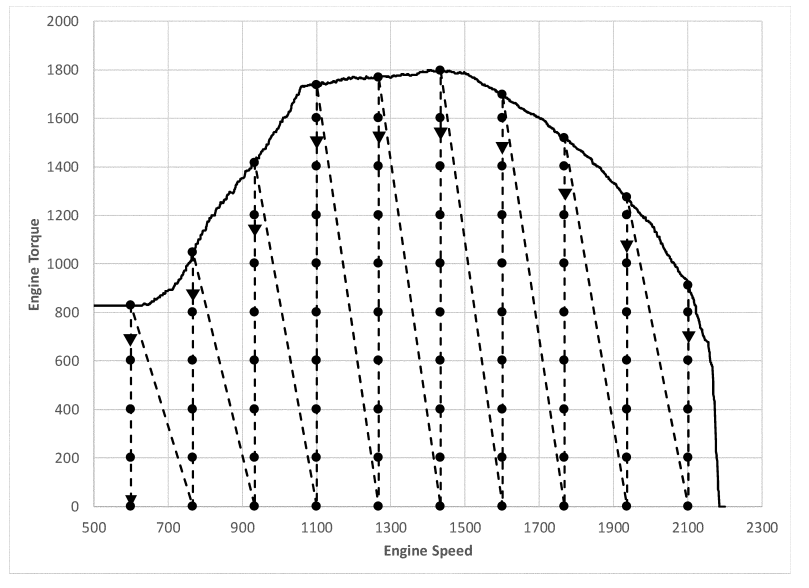
(v) The highest torque setpoint for each speed setpoint is an optional reentry point to restart fuel mapping after an incomplete test run.
(vi) The lowest torque setpoint at each speed setpoint is an optional exit point to interrupt testing. Paragraph (b)(7) of this section describes how to interrupt testing at other times.
(2) If the engine's warm idle speed is adjustable, set it to its minimum value, fnidlemin.
(3) The measurement at each unique combination of speed and torque setpoints constitutes a test interval. Unless we specify otherwise, you may program the dynamometer to control either speed or torque for a given test interval, with operator demand controlling the other parameter. Control speed and torque so that all recorded speed points are within ±1% of nhi from the target speed and all recorded engine torque points are within ±5% of Tmax mapped from the target torque during each test interval, except as follows:
(i) For steady-state engine operating points that cannot be achieved, and the operator demand stabilizes at minimum; program the dynamometer to control torque and let the engine govern speed (see 40 CFR 1065.512(b)(1)). Control torque so that all recorded engine torque points are within ±25 N·m from the target torque. The specified speed tolerance does not apply for the test interval.
(ii) For steady-state engine operating points that cannot be achieved and the operator demand stabilizes at maximum and the speed setpoint is below 90% of nhi even with maximum operator demand, program the dynamometer to control speed and let the engine govern torque (see 40 CFR 1065.512(b)(2)). The specified torque tolerance does not apply for the test interval.
(iii) For steady-state engine operating points that cannot be achieved and the operator demand stabilizes at maximum and the speed setpoint is at or above 90% of nhi even with maximum operator demand, program the dynamometer to control torque and let the engine govern speed (see 40 CFR 1065.512(b)(1)). The specified speed tolerance does not apply for the test interval.
(iv) For the steady-state engine operating points at the minimum speed setpoint and maximum torque setpoint, you may program the dynamometer to control speed and let the engine govern torque. The specified torque tolerance does not apply for this test interval if operator demand stabilizes at its maximum or minimum limit.
(4) Record measurements using direct and/or indirect measurement of fuel flow as follows:
(i) Direct fuel-flow measurement. Record speed and torque and measure fuel consumption with a fuel flow meter for (30 ± 1) seconds. Determine the corresponding mean values for the test interval. Use of redundant direct fuel-flow measurements requires our advance approval.
(ii) Indirect fuel-flow measurement. Record speed and torque and measure emissions and other inputs needed to run the chemical balance in 40 CFR 1065.655(c) for (30 ± 1) seconds. Determine the corresponding mean values for the test interval. Use of redundant indirect fuel-flow measurements requires our advance approval. Measure background concentration as described in 40 CFR 1065.140, except that you may use one of the following methods to apply a single background reading to multiple test intervals:
(A) For batch sampling, you may sample periodically into the bag over the course of multiple test intervals and read them as allowed in paragraph (b)(7)(i) of this section. You must determine a single background reading for all affected test intervals if you use the method described in this paragraph (b)(4)(ii)(A).
(B) You may measure background concentration by sampling from the dilution air during the interruptions allowed in paragraph (b)(7)(i) of this section or at other times before or after test intervals. Measure background concentration within 30 minutes before the first test interval and within 30 minutes before each reentry point. Measure the corresponding background concentration within 30 minutes after each exit point and within 30 minutes after the final test interval. You may measure background concentration more frequently. Correct measured emissions for test intervals between a pair of background readings based on the average of those two values. Once the system stabilizes, collect a background sample over an averaging period of at least 30 seconds.
(5) Warm up the engine as described in 40 CFR 1065.510(b)(2). Within 60 seconds after concluding the warm-up, linearly ramp the speed and torque setpoints over 5 seconds to the starting test point from paragraph (b)(1) of this section.
(6) Stabilize the engine by operating at the specified speed and torque setpoints for (70 ± 1) seconds and then start the test interval. Record measurements during the test interval. Measure and report NO X emissions over each test interval as described in paragraph (f) of this section.
(7) After completing a test interval, linearly ramp the speed and torque setpoints over 5 seconds to the next test point.
(i) You may interrupt the fuel-mapping sequence before a reentry point as noted in paragraphs (b)(1)(v) and (vi) of this section. If you zero and span analyzers, read and evacuate background bag samples, or sample dilution air for a background reading during the interruption, the maximum time to stabilize in paragraph (b)(6) of this section does not apply. If you shut off the engine, restart with engine warm-up as described in paragraph (b)(5) of this section.
(ii) You may interrupt the fuel-mapping sequence at a given speed setpoint before completing measurements at that speed. If this happens, you may measure background concentration and take other action as needed to validate test intervals you completed before the most recent reentry point. Void all test intervals after the last reentry point. Restart testing at the appropriate reentry point in the same way that you would start a new test. Operate the engine long enough to stabilize aftertreatment thermal conditions, even if it takes more than 70 seconds. In the case of an infrequent regeneration event, interrupt the fuel-mapping sequence and allow the regeneration event to finish with the engine operating at a speed and load that allows effective regeneration.
(iii) If you void any one test interval, all the testing at that speed setpoint is also void. Restart testing by repeating the fuel-mapping sequence as described in this paragraph (b); include all voided speed setpoints and omit testing at speed setpoints that already have a full set of valid results.
(8) If you determine fuel-consumption rates using emission measurements from the raw or diluted exhaust, calculate the mean fuel mass flow rate, m fuel, for each point in the fuel map using the following equation:

Where:
m fuel = mean fuel mass flow rate for a given fuel map setpoint, expressed to at least the nearest 0.001 g/s.
WCmeas = carbon mass fraction of fuel (or mixture of test fuels) as determined in 40 CFR 1065.655(d), except that you may not use the default properties in 40 CFR 1065.655(e)(5) to determine α, β, and wC . You may not account for the contribution to α, β, γ,and δ of diesel exhaust fluid or other non-fuel fluids injected into the exhaust.
n = the mean exhaust molar flow rate from which you measured emissions according to 40 CFR 1065.655.
x Ccombdry = the mean concentration of carbon from fuel and any injected fluids in the exhaust per mole of dry exhaust as determined in 40 CFR 1065.655(c).
x H2Oexhdry = the mean concentration of H 2 O in exhaust per mole of dry exhaust as determined in 40 CFR 1065.655(c).
m CO2DEF = the mean CO 2 mass emission rate resulting from diesel exhaust fluid decomposition as determined in paragraph (b)(9) of this section. If your engine does not use diesel exhaust fluid, or if you choose not to perform this correction, set m CO2DEF equal to 0.
MCO2 = molar mass of carbon dioxide.
Example:
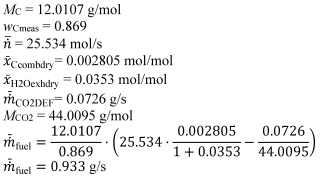
(9) If you determine fuel-consumption rates using emission measurements with engines that utilize diesel exhaust fluid for NO X control and you correct for the mean CO 2 mass emission rate resulting from diesel exhaust fluid decomposition as described in paragraph (b)(8) of this section, perform this correction at each fuel map setpoint using the following equation:

Where:
m DEF = the mean mass flow rate of injected urea solution diesel exhaust fluid for a given sampling period, determined directly from the ECM, or measured separately, consistent with good engineering judgment.
MCO2 = molar mass of carbon dioxide.
wCH4N2O = mass fraction of urea in diesel exhaust fluid aqueous solution. Note that the subscript “CH4N2O” refers to urea as a pure compound and the subscript “DEF” refers to the aqueous urea diesel exhaust fluid as a solution of urea in water. You may use a default value of 32.5% or use good engineering judgment to determine this value based on measurement.
MCH4N2O = molar mass of urea.
Example:
m DEF = 0.304 g/s
MCO2 = 44.0095 g/mol
wCH4N2O = 32.5% = 0.325
MCH4N2O = 60.05526 g/mol

m CO2DEF = 0.0726 g/s
(10) Correct the measured or calculated mean fuel mass flow rate, at each of the operating points to account for mass-specific net energy content as described in paragraph (e) of this section.
(c) Fuel consumption at idle. Determine fuel-consumption rates at idle for each engine configuration that is certified for installation in vocational vehicles. Determine fuel-consumption rates at idle by testing engines over a series of paired engine speed and torque setpoints as described in this paragraph (c). Perform measurements as follows:
(1) The idle test sequence consists of measuring fuel consumption at four test points representing each combination of the following speed and torque setpoints in any order.
(i) Speed setpoints for engines with adjustable warm idle speed are minimum warm idle speed, fnidlemin , and maximum warm idle speed, fnidlemax . Speed setpoints for engines with no adjustable warm idle speed (with zero torque on the primary output shaft) are fnidle and 1.15 times fnidle .
(ii) Torque setpoints are 0 and 100 N·m.
(2) Control speed and torque as follows:
(i) Adjustable warm idle speed. Set the engine's warm idle speed to the next speed setpoint any time before the engine reaches the next test point. Control both speed and torque when the engine is warming up and when it is transitioning to the next test point. Start to control both speed and torque. At any time prior to reaching the next engine-idle operating point, set the engine's adjustable warm idle speed setpoint to the speed setpoint of the next engine-idle operating point in the sequence. This may be done before or during the warm-up or during the transition. Near the end of the transition period control speed and torque as described in paragraph (b)(3)(i) of this section shortly before reaching each test point. Once the engine is operating at the desired speed and torque setpoints, set the operator demand to minimum; control torque so that all recorded engine torque points are within ±25 N·m from the target torque.
(ii) Nonadjustable warm idle speed. For the lowest speed setpoint, control speed and torque as described in paragraph (c)(2)(i) of this section, except for adjusting the warm idle speed. For the second-lowest speed setpoint, control speed and torque so that all recorded speed points are within ±1% of nhi from the target speed and engine torque within ±5% of Tmax mapped from the target torque.
(3) Record measurements using direct and/or indirect measurement of fuel flow as follows:
(i) Direct fuel flow measurement. Record speed and torque and measure fuel consumption with a fuel flow meter for (600 ±1) seconds. Determine the corresponding mean values for the test interval. Use of redundant direct fuel-flow measurements require prior EPA approval.
(ii) Indirect fuel flow measurement. Record speed and torque and measure emissions and other inputs needed to run the chemical balance in 40 CFR 1065.655(c) for (600 ±1) seconds. Determine the corresponding mean values for the test interval. Use of redundant indirect fuel-flow measurements require prior EPA approval. Measure background concentration as described in paragraph (b)(4)(ii) of this section. We recommend setting the CVS flow rate as low as possible to minimize background, but without introducing errors related to insufficient mixing or other operational considerations. Note that for this testing 40 CFR 1065.140(e) does not apply, including the minimum dilution ratio of 2:1 in the primary dilution stage.
(4) Warm up the engine as described in 40 CFR 1065.510(b)(2). Within 60 seconds after concluding the warm-up, linearly ramp the speed and torque over 20 seconds to the first speed and torque setpoint.
(5) The measurement at each unique combination of speed and torque setpoints constitutes a test interval. Operate the engine at the selected speed and torque set points for (180 ±1) seconds, and then start the test interval. Record measurements during the test interval. Measure and report NO X emissions over each test interval as described in paragraph (f) of this section.
(6) After completing each test interval, repeat the steps in paragraphs (c)(4) and (5) of this section for all the remaining engine-idle test points.
(7) Each test point represents a stand-alone measurement. You may therefore take any appropriate steps between test intervals to process collected data and to prepare engines and equipment for further testing. Note that the allowances for combining background in paragraph (b)(4)(ii)(B) of this section do not apply. If an infrequent regeneration event occurs, allow the regeneration event to finish; void the test interval if the regeneration starts during a measurement.
(8) Correct the measured or calculated mean fuel mass flow rate, at each of the engine-idle operating points to account for mass-specific net energy content as described in paragraph (e) of this section.
(d) Steady-state fuel maps used for cycle-average fuel mapping of the highway cruise cycles. Determine steady-state fuel-consumption rates for each engine configuration over a series of paired engine speed and torque setpoints near idle as described in this paragraph (d). Perform fuel mapping as described in paragraph (b) of this section with the following exceptions:
(1) Select speed setpoints to cover a range of values to represent in-use operation at idle. Speed setpoints for engines with adjustable warm idle speed must include at least minimum warm idle speed, fnidlemin , and a speed at or above maximum warm idle speed, fnidlemax. Speed setpoints for engines with no adjustable idle speed must include at least warm idle speed (with zero torque on the primary output shaft), fnidle, and a speed at or above 1.15 · fnidle.
(2) Select the following torque setpoints at each speed setpoint to cover a range of values to represent in-use operation at idle:
(i) The minimum torque setpoint is zero.
(ii) Choose a maximum torque setpoint that is at least as large as the value determined by the following equation:

Where:
Tfnstall = the maximum engine torque at fnstall.
fnidle = for engines with an adjustable warm idle speed, use the maximum warm idle speed, fnidlemax. For engines without an adjustable warm idle speed, use warm idle speed, fnidle.
fnstall = the stall speed of the torque converter; use fntest or 2250 r/min, whichever is lower.
Pacc = accessory power for the vehicle class; use 1500 W for Vocational Light HDV, 2500 W for Vocational Medium HDV, and 3500 W for Tractors and Vocational Heavy HDV. If your engine is going to be installed in multiple vehicle classes, perform the test with the accessory power for the largest vehicle class the engine will be installed in.
Example:
Tfnstall = 1870 N·m
fntest = 1740.8 r/min = 182.30 rad/s
fnstall = 1740.8 r/min = 182.30 rad/s
fnidle = 700 r/min = 73.30 rad/s
Pacc = 1500 W

Tidlemaxest = 355.07 N·m
(iii) Select one or more equally spaced intermediate torque setpoints, as needed, such that the increment between torque setpoints is no greater than one-ninth of Tmax,mapped .
(e) Correction for net energy content. Correct the measured or calculated mean fuel mass flow rate, m fuel, for each test interval to a mass-specific net energy content of a reference fuel using the following equation:

Eq. 1036.535-4
Where:
Emfuelmeas = the mass-specific net energy content of the test fuel as determined in §1036.550(b)(1). Note that dividing this value by wCref (as is done in this equation) equates to a carbon-specific net energy content having the same units as EmfuelCref.
EmfuelCref = the reference value of carbon-mass-specific net energy content for the appropriate fuel. Use the values shown in table 1 to paragraph (b)(4) of §1036.550 for the designated fuel types, or values we approve for other fuel types.
WCref = the reference value of carbon mass fraction for the test fuel as shown in table 1 to paragraph (b)(4) of §1036.550 for the designated fuels. For any fuel not identified in the table, use the reference carbon mass fraction of diesel fuel for engines subject to compression-ignition standards, and use the reference carbon mass fraction of gasoline for engines subject to spark-ignition standards.
Example:
= 0.933 g/s
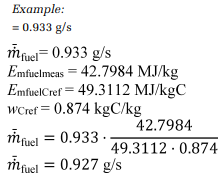
(f) Measuring NO emissions. Measure NO X emissions for each sampling period in g/s. You may perform these measurements using a NO X emission-measurement system that meets the requirements of 40 CFR part 1065, subpart J. If a system malfunction prevents you from measuring NO X emissions during a test under this section but the test otherwise gives valid results, you may consider this a valid test and omit the NO X emission measurements; however, we may require you to repeat the test if we determine that you inappropriately voided the test with respect to NO X emission measurement.
(g) Measured vs. declared fuel consumption. Determine declared fuel consumption as follows:
(1) Select fuel consumption rates in g/s to characterize the engine's fuel maps. You must select a declared value for each test point that is at or above the corresponding value determined in paragraphs (b) through (d) of this section, including those from redundant measurements.
(2) Declared fuel consumption serves as emission standards under §1036.108. These are the values that vehicle manufacturers will use for certification under 40 CFR part 1037. Note that production engines are subject to GEM cycle-weighted limits as described in §1036.301.
(3) If you perform the carbon balance error verification, select declared values that are at or above the following emission measurements:
(i) If you pass the rC verification, you may use the average of the values from direct and indirect fuel measurements.
(ii) If you fail rC verification, but pass either the aC or aCrate verification, use the value from indirect fuel measurement.
(iii) If you fail all three verifications, you must either void the test interval or use the highest value from direct and indirect fuel measurements. Note that we will consider our test results to be invalid if we fail all three verifications.
[88 FR 4487, Jan. 24, 2023; 89 FR 29750, Apr. 22, 2024]
§1036.540 Determining cycle-average engine fuel maps.
(a) Overview. This section describes how to determine an engine's cycle-average fuel maps for model year 2021 and later vehicles. Vehicle manufacturers may need cycle-average fuel maps for transient duty cycles, highway cruise cycles, or both to demonstrate compliance with emission standards under 40 CFR part 1037. Generate cycle-average engine fuel maps as follows:
(1) Determine the engine's torque maps as described in §1036.505(c).
(2) Determine the engine's steady-state fuel map and fuel consumption at idle as described in §1036.535. If you are applying cycle-average fuel mapping for highway cruise cycles, you may instead use GEM's default fuel map instead of generating the steady-state fuel map in §1036.535(b).
(3) Simulate several different vehicle configurations using GEM (see 40 CFR 1037.520) to create new engine duty cycles as described in paragraph (c) of this section. The transient vehicle duty cycles for this simulation are in 40 CFR part 1037, appendix A; the highway cruise cycles with grade are in 40 CFR part 1037, appendix D. Note that GEM simulation relies on vehicle service classes as described in 40 CFR 1037.140.
(4) Test the engines using the new duty cycles to determine fuel consumption, cycle work, and average vehicle speed as described in paragraph (d) of this section and establish GEM inputs for those parameters for further vehicle simulations as described in paragraph (e) of this section.
(b) General test provisions. The following provisions apply for testing under this section:
(1) Measure NO X emissions for each specified sampling period in grams. You may perform these measurements using a NO X emission-measurement system that meets the requirements of 40 CFR part 1065, subpart J. Include these measured NO X values any time you report to us your fuel-consumption values from testing under this section. If a system malfunction prevents you from measuring NO X emissions during a test under this section but the test otherwise gives valid results, you may consider this a valid test and omit the NO X emission measurements; however, we may require you to repeat the test if we determine that you inappropriately voided the test with respect to NO X emission measurement.
(2) The provisions related to carbon balance error verification in §1036.543 apply for all testing in this section. These procedures are optional, but we will perform carbon balance error verification for all testing under this section.
(3) Correct fuel mass to a mass-specific net energy content of a reference fuel as described in paragraph (d)(13) of this section.
(4) This section uses engine parameters and variables that are consistent with 40 CFR part 1065.
(c) Create engine duty cycles. Use GEM to simulate your engine operation with several different vehicle configurations to create transient and highway cruise engine duty cycles corresponding to each vehicle configuration as follows:
(1) Set up GEM to simulate your engine's operation based on your engine's torque maps, steady-state fuel maps, warm-idle speed as defined in 40 CFR 1037.520(h)(1), and fuel consumption at idle as described in paragraphs (a)(1) and (2) of this section.
(2) Set up GEM with transmission parameters for different vehicle service classes and vehicle duty cycles. Specify the transmission's torque limit for each gear as the engine's maximum torque as determined in 40 CFR 1065.510. Specify the transmission type as Automatic Transmission for all engines and for all engine and vehicle duty cycles, except that the transmission type is Automated Manual Transmission for Heavy HDE operating over the highway cruise cycles or the SET duty cycle. For automatic transmissions set neutral idle to “Y” in the vehicle file. Select gear ratios for each gear as shown in the following table:
| Gear No. | Spark-ignition HDE, light HDE, and medium HDE— all duty cycles | Heavy HDE— transient and ftp duty cycles | Heavy HDE— cruise and set duty cycles |
|---|---|---|---|
| 1 | 3.10 | 3.51 | 12.8 |
| 2 | 1.81 | 1.91 | 9.25 |
| 3 | 1.41 | 1.43 | 6.76 |
| 4 | 1.00 | 1.00 | 4.90 |
| 5 | 0.71 | 0.74 | 3.58 |
| 6 | 0.61 | 0.64 | 2.61 |
| 7 | — | — | 1.89 |
| 8 | — | — | 1.38 |
| 9 | — | — | 1.00 |
| 10 | — | — | 0.73 |
| Lockup Gear | 3 | 3 | — |
(3) Run GEM for each simulated vehicle configuration and use the GEM outputs of instantaneous engine speed and engine flywheel torque for each vehicle configuration to generate a 10 Hz transient duty cycle corresponding to each vehicle configuration operating over each vehicle duty cycle. Run GEM for the specified number of vehicle configurations. You may run additional vehicle configurations to represent a wider range of in-use vehicles. Run GEM as follows:
(i) Determining axle ratio and tire size. Set the axle ratio, ka, and tire size,

for each vehicle configuration based on the corresponding designated engine speed (fnrefA, fnrefB, fnrefC, fnrefD, or fntest as defined in 40 CFR 1065.610(c)(2)) at 65 mi/hr for the transient duty cycle and for the 65 mi/hr highway cruise cycle. Similarly, set these parameters based on the corresponding designated engine speed at 55 mi/hr for the 55 mi/hr highway cruise cycle. Use one of the following equations to determine

and ka at each of the defined engine speeds:
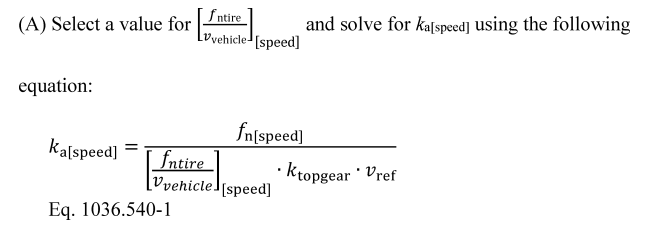
Where:
fn[speed] = engine's angular speed as determined in paragraph (c)(3)(ii) or (iii) of this section.
ktopgear = transmission gear ratio in the highest available gear from Table 1 of this section.
vref = reference speed. Use 65 mi/hr for the transient cycle and the 65 mi/hr highway cruise cycle and use 55 mi/hr for the 55 mi/hr highway cruise cycle.

Example for a vocational Light HDV or vocational Medium HDV with a 6-speed automatic transmission at B speed (Test 3 or 4 in Table 3 of this section):
fnrefB = 1870 r/min = 31.17 r/s
kaB = 4.0
ktopgear = 0.61
vref = 65 mi/hr = 29.06 m/s
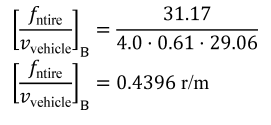
(ii) Vehicle configurations for Spark-ignition HDE, Light HDE, and Medium HDE. Test at least eight different vehicle configurations for engines that will be installed in vocational Light HDV or vocational Medium HDV using vehicles in the following table:
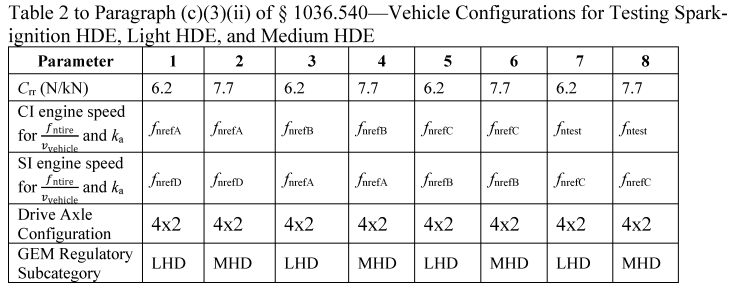
(iii) Vehicle configurations for Heavy HDE. Test at least nine different vehicle configurations for engines that will be installed in vocational Heavy HDV and for tractors that are not heavy-haul tractors. Test six different vehicle configurations for engines that will be installed in heavy-haul tractors. Use the settings specific to each vehicle configuration as shown in Table 3 or Table 4 in this section, as appropriate. Engines subject to testing under both Table 3 and Table 4 in this section need not repeat overlapping vehicle configurations, so complete fuel mapping requires testing 12 (not 15) vehicle configurations for those engines. However, the preceding sentence does not apply if you choose to create two separate maps from the vehicle configurations defined in Table 3 and Table 4 in this section. Tables 3 and 4 follow:
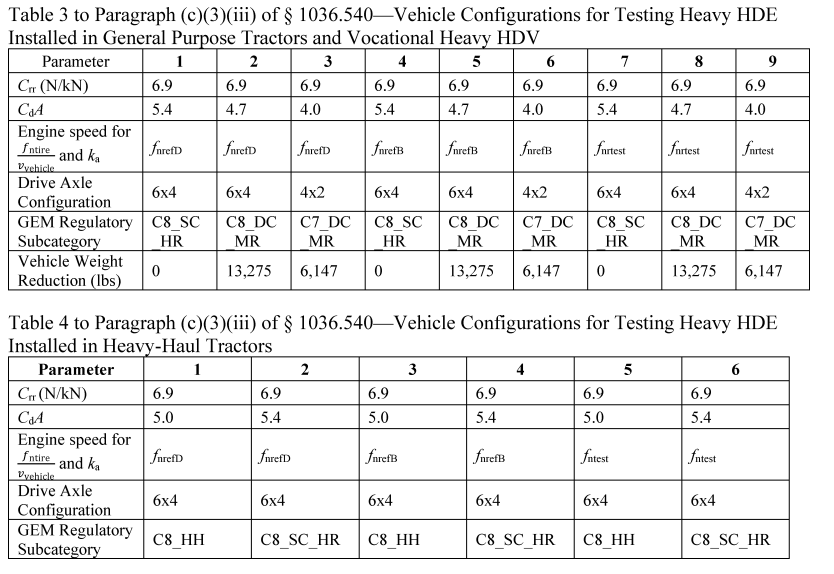
(iv) Vehicle configurations for mixed-use engines. If the engine will be installed in a combination of vehicles defined in paragraphs (c)(3)(ii) and (iii) of this section, use good engineering judgment to select at least nine vehicle configurations from Table 2 and Table 3 in this section that best represent the range of vehicles your engine will be sold in. This may require you to define additional representative vehicle configurations. For example, if your engines will be installed in vocational Medium HDV and vocational Heavy HDV, you might select Tests 2, 4, 6 and 8 of Table 2 in this section to represent vocational Medium HDV and Tests 3, 6, and 9 of Table 3 in this section to represent vocational Heavy HDV and add two more vehicle configurations that you define.
(v) Defining GEM inputs. Use the defined values in Tables 1 through 4 in this section to set up GEM with the correct regulatory subcategory and vehicle weight reduction.
(d) Test the engine with GEM cycles. Test the engine over each of the engine duty cycles generated in paragraph (c) of this section as follows:
(1) Operate the engine over a sequence of required and optional engine duty cycles as follows:
(i) Sort the list of engine duty cycles into three separate groups by vehicle duty cycle: transient vehicle cycle, 55 mi/hr highway cruise cycle, and 65 mi/hr highway cruise cycle.
(ii) Within each group of engine duty cycles derived from the same vehicle duty cycle, first run the engine duty cycle with the highest reference cycle work, followed by the cycle with the lowest cycle work; followed by the cycle with second-highest cycle work, followed by the cycle with the second-lowest cycle work; continuing through all the cycles for that vehicle duty cycle. The series of engine duty cycles to represent a single vehicle duty cycle is a single fuel-mapping sequence. Each engine duty cycle represents a different interval. Repeat the fuel-mapping sequence for the engine duty cycles derived from the other vehicle duty cycles until testing is complete.
(iii) Operate the engine over two full engine duty cycles to precondition before each interval in the fuel-mapping sequence. Precondition the engine before the first and second engine duty cycle in each fuel-mapping sequence by repeating operation with the engine duty cycle with the highest reference cycle work over the relevant vehicle duty cycle. The preconditioning for the remaining cycles in the fuel-mapping sequence consists of operation over the preceding two engine duty cycles in the fuel-mapping sequence (with or without measurement). For transient vehicle duty cycles, start each engine duty cycle within 10 seconds after finishing the preceding engine duty cycle (with or without measurement). For highway cruise cycles, start each engine duty cycle and interval after linearly ramping to the speed and torque setpoints over 5 seconds and stabilizing for 15 seconds.
(2) If the engine has an adjustable warm idle speed setpoint, set it to the value defined in 40 CFR 1037.520(h)(1).
(3) Control speed and torque to meet the cycle validation criteria in 40 CFR 1065.514 for each interval, except that the standard error of the estimate in 40 CFR 1065.514(f)(3) is the only speed criterion that applies if the range of reference speeds is less than 10 percent of the mean reference speed. For spark-ignition gaseous-fueled engines with fuel delivery at a single point in the intake manifold, you may apply the alternative cycle-validation criteria in table 5 to this paragraph (c)(3) for transient testing. Note that 40 CFR part 1065 does not allow reducing cycle precision to a lower frequency than the 10 Hz reference cycle generated by GEM.
| Parameter | Speed | Torque | Power |
|---|---|---|---|
| Slope, a1 | |||
| Absolute value of intercept, | a0 | | ≤3% of maximum mapped torque | ||
| Standard error of the estimate, SEE | ≤15% of maximum mapped torque | ≤15% of maximum mapped power. | |
| Coefficient of determination, r2 | ≥0.700 | ≥0.750. | |
| a Cycle-validation criteria apply as specified in 40 CFR 1065.514 unless otherwise specified. | |||
(4) Record measurements using direct and/or indirect measurement of fuel flow as follows:
(i) Direct fuel-flow measurement. Record speed and torque and measure fuel consumption with a fuel flow meter for the interval defined by the engine duty cycle. Determine the corresponding mean values for the interval. Use of redundant direct fuel-flow measurements requires our advance approval.
(ii) Indirect fuel-flow measurement. Record speed and torque and measure emissions and other inputs needed to run the chemical balance in 40 CFR 1065.655(c) for the interval defined by the engine duty cycle. Determine the corresponding mean values for the interval. Use of redundant indirect fuel-flow measurements requires our advance approval. Measure background concentration as described in 40 CFR 1065.140, except that you may use one of the following methods to apply a single background reading to multiple intervals:
(A) If you use batch sampling to measure background emissions, you may sample periodically into the bag over the course of multiple intervals. If you use this provision, you must apply the same background readings to correct emissions from each of the applicable intervals.
(B) You may determine background emissions by sampling from the dilution air over multiple engine duty cycles. If you use this provision, you must allow sufficient time for stabilization of the background measurement; followed by an averaging period of at least 30 seconds. Use the average of the two background readings to correct the measurement from each engine duty cycle. The first background reading must be taken no greater than 30 minutes before the start of the first applicable engine duty cycle and the second background reading must be taken no later than 30 minutes after the end of the last applicable engine duty cycle. Background readings may not span more than a full fuel-mapping sequence for a vehicle duty cycle.
(5) Warm up the engine as described in 40 CFR 1065.510(b)(2). Within 60 seconds after concluding the warm-up, start the linear ramp of speed and torque over 20 seconds to the first speed and torque setpoint of the preconditioning cycle.
(6) Precondition the engine before the start of testing as described in paragraph (d)(1)(iii) of this section.
(7) Operate the engine over the first engine duty cycle. Record measurements during the interval. Measure and report NO X emissions over each interval as described in paragraph (b)(2) of this section.
(8) Continue testing engine duty cycles that are derived from the other vehicle duty cycles until testing is complete.
(9) You may interrupt the fuel-mapping sequence after completing any interval. You may calibrate analyzers, read and evacuate background bag samples, or sample dilution air for measuring background concentration before restarting. Shut down the engine during any interruption. If you restart the sequence within 30 minutes or less, restart the sequence at paragraph (d)(6) of this section and then restart testing at the next interval in the fuel-mapping sequence. If you restart the sequence after more than 30 minutes, restart the sequence at paragraph (d)(5) of this section and then restart testing at the next interval in the fuel-mapping sequence.
(10) The following provisions apply for infrequent regeneration events, other interruptions during intervals, and otherwise voided intervals:
(i) Stop testing if an infrequent regeneration event occurs during an interval or an interval is interrupted for any other reason. Void the interrupted interval and any additional intervals for which you are not able to meet requirements for measuring background concentration. If the infrequent regeneration event occurs between intervals, void completed intervals only if you are not able to meet requirements for measuring background concentration for those intervals.
(ii) If an infrequent regeneration event occurs, allow the regeneration event to finish with the engine operating at a speed and load that allows effective regeneration.
(iii) If you interrupt testing during an interval, if you restart the sequence within 30 minutes or less, restart the sequence at paragraph (d)(6) of this section and then restart testing at the next interval in the fuel-mapping sequence. If you restart the sequence after more than 30 minutes, restart the sequence at paragraph (d)(5) of this section and then restart testing at the next interval in the fuel-mapping sequence.
(iv) If you void one or more intervals, you must perform additional testing to get results for all intervals. You may rerun a complete fuel-mapping sequence or any contiguous part of the fuel-mapping sequence. If you get a second valid measurement for any interval, use only the result from the last valid interval. If you restart the sequence within 30 minutes or less, restart the sequence at paragraph (d)(6) of this section and then restart testing at the first selected interval in the fuel-mapping sequence. If you restart the sequence after more than 30 minutes, restart the sequence at paragraph (d)(5) of this section and then restart testing at the first selected interval in the fuel-mapping sequence. Continue testing until you have valid results for all intervals. The following examples illustrate possible scenarios for a partial run through a fuel-mapping sequence:
(A) If you voided only the interval associated with the fourth engine duty cycle in the sequence, you may restart the sequence using the second and third engine duty cycles as the preconditioning cycles and stop after completing the interval associated with the fourth engine duty cycle.
(B) If you voided the intervals associated with the fourth and sixth engine duty cycles, you may restart the sequence using the second and third engine duty cycles for preconditioning and stop after completing the interval associated with the sixth engine duty cycle.
(11) You may send signals to the engine controller during the test, such as current transmission gear and vehicle speed, if that allows engine operation to better represent in-use operation.
(12) Calculate the fuel mass, mfuel, for each duty cycle using one of the following equations:
(i) Determine fuel-consumption using emission measurements from the raw or diluted exhaust. Calculate the mass of fuel for each duty cycle, mfuel[cycle], as follows:
(A) For calculations that use continuous measurement of emissions and continuous CO 2 from urea, calculate mfuel[cycle] using the following equation:

Eq. 1036.540-3
Where:
MC = molar mass of carbon.
wCmeas = carbon mass fraction of fuel (or mixture of fuels) as determined in 40 CFR 1065.655(d), except that you may not use the default properties in 40 CFR 1065.655(e)(5) to determine α, β, and wC. You may not account for the contribution to α, β, γ, and δ of diesel exhaust fluid or other non-fuel fluids injected into the exhaust.
i = an indexing variable that represents one recorded emission value.
N = total number of measurements over the duty cycle.
n = exhaust molar flow rate from which you measured emissions according to 40 CFR 1065.655.
xCcombdry = amount of carbon from fuel and any injected fluids in the exhaust per mole of dry exhaust as determined in 40 CFR 1065.655(c).
xH2Oexhdry = amount of H 2 O in exhaust per mole of exhaust as determined in 40 CFR 1065.655(c).
Δ t = 1/ frecord
MCO2 = molar mass of carbon dioxide.
mCO2DEF = mass emission rate of CO 2 resulting from diesel exhaust fluid decomposition over the duty cycle as determined from §1036.535(b)(9). If your engine does not utilize diesel exhaust fluid for emission control, or if you choose not to perform this correction, set mCO2DEF equal to 0.
Example:
MC = 12.0107 g/mol
wCmeas = 0.867
N = 6680
n1 = 2.876 mol/s
n2 = 2.224 mol/s
xCcombdryi 1 = 2.61·10 −3 mol/mol
xCcombdryi 2 = 1.91·10 −3 mol/mol
xH2Oexh1 = 3.53·10 −2 mol/mol
xH2Oexh2 = 3.13·10 −2 mol/mol
frecord = 10 Hz
Δ t = 1/10 = 0.1 s
MCO2 = 44.0095 g/mol
mCO2DEF1 = 0.0726 g/s
mCO2DEF2 = 0.0751 g/s
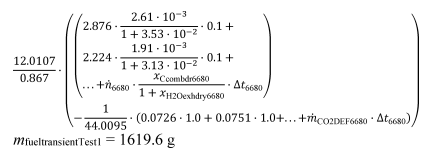
(B) If you measure batch emissions and continuous CO 2 from urea, calculate mfuel[cycle] using the following equation:

(C) If you measure continuous emissions and batch CO 2 from urea, calculate mfuel[cycle] using the following equation:

(D) If you measure batch emissions and batch CO 2 from urea, calculate mfuel[cycle] using the following equation:

(ii) Manufacturers may choose to measure fuel mass flow rate. Calculate the mass of fuel for each duty cycle, mfuel[cycle], as follows:
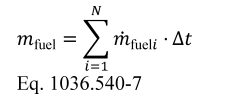
Where:
i = an indexing variable that represents one recorded value.
N = total number of measurements over the duty cycle. For batch fuel mass measurements, set N = 1.
m fuel = the fuel mass flow rate, for each point, i, starting from i = 1.
Δ t = 1/ ƒrecord
ƒrecord = the data recording frequency.
Example:
N = 6680
m fuel1 = 1.856 g/s
m fuel2 = 1.962 g/s
ƒrecord = 10 Hz
Δ t = 1/10 = 0.1 s
mfueltransient = (1.856 + 1.962+ . . . + m fuel6680) · 0.1
mfueltransient = 111.95 g
(13) Correct the measured or calculated fuel mass, mfuel, for each result to a mass-specific net energy content of a reference fuel as described in §1036.535(e), replacing mfuel with mfuel in Eq. 1036.535-4.
(e) Determine GEM inputs. Use the results of engine testing in paragraph (d) of this section to determine the GEM inputs for the transient duty cycle and optionally for each of the highway cruise cycles corresponding to each simulated vehicle configuration as follows:
(1) Using the calculated fuel mass consumption values, mfuel[cycle], described in paragraph (d) of this section, declare values using the methods described in §1036.535(g)(2) and (3).
(2) We will determine mfuel[cycle] values using the method described in §1036.535(g)(3).
(3) For the transient cycle, calculate engine output speed per unit vehicle speed,

by taking the average engine speed measured during the engine test while the vehicle is moving and dividing it by the average vehicle speed provided by GEM. Note that the engine cycle created by GEM has a flag to indicate when the vehicle is moving.
(4) Determine engine idle speed and torque, by taking the average engine speed and torque measured during the engine test while the vehicle is not moving. Note that the engine cycle created by GEM has a flag to indicate when the vehicle is moving.
(5) For the cruise cycles, calculate the average engine output speed, f nengine, and the average engine output torque (positive torque only), T engine, while the vehicle is moving. Note that the engine cycle created by GEM has a flag to indicate when the vehicle is moving.
(6) Determine positive work according to 40 CFR part 1065, W[cycle], by using the engine speed and engine torque measured during the engine test while the vehicle is moving. Note that the engine cycle created by GEM has a flag to indicate when the vehicle is moving.
(7) The following tables illustrate the GEM data inputs corresponding to the different vehicle configurations for a given duty cycle:
(i) For the transient cycle:
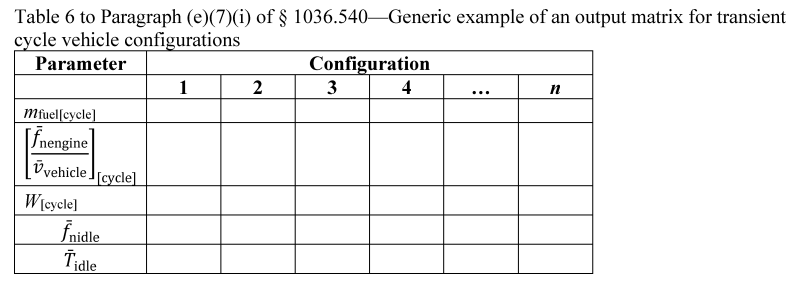
(ii) For the cruise cycles:
| Parameter | Configuration | |||||
| 1 | 2 | 3 | 4 | . . . | n | |
| mfuel[cycle] | ||||||
| f nengine[cycle] | ||||||
| T engine[cycle] | ||||||
| W[cycle] | ||||||
[88 FR 4487, Jan. 24, 2023; 89 FR 29751, Apr. 22, 2024]
§1036.543 Carbon balance error verification.
The optional carbon balance error verification in 40 CFR 1065.543 compares independent assessments of the flow of carbon through the system (engine plus aftertreatment). This procedure applies for each individual interval in §§1036.535(b), (c), and (d), 1036.540, and 1036.545.
[88 FR 4487, Jan. 24, 2023; 89 FR 29752, Apr. 22, 2024]
§1036.545 Powertrain testing.
This section describes the procedure to measure fuel consumption and create engine fuel maps by testing a powertrain that includes an engine coupled with a transmission, drive axle, and hybrid components or any assembly with one or more of those hardware elements. Engine fuel maps are part of demonstrating compliance with Phase 2 and Phase 3 vehicle standards under 40 CFR part 1037; the powertrain test procedure in this section is one option for generating this fuel-mapping information as described in §1036.505. Additionally, this powertrain test procedure is one option for certifying hybrid powertrains to the engine standards in §§1036.104 and 1036.108.
(a) General test provisions. The following provisions apply broadly for testing under this section:
(1) Measure NO X emissions as described in paragraph (k) of this section. Include these measured NO X values any time you report to us your greenhouse gas emissions or fuel consumption values from testing under this section.
(2) The procedures of 40 CFR part 1065 apply for testing in this section except as specified. This section uses engine parameters and variables that are consistent with 40 CFR part 1065.
(3) Powertrain testing depends on models to calculate certain parameters. You can use the detailed equations in this section to create your own models, or use the GEM HIL model contained within GEM Phase 2, Version 4.0 (incorporated by reference, see §1036.810) to simulate vehicle hardware elements as follows:
(i) Create driveline and vehicle models that calculate the angular speed setpoint for the test cell dynamometer, f nref,dyno, based on the torque measurement location. Use the detailed equations in paragraph (f) of this section, the GEM HIL model's driveline and vehicle submodels, or a combination of the equations and the submodels. You may use the GEM HIL model's transmission submodel in paragraph (f) to simulate a transmission only if testing hybrid engines. If the engine is intended for vehicles with automatic transmissions, use the cycle configuration file in GEM to change the transmission state (in-gear or idle) as a function of time as defined by the duty cycles in this part.
(ii) Create a driver model or use the GEM HIL model's driver submodel to simulate a human driver modulating the throttle and brake pedals to follow the test cycle as closely as possible.
(iii) Create a cycle-interpolation model or use the GEM HIL model's cycle submodel to interpolate the duty-cycles and feed the driver model the duty-cycle reference vehicle speed for each point in the duty-cycle.
(4) The powertrain test procedure in this section is designed to simulate operation of different vehicle configurations over specific duty cycles. See paragraphs (h) and (j) of this section.
(5) For each test run, record engine speed and torque as defined in 40 CFR 1065.915(d)(5) with a minimum sampling frequency of 1 Hz. These engine speed and torque values represent a duty cycle that can be used for separate testing with an engine mounted on an engine dynamometer under 40 CFR 1037.551, such as for a selective enforcement audit as described in 40 CFR 1037.301.
(6) For hybrid powertrains with no plug-in capability, correct for the net energy change of the energy storage device as described in 40 CFR 1066.501(a)(3). For plug-in hybrid electric powertrains, follow 40 CFR 1066.501(a)(3) to determine End-of-Test for charge-depleting operation. You must get our approval in advance for your utility factor curve; we will approve it if you can show that you created it, using good engineering judgment, from sufficient in-use data of vehicles in the same application as the vehicles in which the plug-in hybrid electric powertrain will be installed. You may use methodologies described in SAE J2841 to develop the utility factor curve.
(7) The provisions related to carbon balance error verification in §1036.543 apply for all testing in this section. These procedures are optional if you are only performing direct or indirect fuel-flow measurement, but we will perform carbon balance error verification for all testing under this section.
(8) Do not apply accessory loads when conducting a powertrain test to generate inputs to GEM if torque is measured at the axle input shaft or wheel hubs.
(9) If you test a powertrain over the Low Load Cycle specified in §1036.514, control and apply the electrical accessory loads. We recommend using a load bank connected directly to the powertrain's electrical system. You may instead use an alternator with dynamic electrical load control. Use good engineering judgment to account for the efficiency of the alternator or the efficiency of the powertrain to convert the mechanical energy to electrical energy.
(10) The following instruments are required with plug-in hybrid systems to determine required voltages and currents during testing and must be installed on the powertrain to measure these values during testing:
(i) Measure the voltage and current of the battery pack directly with a DC wideband power analyzer to determine power. Measure all current entering and leaving the battery pack. Do not measure voltage upstream of this measurement point. The maximum integration period for determining amp-hours is 0.05 seconds. The power analyzer must have an accuracy for measuring current and voltage of 1% of point or 0.3% of maximum, whichever is greater. The power analyzer must not be susceptible to offset errors while measuring current.
(ii) If safety considerations do not allow for measuring voltage, you may determine the voltage directly from the powertrain ECM.
(11) The following figure provides an overview of testing under this section:
Figure 1 to Paragraph (a)(11) of §1036.545—Overview of Powertrain Testing.

(b) Test configuration. Select a powertrain for testing as described in §1036.235 or 40 CFR 1037.235 as applicable. Set up the engine according to 40 CFR 1065.110 and 1065.405(b). Set the engine's idle speed to idle speed defined in 40 CFR 1037.520(h)(1).
(1) The default test configuration consists of a powertrain with all components upstream of the axle. This involves connecting the powertrain's output shaft directly to the dynamometer or to a gear box with a fixed gear ratio and measuring torque at the axle input shaft. You may instead set up the dynamometer to connect at the wheel hubs and measure torque at that location. The preceding sentence may apply if your powertrain configuration requires it, such as for hybrid powertrains or if you want to represent the axle performance with powertrain test results. You may alternatively test the powertrain with a chassis dynamometer if you measure speed and torque at the powertrain's output shaft or wheel hubs.
(2) For testing hybrid engines, connect the engine's crankshaft directly to the dynamometer and measure torque at that location.
(c) Powertrain temperatures during testing. Cool the powertrain during testing so temperatures for oil, coolant, block, head, transmission, battery, and power electronics are within the manufacturer's expected ranges for normal operation. You may use electronic control module outputs to comply with this paragraph (c). You may use auxiliary coolers and fans.
(d) Engine break in. Break in the engine according to 40 CFR 1065.405(c), the axle assembly according to 40 CFR 1037.560, and the transmission according to 40 CFR 1037.565. You may instead break in the powertrain as a complete system using the engine break in procedure in 40 CFR 1065.405(c).
(e) Dynamometer setup. Set the dynamometer to operate in speed-control mode (or torque-control mode for hybrid engine testing at idle, including idle portions of transient duty cycles). Record data as described in 40 CFR 1065.202. Command and control the dynamometer speed at a minimum of 5 Hz, or 10 Hz for testing hybrid engines. Run the vehicle model to calculate the dynamometer setpoints at a rate of at least 100 Hz. If the dynamometer's command frequency is less than the vehicle model dynamometer setpoint frequency, subsample the calculated setpoints for commanding the dynamometer setpoints.
(f) Driveline and vehicle model. Use the GEM HIL model's driveline and vehicle submodels or the equations in this paragraph (f) to calculate the dynamometer speed setpoint, f nref,dyno, based on the torque measurement location. For all powertrains, configure GEM with the accessory load set to zero. For hybrid engines, configure GEM with the applicable accessory load as specified in §§1036.505, 1036.514, and 1036.525. For all powertrains and hybrid engines, configure GEM with the tire slip model disabled.
(1) Driveline model with a transmission in hardware. For testing with torque measurement at the axle input shaft or wheel hubs, calculate, f nref,dyno, using the GEM HIL model's driveline submodel or the following equation:

Eq. 1036.545-1
Where:
k a[speed] = drive axle ratio as determined in paragraph (h) of this section. Set k a[speed] equal to 1.0 if torque is measured at the wheel hubs.
v refi = simulated vehicle reference speed as calculated in paragraph (f)(3) of this section.
r [speed] = tire radius as determined in paragraph (h) of this section.
(2) Driveline model with a simulated transmission. For testing with the torque measurement at the engine's crankshaft, f nref,dyno is the dynamometer target speed from the GEM HIL model's transmission submodel. You may request our approval to change the transmission submodel, as long as the changes do not affect the gear selection logic. Before testing, initialize the transmission model with the engine's measured torque curve and the applicable steady-state fuel map from the GEM HIL model. You may request our approval to input your own steady-state fuel map. For example, this request for approval could include using a fuel map that represents the combined performance of the engine and hybrid components. Configure the torque converter to simulate neutral idle when using this procedure to generate engine fuel maps in §1036.505 or to perform the Supplemental Emission Test (SET) testing under §1036.510. You may change engine commanded torque at idle to better represent CITT for transient testing under §1036.512. You may change the simulated engine inertia to match the inertia of the engine under test. We will evaluate your requests under this paragraph (f)(2) based on your demonstration that the adjusted testing better represents in-use operation.
(i) The transmission submodel needs the following model inputs:
(A) Torque measured at the engine's crankshaft.
(B) Engine estimated torque determined from the electronic control module or by converting the instantaneous operator demand to an instantaneous torque in N·m.
(C) Dynamometer mode when idling (speed-control or torque-control).
(D) Measured engine speed when idling.
(E) Transmission output angular speed, f ni,transmission, calculated as follows:

Eq. 1036.545-2
Where:
k a[speed] = drive axle ratio as determined in paragraph (h) of this section.
v refi = simulated vehicle reference speed as calculated in paragraph (f)(3) of this section.
r [speed] = tire radius as determined in paragraph (h) of this section.
(ii) The transmission submodel generates the following model outputs:
(A) Dynamometer target speed.
(B) Dynamometer idle load.
(C) Transmission engine load limit.
(D) Engine speed target.
(3) Vehicle model. Calculate the simulated vehicle reference speed, ν refi, using the GEM HIL model's vehicle submodel or the equations in this paragraph (f)(3):

Eq. 1036.545-3
Where:
i = a time-based counter corresponding to each measurement during the sampling period.
Let v ref1 = 0; start calculations at i = 2. A 10-minute sampling period will generally involve 60,000 measurements.
T = instantaneous measured torque at the axle input, measured at the wheel hubs, or simulated by the GEM HIL model's transmission submodel. For configurations with multiple torque measurements, such as when measuring torque at the wheel hubs, T is the sum of all torque measurements.
Eff axle = axle efficiency. Use Eff axle = 0.955 for T ≥ 0, and use Eff axle = 1/0.955 for T < 0.
Use Eff axle = 1.0 if torque is measured at the wheel hubs.
M = vehicle mass for a vehicle class as determined in paragraph (h) of this section.
g = gravitational constant = 9.80665 m/s 2 .
C rr = coefficient of rolling resistance for a vehicle class as determined in paragraph (h) of this section.
G -1 = the percent grade interpolated at distance, D -1, from the duty cycle in 40 CFR part 1037, appendix D, corresponding to measurement (i -1).

Eq. 1036.545-4
ρ = air density at reference conditions. Use ρ = 1.1845 kg/m 3 .
C = drag area for a vehicle class as determined in paragraph (h) of this section.
F brake, -1 = instantaneous braking force applied by the driver model.
F grade , -1 = M · g · sin(atan(G -1 ))
Eq. 1036.545-5
Δt = the time interval between measurements. For example, at 100 Hz, Δt = 0.0100 seconds.
M rotating = inertial mass of rotating components. Let M rotating = 340 kg for vocational Light HDV or vocational Medium HDV. See paragraph (h) of this section for tractors and for vocational Heavy HDV.
(4) Example. The following example illustrates a calculation of f nref,dyno using paragraph (f)(1) of this section where torque is measured at the axle input shaft. This example is for a vocational Light HDV or vocational Medium HDV with 6 speed automatic transmission at B speed (test 4 in table 1 to paragraph (h)(2)(ii) of this section).
k aB = 4.0
r B = 0.399 m
T 999 = 500.0 N·m
C rr = 7.7 N/kN = 7.7·10 −3 N/N
M = 11408 kg
C dA = 5.4 m 2
G 999 = 0.39% = 0.0039

F brake,999 = 0 N
v ref,999 = 20.0 m/s
F grade,999 = 11408 · 9.81 · sin(atan(0.0039)) = 436.5 N
Δ t = 0.0100 s
M rotating = 340 kg
v ref1000 =

(g) Driver model. Use the GEM HIL model's driver submodel or design a driver model to simulate a human driver modulating the throttle and brake pedals. In either case, tune the model to follow the test cycle as closely as possible meeting the following specifications:
(1) The driver model must meet the following speed requirements:
(i) For operation over the highway cruise cycles, the speed requirements described in 40 CFR 1066.425(b) and (c).
(ii) For operation over the Heavy-Duty Transient Test Cycle specified in 40 CFR part 1037, appendix A, the SET as defined §1036.510, the Federal Test Procedure (FTP) as defined in §1036.512, and the Low Load Cycle (LLC) as defined in §1036.514, the speed requirements described in 40 CFR 1066.425(b) and (c).
(iii) The exceptions in 40 CFR 1066.425(b)(4) apply to the highway cruise cycles, the Heavy-Duty Transient Test Cycle specified in 40 CFR part 1037, appendix A, SET, FTP, and LLC.
(iv) If the speeds do not conform to these criteria, the test is not valid and must be repeated.
(2) Send a brake signal when operator demand is zero and vehicle speed is greater than the reference vehicle speed from the test cycle. Include a delay before changing the brake signal to prevent dithering, consistent with good engineering judgment.
(3) Allow braking only if operator demand is zero.
(4) Compensate for the distance driven over the duty cycle over the course of the test. Use the following equation to perform the compensation in real time to determine your time in the cycle:

Eq. 1036.545-6
Where:
vehicle = measured vehicle speed.
cycle = reference speed from the test cycle. If cycle, i -1 < 1.0 m/s, set cycle, i -1 = vehicle, i -1.
(h) Vehicle configurations to evaluate for generating fuel maps as defined in §1036.505. Configure the driveline and vehicle models from paragraph (f) of this section in the test cell to test the powertrain. Simulate multiple vehicle configurations that represent the range of intended vehicle applications using one of the following options:
(1) For known vehicle configurations, use at least three equally spaced axle ratios or tire sizes and three different road loads (nine configurations), or at least four equally spaced axle ratios or tire sizes and two different road loads (eight configurations). Select axle ratios to represent the full range of expected vehicle installations. Select axle ratios and tire sizes such that the ratio of engine speed to vehicle speed covers the range of ratios of minimum and maximum engine speed to vehicle speed when the transmission is in top gear for the vehicles in which the powertrain will be installed. Note that you do not have to use the same axle ratios and tire sizes for each GEM regulatory subcategory. You may determine appropriate C rr, C d A, and mass values to cover the range of intended vehicle applications or you may use the C rr, C d A, and mass values specified in paragraph (h)(2) of this section.
(2) If vehicle configurations are not known, determine the vehicle model inputs for a set of vehicle configurations as described in §1036.540(c)(3) with the following exceptions:
(i) In the equations of §1036.540(c)(3)(i), k topgear is the actual top gear ratio of the powertrain instead of the transmission gear ratio in the highest available gear given in table 1 to paragraph (c)(2) of §1036.540.
(ii) Test at least eight different vehicle configurations for powertrains that will be installed in Spark-ignition HDE, vocational Light HDV, and vocational Medium HDV using the following table instead of table 2 to paragraph (c)(3)(ii) of §1036.540:
TABLE 1 TO PARAGRAPH (h)(2)(ii) OF § 1036.545—VEHICLE CONFIGURATIONS FOR TESTING SPARK-IGNITION HDE, AND MEDIUM HDE
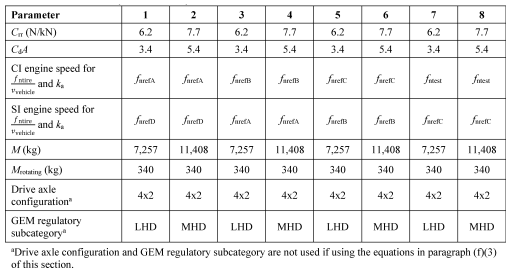
(iii) Select and test vehicle configurations as described in §1036.540(c)(3)(iii) for powertrains that will be installed in vocational Heavy HDV and tractors using the following tables instead of tables 3 and 4 to paragraph (c)(3)(iii) of §1036.540:
TABLE 2 TO PARAGRAPH (h)(2)(iii) OF § 1036.545—VEHICLE CONFIGURATIONS FOR TESTING GENERAL PURPOSE TRACTORS AND VOCATIONAL HEAVY HDV
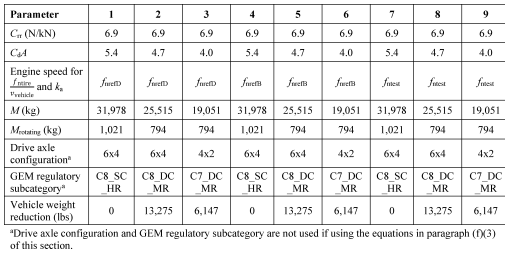
TABLE 3 TO PARAGRAPH (h)(2)(iii) of § 1036.545—VEHICLE CONFIGURATIONS FOR TESTING HEAVY HDE INSTALLED IN HEAVY-HAUL TRACTORS
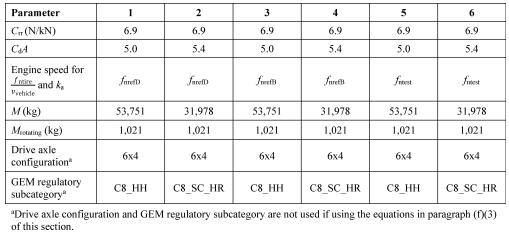
(3) For hybrid powertrain systems where the transmission will be simulated, use the transmission parameters defined in §1036.540(c)(2) to determine transmission type and gear ratio. Use a fixed transmission efficiency of 0.95. The GEM HIL transmission model uses a transmission parameter file for each test that includes the transmission type, gear ratios, lockup gear, torque limit per gear from §1036.540(c)(2) and the values from §1036.505(b)(4) and (c).
(i) [Reserved]
(j) Duty cycles to evaluate. Operate the powertrain over each of the duty cycles specified in 40 CFR 1037.510(a)(2), and for each applicable vehicle configuration from paragraph (h) of this section. Determine cycle-average powertrain fuel maps by testing the powertrain using the procedures in §1036.540(d) with the following exceptions:
(1) Understand “engine” to mean “powertrain”.
(2) Warm up the powertrain as described in §1036.520(d).
(3) Within 90 seconds after concluding the warm-up, start the transition to the preconditioning cycle as described in paragraph (j)(5) of this section.
(4) For plug-in hybrid engines, precondition the battery and then complete all back-to-back tests for each vehicle configuration according to 40 CFR 1066.501(a)(3) before moving to the next vehicle configuration. The following figure illustrates a charge-depleting test sequence with engine operation during two duty cycles, which are used for criteria pollutant determination:
Figure 2 to Paragraph (j)(4) of §1036.545—Generic Charge-Depleting Test Sequence

(5) If the preceding duty cycle does not end at 0 mi/hr, transition between duty cycles by decelerating at a rate of 2 mi/hr/s at 0% grade until the vehicle reaches zero speed. Shut off the powertrain. Prepare the powertrain and test cell for the next duty-cycle.
(6) Start the next duty-cycle within 60 to 180 seconds after shutting off the powertrain.
(i) To start the next duty-cycle, for hybrid powertrains, key on the vehicle and then start the duty-cycle. For conventional powertrains key on the vehicle, start the engine, wait for the engine to stabilize at idle speed, and then start the duty-cycle.
(ii) If the duty-cycle does not start at 0 mi/hr, transition to the next duty cycle by accelerating at a target rate of 1 mi/hr/s at 0% grade. Stabilize for 10 seconds at the initial duty cycle conditions and start the duty-cycle.
(7) Calculate cycle work using GEM or the speed and torque from the driveline and vehicle models from paragraph (f) of this section to determine the sequence of duty cycles.
(8) Calculate the mass of fuel consumed for idle duty cycles as described in paragraph (n) of this section.
(k) Measuring NOX emissions. Measure NO X emissions for each sampling period in grams. You may perform these measurements using a NO X emission-measurement system that meets the requirements of 40 CFR part 1065, subpart J. If a system malfunction prevents you from measuring NO X emissions during a test under this section but the test otherwise gives valid results, you may consider this a valid test and omit the NO X emission measurements; however, we may require you to repeat the test if we determine that you inappropriately voided the test with respect to NO X emission measurement.
(l) [Reserved]
(m) Measured output speed validation. For each test point, validate the measured output speed with the corresponding reference values. If speed is measured at more than one location, the measurements at each location must meet validation requirements. If the range of reference speed is less than 10 percent of the mean reference speed, you need to meet only the standard error of the estimate in table 4 to this paragraph (m). You may delete points when the vehicle is stopped. If your speed measurement is not at the location of ƒ nref, correct your measured speed using the constant speed ratio between the two locations. Apply cycle-validation criteria for each separate transient or highway cruise cycle based on the following parameters:
| Parameter a | Speed control |
|---|---|
| Slope, a 1 | 0.990 ≤ a 1 ≤ 1.010. |
| Absolute value of intercept, | a 0 | | ≤2.0% of maximum ƒ nref speed. |
| Standard error of the estimate, SEE | ≤2.0% of maximum ƒ nref speed. |
| Coefficient of determination, r 2 | ≥0.990. |
| a Determine values for specified parameters as described in 40 CFR 1065.514(e) by comparing measured and reference values for ƒ nref,dyno. | |
(n) Fuel consumption at idle. Record measurements using direct and/or indirect measurement of fuel flow. Determine the fuel-consumption rates at idle for the applicable duty cycles described in 40 CFR 1037.510(a)(2) as follows:
(1) Direct fuel flow measurement. Determine the corresponding mean values for mean idle fuel mass flow rate, m fuelidle, for each duty cycle, as applicable. Use of redundant direct fuel-flow measurements require our advance approval.
(2) Indirect fuel flow measurement. Record speed and torque and measure emissions and other inputs needed to run the chemical balance in 40 CFR 1065.655(c). Determine the corresponding mean values for each duty cycle. Use of redundant indirect fuel-flow measurements require our advance approval. Measure background concentration as described in §1036.535(b)(4)(ii). We recommend setting the CVS flow rate as low as possible to minimize background, but without introducing errors related to insufficient mixing or other operational considerations. Note that for this testing 40 CFR 1065.140(e) does not apply, including the minimum dilution ratio of 2:1 in the primary dilution stage. Calculate the idle fuel mass flow rate for each duty cycle, m fuelidle, for each set of vehicle settings, as follows:

Eq. 1036.545-7
Where:
M C = molar mass of carbon.
w Cmeas = carbon mass fraction of fuel (or mixture of test fuels) as determined in 40 CFR 1065.655(d), except that you may not use the default properties in 40 CFR 1065.655(e)(5) to determine α, β, and w C for liquid fuels.
n exh = the mean raw exhaust molar flow rate from which you measured emissions according to 40 CFR 1065.655.
χ Ccombdry = the mean concentration of carbon from fuel and any injected fluids in the exhaust per mole of dry exhaust.
χ H2Oexhdry = the mean concentration of H 2 O in exhaust per mole of dry exhaust.
m CO2DEF = the mean CO 2 mass emission rate resulting from diesel exhaust fluid decomposition over the duty cycle as determined in §1036.535(b)(9). If your engine does not use diesel exhaust fluid, or if you choose not to perform this correction, set equal to 0.
M CO2 = molar mass of carbon dioxide.
Example:
M C = 12.0107 g/mol
w Cmeas = 0.867
n exh = 25.534 mol/s
χ Ccombdry = 2.805·10 −3 mol/mol
χ H2Oexhdry = 3.53·10 −2 mol/mol
m CO2DEF = 0.0726 g/s
M CO2 = 44.0095

(o) Create GEM inputs. Use the results of powertrain testing to determine GEM inputs for the different simulated vehicle configurations as follows:
(1) Correct the measured or calculated fuel masses, m fuel[cycle], and mean idle fuel mass flow rates, m fuelidle, if applicable, for each test result to a mass-specific net energy content of a reference fuel as described in §1036.535(e), replacing m fuel with m fuel[cycle] where applicable in Eq. 1036.535-4.
(2) Declare fuel masses, m fuel[cycle] and m fuelidle . Determine m fuel[cycle] using the calculated fuel mass consumption values described in §1036.540(d)(12). In addition, declare mean fuel mass flow rate for each applicable idle duty cycle, m fuelidle . These declared values may not be lower than any corresponding measured values determined in this section. If you use both direct and indirect measurement of fuel flow, determine the corresponding declared values as described in §1036.535(g)(2) and (3). These declared values, which serve as emission standards, collectively represent the powertrain fuel map for certification.
(3) For engines designed for plug-in hybrid electric vehicles, the mass of fuel for each cycle, m fuel[cycle], is the utility factor-weighted fuel mass, m fuelUF[cycle]. This is determined by calculating m fuel for the full charge-depleting and charge-sustaining portions of the test and weighting the results, using the following equation:

Eq. 1036.545-8
Where:
i = an indexing variable that represents one test interval.
N = total number of charge-depleting test intervals.
m fuel[cycle]CD = total mass of fuel in the charge-depleting portion of the test for each test interval, i , starting from i = 1, including the test interval(s) from the transition phase.
UF DCD = utility factor fraction at distance D CD from Eq. 1036.510-11 as determined by interpolating the approved utility factor curve for each test interval, i, starting from i = 1. Let UF DCD0 = 0
j = an indexing variable that represents one test interval.
M = total number of charge-sustaining test intervals.
m fuel[cycle]CS = total mass of fuel over the charge-sustaining portion of the test for each test interval, j , starting from j = 1.
UF RCD = utility factor fraction at the full charge-depleting distance, R CD, as determined by interpolating the approved utility factor curve. R CD is the cumulative distance driven over N charge-depleting test intervals.

Eq. 1036.545-9
Where:
k = an indexing variable that represents one recorded velocity value.
Q = total number of measurements over the test interval.
v = vehicle velocity at each time step, k , starting from k = 1. For tests completed under this section, v is the vehicle velocity as determined by Eq. 1036.545-1. Note that this should include charge- depleting test intervals that start when the engine is not yet operating.
Δ t = 1/ƒ record
ƒ record = the record rate.
Example for the 55 mi/hr cruise cycle:
Q = 8790
1 = 55.0 mi/hr
2 = 55.0 mi/hr
3 = 55.1 mi/hr
ƒ record = 10 Hz
Δ t = 1/10 Hz = 0.1 s

(4) For the transient cycle specified in 40 CFR 1037.510(a)(2)(i), calculate powertrain output speed per unit of vehicle speed using one of the following methods:
(i) For testing with torque measurement at the axle input shaft:

Eq. 1036.545-10
Example:
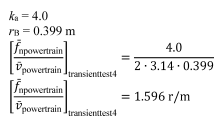
(ii) For testing with torque measurement at the wheel hubs, use Eq. 1036.545-8 setting k a equal to 1.
(iii) For testing with torque measurement at the engine's crankshaft:

Eq. 1036.545-11
Where:
f nengine = average engine speed when vehicle speed is at or above 0.100 m/s.
v ref = average simulated vehicle speed at or above 0.100 m/s.
Example:

(5) Calculate engine idle speed, by taking the average engine speed measured during the transient cycle test while the vehicle speed is below 0.100 m/s. (Note: Use all the charge-sustaining test intervals when determining engine idle speed for plug-in hybrid powertrains.)ƒ
(6) For the cruise cycles specified in 40 CFR 1037.510(a)(2)(ii), calculate the average powertrain output speed, ƒ npowertrain, and the average powertrain output torque (positive torque only), T powertrain, at vehicle speed at or above 0.100 m/s. (Note: Use all the charge-sustaining and charge-depleting test intervals when determining ƒ npowertrain and T powertrain for plug-in hybrid powertrains.)
(7) Calculate positive work, W [cycle], as the work over the duty cycle at the axle input shaft, wheel hubs, or the engine's crankshaft, as applicable, when vehicle speed is at or above 0.100 m/s. For plug-in hybrid powertrains, calculate W [cycle] by calculating the positive work over each of the charge-sustaining and charge-depleting test intervals and then averaging them together. If speed and torque are measured at more than one location, determine W [cycle] by integrating the sum of the power calculated from measured speed and torque measurements at each location.
(8) The following tables illustrate the GEM data inputs corresponding to the different vehicle configurations for a given duty cycle:
(i) For the transient cycle:
Table 5 to Paragraph (o)(8)(i) of §1036.545—Example of Output Matrix for Transient Cycle Vehicle Configurations

(ii) For the cruise cycles:
Table 6 to Paragraph ((o)(8)(ii) of §1036.545—Generic Example of Output Matrix for Cruise Cycle Vehicle Configurations

(p) Determine usable battery energy. Determine usable battery energy (UBE) for plug-in hybrid powertrains using one of the following procedures:
(1) Select a representative vehicle configuration from paragraph (h) of this section. Measure DC discharge energy, E DCD, in DC watt-hours and measure DC discharge current per hour, C D, for the charge-depleting test intervals of the Heavy-Duty Transient Test Cycle in 40 CFR part 1037, appendix A. The measurement period must include all the current flowing into and out of the battery pack during the charge-depleting test intervals, including current associated with regenerative braking. Eq. 1036.545-12 shows how to calculate E DCD, but the power analyzer specified in paragraph (a)(10)(i) of this section will typically perform this calculation internally. Battery voltage measurements made by the powertrain's on-board sensors (such as those available with a diagnostic port) may be used for calculating E DCD if they are equivalent to those from the power analyzer.

Eq. 1036.545-12
Where:
i = an indexing variable that represents one individual measurement.
N = total number of measurements.
V = battery DC bus voltage.
I = battery current.
Δ t = 1/ƒ record
ƒ record = the data recording frequency.
Example:
N = 13360
V 1 = 454.0
V 2 = 454. 0
I 1 = 0
I 2 = 0
ƒ record = 20 Hz
Δ t = 1/20 = 0.05 s

(2) Determine a declared UBE that is at or below the corresponding value determined in paragraph (p)(1) of this section, including those from redundant measurements. This declared UBE serves as UBE certified determined under 40 CFR 1037.115(f).
[89 FR 29752, Apr. 22, 2024]
§1036.550 Calculating greenhouse gas emission rates.
This section describes how to calculate official emission results for CO 2, CH 4, and N 2 O.
(a) Calculate brake-specific emission rates for each applicable duty cycle as specified in 40 CFR 1065.650. Apply infrequent regeneration adjustment factors as described in §1036.580.
(b) Adjust CO 2 emission rates calculated under paragraph (a) of this section for measured test fuel properties as specified in this paragraph (b). This adjustment is intended to make official emission results independent of differences in test fuels within a fuel type. Use good engineering judgment to develop and apply testing protocols to minimize the impact of variations in test fuels.
(1) Determine your test fuel's mass-specific net energy content, E mfuelmeas, also known as lower heating value, in MJ/kg, expressed to at least three decimal places. Determine E mfuelmeas as follows:
(i) For liquid fuels, determine E mfuelmeas according to ASTM D4809 (incorporated by reference, see §1036.810). Have the sample analyzed by at least three different labs and determine the final value of your test fuel's E mfuelmeas as the median of all the lab test results as described in 40 CFR 1065.602(m). If you have results from three different labs, we recommend you screen them to determine if additional observations are needed. To perform this screening, determine the absolute value of the difference between each lab result and the average of the other two lab results. If the largest of these three resulting absolute value differences is greater than 0.297 MJ/kg, we recommend you obtain additional results prior to determining the final value of E mfuelmeas.
(ii) For gaseous fuels, determine E mfuelmeas according to ASTM D3588 (incorporated by reference, see §1036.810).
(2) Determine your test fuel's carbon mass fraction, w C, as described in 40 CFR 1065.655(d), expressed to at least three decimal places; however, you must measure fuel properties for α and β rather than using the default values specified in 40 CFR 1065.655(e).
(i) For liquid fuels, have the sample analyzed by at least three different labs, determine w C for each result as described in 40 CFR 1065.655(d), and determine the final value of your test fuel's w C as the median (as described in 40 CFR 1065.602(m)) of all the w C values. If you have results from three different labs, we recommend you screen them to determine if additional observations are needed. To perform this screening, determine the absolute value of the difference between each w C value and the average of the other two w C values. If the largest of these three resulting absolute value differences is greater than 1.56 percent carbon, we recommend you obtain additional results prior to determining the final value of w C.
(ii) For gaseous fuels, have the sample analyzed by a single lab and use that result as your test fuel's w C.
(3) If, over a period of time, you receive multiple fuel deliveries from a single stock batch of test fuel, you may use constant values for mass-specific energy content and carbon mass fraction, consistent with good engineering judgment. To use these constant values, you must demonstrate that every subsequent delivery comes from the same stock batch and that the fuel has not been contaminated.
(4) Correct measured CO 2 emission rates as follows:

Where:
e CO2 = the calculated CO 2 emission result.
E mfuelmeas = the mass-specific net energy content of the test fuel as determined in paragraph (b)(1) of this section. Note that dividing this value by w Cmeas (as is done in this equation) equates to a carbon-specific net energy content having the same units as E mfuelCref.
E mfuelCref = the reference value of carbon-mass-specific net energy content for the appropriate fuel type, as determined in Table 1 in this section.
w Cmeas = 0.870 kgC/kg
Example:
e CO2 = 630.0 g/hp·hr
E mfuelmeas = 42.528 MJ/kg
E mfuelCref = 49.3112 MJ/kgC
w Cmeas = 0.870

e CO2cor = 624.5 g/hp·hr
| Fuel type a | Reference fuel carbon-mass-specific net energy content, E mfuelCref (MJ/kgC) b | Reference fuel carbon mass fraction, w Cref b |
|---|---|---|
| Diesel fuel | 49.3112 | 0.874 |
| Gasoline | 50.4742 | 0.846 |
| Natural gas | 66.2910 | 0.750 |
| LPG | 56.5218 | 0.820 |
| Dimethyl ether | 55.3886 | 0.521 |
| High-level ethanol-gasoline blends | 50.3211 | 0.576 |
| a For fuels that are not listed, you must ask us to approve reference fuel properties. | ||
| b For multi-fuel streams, such as natural gas with diesel fuel pilot injection, use good engineering judgment to determine blended values for E mfuelCref and w Cref using the values in this table. | ||
(c) Your official emission result for each pollutant equals your calculated brake-specific emission rate multiplied by all applicable adjustment factors, other than the deterioration factor.
[88 FR 4487, Jan. 24, 2023; 89 FR 29763, Apr. 22, 2024]
§1036.555 Test procedures to verify deterioration factors.
Sections 1036.240 through 1036.246 describe certification procedures to determine, verify, and apply deterioration factors. This section describes the measurement procedures for verifying deterioration factors using PEMS with in-use vehicles.
(a) Use PEMS to collect 1 Hz data throughout a shift-day of driving. Collect all the data elements needed to determine brake-specific emissions. Calculate emission results using moving average windows as described in §1036.530.
(b) Collect data as needed to perform the calculations specified in paragraph (a) of this section and to submit the test report specified in §1036.246(d).
[88 FR 4487, Jan. 24, 2023]
§1036.580 Infrequently regenerating aftertreatment devices.
For engines using aftertreatment technology with infrequent regeneration events that may occur during testing, take one of the following approaches to account for the emission impact of regeneration on criteria pollutant and greenhouse gas emissions:
(a) You may use the calculation methodology described in 40 CFR 1065.680 to adjust measured emission results. Do this by developing an upward adjustment factor and a downward adjustment factor for each pollutant based on measured emission data and observed regeneration frequency as follows:
(1) Adjustment factors should generally apply to an entire engine family, but you may develop separate adjustment factors for different configurations within an engine family. Use the adjustment factors from this section for all testing for the engine family.
(2) You may use carryover data to establish adjustment factors for an engine family as described in §1036.235(d), consistent with good engineering judgment.
(3) Identify the value of F[cycle] in each application for the certification for which it applies.
(4) Calculate separate adjustment factors for each required duty cycle.
(b) You may ask us to approve an alternate methodology to account for regeneration events. We will generally limit approval to cases where your engines use aftertreatment technology with extremely infrequent regeneration and you are unable to apply the provisions of this section.
(c) You may choose to make no adjustments to measured emission results if you determine that regeneration does not significantly affect emission levels for an engine family (or configuration) or if it is not practical to identify when regeneration occurs. You may omit adjustment factors under this paragraph (c) for N 2 O, CH 4, or other individual pollutants under this paragraph (c) as appropriate. If you choose not to make adjustments under paragraph (a) or (b) of this section, your engines must meet emission standards for all testing, without regard to regeneration.
(d) If your engine family includes engines with one or more emergency AECDs approved under §1036.115(h)(4), do not consider additional regenerations resulting from those AECDs when developing adjustments to measured values under paragraph (a) or (b) of this section.
[88 FR 4487, Jan. 24, 2023; 89 FR 29763, Apr. 22, 2024]
Subpart G—Special Compliance Provisions
§1036.601 Overview of compliance provisions.
(a) Engine and vehicle manufacturers, as well as owners, operators, and rebuilders of engines subject to the requirements of this part, and all other persons, must observe the provisions of this part, the provisions of 40 CFR part 1068, and the provisions of the Clean Air Act. The provisions of 40 CFR part 1068 apply for heavy-duty highway engines as specified in that part, subject to the following provisions:
(1) The exemption provisions of 40 CFR 1068.201 through 1068.230, 1068.240, and 1068.260 through 265 apply for heavy-duty motor vehicle engines. The other exemption provisions, which are specific to nonroad engines, do not apply for heavy-duty vehicles or heavy-duty engines.
(2) Engine signals to indicate a need for maintenance under §1036.125(a)(1)(ii) are considered an element of design of the emission control system. Disabling, resetting, or otherwise rendering such signals inoperative without also performing the indicated maintenance procedure is therefore prohibited under 40 CFR 1068.101(b)(1).
(3) The warranty-related prohibitions in section 203(a)(4) of the Act (42 U.S.C. 7522(a)(4)) apply to manufacturers of new heavy-duty highway engines in addition to the prohibitions described in 40 CFR 1068.101(b)(6). We may assess a civil penalty up to $44,539 for each engine or vehicle in violation.
(b) The following provisions from 40 CFR parts 85 and 86 continue to apply after December 20, 2026 for engines subject to the requirements of this part:
(1) The tampering prohibition in 40 CFR 1068.101(b)(1) applies for alternative fuel conversions as specified in 40 CFR part 85, subpart F.
(2) Engine manufacturers must meet service information requirements as specified in 40 CFR 86.010-38(j).
(3) Provisions related to nonconformance penalties apply as described in 40 CFR part 86, subpart L. Note that nonconformance penalty provisions are not available for current or future emission standards unless we revise the regulation to specify how to apply those provisions.
(4) The manufacturer-run in-use testing program described in 40 CFR part 86, subpart T, continues to apply for engines subject to exhaust emission standards under 40 CFR part 86.
(c) The emergency vehicle field modification provisions of 40 CFR 85.1716 apply with respect to the standards of this part. Emergency vehicle field modifications under 40 CFR 85.1716 may include corresponding changes to diagnostic systems relative to the requirements in §§1036.110 and 1036.111. For example, the cab display required under §1036.110(c)(1) identifying a fault condition may omit information about the timing or extent of a pending derate if an AECD will override the derate.
(d) Subpart C of this part describes how to test and certify dual-fuel and flexible-fuel engines. Some multi-fuel engines may not fit either of those defined terms. For such engines, we will determine whether it is most appropriate to treat them as single-fuel engines, dual-fuel engines, or flexible-fuel engines based on the range of possible and expected fuel mixtures. For example, an engine might burn natural gas but initiate combustion with a pilot injection of diesel fuel. If the engine is designed to operate with a single fueling algorithm (i.e., fueling rates are fixed at a given engine speed and load condition), we would generally treat it as a single-fuel engine. In this context, the combination of diesel fuel and natural gas would be its own fuel type. If the engine is designed to also operate on diesel fuel alone, we would generally treat it as a dual-fuel engine. If the engine is designed to operate on varying mixtures of the two fuels, we would generally treat it as a flexible-fuel engine. To the extent that requirements vary for the different fuels or fuel mixtures, we may apply the more stringent requirements.
[88 FR 4487, Jan. 24, 2023; 89 FR 29763, Apr. 22, 2024 ]
§1036.605 Alternate emission standards for engines used in specialty vehicles.
Starting in model year 2027, compression-ignition engines at or above 56 kW and spark-ignition engines of any size that will be installed in specialty vehicles as allowed by 40 CFR 1037.605 are exempt from the standards of subpart B of this part if they are certified under this part to alternate emission standards as follows:
(a) Spark-ignition engines must be of a configuration that is identical to one that is certified under 40 CFR part 1048 to Blue Sky standards under 40 CFR 1048.140.
(b) Compression-ignition engines must be of a configuration that is identical to one that is certified under 40 CFR part 1039, and meet the following additional standards using the same duty cycles that apply under 40 CFR part 1039:
(1) The engines must be certified with a family emission limit for PM of 0.020 g/kW-hr.
(2) Diesel-fueled engines using selective catalytic reduction must meet an emission standard of 0.1 g/kW-hr for N 2 O.
(c) Except as specified in this section, engines certified under this section must meet all the requirements that apply under 40 CFR part 1039 or 1048 instead of the comparable provisions in this part. Before shipping engines under this section, you must have written assurance from vehicle manufacturers that they need a certain number of exempted engines under this section. In your annual production report under 40 CFR 1039.250 or 1048.250, count these engines separately and identify the vehicle manufacturers that will be installing them. Treat these engines as part of the corresponding engine family under 40 CFR part 1039 or part 1048 for compliance purposes such as testing production engines, in-use testing, defect reporting, and recall.
(d) The engines must be labeled as described in §1036.135, with the following statement instead of the one specified in §1036.135(c)(8): “This engine conforms to alternate standards for specialty vehicles under 40 CFR 1036.605.” Engines certified under this section may not have the label specified for nonroad engines in 40 CFR part 1039 or 1048 or any other label identifying them as nonroad engines.
(e) In a separate application for a certificate of conformity, identify the corresponding nonroad engine family, describe the label required under section, state that you meet applicable diagnostic requirements under 40 CFR part 1039 or 1048, and identify your projected U.S.-directed production volume.
(f) No additional certification fee applies for engines certified under this section.
(g) Engines certified under this section may not generate or use emission credits under this part or under 40 CFR part 1039. The vehicles in which these engines are installed may generate or use emission credits as described in 40 CFR part 1037.
[88 FR 4487, Jan. 24, 2023; 89 FR 29763, Apr. 22, 2024]
§1036.610 Off-cycle technology credits and adjustments for reducing greenhouse gas emissions.
(a) You may ask us to apply the provisions of this section for CO 2 emission reductions resulting from powertrain technologies that were not in common use with heavy-duty vehicles before model year 2010 that are not reflected in the specified procedure. While you are not required to prove that such technologies were not in common use with heavy-duty vehicles before model year 2010, we will not approve your request if we determine that they do not qualify. We will apply these provisions only for technologies that will result in a measurable, demonstrable, and verifiable real-world CO 2 reduction. Note that prior to model year 2016, these technologies were referred to as “innovative technologies”.
(b) The provisions of this section may be applied as either an improvement factor (used to adjust emission results) or as a separate credit, consistent with good engineering judgment. Note that the term “credit” in this section describes an additive adjustment to emission rates and is not equivalent to an emission credit in the ABT program of subpart H of this part. We recommend that you base your credit/adjustment on A to B testing of pairs of engines/vehicles differing only with respect to the technology in question.
(1) Calculate improvement factors as the ratio of in-use emissions with the technology divided by the in-use emissions without the technology. Adjust the emission results by multiplying by the improvement factor. Use the improvement-factor approach where good engineering judgment indicates that the actual benefit will be proportional to emissions measured over the procedures specified in this part. For example, the benefits from technologies that reduce engine operation would generally be proportional to the engine's emission rate.
(2) Calculate separate credits based on the difference between the in-use emission rate (g/ton-mile) with the technology and the in-use emission rate without the technology. Subtract this value from your measured emission result and use this adjusted value to determine your FEL. We may also allow you to calculate the credits based on g/hp·hr emission rates. Use the separate-credit approach where good engineering judgment indicates that the actual benefit will not be proportional to emissions measured over the procedures specified in this part.
(3) We may require you to discount or otherwise adjust your improvement factor or credit to account for uncertainty or other relevant factors.
(c) Send your request to the Designated Compliance Officer. We recommend that you do not begin collecting data (for submission to EPA) before contacting us. For technologies for which the vehicle manufacturer could also claim credits (such as transmissions in certain circumstances), we may require you to include a letter from the vehicle manufacturer stating that it will not seek credits for the same technology. Your request must contain the following items:
(1) A detailed description of the off-cycle technology and how it functions to reduce CO 2 emissions under conditions not represented on the duty cycles required for certification.
(2) A list of the engine configurations that will be equipped with the technology.
(3) A detailed description and justification of the selected engines.
(4) All testing and simulation data required under this section, plus any other data you have considered in your analysis. You may ask for our preliminary approval of your plan under §1036.210.
(5) A complete description of the methodology used to estimate the off-cycle benefit of the technology and all supporting data, including engine testing and in-use activity data. Also include a statement regarding your recommendation for applying the provisions of this section for the given technology as an improvement factor or a credit.
(6) An estimate of the off-cycle benefit by engine model, and the fleetwide benefit based on projected sales of engine models equipped with the technology.
(7) A demonstration of the in-use durability of the off-cycle technology, based on any available engineering analysis or durability testing data (either by testing components or whole engines).
(d) We may seek public comment on your request, consistent with the provisions of 40 CFR 86.1869-12(d). However, we will generally not seek public comment on credits/adjustments based on A to B engine dynamometer testing, chassis testing, or in-use testing.
(e) We may approve an improvement factor or credit for any configuration that is properly represented by your testing.
(1) For model years before 2021, you may continue to use an approved improvement factor or credit for any appropriate engine families in future model years through 2020.
(2) For model years 2021 and later, you may not rely on an approval for model years before 2021. You must separately request our approval before applying an improvement factor or credit under this section for 2021 and later engines, even if we approved an improvement factor or credit for similar engine models before model year 2021. Note that approvals for model year 2021 and later may carry over for multiple years.
[88 FR 4487, Jan. 24, 2023]
§1036.615 Engines with Rankine cycle waste heat recovery and hybrid powertrains.
This section specifies how to generate advanced-technology emission credits for hybrid powertrains that include energy storage systems and regenerative braking (including regenerative engine braking) and for engines that include Rankine-cycle (or other bottoming cycle) exhaust energy recovery systems. This section applies only for model year 2020 and earlier engines.
(a) Pre-transmission hybrid powertrains. Test pre-transmission hybrid powertrains with the hybrid engine procedures of 40 CFR part 1065 or with the post-transmission procedures in §1036.545. Pre-transmission hybrid powertrains are those engine systems that include features to recover and store energy during engine motoring operation but not from the vehicle's wheels. Engines certified with pre-transmission hybrid powertrains must be certified to meet the diagnostic requirements as specified in §1036.110 with respect to powertrain components and systems; if different manufacturers produce the engine and the hybrid powertrain, the hybrid powertrain manufacturer may separately certify its powertrain relative to diagnostic requirements.
(b) Rankine engines. Test engines that include Rankine-cycle exhaust energy recovery systems according to the procedures specified in subpart F of this part unless we approve alternate procedures.
(c) Calculating credits. Calculate credits as specified in subpart H of this part. Credits generated from engines and powertrains certified under this section may be used in other averaging sets as described in §1036.740(c).
(d) Off-cycle technologies. You may certify using both the provisions of this section and the off-cycle technology provisions of §1036.610, provided you do not double-count emission benefits.
[88 FR 4487, Jan. 24, 2023; 89 FR 29763, Apr. 22, 2024]
§1036.620 Alternate CO2 standards based on model year 2011 compression-ignition engines.
For model years 2014 through 2016, you may certify your compression-ignition engines to the CO 2 standards of this section instead of the CO 2 standards in §1036.108. However, you may not certify engines to these alternate standards if they are part of an averaging set in which you carry a balance of banked credits. You may submit applications for certifications before using up banked credits in the averaging set, but such certificates will not become effective until you have used up (or retired) your banked credits in the averaging set. For purposes of this section, you are deemed to carry credits in an averaging set if you carry credits from advanced technology that are allowed to be used in that averaging set.
(a) The standards of this section are determined from the measured emission rate of the engine of the applicable baseline 2011 engine family or families as described in paragraphs (b) and (c) of this section. Calculate the CO 2 emission rate of the baseline engine using the same equations used for showing compliance with the otherwise applicable standard. The alternate CO 2 standard for light and medium heavy-duty vocational-certified engines (certified for CO 2 using the transient cycle) is equal to the baseline emission rate multiplied by 0.975. The alternate CO 2 standard for tractor-certified engines (certified for CO 2 using the SET duty cycle) and all other Heavy HDE is equal to the baseline emission rate multiplied by 0.970. The in-use FEL for these engines is equal to the alternate standard multiplied by 1.03.
(b) This paragraph (b) applies if you do not certify all your engine families in the averaging set to the alternate standards of this section. Identify separate baseline engine families for each engine family that you are certifying to the alternate standards of this section. For an engine family to be considered the baseline engine family, it must meet the following criteria:
(1) It must have been certified to all applicable emission standards in model year 2011. If the baseline engine was certified to a NO X FEL above the standard and incorporated the same emission control technologies as the new engine family, you may adjust the baseline CO 2 emission rate to be equivalent to an engine meeting the 0.20 g/hp·hr NO X standard (or your higher FEL as specified in this paragraph (b)(1)), using certification results from model years 2009 through 2011, consistent with good engineering judgment.
(i) Use the following equation to relate model year 2009-2011 NO X and CO 2 emission rates (g/hp·hr): CO 2 = a × log(NO X )+ b.
(ii) For model year 2014-2016 engines certified to NO X FELs above 0.20 g/hp·hr, correct the baseline CO 2 emissions to the actual NO X FELs of the 2014-2016 engines.
(iii) Calculate separate adjustments for emissions over the SET duty cycle and the transient cycle.
(2) The baseline configuration tested for certification must have the same engine displacement as the engines in the engine family being certified to the alternate standards, and its rated power must be within five percent of the highest rated power in the engine family being certified to the alternate standards.
(3) The model year 2011 U.S.-directed production volume of the configuration tested must be at least one percent of the total 2011 U.S.-directed production volume for the engine family.
(4) The tested configuration must have cycle-weighted BSFC equivalent to or better than all other configurations in the engine family.
(c) This paragraph (c) applies if you certify all your engine families in the primary intended service class to the alternate standards of this section. For purposes of this section, you may combine Light HDE and Medium HDE into a single averaging set. Determine your baseline CO 2 emission rate as the production-weighted emission rate of the certified engine families you produced in the 2011 model year. If you produce engines for both tractors and vocational vehicles, treat them as separate averaging sets. Adjust the CO 2 emission rates to be equivalent to an engine meeting the average NO X FEL of new engines (assuming engines certified to the 0.20 g/hp·hr NO X standard have a NO X FEL equal to 0.20 g/hp·hr), as described in paragraph (b)(1) of this section.
(d) Include the following statement on the emission control information label: “THIS ENGINE WAS CERTIFIED TO AN ALTERNATE CO 2 STANDARD UNDER 40 CFR 1036.620.”
(e) You may not bank CO 2 emission credits for any engine family in the same averaging set and model year in which you certify engines to the standards of this section. You may not bank any advanced-technology credits in any averaging set for the model year you certify under this section (since such credits would be available for use in this averaging set). Note that the provisions of §1036.745 apply for deficits generated with respect to the standards of this section.
(f) You need our approval before you may certify engines under this section, especially with respect to the numerical value of the alternate standards. We will not approve your request if we determine that you manipulated your engine families or engine configurations to certify to less stringent standards, or that you otherwise have not acted in good faith. You must keep and provide to us any information we need to determine that your engine families meet the requirements of this section. Keep these records for at least five years after you stop producing engines certified under this section.
[88 FR 4487, Jan. 24, 2023]
§1036.625 In-use compliance with CO2 family emission limits (FELs).
Section 1036.225 describes how to change the FEL for an engine family during the model year. This section, which describes how you may ask us to increase an engine family's CO 2 FEL after the end of the model year, is intended to address circumstances in which it is in the public interest to apply a higher in-use CO 2 FEL based on forfeiting an appropriate number of emission credits. For example, this may be appropriate where we determine that recalling vehicles would not significantly reduce in-use emissions. We will generally not allow this option where we determine the credits being forfeited would likely have expired.
(a) You may ask us to increase an engine family's FEL after the end of the model year if you believe some of your in-use engines exceed the CO 2 FEL that applied during the model year (or the CO 2 emission standard if the family did not generate or use emission credits). We may consider any available information in making our decision to approve or deny your request.
(b) If we approve your request under this section, you must apply emission credits to cover the increased FEL for all affected engines. Apply the emission credits as part of your credit demonstration for the current production year. Include the appropriate calculations in your final report under §1036.730.
(c) Submit your request to the Designated Compliance Officer. Include the following in your request:
(1) Identify the names of each engine family that is the subject of your request. Include separate family names for different model years
(2) Describe why your request does not apply for similar engine models or additional model years, as applicable.
(3) Identify the FEL(s) that applied during the model year and recommend a replacement FEL for in-use engines; include a supporting rationale to describe how you determined the recommended replacement FEL.
(4) Describe whether the needed emission credits will come from averaging, banking, or trading.
(d) If we approve your request, we will identify the replacement FEL. The value we select will reflect our best judgment to accurately reflect the actual in-use performance of your engines, consistent with the testing provisions specified in this part. We may apply the higher FELs to other engine families from the same or different model years to the extent they used equivalent emission controls. We may include any appropriate conditions with our approval.
(e) If we order a recall for an engine family under 40 CFR 1068.505, we will no longer approve a replacement FEL under this section for any of your engines from that engine family, or from any other engine family that relies on equivalent emission controls.
[88 FR 4487, Jan. 24, 2023]
§1036.630 Certification of engine greenhouse gas emissions for powertrain testing.
For engines included in powertrain families under 40 CFR part 1037, you may choose to include the corresponding engine emissions in your engine families under this part instead of (or in addition to) the otherwise applicable engine fuel maps.
(a) If you choose to certify powertrain fuel maps in an engine family, the declared powertrain emission levels become standards that apply for selective enforcement audits and in-use testing. We may require that you provide to us the engine cycle (not normalized) corresponding to a given powertrain for each of the specified duty cycles.
(b) If you choose to certify only fuel map emissions for an engine family and to not certify emissions over powertrain cycles under §1036.545, we will not presume you are responsible for emissions over the powertrain cycles. However, where we determine that you are responsible in whole or in part for the emission exceedance in such cases, we may require that you participate in any recall of the affected vehicles (Note: this does not apply if you also hold the certificate of conformity for the vehicle).
(c) If you split an engine family into subfamilies based on different fuel-mapping procedures as described in §1036.230(f)(2), the fuel-mapping procedures you identify for certifying each subfamily also apply for selective enforcement audits and in-use testing.
[88 FR 4487, Jan. 24, 2023; 89 FR 29763, Apr. 22, 2024]
§1036.635 Certification requirements for high-GCWR medium-duty vehicles.
Engines that will be installed in Vehicles at or below 14,000 pounds GVWR that have GCWR above 22,000 pounds may be optionally certified under this part instead of vehicle certification under 40 CFR part 86, subpart S.
(a) Affected engines must meet the criteria pollutant standards specified in §1036.104. The following specific provisions apply if engines are exempt from greenhouse gas standards under paragraph (b) or (c) of this section:
(1) Determine brake-specific CO 2 emissions over the FTP, eCO2FTPFCL, from the emission-data engine used for demonstrating compliance with criteria pollutant standards. You may alternatively determine eCO2FTPFCL based on chassis testing as described in 40 CFR 86.1845-04(h)(6). Use eCO2FTPFCL for calculating emission rates from in-use engines under §1036.530. Report the measured CO 2 emission rate and the method of testing in your application for certification.
(2) For plug-in hybrid electric vehicles, meet battery monitor requirements under 40 CFR 1037.115(f) instead of the battery-related requirements under 40 CFR 86.1815-27.
(b) Affected engines that will be installed in complete vehicles are exempt from the greenhouse gas emission standards in §1036.108, but engine certification under this part 1036 depends on the following conditions:
(1) The vehicles in which the engines are installed must meet the following vehicle-based standards under 40 CFR part 86, subpart S:
(i) Evaporative and refueling emission standards as specified in 40 CFR 86.1813-17.
(ii) Greenhouse gas emission standards as specified in 40 CFR 86.1819-14.
(2) Additional provisions related to relevant requirements from 40 CFR part 86, subpart S, apply for certifying engines under this part, as illustrated in the following examples:
(i) The engine's emission control information label must state that the vehicle meets evaporative and refueling emission standards under 40 CFR 86.1813-17 and greenhouse gas emission standards under 40 CFR 86.1819-14.
(ii) The application for certification must include the information related to complying with evaporative, refueling, and greenhouse gas emission standards.
(iii) We may require you to perform testing on in-use vehicles and report test results as specified in 40 CFR 86.1845-04, 86.1846-01, and 86.1847-01.
(iv) Demonstrate compliance with the fleet average CO 2 standard as described in 40 CFR 86.1865-12 by including vehicles certified under this section in the compliance calculations as part of the fleet averaging calculation for medium-duty vehicles certified under 40 CFR part 86, subpart S.
(3) State in the application for certification that you are using the provisions of this section to meet the fleet average CO 2 standard in 40 CFR 86.1819-14 instead of meeting the standards of §1036.108 and instead of certifying the vehicle to standards under 40 CFR part 1037.
(c) The provisions in paragraph (b) of this section are optional for affected engines that will be installed in incomplete vehicles. If vehicles do not meet all the requirements described in paragraph (b) of this section, the engines must meet the greenhouse gas emission standards of §1036.108 and the vehicles must be certified under 40 CFR part 1037.
[89 FR 28211, Apr. 18, 2024]
§1036.655 Special provisions for diesel-fueled engines sold in American Samoa or the Commonwealth of the Northern Mariana Islands.
(a) The prohibitions in §1068.101(a)(1) do not apply to diesel-fueled engines that are intended for use and will be used in American Samoa or the Commonwealth of the Northern Mariana Islands, subject to the following conditions:
(1) The engine meets the emission standards that applied to model year 2006 engines as specified in appendix A of this part.
(2) You meet all the requirements of 40 CFR 1068.265.
(b) If you introduce an engine into U.S. commerce under this section, you must meet the labeling requirements in §1036.135, but add the following statement instead of the compliance statement in §1036.135(c)(8):
THIS ENGINE (or VEHICLE, as applicable) CONFORMS TO US EPA EMISSION STANDARDS APPLICABLE TO MODEL YEAR 2006. THIS ENGINE (or VEHICLE, as applicable) DOES NOT CONFORM TO US EPA EMISSION REQUIREMENTS IN EFFECT AT TIME OF PRODUCTION AND MAY NOT BE IMPORTED INTO THE UNITED STATES OR ANY TERRITORY OF THE UNITED STATES EXCEPT AMERICAN SAMOA OR THE COMMONWEALTH OF THE NORTHERN MARIANA ISLANDS.
(c) Introducing into U.S. commerce an engine exempted under this section in any state or territory of the United States other than American Samoa or the Commonwealth of the Northern Mariana Islands, throughout its lifetime, violates the prohibitions in 40 CFR 1068.101(a)(1), unless it is exempt under a different provision.
(d) The exemption provisions in this section also applied for model year 2007 and later engines introduced into commerce in Guam before January 1, 2024.
[88 FR 4487, Jan. 24, 2023]
Subpart H—Averaging, Banking, and Trading for Certification
§1036.701 General provisions.
(a) You may average, bank, and trade (ABT) emission credits for purposes of certification as described in this subpart and in subpart B of this part to show compliance with the standards of §§1036.104 and 1036.108. Participation in this program is voluntary. Note that certification to NO X standards in §1036.104 is based on a family emission limit (FEL) and certification to CO 2 standards in §1036.108 is based on a Family Certification Level (FCL). This part refers to “FEL/FCL” to simultaneously refer to FELs for NO X and FCLs for CO 2. Note also that subpart B of this part requires you to assign an FCL to all engine families, whether or not they participate in the ABT provisions of this subpart.
(b) The definitions of subpart I of this part apply to this subpart in addition to the following definitions:
(1) Actual emission credits means emission credits you have generated that we have verified by reviewing your final report.
(2) Averaging set means a set of engines in which emission credits may be exchanged. See §1036.740.
(3) Broker means any entity that facilitates a trade of emission credits between a buyer and seller.
(4) Buyer means the entity that receives emission credits as a result of a trade.
(5) Reserved emission credits means emission credits you have generated that we have not yet verified by reviewing your final report.
(6) Seller means the entity that provides emission credits during a trade.
(7) Standard means the emission standard that applies under subpart B of this part for engines not participating in the ABT program of this subpart.
(8) Trade means to exchange emission credits, either as a buyer or seller.
(c) Emission credits may be exchanged only within an averaging set, except as specified in §1036.740.
(d) You may not use emission credits generated under this subpart to offset any emissions that exceed an FEL/FCL or standard. This paragraph (d) applies for all testing, including certification testing, in-use testing, selective enforcement audits, and other production-line testing. However, if emissions from an engine exceed an FEL/FCL or standard (for example, during a selective enforcement audit), you may use emission credits to recertify the engine family with a higher FEL/FCL that applies only to future production.
(e) You may use either of the following approaches to retire or forego emission credits:
(1) You may retire emission credits generated from any number of your engines. This may be considered donating emission credits to the environment. Identify any such credits in the reports described in §1036.730. Engines must comply with the applicable FELs even if you donate or sell the corresponding emission credits. Donated credits may no longer be used by anyone to demonstrate compliance with any EPA emission standards.
(2) You may certify an engine family using an FEL/FCL below the emission standard as described in this part and choose not to generate emission credits for that family. If you do this, you do not need to calculate emission credits for those engine families, and you do not need to submit or keep the associated records described in this subpart for that family.
(f) Emission credits may be used in the model year they are generated. Surplus emission credits may be banked for future model years. Surplus emission credits may sometimes be used for past model years, as described in §1036.745.
(g) You may increase or decrease an FEL/FCL during the model year by amending your application for certification under §1036.225. The new FEL/FCL may apply only to engines you have not already introduced into commerce.
(h) See §1036.740 for special credit provisions that apply for greenhouse gas credits generated under 40 CFR 86.1819-14(k)(7) or §1036.615 or 40 CFR 1037.615.
(i) Unless the regulations in this part explicitly allow it, you may not calculate Phase 1 credits more than once for any emission reduction. For example, if you generate Phase 1 CO 2 emission credits for a hybrid engine under this part for a given vehicle, no one may generate CO 2 emission credits for that same hybrid engine and the associated vehicle under 40 CFR part 1037. However, Phase 1 credits could be generated for identical vehicles using engines that did not generate credits under this part.
(j) Credits you generate with compression-ignition engines in 2020 and earlier model years may be used in model year 2021 and later as follows:
(1) For credit-generating engines certified to the tractor engine standards in §1036.108, you may use credits calculated relative to the tractor engine standards.
(2) For credit-generating engines certified to the vocational engine standards in §1036.108, you may optionally carry over adjusted vocational credits from an averaging set, and you may use credits calculated relative to the emission levels in the following table:
| Medium HDE | Heavy HDE |
|---|---|
| 558 g/hp·hr | 525 g/hp·hr. |
(k) Engine families you certify with a nonconformance penalty under 40 CFR part 86, subpart L, may not generate emission credits.
[88 FR 4487, Jan. 24, 2023]
§1036.705 Generating and calculating emission credits.
(a) The provisions of this section apply separately for calculating emission credits for each pollutant.
(b) For each participating family, calculate positive or negative emission credits relative to the otherwise applicable emission standard. Calculate positive emission credits for a family that has an FEL/FCL below the standard. Calculate negative emission credits for a family that has an FEL/FCL above the standard. Sum your positive and negative credits for the model year before rounding.
(1) Calculate emission credits to the nearest megagram (Mg) for each family or subfamily using the following equation:

Where:
Std = the emission standard, in (mg NO X )/hp·hr or (g CO 2 )/hp·hr, that applies under subpart B of this part for engines not participating in the ABT program of this subpart (the “otherwise applicable standard”).
FL = the engine family's FEL for NO X, in mg/hp·hr, and FCL for CO 2, in g/hp·hr, rounded to the same number of decimal places as the emission standard.
CF = a transient cycle conversion factor (hp·hr/mile), calculated by dividing the total (integrated) horsepower-hour over the applicable duty cycle by 6.3 miles for engines subject to spark-ignition standards and 6.5 miles for engines subject to compression-ignition standards. This represents the average work performed over the duty cycle. See paragraph (b)(3) of this section for provisions that apply for CO 2.
Volume = the number of engines eligible to participate in the averaging, banking, and trading program within the given engine family or subfamily during the model year, as described in paragraph (c) of this section.
UL = the useful life for the standard that applies for a given primary intended service class, in miles.
c = use 10 −6 for CO 2 and 10 −9 for NO X .
Example for Model Year 2025 Heavy HDE Generating CO 2 Credits for a Model Year 2028 Heavy HDE:
Std = 432 g/hp·hr
FL = 401 g/hp·hr
CF = 9.78 hp·hr/mile
Volume = 15,342
UL = 435,000 miles
c = 10 −6
Emission credits = (432 − 401) · 9.78 · 15,342 · 435,000 · 10 −6
Emission credits = 28,131,142 Mg
(2) [Reserved]
(3) The following additional provisions apply for calculating CO 2 credits:
(i) For engine families certified to both the vocational and tractor engine standards, calculate credits separately for the vocational engines and the tractor engines. We may allow you to use statistical methods to estimate the total production volumes where a small fraction of the engines cannot be tracked precisely.
(ii) Calculate the transient cycle conversion factor for vocational engines based on the average of vocational engine configurations weighted by their production volumes. Similarly, calculate the transient cycle conversion factor for tractor engines based on the average of tractor engine configurations weighted by their production volumes. Note that calculating the transient cycle conversion factor for tractors requires you to use the conversion factor even for engines certified to standards based on the SET duty cycle.
(iii) The FCL for CO 2 is based on measurement over the FTP duty cycle for vocational engines and over the SET duty cycle for tractor engines.
(4) You may not generate emission credits for tractor engines (i.e., engines not certified to the transient cycle for CO 2) installed in vocational vehicles (including vocational tractors certified under 40 CFR 1037.630 or exempted under 40 CFR 1037.631). We will waive this provision where you demonstrate that less than five percent of the engines in your tractor family were installed in vocational vehicles. For example, if you know that 96 percent of your tractor engines were installed in non-vocational tractors but cannot determine the vehicle type for the remaining four percent, you may generate credits for all the engines in the family.
(5) You may generate CO 2 emission credits from a model year 2021 or later medium heavy-duty engine family subject to spark-ignition standards for exchanging with other engine families only if the engines in the family are gasoline-fueled. You may generate CO 2 credits from non-gasoline engine families only for the purpose of offsetting CH 4 and/or N 2 O emissions within the same engine family as described in paragraph (d) of this section.
(c) Compliance with the requirements of this subpart is determined at the end of the model year by calculating emission credits based on actual production volumes, excluding the following engines:
(1) Engines that you do not certify to the CO 2 standards of this part because they are permanently exempted under subpart G of this part or under 40 CFR part 1068.
(2) Exported engines.
(3) Engines not subject to the requirements of this part, such as those excluded under §1036.5. For example, do not include engines used in vehicles certified to the greenhouse gas standards of 40 CFR 86.1819.
(4) Engines certified to state emission standards that are different than the emission standards referenced in this section, and intended for sale in a state that has adopted those emission standards.
(5) Any other engines if we indicate elsewhere in this part that they are not to be included in the calculations of this subpart.
(d) You may use CO 2 emission credits to show compliance with CH 4 and/or N 2 O FELs instead of the otherwise applicable emission standards. To do this, calculate the CH 4 and/or N 2 O emission credits needed (negative credits) using the equation in paragraph (b) of this section, using the FEL(s) you specify for your engines during certification instead of the FCL. You must use 34 Mg of positive CO 2 credits to offset 1 Mg of negative CH 4 credits for model year 2021 and later engines, and you must use 25 Mg of positive CO 2 credits to offset 1 Mg of negative CH 4 credits for earlier engines. You must use 298 Mg of positive CO 2 credits to offset 1 Mg of negative N 2 O credits.
[88 FR 4487, Jan. 24, 2023; 89 FR 29764, Apr. 22, 2024]
§1036.710 Averaging.
(a) Averaging is the exchange of emission credits among your engine families. You may average emission credits only within the same averaging set, except as specified in §1036.740.
(b) You may certify one or more engine families to an FEL/FCL above the applicable standard, subject to any applicable FEL caps and other the provisions in subpart B of this part, if you show in your application for certification that your projected balance of all emission-credit transactions in that model year is greater than or equal to zero, or that a negative balance is allowed under §1036.745.
(c) If you certify an engine family to an FEL/FCL that exceeds the otherwise applicable standard, you must obtain enough emission credits to offset the engine family's deficit by the due date for the final report required in §1036.730. The emission credits used to address the deficit may come from your other engine families that generate emission credits in the same model year (or from later model years as specified in §1036.745), from emission credits you have banked, or from emission credits you obtain through trading.
[88 FR 4487, Jan. 24, 2023]
§1036.715 Banking.
(a) Banking is the retention of surplus emission credits by the manufacturer generating the emission credits for use in future model years for averaging or trading.
(b) You may designate any emission credits you plan to bank in the reports you submit under §1036.730 as reserved credits. During the model year and before the due date for the final report, you may designate your reserved emission credits for averaging or trading.
(c) Reserved credits become actual emission credits when you submit your final report. However, we may revoke these emission credits if we are unable to verify them after reviewing your reports or auditing your records.
(d) Banked credits retain the designation of the averaging set in which they were generated.
[88 FR 4487, Jan. 24, 2023]
§1036.720 Trading.
(a) Trading is the exchange of emission credits between manufacturers. You may use traded emission credits for averaging, banking, or further trading transactions. Traded emission credits remain subject to the averaging-set restrictions based on the averaging set in which they were generated.
(b) You may trade actual emission credits as described in this subpart. You may also trade reserved emission credits, but we may revoke these emission credits based on our review of your records or reports or those of the company with which you traded emission credits. You may trade banked credits within an averaging set to any certifying manufacturer.
(c) If a negative emission credit balance results from a transaction, both the buyer and seller are liable, except in cases we deem to involve fraud. See §1036.255(e) for cases involving fraud. We may void the certificates of all engine families participating in a trade that results in a manufacturer having a negative balance of emission credits. See §1036.745.
[88 FR 4487, Jan. 24, 2023]
§1036.725 Required information for certification.
(a) You must declare in your application for certification your intent to use the provisions of this subpart for each engine family that will be certified using the ABT program. You must also declare the FEL/FCL you select for the engine family for each pollutant for which you are using the ABT program. Your FELs must comply with the specifications of subpart B of this part, including the FEL caps.
(b) Include the following in your application for certification:
(1) A statement that, to the best of your belief, you will not have a negative balance of emission credits for any averaging set when all emission credits are calculated at the end of the year; or a statement that you will have a negative balance of emission credits for one or more averaging sets, but that it is allowed under §1036.745.
(2) Calculations of projected emission credits (positive or negative) based on projected production volumes as described in §1036.705(c). We may require you to include similar calculations from your other engine families to project your net credit balances for the model year. If you project negative emission credits for a family, state the source of positive emission credits you expect to use to offset the negative emission credits.
[88 FR 4487, Jan. 24, 2023; 89 FR 29764, Apr. 22, 2024]
§1036.730 ABT reports.
(a) If you certify any of your engine families using the ABT provisions of this subpart, you must send us a final report by September 30 following the end of the model year.
(b) Your report must include the following information for each engine family participating in the ABT program:
(1) Engine-family designation and averaging set.
(2) The emission standards that would otherwise apply to the engine family.
(3) The FEL/FCL for each pollutant. If you change the FEL/FCL after the start of production, identify the date that you started using the new FEL/FCL and/or give the engine identification number for the first engine covered by the new FEL/FCL. In this case, identify each applicable FEL/FCL and calculate the positive or negative emission credits as specified in §1036.225(f).
(4) The projected and actual production volumes for calculating emission credits for the model year. If you changed an FEL/FCL during the model year, identify the actual production volume associated with each FEL/FCL.
(5) The transient cycle conversion factor for each engine configuration as described in §1036.705.
(6) Useful life.
(7) Calculated positive or negative emission credits for the whole engine family. Identify any emission credits that you traded, as described in paragraph (d)(1) of this section.
(c) Your report must include the following additional information:
(1) Show that your net balance of emission credits from all your participating engine families in each averaging set in the applicable model year is not negative, except as allowed under §1036.745. Your credit tracking must account for the limitation on credit life under §1036.740(d).
(2) State whether you will reserve any emission credits for banking.
(3) State that the report's contents are accurate.
(d) If you trade emission credits, you must send us a report within 90 days after the transaction, as follows:
(1) As the seller, you must include the following information in your report:
(i) The corporate names of the buyer and any brokers.
(ii) A copy of any contracts related to the trade.
(iii) The averaging set corresponding to the engine families that generated emission credits for the trade, including the number of emission credits from each averaging set.
(2) As the buyer, you must include the following information in your report:
(i) The corporate names of the seller and any brokers.
(ii) A copy of any contracts related to the trade.
(iii) How you intend to use the emission credits, including the number of emission credits you intend to apply for each averaging set.
(e) Send your reports electronically to the Designated Compliance Officer using an approved information format. If you want to use a different format, send us a written request with justification for a waiver.
(f) Correct errors in your report as follows:
(1) If you notify us by the deadline for submitting the final report that errors mistakenly decreased your balance of emission credits, you may correct the errors and recalculate the balance of emission credits. If you notify us that errors mistakenly decreased your balance of GHG emission credits after the deadline for submitting the final report, you may correct the errors and recalculate the balance of emission credits after applying a 10 percent discount to the credit correction, but only if you notify us within 24 months after the deadline for submitting the final report. If you report a negative balance of emission credits, we may disallow corrections under this paragraph (f)(1).
(2) If you or we determine any time that errors mistakenly increased your balance of emission credits, you must correct the errors and recalculate the balance of emission credits.
[88 FR 4487, Jan. 24, 2023; 89 FR 29764, Apr. 22, 2024]
§1036.735 Recordkeeping.
(a) You must organize and maintain your records as described in this section. We may review your records at any time.
(b) Keep the records required by this section for at least eight years after the due date for the end-of-year report. You may not use emission credits for any engines if you do not keep all the records required under this section. You must therefore keep these records to continue to bank valid credits. Store these records in any format and on any media, as long as you can promptly send us organized, written records in English if we ask for them. You must keep these records readily available. We may review them at any time.
(c) Keep a copy of the reports we require in §§1036.725 and 1036.730.
(d) Keep appropriate records to document production volumes of engines that generate or use emission credits under the ABT program. For example, keep available records of the engine identification number (usually the serial number) for each engine you produce that generates or uses emission credits. You may identify these numbers as a range. If you change the FEL/FCL after the start of production, identify the date you started using each FEL/FCL and the range of engine identification numbers associated with each FEL/FCL. You must also identify the purchaser and destination for each engine you produce to the extent this information is available.
(e) We may require you to keep additional records or to send us relevant information not required by this section in accordance with the Clean Air Act.
[88 FR 4487, Jan. 24, 2023; 89 FR 29764, Apr. 22, 2024]
§1036.740 Restrictions for using emission credits.
The following restrictions apply for using emission credits:
(a) Averaging sets. Except as specified in paragraph (c) of this section, emission credits may be exchanged only within the following averaging sets based on primary intended service class:
(1) Spark-ignition HDE.
(2) Light HDE.
(3) Medium HDE.
(4) Heavy HDE.
(b) Applying credits to prior year deficits. Where your CO 2 credit balance for the previous year is negative, you may apply credits to that deficit only after meeting your credit obligations for the current year.
(c) CO2 credits from hybrid engines and other advanced technologies. Phase 1 CO 2 credits you generate under §1036.615 may be used for any of the averaging sets identified in paragraph (a) of this section; you may also use those credits to demonstrate compliance with the CO 2 emission standards in 40 CFR 86.1819 and 40 CFR part 1037. Similarly, you may use Phase 1 advanced-technology credits generated under 40 CFR 86.1819-14(k)(7) or 40 CFR 1037.615 to demonstrate compliance with the CO 2 standards in this part. In the case of Spark-ignition HDE and Light HDE you may not use more than 60,000 Mg of credits from other averaging sets in any model year.
(1) The maximum CO 2 credits you may bring into the following service class groups is 60,000 Mg per model year:
(i) Spark-ignition HDE, Light HDE, and Light HDV. This group comprises the averaging sets listed in paragraphs (a)(1) and (2) of this section and the averaging set listed in 40 CFR 1037.740(a)(1).
(ii) Medium HDE and Medium HDV. This group comprises the averaging sets listed in paragraph (a)(3) of this section and 40 CFR 1037.740(a)(2).
(iii) Heavy HDE and Heavy HDV. This group comprises the averaging sets listed in paragraph (a)(4) of this section and 40 CFR 1037.740(a)(3).
(2) Paragraph (c)(1) of this section does not limit the advanced-technology credits that can be used within a service class group if they were generated in that same service class group.
(d) NOX and CO2 credit life. NO X and CO 2 credits may be used only for five model years after the year in which they are generated. For example, credits you generate in model year 2027 may be used to demonstrate compliance with emission standards only through model year 2032.
(e) Other restrictions. Other sections of this part specify additional restrictions for using emission credits under certain special provisions.
[88 FR 4487, Jan. 24, 2023]
§1036.745 End-of-year CO2 credit deficits.
Except as allowed by this section, we may void the certificate of any engine family certified to an FCL above the applicable standard for which you do not have sufficient credits by the deadline for submitting the final report.
(a) Your certificate for an engine family for which you do not have sufficient CO 2 credits will not be void if you remedy the deficit with surplus credits within three model years. For example, if you have a credit deficit of 500 Mg for an engine family at the end of model year 2015, you must generate (or otherwise obtain) a surplus of at least 500 Mg in that same averaging set by the end of model year 2018.
(b) You may not bank or trade away CO 2 credits in the averaging set in any model year in which you have a deficit.
(c) You may apply only surplus credits to your deficit. You may not apply credits to a deficit from an earlier model year if they were generated in a model year for which any of your engine families for that averaging set had an end-of-year credit deficit.
(d) You must notify us in writing how you plan to eliminate the credit deficit within the specified time frame. If we determine that your plan is unreasonable or unrealistic, we may deny an application for certification for a vehicle family if its FEL would increase your credit deficit. We may determine that your plan is unreasonable or unrealistic based on a consideration of past and projected use of specific technologies, the historical sales mix of your vehicle models, your commitment to limit production of higher-emission vehicles, and expected access to traded credits. We may also consider your plan unreasonable if your credit deficit increases from one model year to the next. We may require that you send us interim reports describing your progress toward resolving your credit deficit over the course of a model year.
(e) If you do not remedy the deficit with surplus credits within three model years, we may void your certificate for that engine family. We may void the certificate based on your end-of-year report. Note that voiding a certificate applies ab initio. Where the net deficit is less than the total amount of negative credits originally generated by the family, we will void the certificate only with respect to the number of engines needed to reach the amount of the net deficit. For example, if the original engine family generated 500 Mg of negative credits, and the manufacturer's net deficit after three years was 250 Mg, we would void the certificate with respect to half of the engines in the family.
(f) For purposes of calculating the statute of limitations, the following actions are all considered to occur at the expiration of the deadline for offsetting a deficit as specified in paragraph (a) of this section:
(1) Failing to meet the requirements of paragraph (a) of this section.
(2) Failing to satisfy the conditions upon which a certificate was issued relative to offsetting a deficit.
(3) Selling, offering for sale, introducing or delivering into U.S. commerce, or importing vehicles that are found not to be covered by a certificate as a result of failing to offset a deficit.
[88 FR 4487, Jan. 24, 2023]
§1036.750 Consequences for noncompliance.
(a) For each engine family participating in the ABT program, the certificate of conformity is conditioned upon full compliance with the provisions of this subpart during and after the model year. You are responsible to establish to our satisfaction that you fully comply with applicable requirements. We may void the certificate of conformity for an engine family if you fail to comply with any provisions of this subpart.
(b) You may certify your engine family to an FEL/FCL above an applicable standard based on a projection that you will have enough emission credits to offset the deficit for the engine family. See §1036.745 for provisions specifying what happens if you cannot show in your final report that you have enough actual emission credits to offset a deficit for any pollutant in an engine family.
(c) We may void the certificate of conformity for an engine family if you fail to keep records, send reports, or give us information we request. Note that failing to keep records, send reports, or give us information we request is also a violation of 42 U.S.C. 7522(a)(2).
(d) You may ask for a hearing if we void your certificate under this section (see §1036.820).
[88 FR 4487, Jan. 24, 2023]
§1036.755 Information provided to the Department of Transportation.
After receipt of each manufacturer's final report as specified in §1036.730 and completion of any verification testing required to validate the manufacturer's submitted final data, we will issue a report to the Department of Transportation with CO 2 emission information and will verify the accuracy of each manufacturer's equivalent fuel consumption data that required by NHTSA under 49 CFR 535.8. We will send a report to DOT for each engine manufacturer based on each regulatory category and subcategory, including sufficient information for NHTSA to determine fuel consumption and associated credit values. See 49 CFR 535.8 to determine if NHTSA deems submission of this information to EPA to also be a submission to NHTSA.
[88 FR 4487, Jan. 24, 2023]
Subpart I—Definitions and Other Reference Information
§1036.801 Definitions.
The following definitions apply to this part. The definitions apply to all subparts unless we note otherwise. All undefined terms have the meaning the Act gives to them. The definitions follow:
Act means the Clean Air Act, as amended, 42 U.S.C. 7401-7671q.
Adjustable parameter has the meaning given in 40 CFR 1068.50.
Advanced technology means technology certified under 40 CFR 86.1819-14(k)(7), §1036.615, or 40 CFR 1037.615.
Aftertreatment means relating to a catalytic converter, particulate filter, or any other system, component, or technology mounted downstream of the exhaust valve (or exhaust port) whose design function is to decrease emissions in the engine exhaust before it is exhausted to the environment. Exhaust gas recirculation (EGR) and turbochargers are not aftertreatment.
Aircraft means any vehicle capable of sustained air travel more than 100 feet above the ground.
Alcohol-fueled engine mean an engine that is designed to run using an alcohol fuel. For purposes of this definition, alcohol fuels do not include fuels with a nominal alcohol content below 25 percent by volume.
Auxiliary emission control device means any element of design that senses temperature, motive speed, engine speed (r/min), transmission gear, or any other parameter for the purpose of activating, modulating, delaying, or deactivating the operation of any part of the emission control system.
Averaging set has the meaning given in §1036.740.
Calibration means the set of specifications and tolerances specific to a particular design, version, or application of a component or assembly capable of functionally describing its operation over its working range.
Carbon-containing fuel has the meaning given in 40 CFR 1065.1001.
Carryover means relating to certification based on emission data generated from an earlier model year as described in §1036.235(d).
Certification means relating to the process of obtaining a certificate of conformity for an engine family that complies with the emission standards and requirements in this part.
Certified emission level means the highest deteriorated emission level in an engine family for a given pollutant from the applicable transient and/or steady-state testing, rounded to the same number of decimal places as the applicable standard. Note that you may have two certified emission levels for CO 2 if you certify a family for both vocational and tractor use.
Charge-depleting has the meaning given in 40 CFR 1066.1001.
Charge-sustaining has the meaning given in 40 CFR 1066.1001.
Complete vehicle means a vehicle meeting the definition of complete vehicle in 40 CFR 1037.801 when it is first sold as a vehicle. For example, where a vehicle manufacturer sells an incomplete vehicle to a secondary vehicle manufacturer, the vehicle is not a complete vehicle under this part, even after its final assembly.
Compression-ignition means relating to a type of reciprocating, internal-combustion engine that is not a spark-ignition engine. Note that §1036.1 also deems gas turbine engines and other engines to be compression-ignition engines.
Crankcase emissions means airborne substances emitted to the atmosphere from any part of the engine crankcase's ventilation or lubrication systems. The crankcase is the housing for the crankshaft and other related internal parts.
Critical emission-related component has the meaning given in 40 CFR 1068.30.
Defeat device has the meaning given in §1036.115(h).
Designated Compliance Officer means one of the following:
(1) For engines subject to compression-ignition standards, Designated Compliance Officer means Director, Diesel Engine Compliance Center, U.S. Environmental Protection Agency, 2000 Traverwood Drive, Ann Arbor, MI 48105; complianceinfo@epa.gov; www.epa.gov/ve-certification.
(2) For engines subject to spark-ignition standards, Designated Compliance Officer means Director, Gasoline Engine Compliance Center, U.S. Environmental Protection Agency, 2000 Traverwood Drive, Ann Arbor, MI 48105; complianceinfo@epa.gov; www.epa.gov/ve-certification.
Deteriorated emission level means the emission level that results from applying the appropriate deterioration factor to the official emission result of the emission-data engine. Note that where no deterioration factor applies, references in this part to the deteriorated emission level mean the official emission result.
Deterioration factor means the relationship between emissions at the end of useful life (or point of highest emissions if it occurs before the end of useful life) and emissions at the low-hour/low-mileage point, expressed in one of the following ways:
(1) For multiplicative deterioration factors, the ratio of emissions at the end of useful life (or point of highest emissions) to emissions at the low-hour point.
(2) For additive deterioration factors, the difference between emissions at the end of useful life (or point of highest emissions) and emissions at the low-hour point.
Diesel exhaust fluid (DEF) means a liquid reducing agent (other than the engine fuel) used in conjunction with selective catalytic reduction to reduce NO X emissions. Diesel exhaust fluid is generally understood to be an aqueous solution of urea conforming to the specifications of ISO 22241.
Dual-fuel means relating to an engine designed for operation on two different types of fuel but not on a continuous mixture of those fuels (see §1036.601(d)). For purposes of this part, such an engine remains a dual-fuel engine even if it is designed for operation on three or more different fuels.
Electronic control module (ECM) means an engine's electronic device that uses data from engine sensors to control engine parameters.
Emergency vehicle means a vehicle that meets one of the following criteria:
(1) It is an ambulance or a fire truck.
(2) It is a vehicle that we have determined will likely be used in emergency situations where emission control function or malfunction may cause a significant risk to human life. For example, we would consider a truck that is certain to be retrofitted with a slip-on firefighting module to become an emergency vehicle, even though it was not initially designed to be a fire truck. Also, a mobile command center that is unable to manually regenerate its DPF while on duty could be an emergency vehicle. In making this determination, we may consider any factor that has an effect on the totality of the actual risk to human life. For example, we may consider how frequently a vehicle will be used in emergency situations or how likely it is that the emission controls will cause a significant risk to human life when the vehicle is used in emergency situations. We would not consider the truck in the example above to be an emergency vehicle if there is merely a possibility (rather than a certainty) that it will be retrofitted with a slip-on firefighting module.
Emission control system means any device, system, or element of design that controls or reduces the emissions of regulated pollutants from an engine.
Emission-data engine means an engine that is tested for certification. This includes engines tested to establish deterioration factors.
Emission-related component has the meaning given in 40 CFR part 1068, appendix A.
Emission-related maintenance means maintenance that substantially affects emissions or is likely to substantially affect emission deterioration.
Engine configuration means a unique combination of engine hardware and calibration (related to the emission standards) within an engine family, which would include hybrid components for engines certified as hybrid engines and hybrid powertrains. Engines within a single engine configuration differ only with respect to normal production variability or factors unrelated to compliance with emission standards.
Engine family has the meaning given in §1036.230.
Excluded means relating to engines that are not subject to some or all of the requirements of this part as follows:
(1) An engine that has been determined not to be a heavy-duty engine is excluded from this part.
(2) Certain heavy-duty engines are excluded from the requirements of this part under §1036.5.
(3) Specific regulatory provisions of this part may exclude a heavy-duty engine generally subject to this part from one or more specific standards or requirements of this part.
Exempted has the meaning given in 40 CFR 1068.30.
Exhaust gas recirculation means a technology that reduces emissions by routing exhaust gases that had been exhausted from the combustion chamber(s) back into the engine to be mixed with incoming air before or during combustion. The use of valve timing to increase the amount of residual exhaust gas in the combustion chamber(s) that is mixed with incoming air before or during combustion is not considered exhaust gas recirculation for the purposes of this part.
Family certification level (FCL) means a CO 2 emission level declared by the manufacturer that is at or above emission results for all emission-data engines. The FCL serves as the emission standard for the engine family with respect to certification testing if it is different than the otherwise applicable standard.
Family emission limit (FEL) means one of the following:
(1) For NO X emissions, family emission limit means a NO X emission level declared by the manufacturer to serve in place of an otherwise applicable emission standard under the ABT program in subpart H of this part. The FEL serves as the emission standard for the engine family with respect to all required testing.
(2) For greenhouse gas standards, family emission limit means an emission level that serves as the standard that applies for testing individual certified engines. The CO 2 FEL is equal to the CO 2 FCL multiplied by 1.03 and rounded to the same number of decimal places as the standard.
Federal Test Procedure (FTP) means the applicable transient duty cycle described in §1036.512 designed to measure exhaust emissions during urban driving.
Flexible-fuel means relating to an engine designed for operation on any mixture of two or more different types of fuels (see §1036.601(d)).
Fuel type means a general category of fuels such as diesel fuel, gasoline, or natural gas. There can be multiple grades within a single fuel type, such as premium gasoline, regular gasoline, or gasoline with 10 percent ethanol.
Good engineering judgment has the meaning given in 40 CFR 1068.30. See 40 CFR 1068.5 for the administrative process we use to evaluate good engineering judgment.
Greenhouse gas Emissions Model (GEM) means the GEM simulation tool described in 40 CFR 1037.520. Note that an updated version of GEM applies starting in model year 2021.
Gross vehicle weight rating (GVWR) means the value specified by the vehicle manufacturer as the maximum design loaded weight of a single vehicle, consistent with good engineering judgment.
Heavy-duty engine means any engine which the engine manufacturer could reasonably expect to be used for motive power in a heavy-duty vehicle. For purposes of this definition in this part, the term “engine” includes internal combustion engines and other devices that convert chemical fuel into motive power. For example, a gas turbine used in a heavy-duty vehicle is a heavy-duty engine.
Heavy-duty vehicle means any motor vehicle above 8,500 pounds GVWR. An incomplete vehicle is also a heavy-duty vehicle if it has a curb weight above 6,000 pounds or a basic vehicle frontal area greater than 45 square feet. Curb weight and basic vehicle frontal area have the meaning given in 40 CFR 86.1803-01.
Hybrid means relating to an engine or powertrain that includes a Rechargeable Energy Storage System. Hybrid engines store and recover energy in a way that is integral to the engine or otherwise upstream of the vehicle's transmission. Examples of hybrid engines include engines with hybrid components connected to the front end of the engine (P0), connected to the crankshaft before the clutch (P1), or connected between the clutch and the transmission where the clutch upstream of the hybrid feature is in addition to the transmission clutch or clutches (P2). Engine-based systems that recover kinetic energy to power an electric heater in the aftertreatment are themselves not sufficient to qualify as a hybrid engine. The provisions in this part that apply for hybrid powertrains apply equally for hybrid engines, except as specified. Note that certain provisions in this part treat hybrid powertrains intended for vehicles that include regenerative braking different than those intended for vehicles that do not include regenerative braking. The definition of hybrid includes plug-in hybrid electric powertrains.
Hydrocarbon (HC) has the meaning given in 40 CFR 1065.1001.
Identification number means a unique specification (for example, a model number/serial number combination) that allows someone to distinguish a particular engine from other similar engines.
Incomplete vehicle means a vehicle meeting the definition of incomplete vehicle in 40 CFR 1037.801 when it is first sold (or otherwise delivered to another entity) as a vehicle.
Innovative technology means technology certified under §1036.610 (also described as “off-cycle technology”).
Liquefied petroleum gas (LPG) means a liquid hydrocarbon fuel that is stored under pressure and is composed primarily of nonmethane compounds that are gases at atmospheric conditions. Note that, although this commercial term includes the word “petroleum”, LPG is not considered to be a petroleum fuel under the definitions of this section.
Low-hour means relating to an engine that has stabilized emissions and represents the undeteriorated emission level. This would generally involve less than 300 hours of operation for engines with NO X aftertreatment and 125 hours of operation for other engines.
Manufacture means the physical and engineering process of designing, constructing, and/or assembling a heavy-duty engine or a heavy-duty vehicle.
Manufacturer has the meaning given in 40 CFR 1068.30.
Medium-duty passenger vehicle has the meaning given in 40 CFR 86.1803.
Mild hybrid means relating to a hybrid engine or hybrid powertrain with regenerative braking capability where the system recovers less than 20 percent of the total braking energy over the transient cycle defined in 40 CFR part 1037, appendix A.
Model year means the manufacturer's annual new model production period, except as restricted under this definition. It must include January 1 of the calendar year for which the model year is named, may not begin before January 2 of the previous calendar year, and it must end by December 31 of the named calendar year. Manufacturers may not adjust model years to circumvent or delay compliance with emission standards or to avoid the obligation to certify annually.
Motorcoach means a heavy-duty vehicle designed for carrying 30 or more passengers over long distances. Such vehicles are characterized by row seating, rest rooms, and large luggage compartments, and facilities for stowing carry-on luggage.
Motor vehicle has the meaning given in 40 CFR 85.1703.
Natural gas means a fuel whose primary constituent is methane.
Neat has the meaning given in 40 CFR 1065.1001.
New motor vehicle engine has the meaning given in the Act. This generally means a motor vehicle engine meeting any of the following:
(1) A motor vehicle engine for which the ultimate purchaser has never received the equitable or legal title is a new motor vehicle engine. This kind of engine might commonly be thought of as “brand new” although a new motor vehicle engine may include previously used parts. Under this definition, the engine is new from the time it is produced until the ultimate purchaser receives the title or places it into service, whichever comes first.
(2) An imported motor vehicle engine is a new motor vehicle engine if it was originally built on or after January 1, 1970.
(3) Any motor vehicle engine installed in a new motor vehicle.
Noncompliant engine means an engine that was originally covered by a certificate of conformity, but is not in the certified configuration or otherwise does not comply with the conditions of the certificate.
Nonconforming engine means an engine not covered by a certificate of conformity that would otherwise be subject to emission standards.
Nonmethane hydrocarbon (NMHC) means the sum of all hydrocarbon species except methane, as measured according to 40 CFR part 1065.
Nonmethane hydrocarbon equivalent (NMHCE) has the meaning given in 40 CFR 1065.1001.
Nonmethane nonethane hydrocarbon equivalent (NMNEHC) has the meaning given in 40 CFR 1065.1001.
Off-cycle technology means technology certified under §1036.610 (also described as “innovative technology”).
Official emission result means the measured emission rate for an emission-data engine on a given duty cycle before the application of any deterioration factor, but after the applicability of any required regeneration or other adjustment factors.
Owners manual means a document or collection of documents prepared by the engine or vehicle manufacturer for the owner or operator to describe appropriate engine maintenance, applicable warranties, and any other information related to operating or keeping the engine. The owners manual is typically provided to the ultimate purchaser at the time of sale. The owners manual may be in paper or electronic format.
Oxides of nitrogen has the meaning given in 40 CFR 1065.1001.
Percent has the meaning given in 40 CFR 1065.1001. Note that this means percentages identified in this part are assumed to be infinitely precise without regard to the number of significant figures. For example, one percent of 1,493 is 14.93.
Placed into service means put into initial use for its intended purpose, excluding incidental use by the manufacturer or a dealer.
Preliminary approval means approval granted by an authorized EPA representative prior to submission of an application for certification, consistent with the provisions of §1036.210.
Primary intended service class has the meaning given in §1036.140.
Rechargeable Energy Storage System (RESS) has the meaning given in 40 CFR 1065.1001.
Relating to as used in this section means relating to something in a specific, direct manner. This expression is used in this section only to define terms as adjectives and not to broaden the meaning of the terms.
Revoke has the meaning given in 40 CFR 1068.30.
Round has the meaning given in 40 CFR 1065.1001.
Sample means the collection of engines selected from the population of an engine family for emission testing. This may include testing for certification, production-line testing, or in-use testing.
Scheduled maintenance means adjusting, removing, disassembling, cleaning, or replacing components or systems periodically to keep a part or system from failing, malfunctioning, or wearing prematurely.
Small manufacturer means a manufacturer meeting the criteria specified in 13 CFR 121.201. The employee and revenue limits apply to the total number of employees and total revenue together for all affiliated companies (as defined in 40 CFR 1068.30). Note that manufacturers with low production volumes may or may not be “small manufacturers”.
Spark-ignition means relating to a gasoline-fueled engine or any other type of engine with a spark plug (or other sparking device) and with operating characteristics significantly similar to the theoretical Otto combustion cycle. Spark-ignition engines usually use a throttle to regulate intake air flow to control power during normal operation.
State of certified energy (SOCE) means a value representing the amount of usable battery energy available at a specific point in time relative to the certified value for a new battery, expressed as a percentage of the certified usable battery energy.
Steady-state has the meaning given in 40 CFR 1065.1001. This includes fuel mapping and idle testing where engine speed and load are held at a finite set of nominally constant values.
Suspend has the meaning given in 40 CFR 1068.30.
Test engine means an engine in a sample.
Tractor means a vehicle meeting the definition of “tractor” in 40 CFR 1037.801, but not classified as a “vocational tractor” under 40 CFR 1037.630, or relating to such a vehicle.
Tractor engine means an engine certified for use in tractors. Where an engine family is certified for use in both tractors and vocational vehicles, “tractor engine” means an engine that the engine manufacturer reasonably believes will be (or has been) installed in a tractor. Note that the provisions of this part may require a manufacturer to document how it determines that an engine is a tractor engine.
Ultimate purchaser means, with respect to any new engine or vehicle, the first person who in good faith purchases such new engine or vehicle for purposes other than resale.
United States has the meaning given in 40 CFR 1068.30.
Upcoming model year means for an engine family the model year after the one currently in production.
U.S.-directed production volume means the number of engines, subject to the requirements of this part, produced by a manufacturer for which the manufacturer has a reasonable assurance that sale was or will be made to ultimate purchasers in the United States.
Vehicle has the meaning given in 40 CFR 1037.801.
Vocational engine means an engine certified for use in vocational vehicles. Where an engine family is certified for use in both tractors and vocational vehicles, “vocational engine” means an engine that the engine manufacturer reasonably believes will be (or has been) installed in a vocational vehicle. Note that the provisions of this part may require a manufacturer to document how it determines that an engine is a vocational engine.
Vocational vehicle means a vehicle meeting the definition of “vocational” vehicle in 40 CFR 1037.801.
Void has the meaning given in 40 CFR 1068.30.
We (us, our) means the Administrator of the Environmental Protection Agency and any authorized representatives.
[88 FR 4487, Jan. 24, 2023]
§1036.805 Symbols, abbreviations, and acronyms.
The procedures in this part generally follow either the International System of Units (SI) or the United States customary units, as detailed in NIST Special Publication 811 (incorporated by reference, see §1036.810). See 40 CFR 1065.20 for specific provisions related to these conventions. This section summarizes the way we use symbols, units of measure, and other abbreviations.
(a) Symbols for chemical species. This part uses the following symbols for chemical species and exhaust constituents:
| Symbol | Species |
|---|---|
| C | carbon. |
| CH 4 | methane. |
| CH 4 N 2 O | urea. |
| CO | carbon monoxide. |
| CO 2 | carbon dioxide. |
| H 2 O | water. |
| HC | hydrocarbon. |
| NMHC | nonmethane hydrocarbon. |
| NMHCE | nonmethane hydrocarbon equivalent. |
| NMNEHC | nonmethane nonethane hydrocarbon. |
| NO | nitric oxide. |
| NO 2 | nitrogen dioxide. |
| NO X | oxides of nitrogen. |
| N 2 O | nitrous oxide. |
| PM | particulate matter. |
(b) Symbols for quantities. This part uses the following symbols and units of measure for various quantities:
| Symbol | Quantity | Unit | Unit symbol | Unit in terms of SI base units |
| α | atomic hydrogen-to-carbon ratio | mole per mole | mol/mol | 1 |
| Α | Area | square meter | m 2 | m 2 |
| β | atomic oxygen-to-carbon ratio | mole per mole | mol/mol | 1 |
| Cd Α | drag area | meter squared | m 2 | m 2 |
| Crr | coefficient of rolling resistance | newton per kilonewton | N/kN | 10 −3 |
| D | distance | miles or meters | mi or m | m |
| efficiency | ||||
| ∈ | Difference or error quantity | |||
| mass weighted emission result | grams/ton-mile | g/ton-mi | g/kg-km | |
| Eff | efficiency | |||
| Em | mass-specific net energy content | megajoules/kilogram | MJ/kg | m 2 ·s −2 |
| fn | angular speed (shaft) | revolutions per minute | r/min | π·30·s −1 |
| g | gravitational acceleration | meters per second squared | m/s 2 | m·s −2 |
| i | indexing variable | |||
| ka | drive axle ratio | 1 | ||
| ktopgear | highest available transmission gear | |||
| m | Mass | pound mass or kilogram | lbm or kg | kg |
| M | molar mass | gram per mole | g/mol | 10 −3 ·kg·mol −1 |
| M | total number in a series | |||
| M | vehicle mass | kilogram | kg | kg |
| Mrotating | inertial mass of rotating components | kilogram | kg | kg |
| N | total number in a series | |||
| Q | total number in a series | |||
| P | Power | kilowatt | kW | 10 3 ·m 2 ·kg·s −3 |
| ρ | mass density | kilogram per cubic meter | kg/m 3 | m −3 ·kg |
| r | tire radius | meter | m | m |
| SEE | standard error of the estimate | |||
| σ | standard deviation | |||
| T | torque (moment of force) | newton meter | N·m | m 2 ·kg·s −2 |
| t | Time | second | s | s |
| Δt | time interval, period, 1/frequency | second | s | s |
| UF | utility factor | |||
| v | Speed | miles per hour or meters per second | mi/hr or m/s | m·s −1 |
| W | Work | kilowatt-hour | kW·hr | 3.6·m 2 ·kg·s −1 |
| wC | carbon mass fraction | gram/gram | g/g | 1 |
| wCH4N2O | urea mass fraction | gram/gram | g/g | 1 |
| x | amount of substance mole fraction | mole per mole | mol/mol | 1 |
| xb | brake energy fraction | |||
| xbl | brake energy limit |
(c) Superscripts. This part uses the following superscripts for modifying quantity symbols:
| Superscript | Meaning |
|---|---|
| overbar (such as y ) | arithmetic mean. |
| overdot (such as y ) | quantity per unit time. |
(d) Subscripts. This part uses the following subscripts for modifying quantity symbols:
| Subscript | Meaning |
|---|---|
| 65 | 65 miles per hour. |
| A | A speed. |
| a | absolute (e.g., absolute difference or error). |
| acc | accessory. |
| app | approved. |
| axle | axle. |
| B | B speed. |
| C | C speed. |
| C | carbon mass. |
| Ccombdry | carbon from fuel per mole of dry exhaust. |
| CD | charge-depleting. |
| CO 2 DEF | CO 2 resulting from diesel exhaust fluid decomposition. |
| comb | combustion. |
| comp | composite. |
| cor | corrected. |
| CS | charge-sustaining. |
| cycle | cycle. |
| D | distance. |
| D | D speed. |
| DEF | diesel exhaust fluid. |
| engine | engine. |
| exh | raw exhaust. |
| front | frontal. |
| fuel | fuel. |
| H 2 Oexhaustdry | H 2 O in exhaust per mole of exhaust. |
| hi | high. |
| i | an individual of a series. |
| idle | idle. |
| int | test interval. |
| j | an individual of a series. |
| k | an individual of a series. |
| m | mass. |
| max | maximum. |
| mapped | mapped. |
| meas | measured quantity. |
| MY | model year. |
| neg | negative. |
| pos | positive. |
| R | range. |
| r | relative (e.g., relative difference or error). |
| rate | rate (divided by time). |
| rated | rated. |
| record | record. |
| ref | reference quantity. |
| speed | speed. |
| stall | stall. |
| test | test. |
| tire | tire. |
| transient | transient. |
| μ | vector. |
| UF | utility factor. |
| vehicle | vehicle. |
(e) Other acronyms and abbreviations. This part uses the following additional abbreviations and acronyms:
| Acronym | Meaning |
|---|---|
| ABT | averaging, banking, and trading. |
| AECD | auxiliary emission control device. |
| ASTM | American Society for Testing and Materials. |
| BTU | British thermal units. |
| CD | charge-depleting. |
| CFR | Code of Federal Regulations. |
| CI | compression-ignition. |
| COV | coefficient of variation. |
| CS | charge-sustaining. |
| DEF | diesel exhaust fluid. |
| DF | deterioration factor. |
| DOT | Department of Transportation. |
| DPF | diesel particulate filter. |
| E85 | gasoline blend including nominally 85 percent denatured ethanol. |
| ECM | Electronic Control Module. |
| EGR | exhaust gas recirculation. |
| EPA | Environmental Protection Agency. |
| FCL | Family Certification Level. |
| FEL | family emission limit. |
| FTP | Federal Test Procedure. |
| GCWR | gross combined weight rating. |
| GEM | Greenhouse gas Emissions Model. |
| g/hp·hr | grams per brake horsepower-hour. |
| GPS | global positioning system. |
| GVWR | gross vehicle weight rating. |
| Heavy HDE | heavy heavy-duty engine (see §1036.140). |
| Heavy HDV | heavy heavy-duty vehicle (see 40 CFR 1037.140). |
| Light HDE | light heavy-duty engine (see §1036.140). |
| Light HDV | light heavy-duty vehicle (see 40 CFR 1037.140). |
| LLC | Low Load Cycle. |
| LPG | liquefied petroleum gas. |
| Medium HDE | medium heavy-duty engine (see §1036.140). |
| Medium HDV | medium heavy-duty vehicle (see 40 CFR 1037.140). |
| NARA | National Archives and Records Administration. |
| NHTSA | National Highway Traffic Safety Administration. |
| NTE | not-to-exceed. |
| PEMS | portable emission measurement system. |
| RESS | rechargeable energy storage system. |
| SCR | selective catalytic reduction. |
| SEE | standard error of the estimate. |
| SET | Supplemental Emission Test. |
| Spark-ignition HDE | spark-ignition heavy-duty engine (see §1036.140). |
| SI | spark-ignition. |
| UL | useful life. |
| U.S | United States. |
| U.S.C | United States Code. |
(f) Constants. This part uses the following constants:
| Symbol | Quantity | Value |
|---|---|---|
| g | gravitational constant | 9.80665 m·s −2 . |
| R | molar gas constant | 8.314472 J/(mol·K) (m 2 ·kg·s −2 ·mol −1 ·K −1 ). |
(g) Prefixes. This part uses the following prefixes to define a quantity:
| Symbol | Quantity | Value |
|---|---|---|
| μ | micro | 10 −6 |
| m | milli | 10 −3 |
| c | centi | 10 −2 |
| k | kilo | 10 3 |
| M | mega | 10 6 |
[88 FR 4487, Jan. 24, 2023; 89 FR 29765, Apr. 22, 2024]
§1036.810 Incorporation by reference.
Certain material is incorporated by reference into this part with the approval of the Director of the Federal Register under 5 U.S.C. 552(a) and 1 CFR part 51. To enforce any edition other than that specified in this section, EPA must publish a document in the Federal Register and the material must be available to the public. All approved incorporation by reference (IBR) material is available for inspection at EPA and at the National Archives and Records Administration (NARA). Contact EPA at: U.S. EPA, Air and Radiation Docket Center, WJC West Building, Room 3334, 1301 Constitution Ave. NW, Washington, DC 20004; www.epa.gov/dockets; (202) 202-1744. For information on inspecting this material at NARA, visit www.archives.gov/federal-register/cfr/ibr-locations.html or email fr.inspection@nara.gov. The material may be obtained from the following sources:
(a) ASTM International, 100 Barr Harbor Drive, P.O. Box C700, West Conshohocken, PA 19428-2959; (877) 909-2786; www.astm.org.
(1) ASTM D975-22, Standard Specification for Diesel Fuel, approved October 1, 2022 (“ASTM D975”); IBR approved for §1036.415(c).
(2) ASTM D3588-98 (Reapproved 2017)e1, Standard Practice for Calculating Heat Value, Compressibility Factor, and Relative Density of Gaseous Fuels, approved April 1, 2017 (“ASTM D3588”); IBR approved for §1036.550(b).
(3) ASTM D4809-18, Standard Test Method for Heat of Combustion of Liquid Hydrocarbon Fuels by Bomb Calorimeter (Precision Method), approved July 1, 2018 (“ASTM D4809”); IBR approved for §1036.550(b).
(4) ASTM D4814-21c, Standard Specification for Automotive Spark-Ignition Engine Fuel, approved December 15, 2021 (“ASTM D4814”); IBR approved for §1036.415(c).
(5) ASTM D7467-20a, Standard Specification for Diesel Fuel Oil, Biodiesel Blend (B6 to B20), approved June 1, 2020 (“ASTM D7467”); IBR approved for §1036.415(c).
(b) National Institute of Standards and Technology (NIST), 100 Bureau Drive, Stop 1070, Gaithersburg, MD 20899-1070; (301) 975-6478; www.nist.gov.
(1) NIST Special Publication 811, 2008 Edition, Guide for the Use of the International System of Units (SI), Physics Laboratory, March 2008; IBR approved for §1036.805.
(2) [Reserved]
(c) SAE International, 400 Commonwealth Dr., Warrendale, PA 15096-0001; (877) 606-7323 (U.S. and Canada) or (724) 776-4970 (outside the U.S. and Canada); www.sae.org:
(1) SAE J1979-2 APR2021, E/E Diagnostic Test Modes: OBDonUDS, Issued April 2021, (“SAE J1979-2”); IBR approved for §1036.150(v).
(2) [Reserved]
(d) State of California, Office of Administrative Law, 300 Capitol Mall, Suite 1250, Sacramento, CA 95814-4339; 916-323-6815; staff@oal.ca.gov; www.oal.ca.gov/publications/ccr.
(1) 2019 13 CCR 1968.2, Title 13. Motor Vehicles, Division 3. Air Resources Board, Chapter 1. Motor Vehicle Pollution Control Devices, Article 2. Approval of Motor Vehicle Pollution Control Devices (New Vehicles), §1968.2. Malfunction and Diagnostic System Requirements—2004 and Subsequent Model-Year Passenger Cars, Light-Duty Trucks, and Medium- Duty Vehicles and Engines, operative October 3, 2019 “13 CCR 1968.2”; into §§1036.110(b); 1036.111(a).
(2) 2019 13 CCR 1968.5, Title 13. Motor Vehicles, Division 3. Air Resources Board, Chapter 1. Motor Vehicle Pollution Control Devices, Article 2. Approval of Motor Vehicle Pollution Control Devices (New Vehicles), §1968.5. Enforcement of Malfunction and Diagnostic System Requirements for 2004 and Subsequent Model-Year Passenger Cars, Light-Duty Trucks, and Medium-Duty Vehicles and Engines, operative July 25, 2016 “13 CCR 1968.5”; into §1036.110(b).
(3) 2019 13 CCR 1971.1, Title 13. Motor Vehicles, Division 3. Air Resources Board, Chapter 1. Motor Vehicle Pollution Control Devices, Article 2. Approval of Motor Vehicle Pollution Control Devices (New Vehicles), §1971.1. On-Board Diagnostic System Requirements—2010 and Subsequent Model-Year Heavy-Duty Engines, operative October 3, 2019 “13 CCR 1971.1”; into §§1036.110(b); 1036.111(a); 1036.150(v).
(4) 13 CA ADC 1971.5: 2019 CA REG TEXT 504962 (NS), 13 CA ADC 1971.5. Enforcement of Malfunction and Diagnostic System Requirements for 2010 and Subsequent Model-Year Heavy-Duty Engines, operative October 3, 2019 “13 CCR 1971.5”; into §1036.110(b).
(e) U.S. EPA, Office of Air and Radiation, 2565 Plymouth Road, Ann Arbor, MI 48105; www.epa.gov; complianceinfo@epa.gov.
(1) Greenhouse gas Emissions Model (GEM) Phase 2, Version 4.0, April 2022 (“GEM Phase 2, Version 4.0”); IBR approved for §1036.545(a).
(2) [Reserved]
[88 FR 4487, Jan. 24, 2023; 89 FR 29765, Apr. 22, 2024]
§1036.815 Confidential information.
(a) The provisions of 40 CFR 1068.10 and 1068.11 apply for information you submit under this part.
(b) Emission data or information that is publicly available cannot be treated as confidential business information as described in 40 CFR 1068.11. Data that vehicle manufacturers need for demonstrating compliance with greenhouse gas emission standards, including fuel-consumption data as described in §§1036.535 and 1036.545, also qualify as emission data for purposes of confidentiality determinations.
[88 FR 4487, Jan. 24, 2023; 89 FR 29765, Apr. 22, 2024]
§1036.820 Requesting a hearing.
(a) You may request a hearing under certain circumstances, as described elsewhere in this part. To do this, you must file a written request, including a description of your objection and any supporting data, within 30 days after we make a decision.
(b) For a hearing you request under the provisions of this part, we will approve your request if we find that your request raises a substantial factual issue.
(c) If we agree to hold a hearing, we will use the procedures specified in 40 CFR part 1068, subpart G.
[88 FR 4487, Jan. 24, 2023]
§1036.825 Reporting and recordkeeping requirements.
(a) This part includes various requirements to submit and record data or other information. Unless we specify otherwise, store required records in any format and on any media and keep them readily available for eight years after you send an associated application for certification, or eight years after you generate the data if they do not support an application for certification. We may review these records at any time. You must promptly give us organized, written records in English if we ask for them. We may require you to submit written records in an electronic format.
(b) The regulations in §1036.255 and 40 CFR 1068.25 and 1068.101 describe your obligation to report truthful and complete information. This includes information not related to certification. Failing to properly report information and keep the records we specify violates 40 CFR 1068.101(a)(2), which may involve civil or criminal penalties.
(c) Send all reports and requests for approval to the Designated Compliance Officer (see §1036.801).
(d) Any written information we require you to send to or receive from another company is deemed to be a required record under this section. Such records are also deemed to be submissions to EPA. Keep these records for eight years unless the regulations specify a different period. We may require you to send us these records whether or not you are a certificate holder.
(e) Under the Paperwork Reduction Act (44 U.S.C. 3501 et seq. ), the Office of Management and Budget approves the reporting and recordkeeping specified in the applicable regulations. The following items illustrate the kind of reporting and recordkeeping we require for engines and vehicles regulated under this part:
(1) We specify the following requirements related to engine certification in this part:
(i) In §1036.135 we require engine manufacturers to keep certain records related to duplicate labels sent to vehicle manufacturers.
(ii) In §1036.150 we include various reporting and recordkeeping requirements related to interim provisions.
(iii) In subpart C of this part we identify a wide range of information required to certify engines.
(iv) In §§1036.430 and 1036.435 we identify reporting and recordkeeping requirements related to field testing in-use engines.
(v) In subpart G of this part we identify several reporting and recordkeeping items for making demonstrations and getting approval related to various special compliance provisions.
(vi) In §§1036.725, 1036.730, and 1036.735 we specify certain records related to averaging, banking, and trading.
(2) We specify the following requirements related to testing in 40 CFR part 1065:
(i) In 40 CFR 1065.2 we give an overview of principles for reporting information.
(ii) In 40 CFR 1065.10 and 1065.12 we specify information needs for establishing various changes to published procedures.
(iii) In 40 CFR 1065.25 we establish basic guidelines for storing information.
(iv) In 40 CFR 1065.695 we identify the specific information and data items to record when measuring emissions.
(3) We specify the following requirements related to the general compliance provisions in 40 CFR part 1068:
(i) In 40 CFR 1068.5 we establish a process for evaluating good engineering judgment related to testing and certification.
(ii) In 40 CFR 1068.25 we describe general provisions related to sending and keeping information
(iii) In 40 CFR 1068.27 we require manufacturers to make engines available for our testing or inspection if we make such a request.
(iv) In 40 CFR 1068.105 we require vehicle manufacturers to keep certain records related to duplicate labels from engine manufacturers.
(v) In 40 CFR 1068.120 we specify recordkeeping related to rebuilding engines.
(vi) In 40 CFR part 1068, subpart C, we identify several reporting and recordkeeping items for making demonstrations and getting approval related to various exemptions.
(vii) In 40 CFR part 1068, subpart D, we identify several reporting and recordkeeping items for making demonstrations and getting approval related to importing engines.
(viii) In 40 CFR 1068.450 and 1068.455 we specify certain records related to testing production-line engines in a selective enforcement audit.
(ix) In 40 CFR 1068.501 we specify certain records related to investigating and reporting emission-related defects.
(x) In 40 CFR 1068.525 and 1068.530 we specify certain records related to recalling nonconforming engines.
(xi) In 40 CFR part 1068, subpart G, we specify certain records for requesting a hearing.
[88 FR 4487, Jan. 24, 2023]
Appendix A to Part 1036—Summary of Previous Emission Standards
The following standards, which EPA originally adopted under 40 CFR part 85 or part 86, apply to compression-ignition engines produced before model year 2007 and to spark-ignition engines produced before model year 2008:
(a) Smoke. Smoke standards applied for compression-ignition engines based on opacity measurement using the test procedures in 40 CFR part 86, subpart I, as follows:
(1) Engines were subject to the following smoke standards for model years 1970 through 1973:
(i) 40 percent during the engine acceleration mode.
(ii) 20 percent during the engine lugging mode.
(2) The smoke standards in 40 CFR 86.007-11 started to apply in model year 1974.
(b) Idle CO. A standard of 0.5 percent of exhaust gas flow at curb idle applied through model year 2016 to the following engines:
(1) Spark-ignition engines with aftertreatment starting in model year 1987. This standard applied only for gasoline-fueled engines through model year 1997. Starting in model year 1998, the same standard applied for engines fueled by methanol, LPG, and natural gas. The idle CO standard no longer applied for engines certified to meet onboard diagnostic requirements starting in model year 2005.
(2) Methanol-fueled compression-ignition engines starting in model year 1990. This standard also applied for natural gas and LPG engines starting in model year 1997. The idle CO standard no longer applied for engines certified to meet onboard diagnostic requirements starting in model year 2007.
(c) Crankcase emissions. The requirement to design engines to prevent crankcase emissions applied starting with the following engines:
(1) Spark-ignition engines starting in model year 1968. This standard applied only for gasoline-fueled engines through model year 1989, and applied for spark-ignition engines using other fuels starting in model year 1990.
(2) Naturally aspirated diesel-fueled engines starting in model year 1985.
(3) Methanol-fueled compression-ignition engines starting in model year 1990.
(4) Naturally aspirated gaseous-fueled engines starting in model year 1997, and all other gaseous-fueled engines starting in 1998.
(d) Early steady-state standards. The following criteria standards applied to heavy-duty engines based on steady-state measurement procedures:
| Model year | Fuel | Pollutant | ||
|---|---|---|---|---|
| HC | NO X + HC | CO | ||
| 1970-1973 | gasoline | 275 ppm | 1.5 volume percent. | |
| 1974-1978 | gasoline and diesel | 16 g/hp·hr | 40 g/hp·hr. | |
| 1979-1984 a | gasoline and diesel | 5 g/hp·hr for diesel; 5.0 g/hp·hr for gasoline | 25 g/hp·hr. | |
| a An optional NO X + HC standard of 10 g/hp·hr applied in 1979 through 1984 in conjunction with a separate HC standard of 1.5 g/hp·hr. | ||||
(e) Transient emission standards for spark-ignition engines. The following criteria standards applied for spark-ignition engines based on transient measurement using the test procedures in 40 CFR part 86, subpart N. Starting in model year 1991, manufacturers could generate or use emission credits for NO X and NO X + NMHC standards. Table 2 to this appendix follows:
| Model year | Pollutant (g/hp·hr) | |||
|---|---|---|---|---|
| HC | CO | NO X | NO X + NMHC | |
| 1985-1987 | 1.1 | 14.4 | 10.6 | |
| 1988-1990 | 1.1 | 14.4 | 6.0 | |
| 1991-1997 | 1.1 | 14.4 | 5.0 | |
| 1998-2004 c | 1.1 | 14.4 | 4.0 | |
| 2005-2007 | 14.4 | d 1.0 | ||
| a Standards applied only for gasoline-fueled engines through model year 1989. Standards started to apply for methanol in model year 1990, and for LPG and natural gas in model year 1998. b Engines intended for installation only in heavy-duty vehicles above 14,000 pounds GVWR were subject to an HC standard of 1.9 g/hp·hr for model years 1987 through 2004, and a CO standard of 37.1 g/hp·hr for model years 1987 through 2007. In addition, for model years 1987 through 2007, up to 5 percent of a manufacturer's sales of engines intended for installation in heavy-duty vehicles at or below 14,000 pounds GVWR could be certified to the alternative HC and CO standards. c For natural gas engines in model years 1998 through 2004, the NO X standard was 5.0 g/hp·hr; the HC standards were 1.7 g/hp·hr for engines intended for installation only in vehicles above 14,000 pounds GVWR, and 0.9 g/hp·hr for other engines. d Manufacturers could delay the 1.0 g/hp·hr NO X + NMHC standard until model year 2008 by meeting an alternate NO X + NMHC standard of 1.5 g/hp·hr applied for model years 2004 through 2007. | ||||
(f) Transient emission standards for compression-ignition engines. The following criteria standards applied for compression-ignition engines based on transient measurement using the test procedures in 40 CFR part 86, subpart N. Starting in model year 1991, manufacturers could generate or use emission credits for NO X , NO X + NMHC, and PM standards. Table 3 to this appendix follows:
| a Standards applied only for diesel-fueled engines through model year 1989. Standards started to apply for methanol in model year 1990, and for LPG and natural gas in model year 1997. An alternate HC standard of 1.2 g/hp·hr applied for natural gas engines for model years 1997 through 2003. | |||||
| b The in-use PM standard for urban bus engines in model years 1996 through 2006 was 0.07 g/hp·hr. | |||||
| c An optional NO X + NMHC standard of 2.5 g/hp·hr applied in 2004 through 2006 in conjunction with a separate NMHC standard of 0.5 g/hp·hr. | |||||
| Model year | Pollutant (g/hp·hr) | ||||
| HC | CO | NO X | NO X + NMHC | PM | |
| 1985-1987 | 1.3 | 15.5 | 10.7 | ||
| 1988-1989 | 1.3 | 15.5 | 10.7 | 0.60 | |
| 1990 | 1.3 | 15.5 | 6.0 | 0.60 | |
| 1991-1992 | 1.3 | 15.5 | 5.0 | 0.25 | |
| 1993 | 1.3 | 15.5 | 5.0 | 0.25 truck, 0.10 bus. | |
| 1994-1995 | 1.3 | 15.5 | 5.0 | 0.10 truck, 0.07 urban bus. | |
| 1996-1997 | 1.3 | 15.5 | 5.0 | 0.10 truck, 0.05 urban bus. b | |
| 1998-2003 | 1.3 | 15.5 | 4.0 | 0.10 truck, 0.05 urban bus. b | |
| 2004-2006 | 15.5 | c 2.4 | 0.10 truck, 0.05 urban bus. b | ||
[88 FR 4487, Jan. 24, 2023]
Appendix B to Part 1036—Transient Duty Cycles
(a) This appendix specifies transient test intervals and duty cycles for the engine and powertrain testing described in §§1036.512 and 1036.514, as follows:
(1) The transient test intervals and duty cycle for testing engines involves a schedule of normalized engine speed and torque values.
(2) The transient test intervals and duty cycles for powertrain testing involves a schedule of vehicle speeds and road grade. Determine road grade at each point based on the peak rated power of the powertrain system, Prated, determined in §1036.520 and road grade coefficients using the following equation: Road grade = a · P2rated + b · Prated + c
(3) The operating schedules in this appendix in some cases eliminate repetitive information by omitting 1 Hz records where there is no change in values. Perform testing by continuing to operate at the last specified values until the operating schedule shows a change in values. The official operating schedule for testing, cycle validation, and other purposes includes both the specified and omitted values.
(b) The following transient test interval applies for spark-ignition engines and powertrains when testing over the duty cycle specified in §1036.512:
Table 1 of Appendix B—Transient Test Interval for Spark-Ignition Engines and Powertrains Under §1036.512
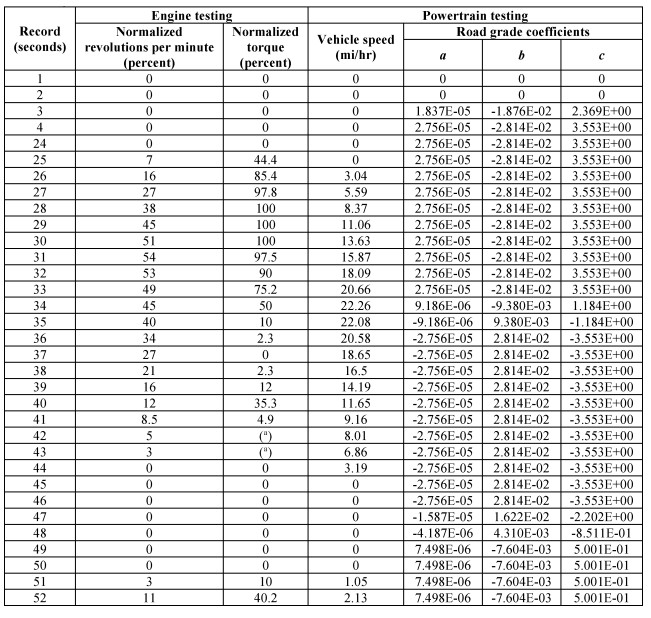
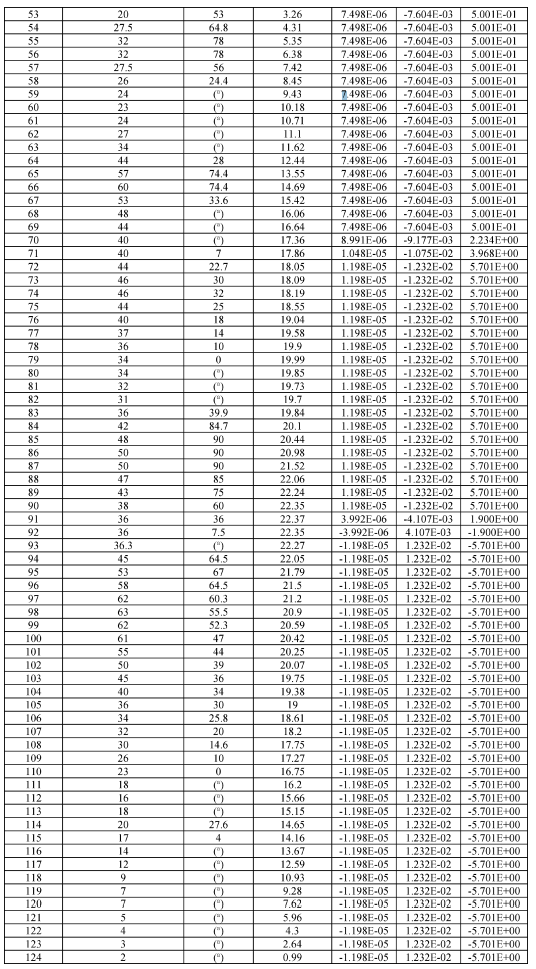
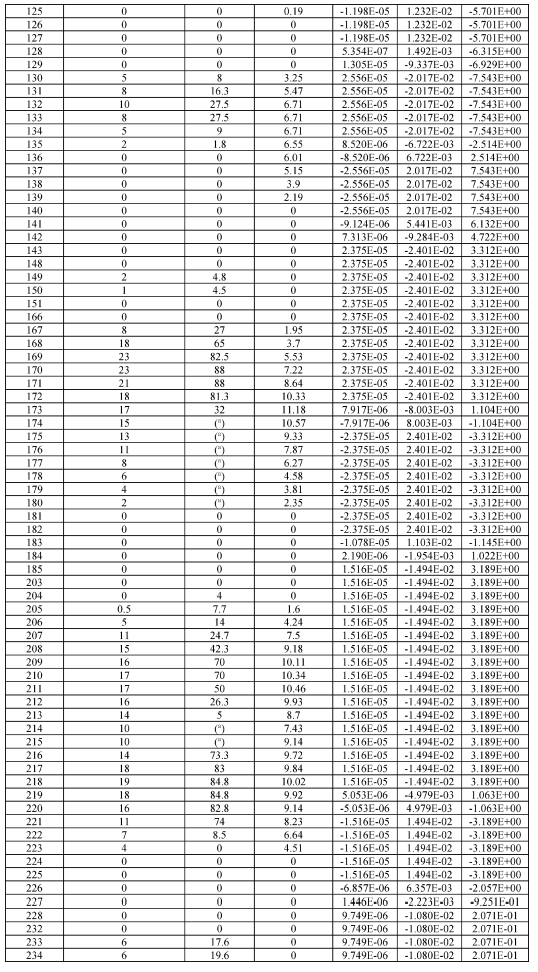
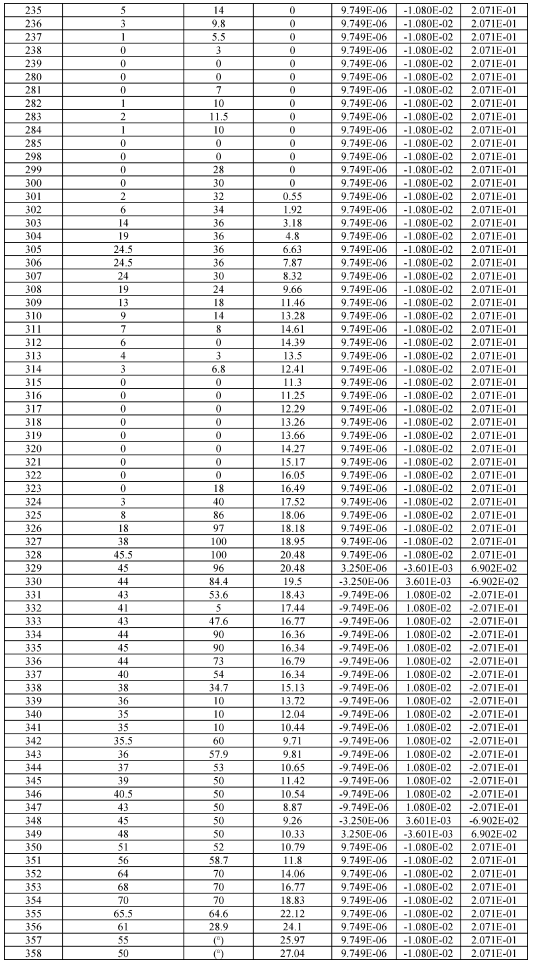

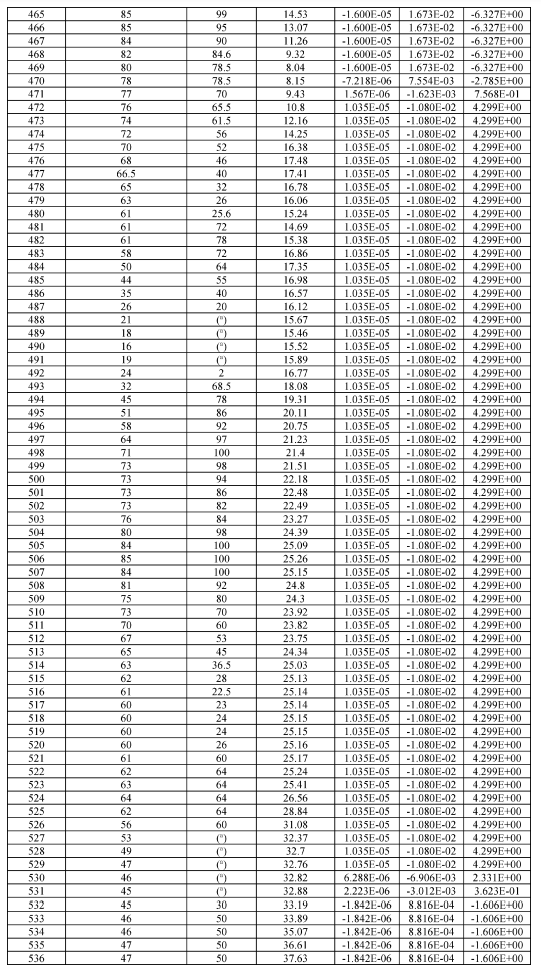
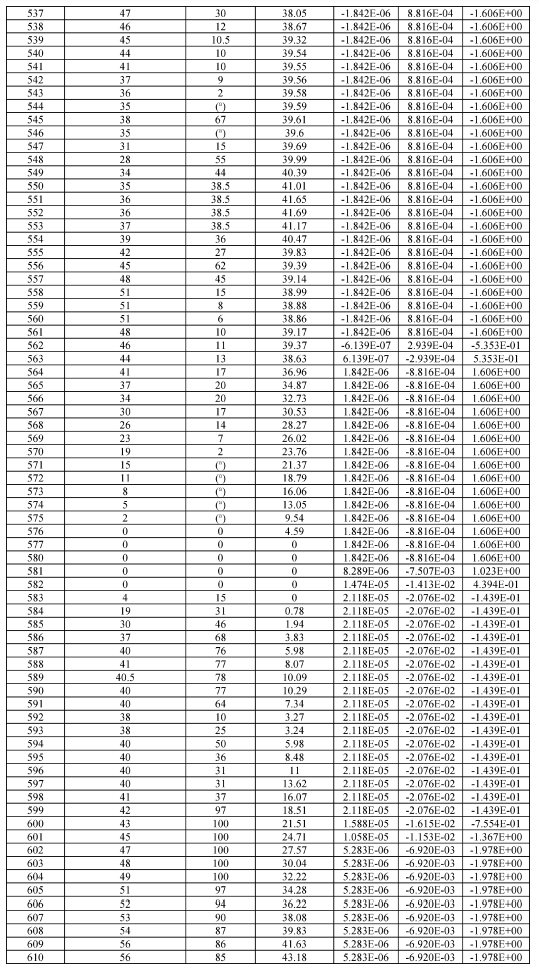
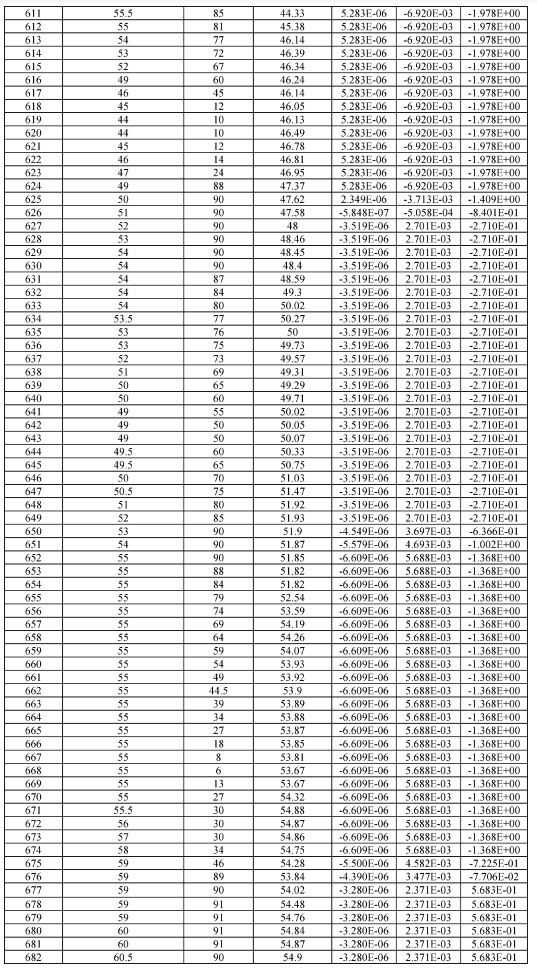
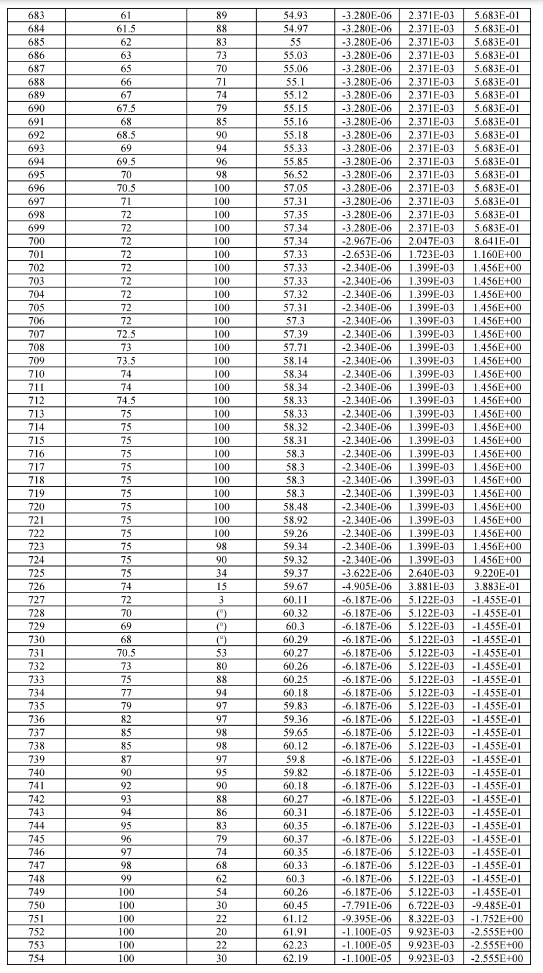
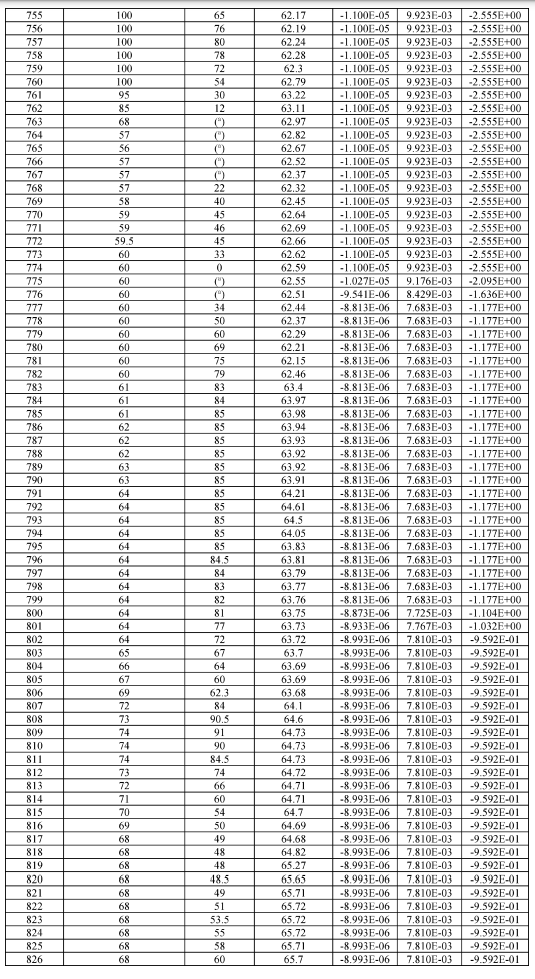
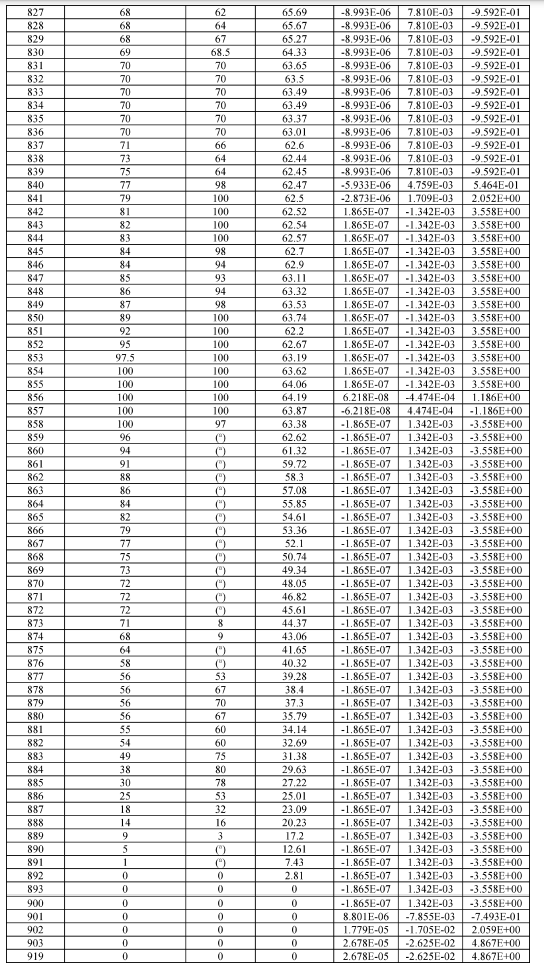
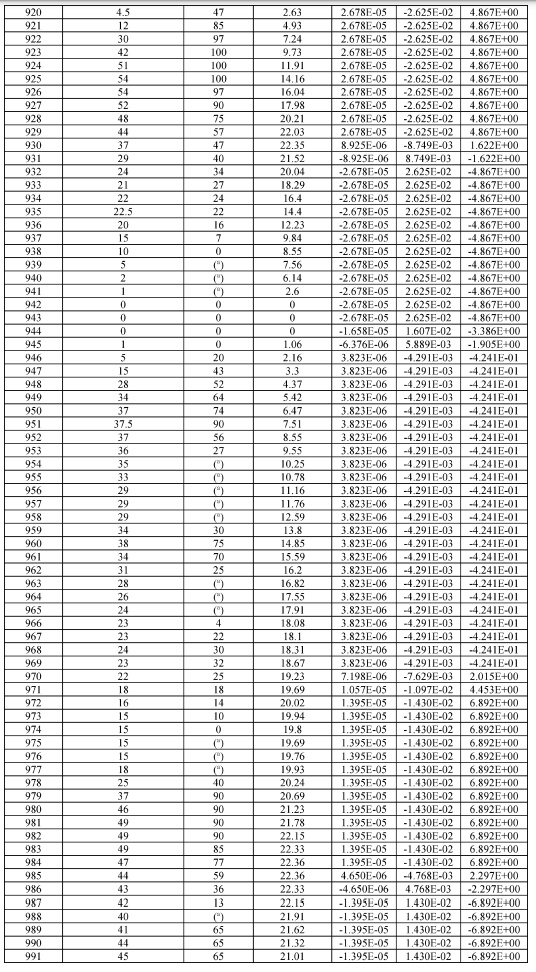
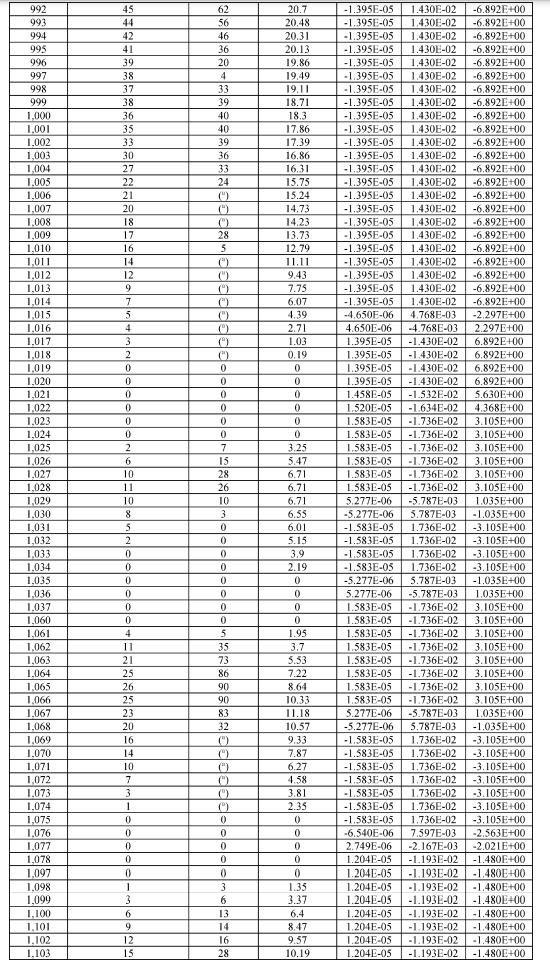
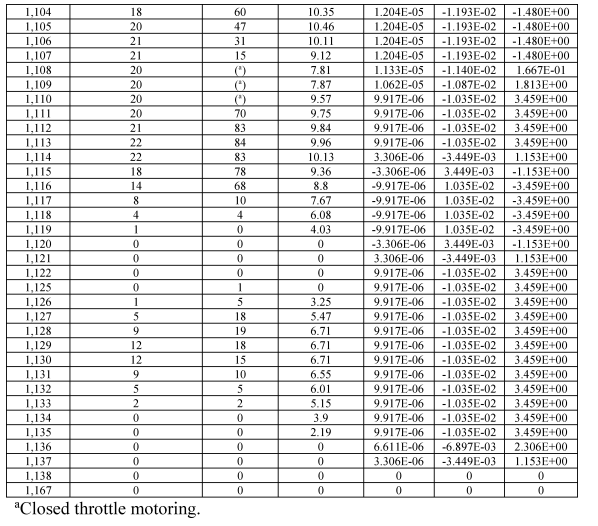
(c) The following transient test interval applies for compression-ignition engines and powertrains when testing over the duty cycle specified in §1036.512:
Table 2 of Appendix B—Transient Test Interval for Compression-Ignition Engines and Powertrains Under §1036.512
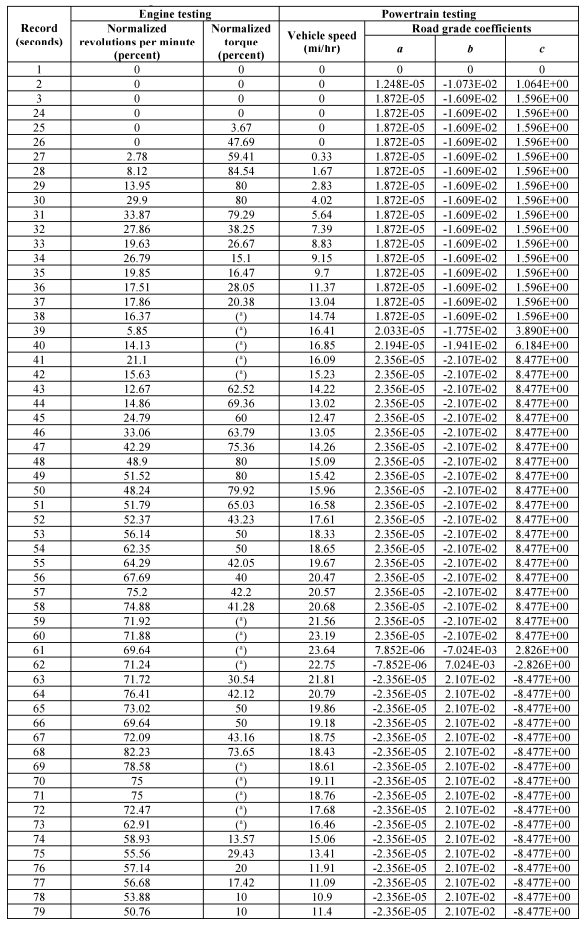

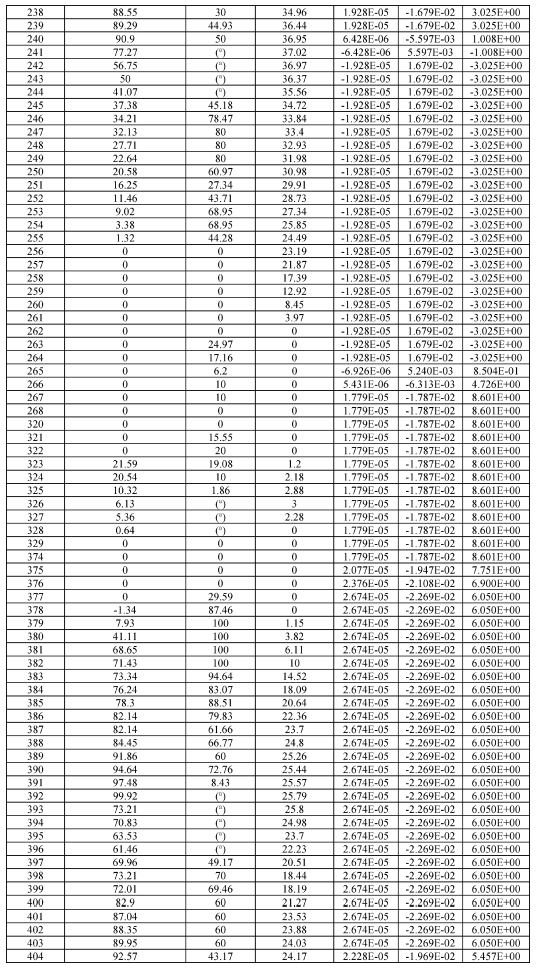
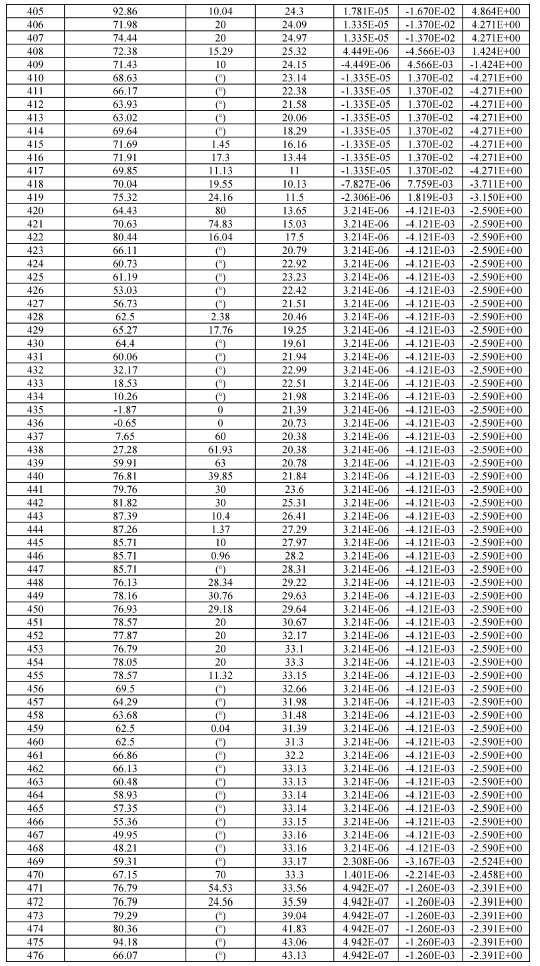
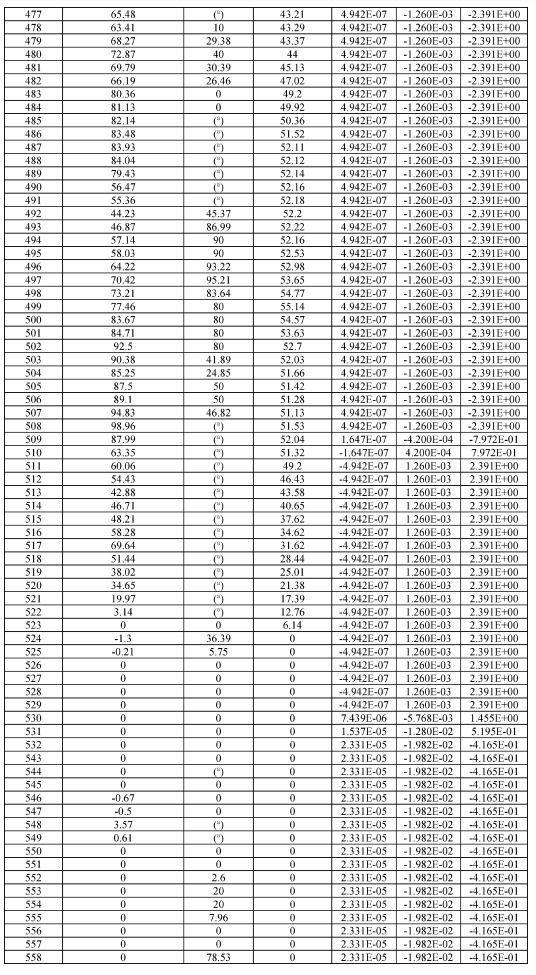

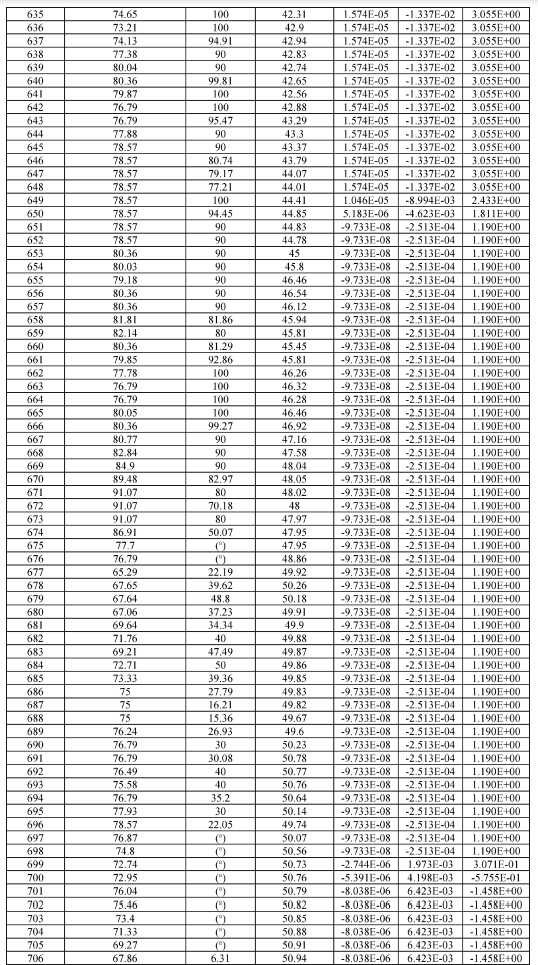

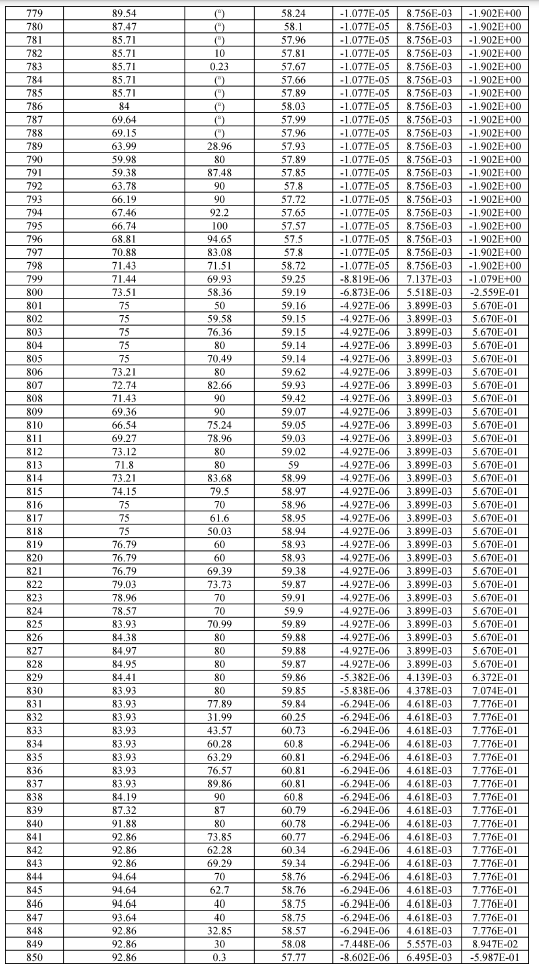
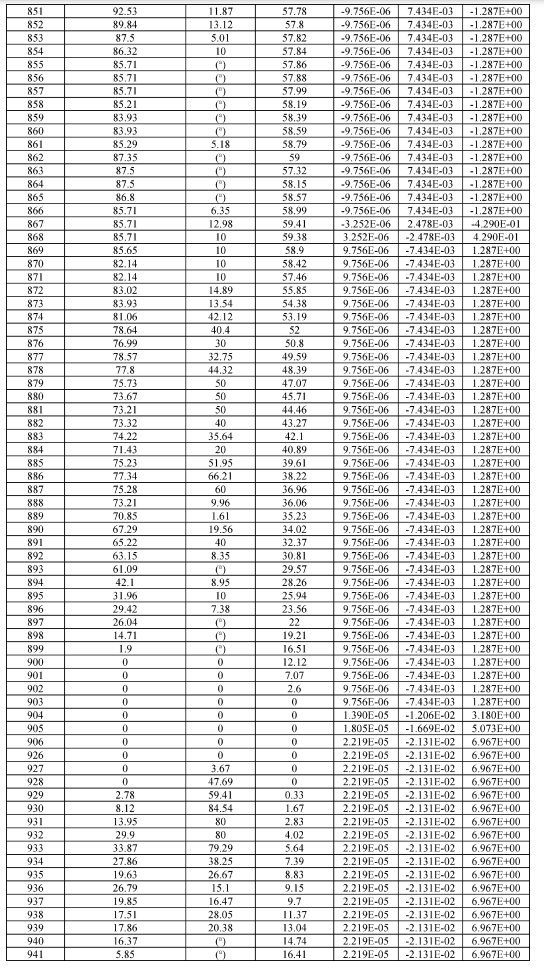
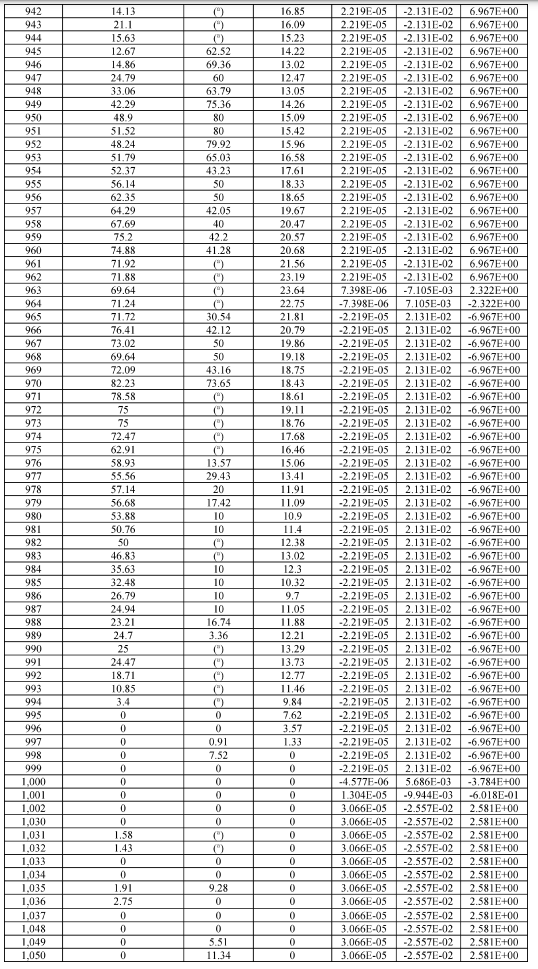

(d) The following transient duty cycle applies for compression-ignition engines and powertrains when testing under §1036.514:
Table 3 of Appendix B—Transient Duty Cycle for Compression-Ignition Engines and Powertrains Under §1036.514
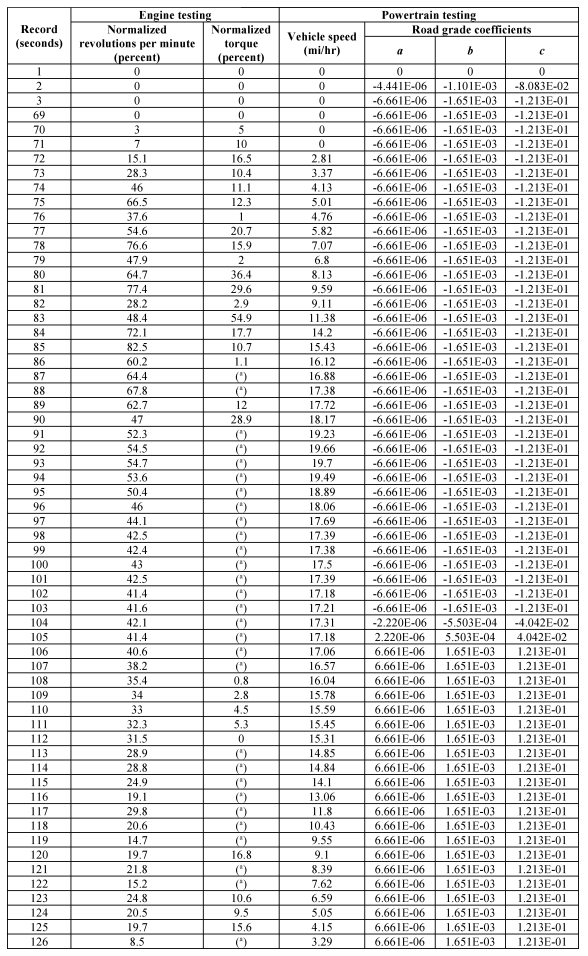
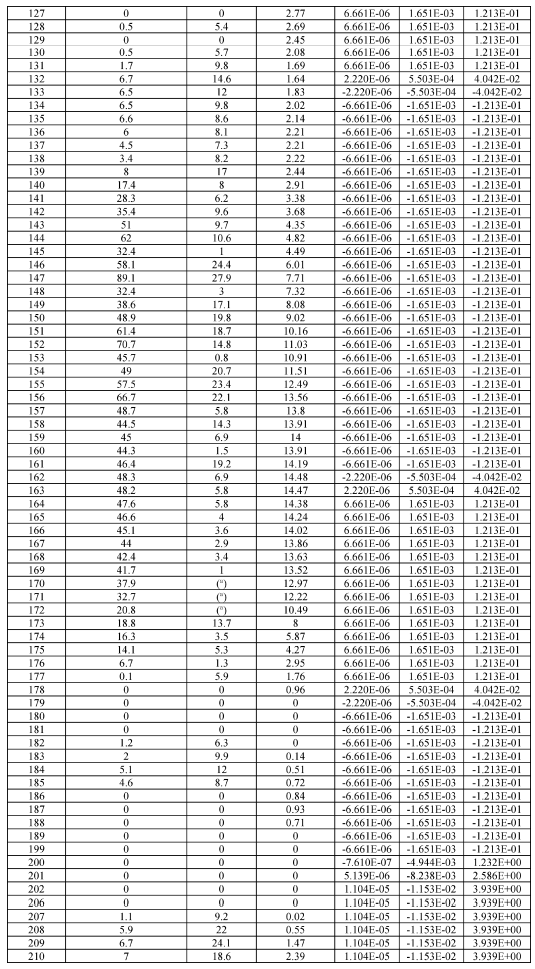


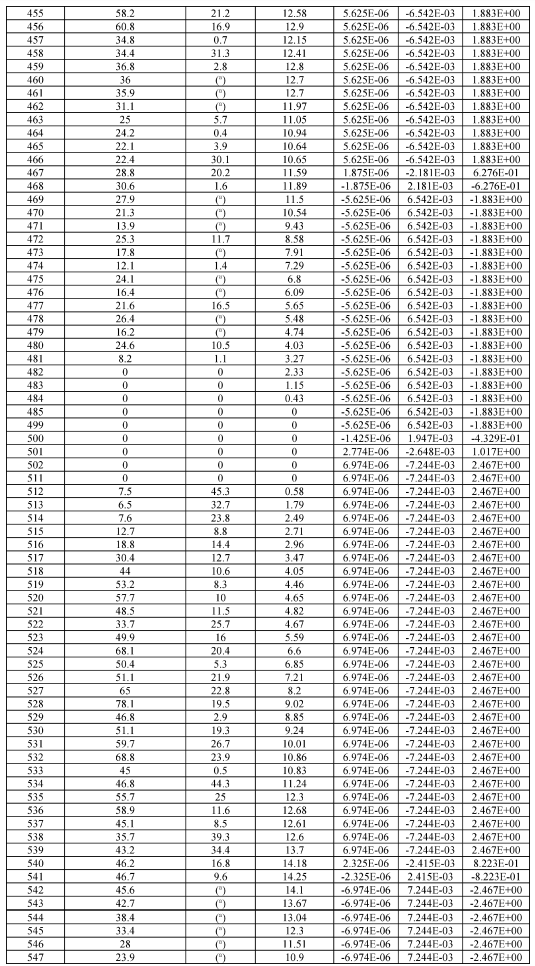
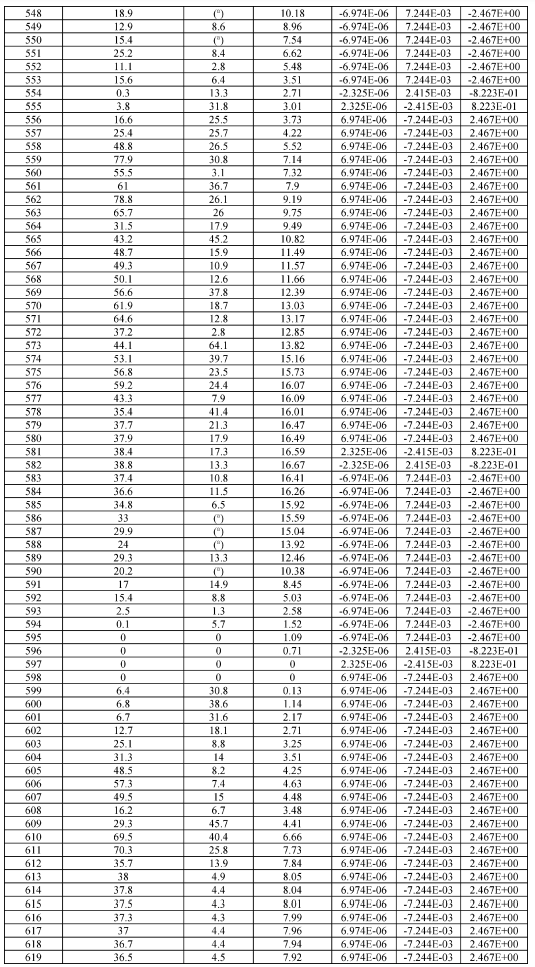
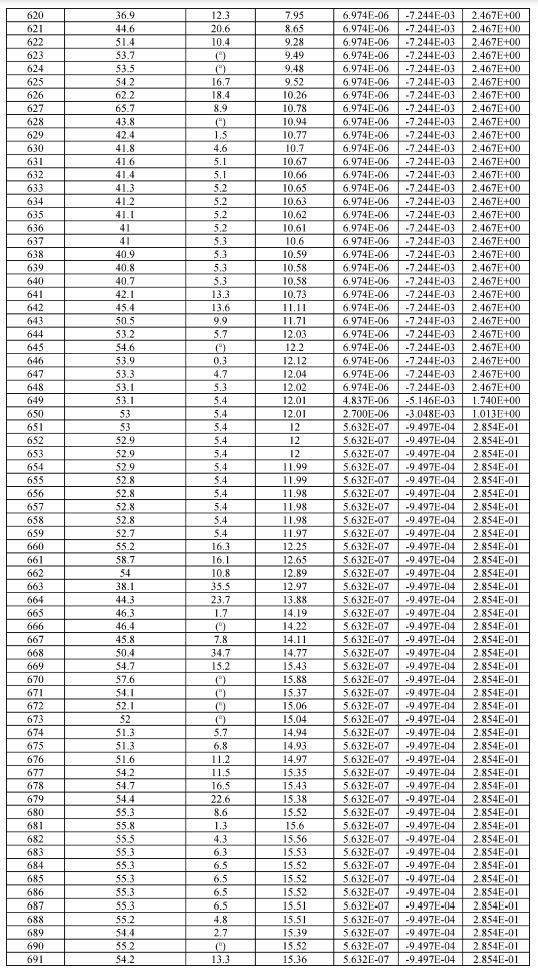

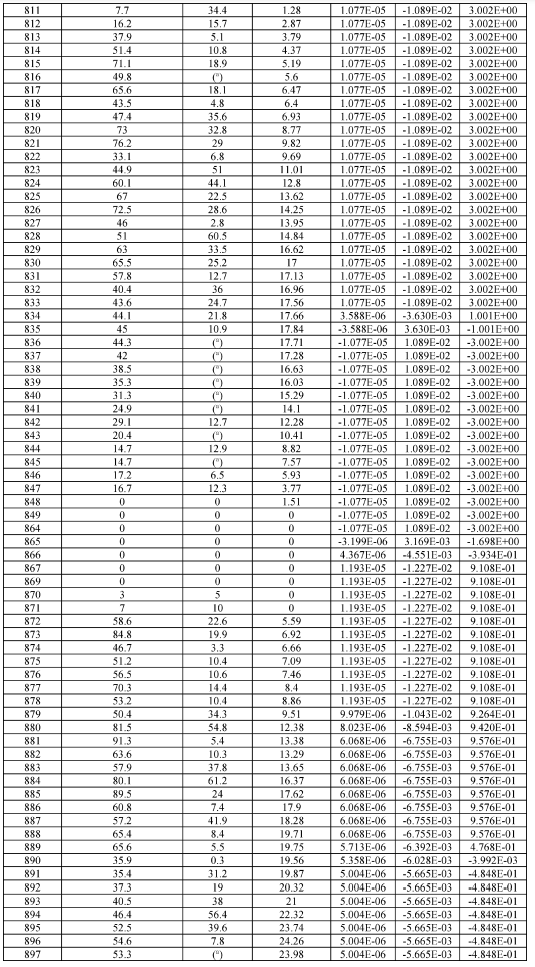
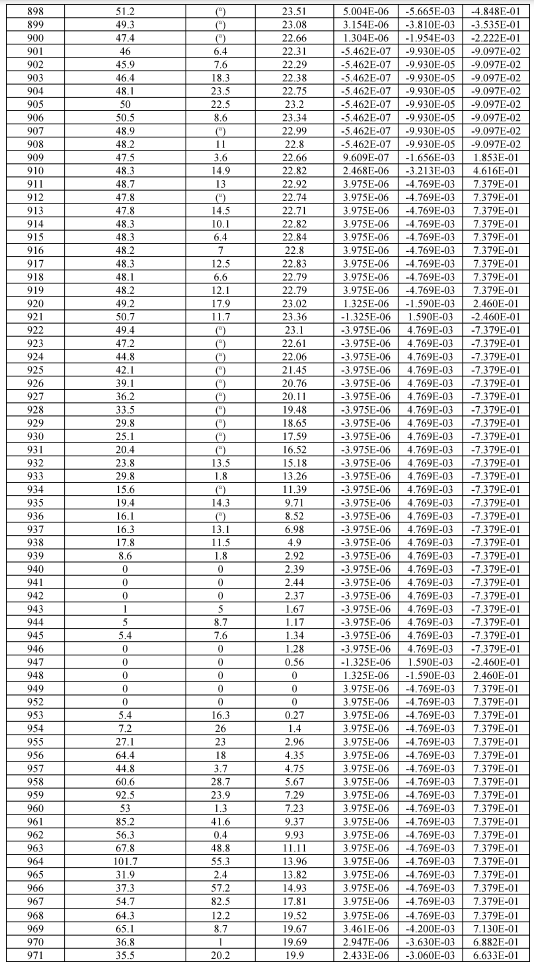
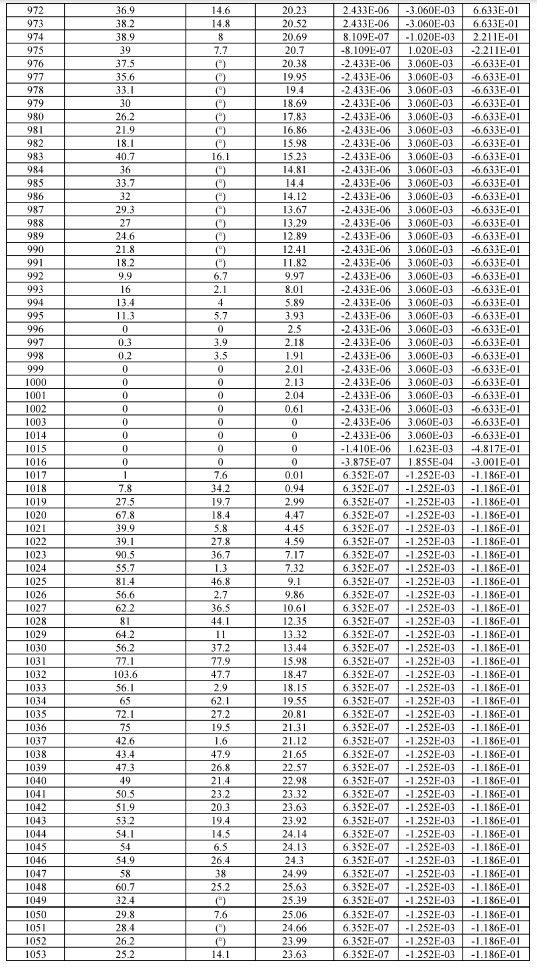
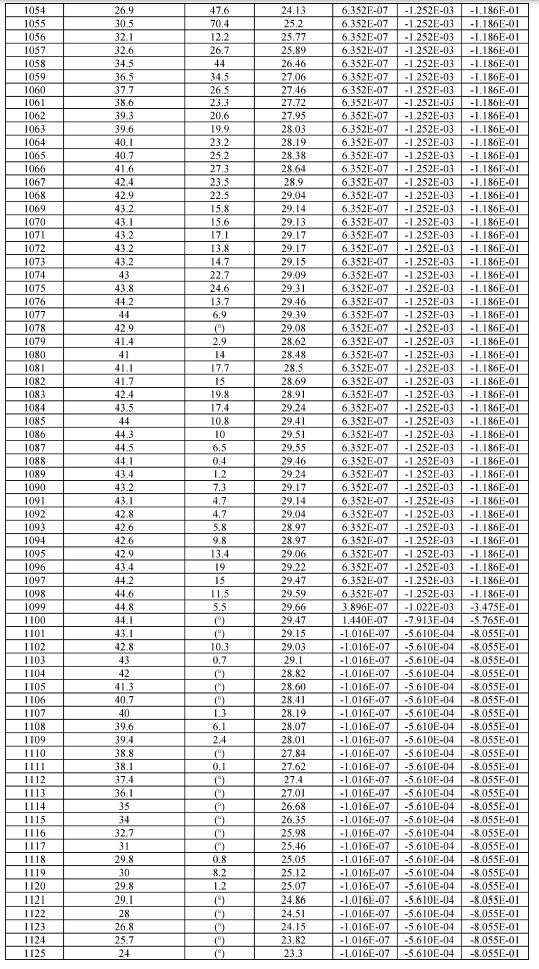
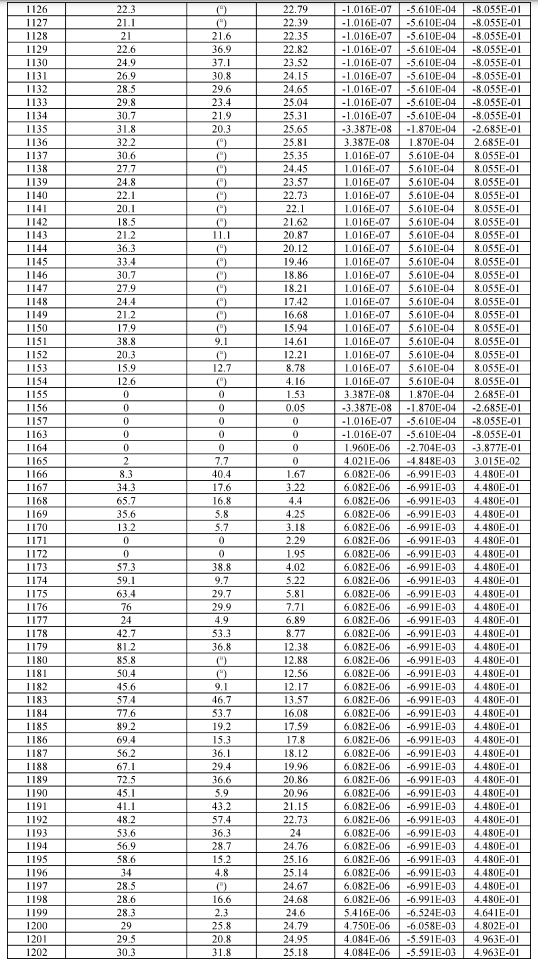
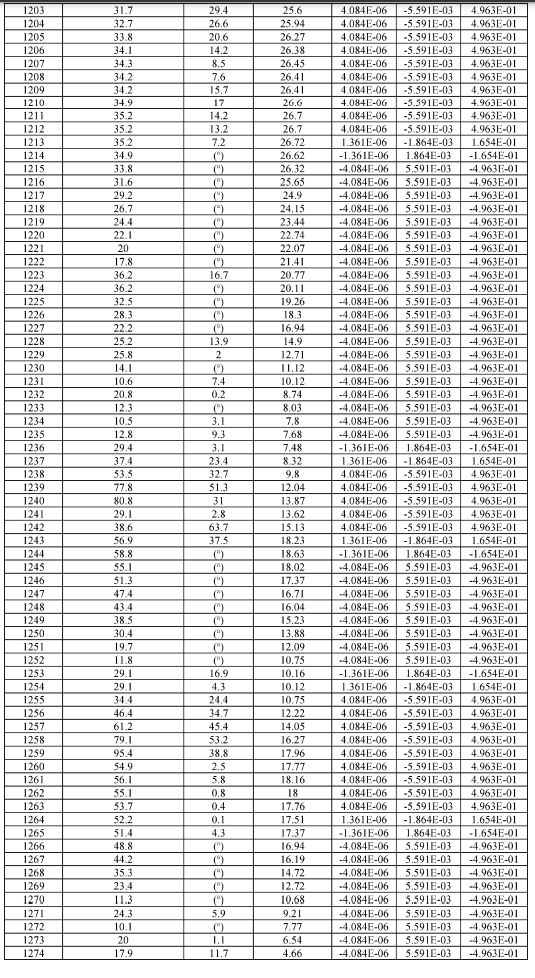
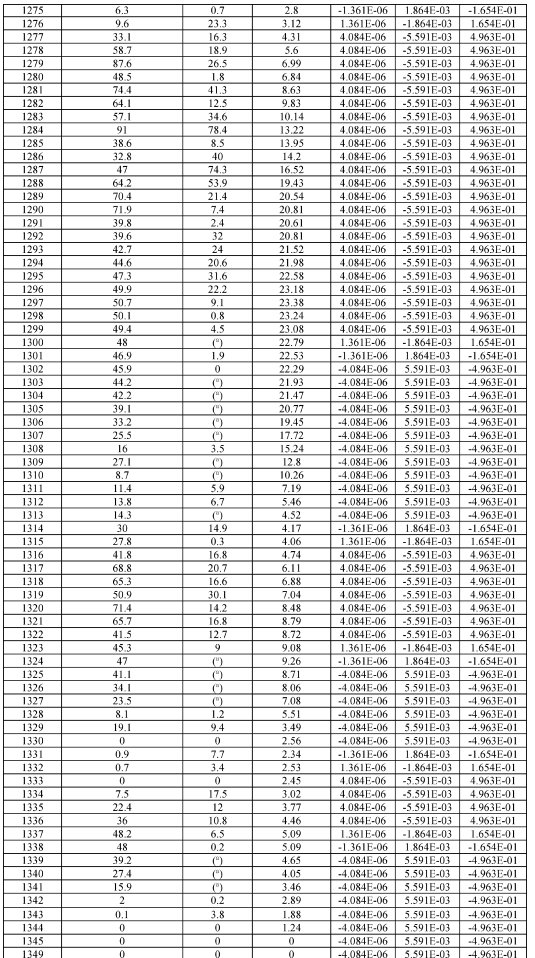
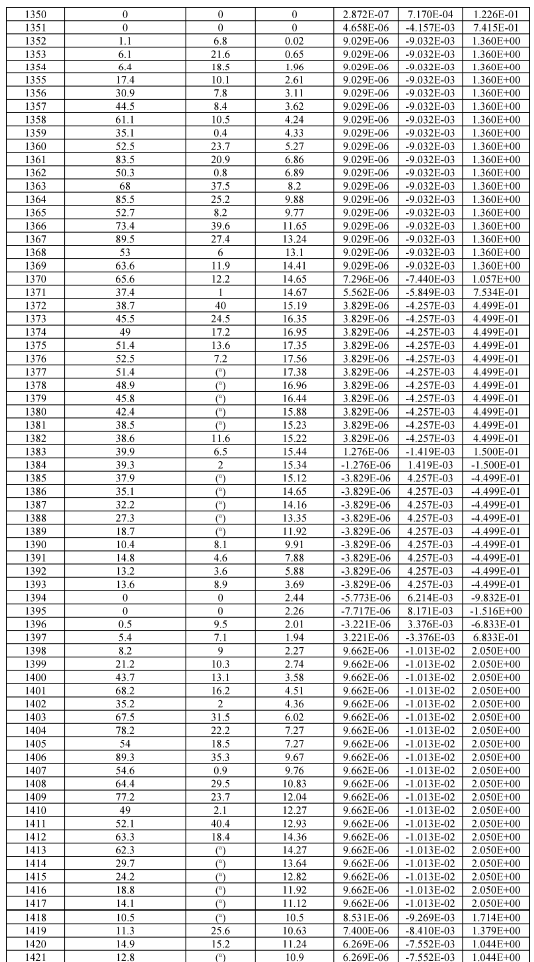
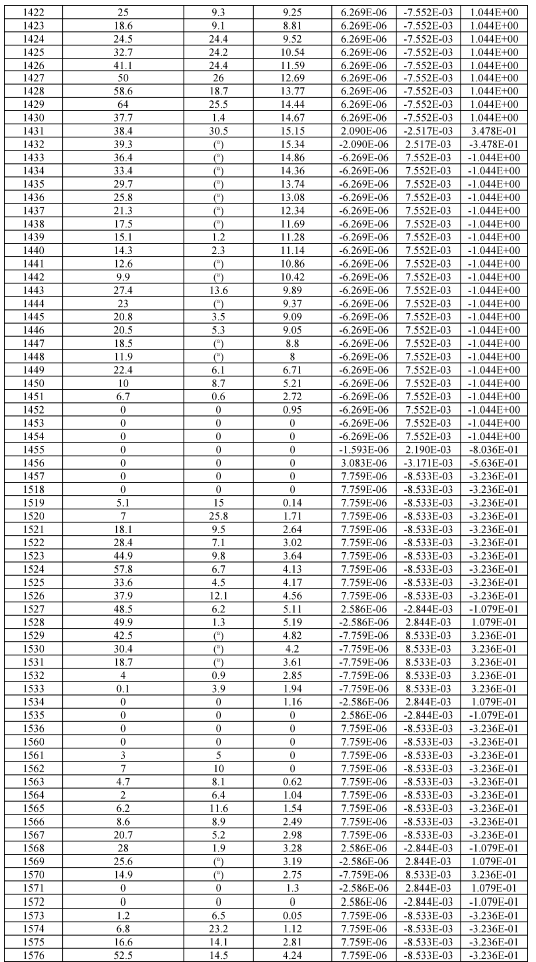
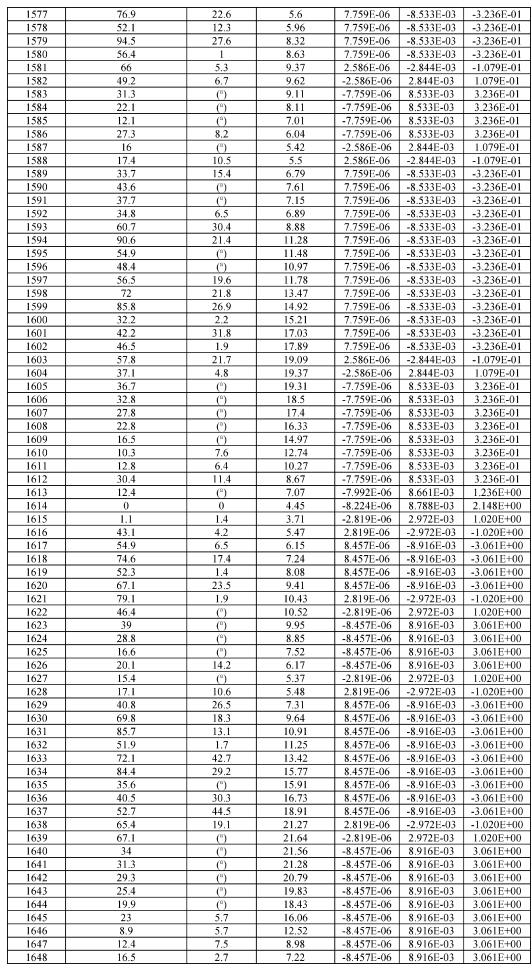

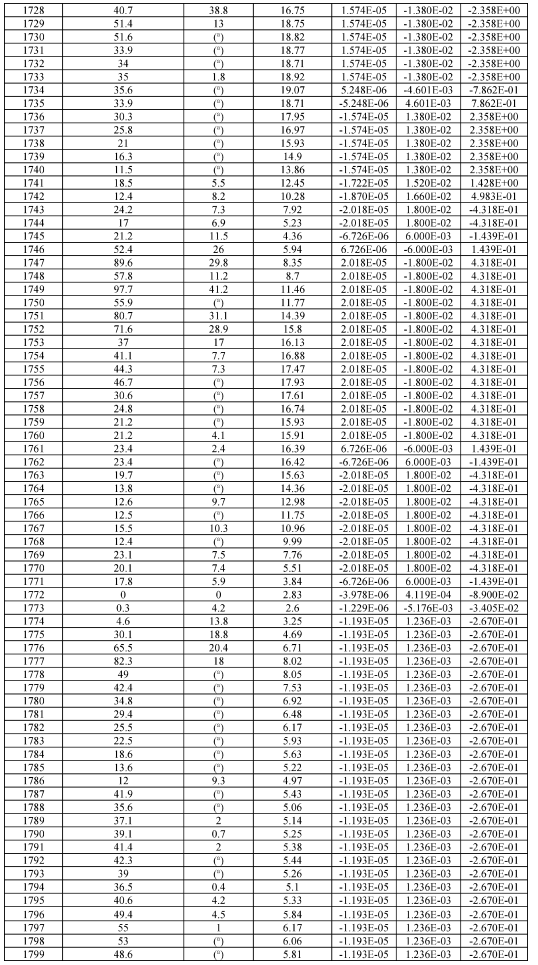


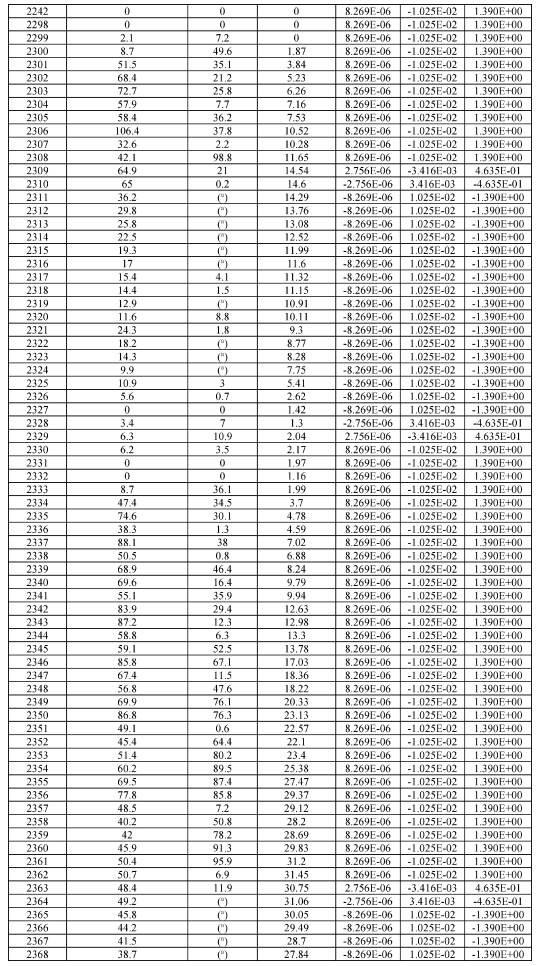
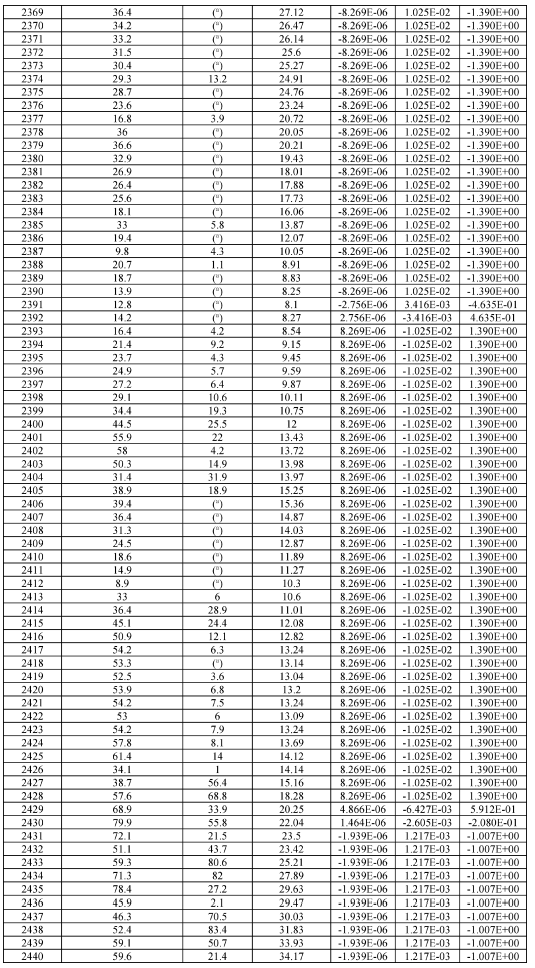


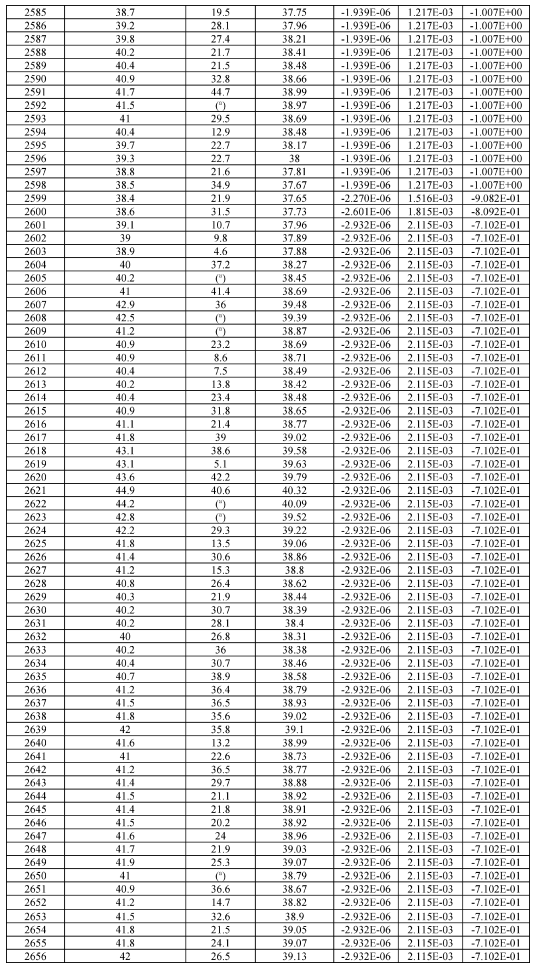

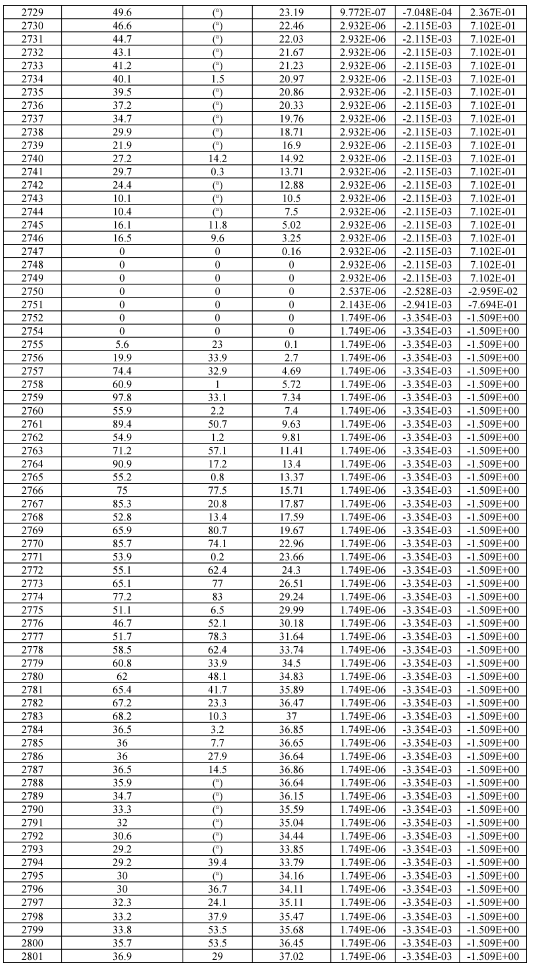
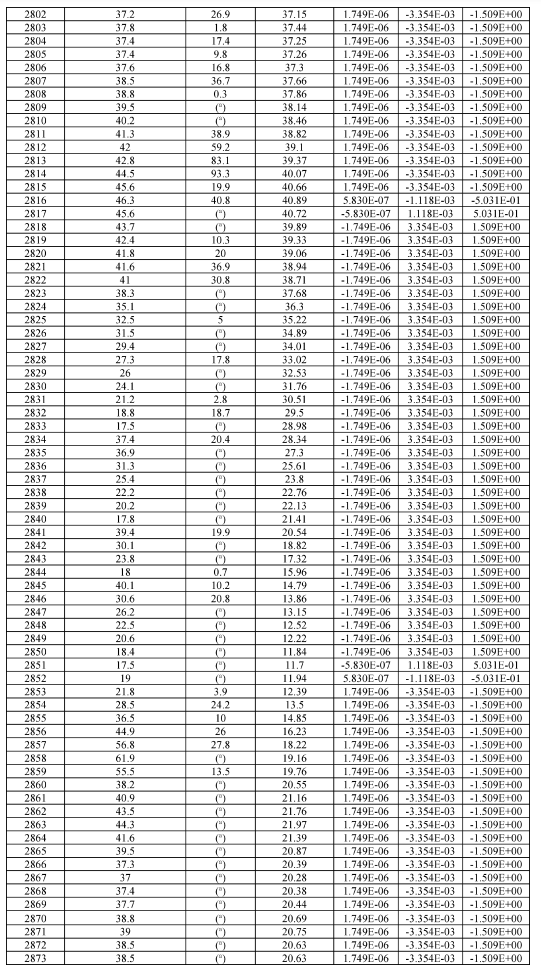
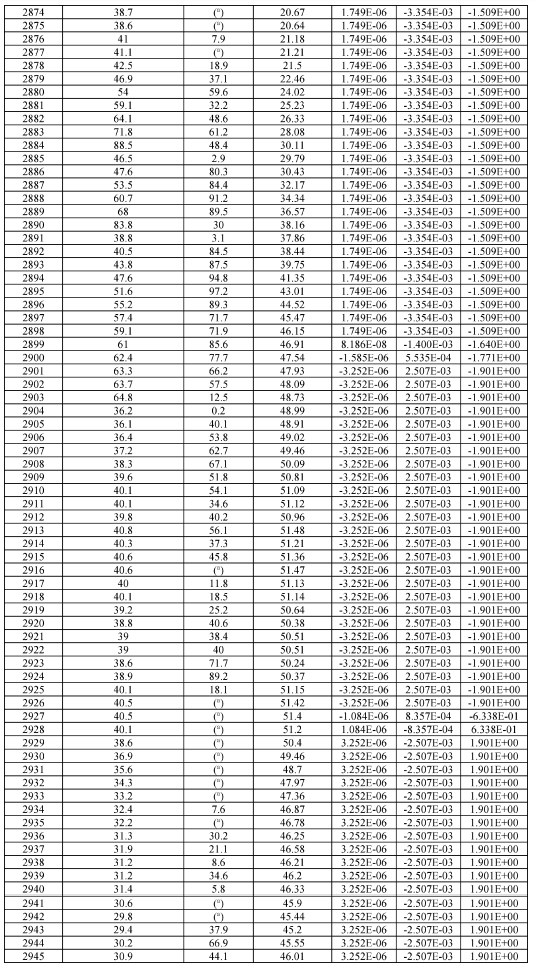
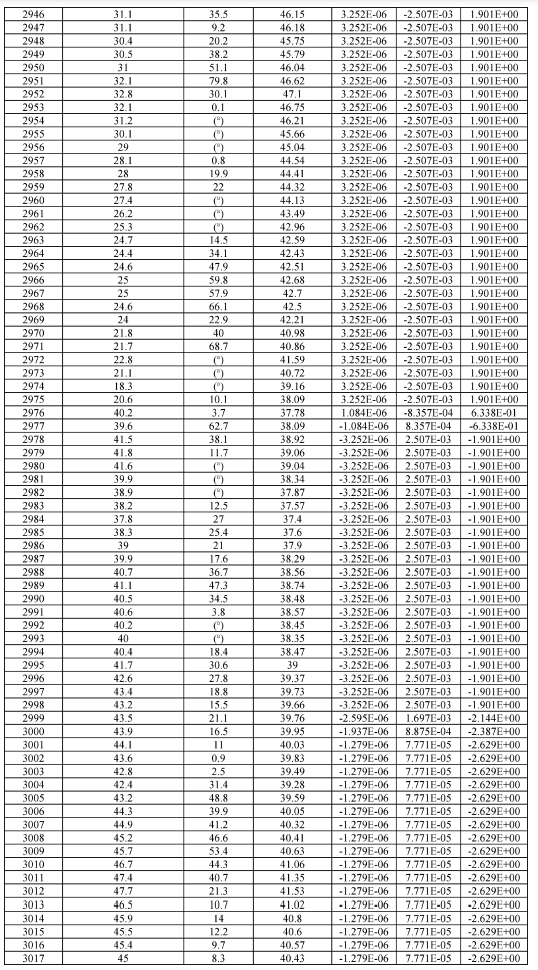
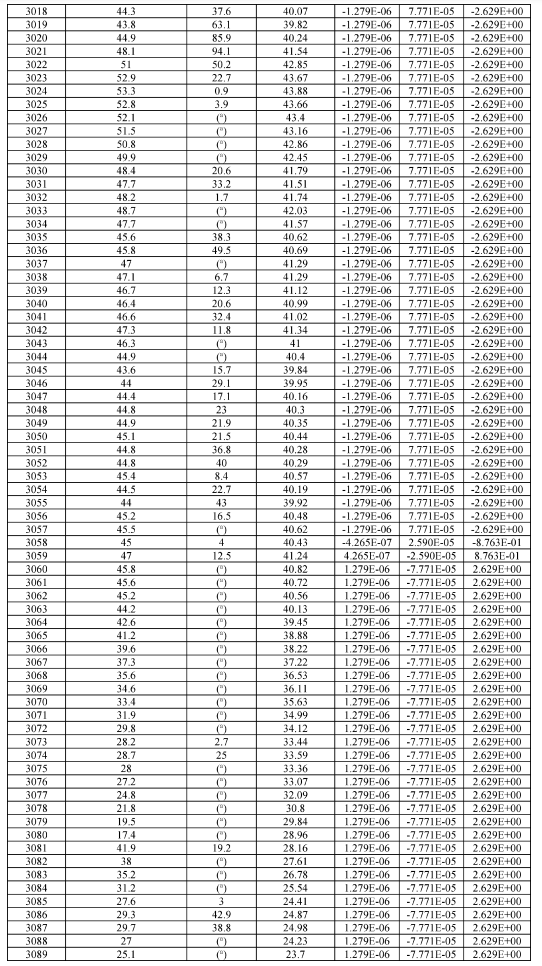
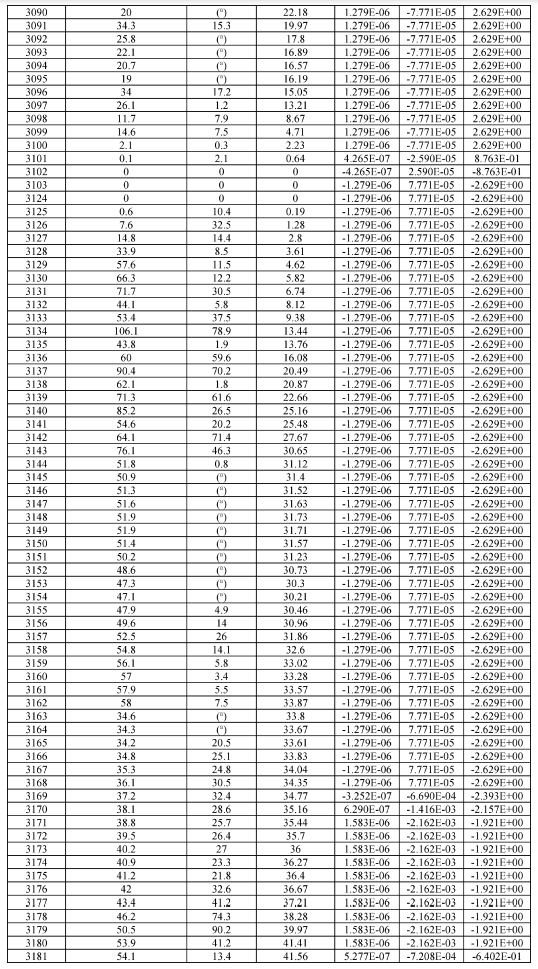
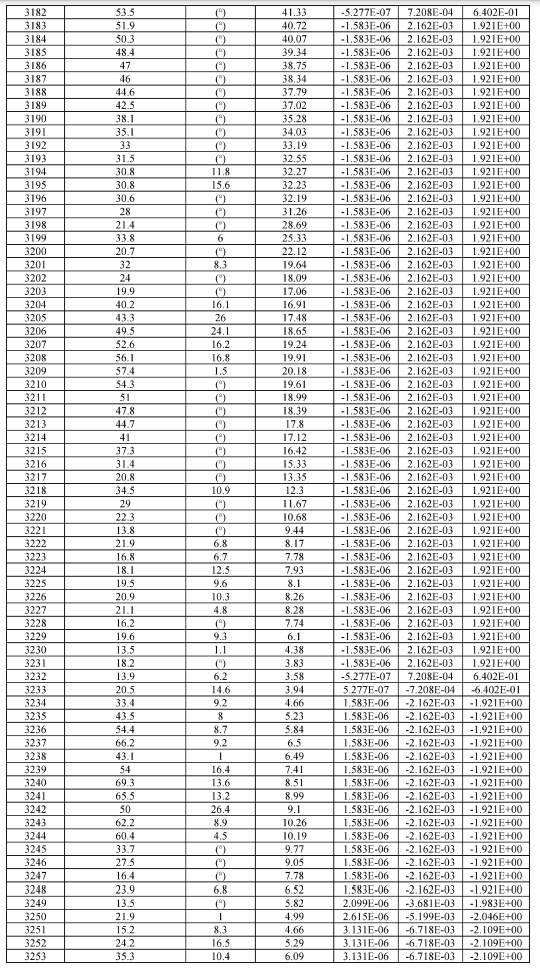
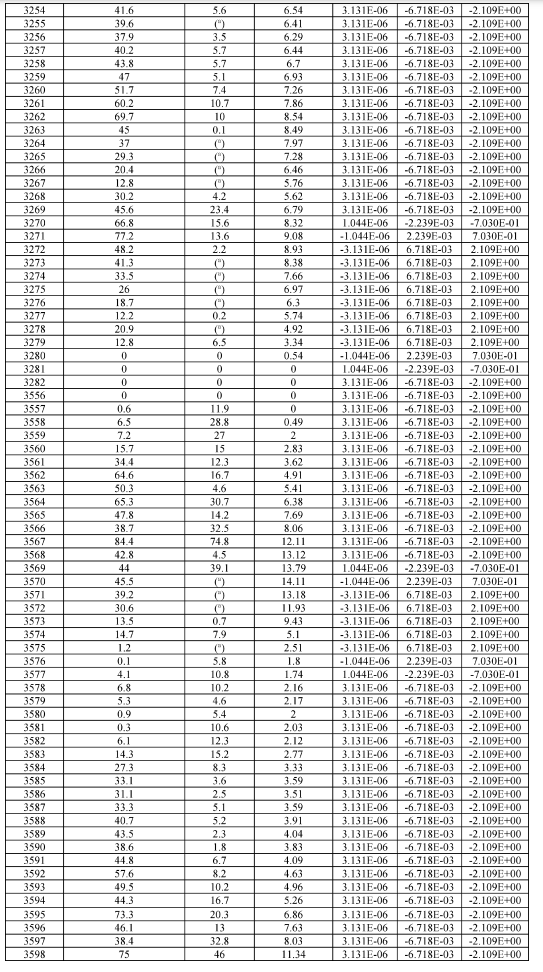

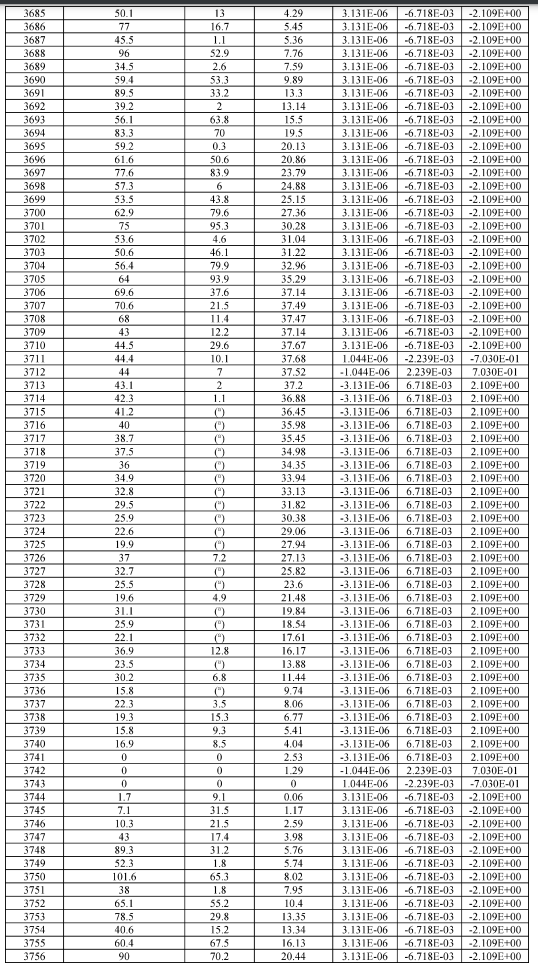

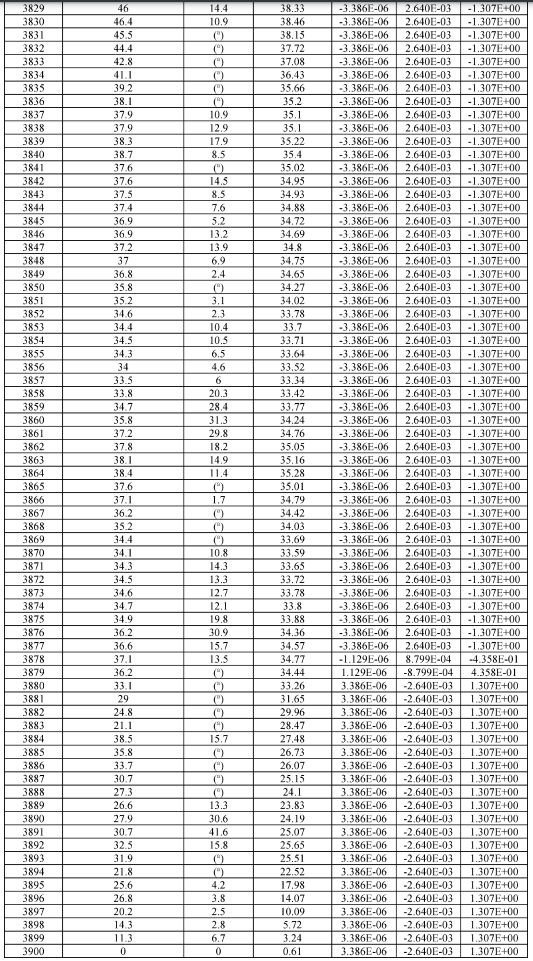


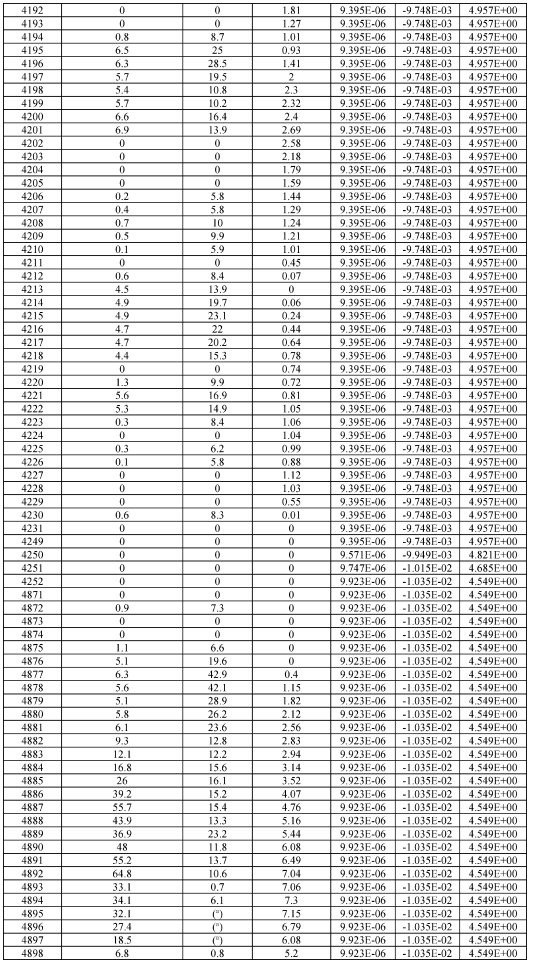
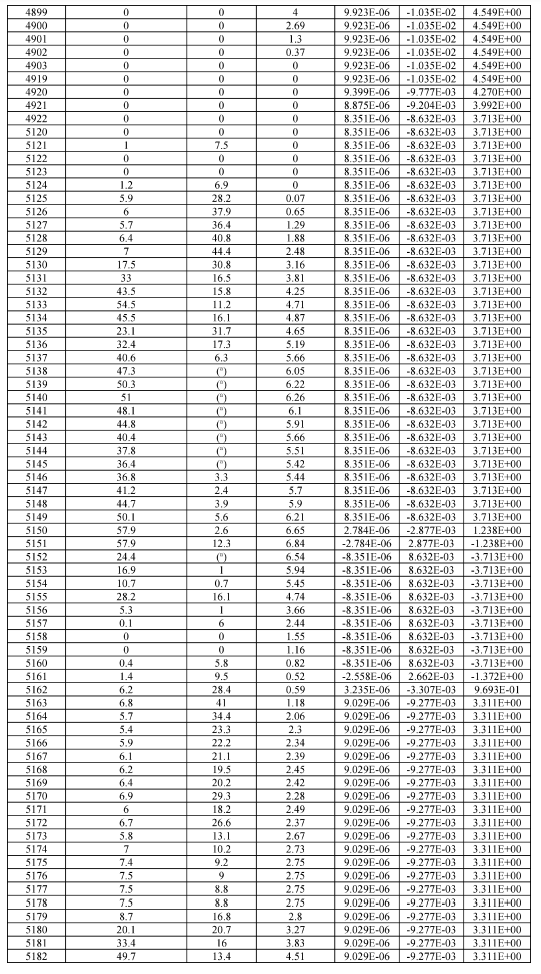
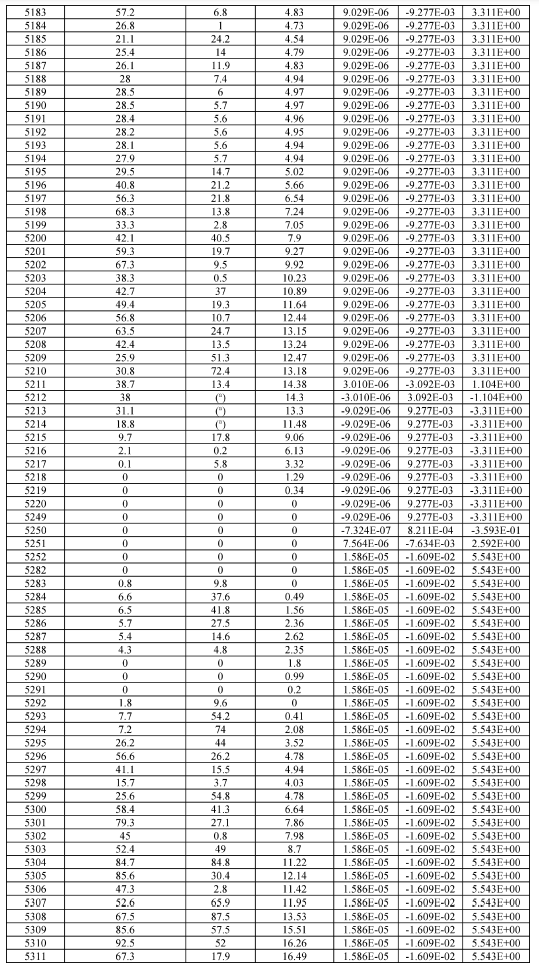
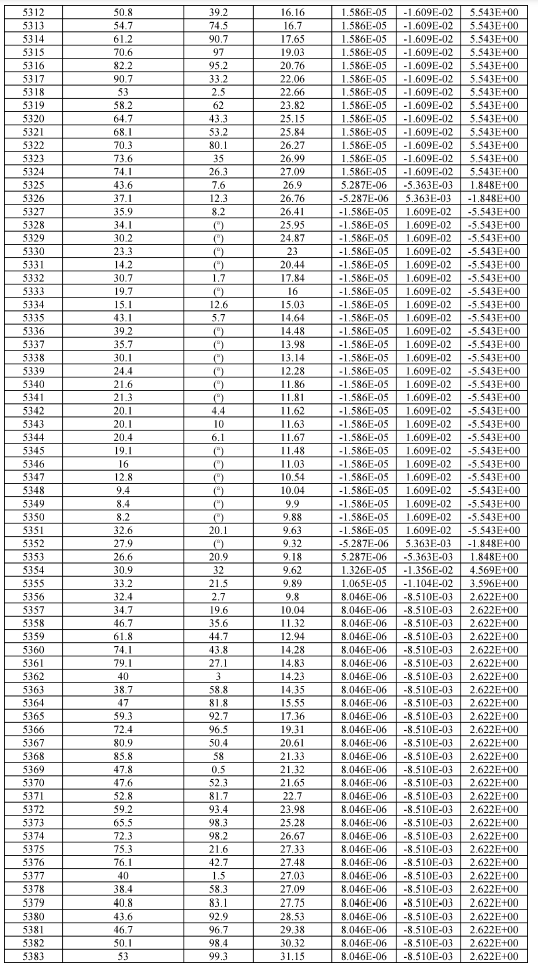


[88 FR 4487, Jan. 24, 2023]
Appendix C to Part 1036—Default Engine Fuel Maps for §1036.540
GEM contains the default steady-state fuel maps in this appendix for performing cycle-average engine fuel mapping as described in §1036.505(b)(2). Note that manufacturers have the option to replace these default values in GEM if they generate a steady-state fuel map as described in §1036.535(b).
(a) Use the following default fuel map for compression-ignition engines that will be installed in Tractors and Vocational Heavy HDV:
Table 1 of Appendix C—Default Fuel Map for Compression-Ignition Engines Installed in Tractors and Vocational Heavy HDV

(b) Use the following default fuel map for compression-ignition engines that will be installed in Vocational Light HDV and Vocational Medium HDV:
Table 2 of Appendix C—Default Fuel Map for Compression-Ignition Engines Installed in Vocational Light HDV and Vocational Medium HDV
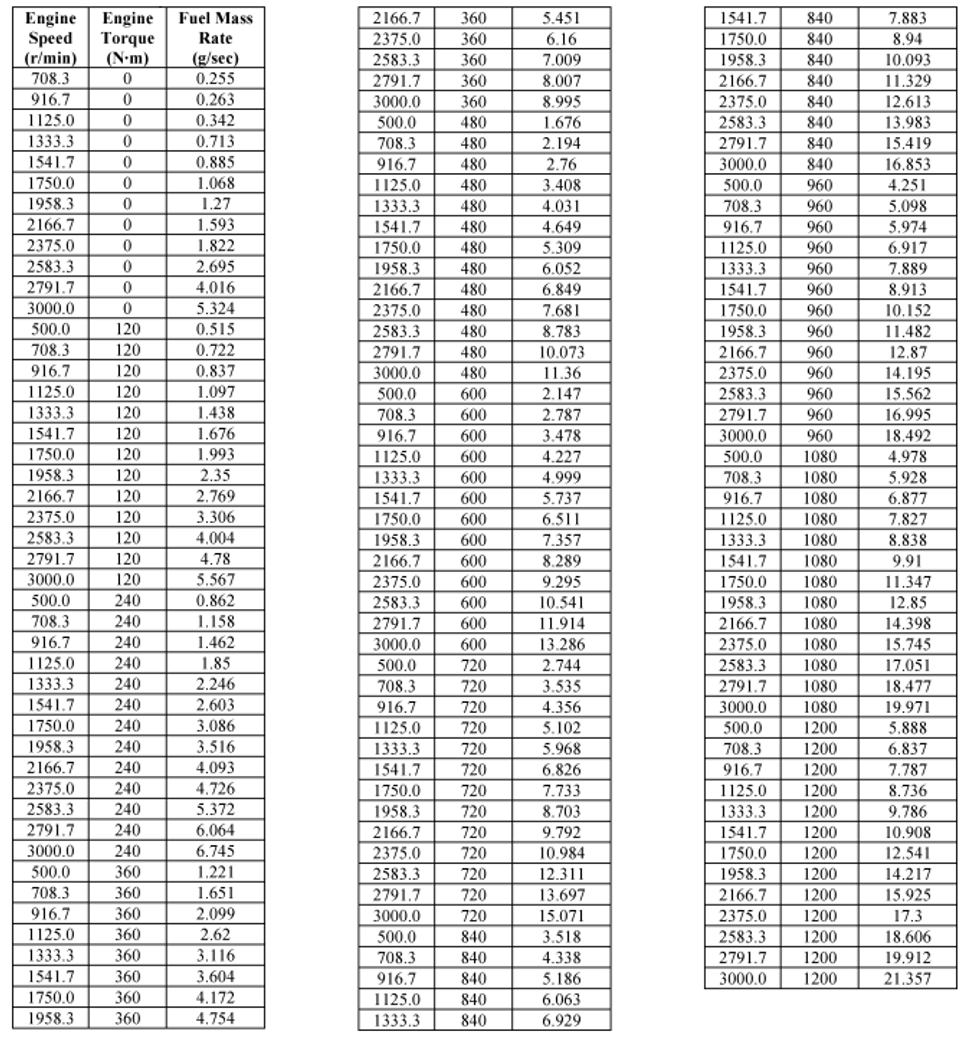
(c) Use the following default fuel map for all spark-ignition engines:
Table 3 of Appendix C—Default Fuel Map for Spark-Ignition Engines
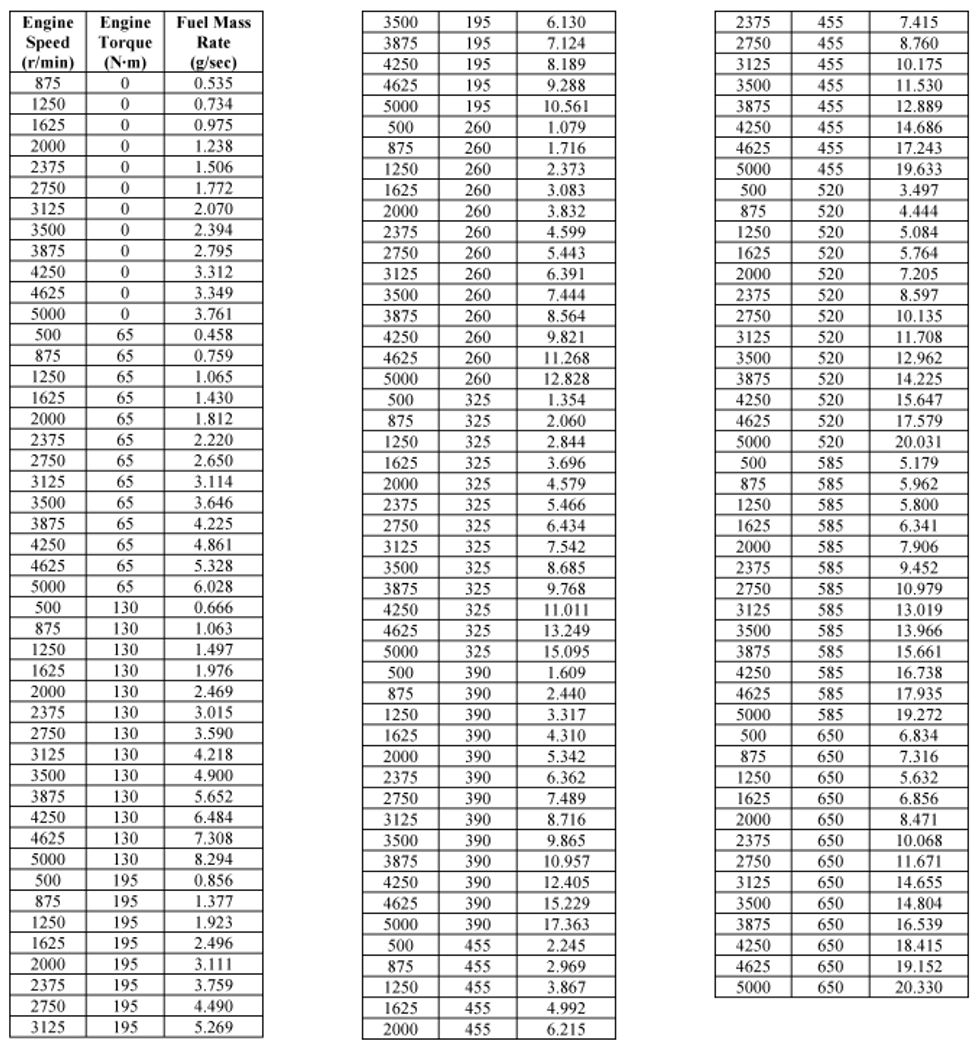
[88 FR 4487, Jan. 24, 2023]
['Air Programs']
['Air Emissions']
UPGRADE TO CONTINUE READING
Load More
J. J. Keller is the trusted source for DOT / Transportation, OSHA / Workplace Safety, Human Resources, Construction Safety and Hazmat / Hazardous Materials regulation compliance products and services. J. J. Keller helps you increase safety awareness, reduce risk, follow best practices, improve safety training, and stay current with changing regulations.
Copyright 2025 J. J. Keller & Associate, Inc. For re-use options please contact copyright@jjkeller.com or call 800-558-5011.
